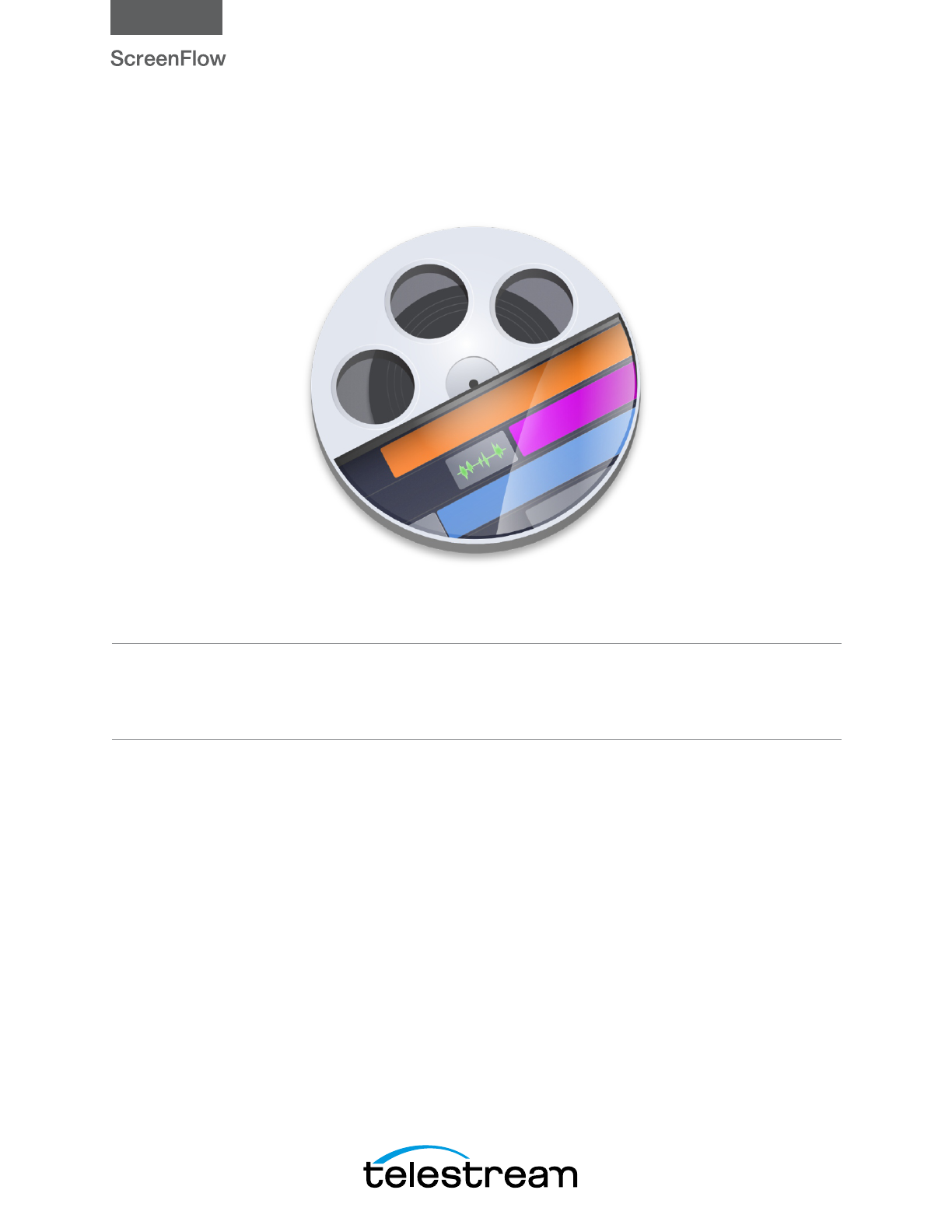
User Guide
ScreenFlow 10.0 User Guide
ScreenFlow User Guide | 1611231256
November 16, 2023
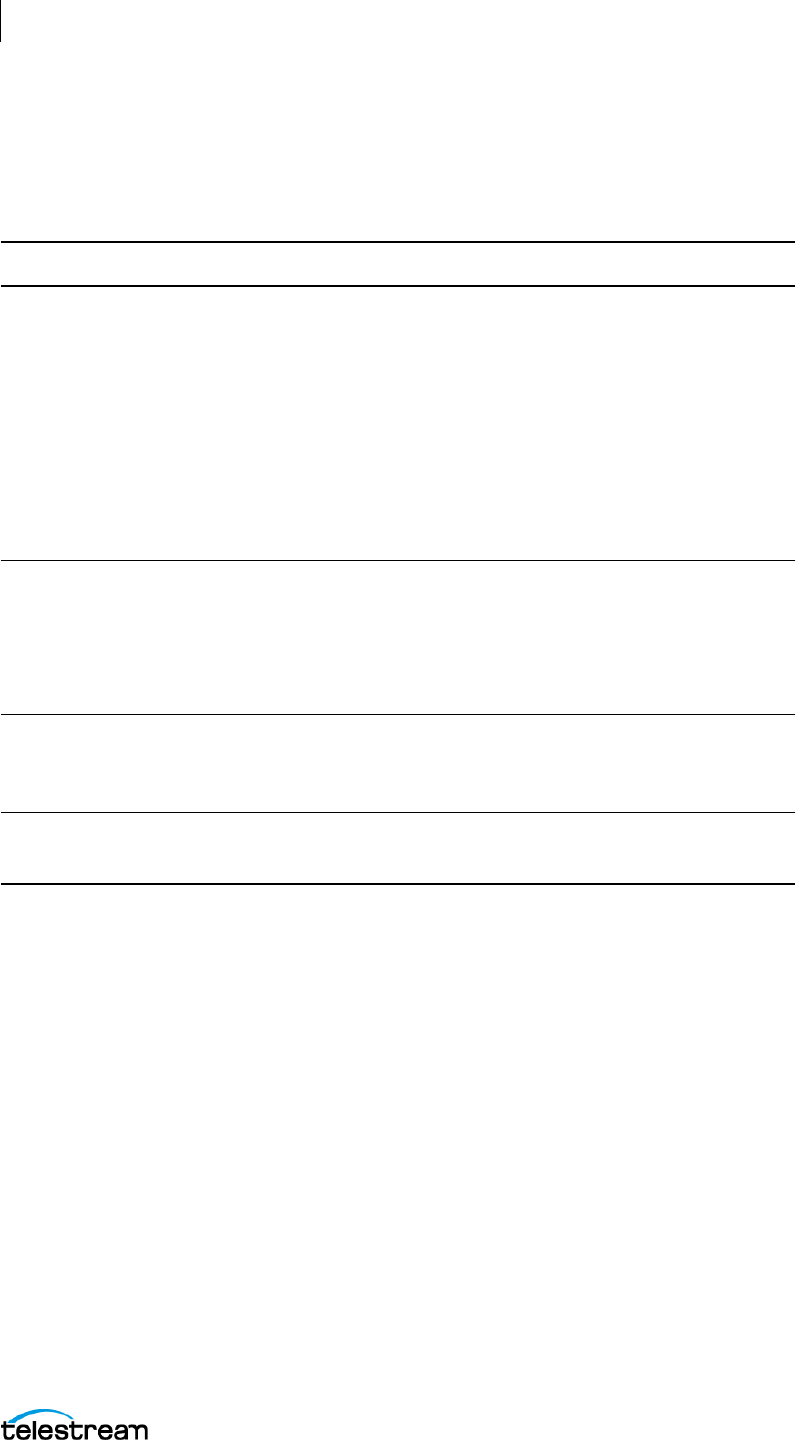
2
Contacting Telestream
To obtain product information, technical support, or provide comments on this guide, contact us using
our web site, email, or phone number as listed below.
Copyrights and Trademark Notices
Copyright © 2023 Telestream, LLC and its Affiliates. All rights reserved. No part of this publication may
be reproduced, transmitted, transcribed, altered, or translated into any languages without written
permission of Telestream, LLC. Information and specifications in this document are subject to change
without notice and do not represent a commitment on the part of Telestream. Specifications subject to
change without notice.
Telestream, Aurora, CaptionMaker, CaptureVU, Cerify, Content Manager, ContentCentral, Cricket, DIVA,
DIVAdirector, DIVADocs, DIVAGrid, DIVANet, DIVAProtect, DIVASolutions, Episode, Encoding
Intelligence, Episode, FLEXVU, Flip4Mac, FlipFactory, Flip Player, Geminus, Glim, GraphicsFactory,
Inspector, IQ & Design, Kumulate, Lightspeed, MassStore, MassTech, MetaFlip, Post Producer, Prism,
ScreenFlow, Sentry, Singulus, Split-and-Stitch, Stay Genlock, Surveyor, Tempo, TrafficManager, Vantage,
Vantage Cloud Port, VOD Producer, and Wirecast are registered trademarks of Telestream, LLC and its
Affiliates and its Affiliates.
Resource Contact Information
Telestream Technical
Support
Web Site: http://www.telestream.net/telestream-support/
Support Email: [email protected]
Enterprise Telephone Support:
U. S. Toll Free: (877) 257-6245
U. S. from outside U.S.: (530) 470-2036
Europe | Middle East | Africa | Asia | Pacific:
+49 228 280 9141
Terms and times of support services vary, per the terms of
your current service contract with Telestream.
Telestream, LLC Web Site: www.telestream.net
Sales and Marketing Email: info@telestream.net
Telestream, LLC
848 Gold Flat Road, Suite 1
Nevada City, CA USA 95959
International
Distributor Support
Web Site: www.telestream.net
See the Telestream Web site for your regional authorized
Telestream distributor.
Telestream Technical
Writers
Email: techwriter@telestream.net
Share comments about this or other Telestream documents.

3
Argus, ContentAgent, Cricket, e-Captioning, Inspector, iQ, iVMS, iVMS ASM, MacCaption, Pipeline,
Switch, and Vidchecker are trademarks of Telestream, LLC and its Affiliates. All other trademarks are the
property of their respective owners.
Adobe. Adobe® HTTP Dynamic Streaming Copyright © 2014 Adobe Systems. All rights reserved.
Apple. QuickTime, MacOS X, and Safari are trademarks of Apple, Inc. Bonjour, the Bonjour logo, and the
Bonjour symbol are trademarks of Apple, Inc.
Avid. Portions of this product Copyright 2012 Avid Technology, Inc.
CoreOS. Developers of ETCD.
Dolby. Dolby and the double-D symbol are registered trademarks of Dolby Laboratories Licensing
Corporation.
Fraunhofer IIS and Thomson Multimedia. MPEG Layer-3 audio coding technology licensed from
Fraunhofer IIS and Thomson Multimedia.
Google. VP6 and VP8 Copyright Google Inc. 2014 All rights reserved.
MainConcept. MainConcept is a registered trademark of MainConcept LLC and MainConcept AG.
Copyright 2004 MainConcept Multimedia Technologies.
Manzanita. Manzanita is a registered trademark of Manzanita Systems, Inc.
MCW. HEVC Decoding software licensed from MCW.
MediaInfo. Copyright © 2002-2013 MediaArea.net SARL. All rights reserved.
THIS SOFTWARE IS PROVIDED BY THE COPYRIGHT HOLDERS AND CONTRIBUTORS “AS IS” AND ANY
EXPRESS OR IMPLIED WARRANTIES, INCLUDING, BUT NOT LIMITED TO, THE IMPLIED WARRANTIES OF
MERCHANTABILITY AND FITNESS FOR A PARTICULAR PURPOSE ARE DISCLAIMED. IN NO EVENT SHALL
THE COPYRIGHT HOLDER OR CONTRIBUTORS BE LIABLE FOR ANY DIRECT, INDIRECT, INCIDENTAL,
SPECIAL, EXEMPLARY, OR CONSEQUENTIAL DAMAGES (INCLUDING, BUT NOT LIMITED TO,
PROCUREMENT OF SUBSTITUTE GOODS OR SERVICES; LOSS OF USE, DATA, OR PROFITS; OR BUSINESS
INTERRUPTION) HOWEVER CAUSED AND ON ANY THEORY OF LIABILITY, WHETHER IN CONTRACT,
STRICT LIABILITY, OR TORT (INCLUDING NEGLIGENCE OR OTHERWISE) ARISING IN ANY WAY OUT OF THE
USE OF THIS SOFTWARE, EVEN IF ADVISED OF THE POSSIBILITY OF SUCH DAMAGE.
Microsoft. Microsoft, Windows NT|2000|XP|XP Professional|Server 2003|Server 2008 |Server
2012|Server 2016|Server 2019|Server 2022, Windows 7, Windows 8, Windows 10, Windows 11, Media
Player, Media Encoder, .Net, Internet Explorer, SQL Server 2005|2008|2012|2016|2019, and Windows
Media Technologies are trademarks of Microsoft Corporation.
NLOG, MIT, Apache, Google. NLog open source code used in this product under MIT License and
Apache License is copyright © 2014-2016 by Google, Inc., © 2016 by Stabzs, © 2015 by Hiro, Sjoerd
Tieleman, © 2016 by Denis Pushkarev, © 2015 by Dash Industry Forum. All rights reserved.
SharpSSH2. SharpSSH2 Copyright (c) 2008, Ryan Faircloth. All rights reserved. Redistribution and use in
source and binary forms, with or without modification, are permitted provided that the following
conditions are met:
Redistributions of source code must retain the above copyright notice, this list of conditions and the
following disclaimer:
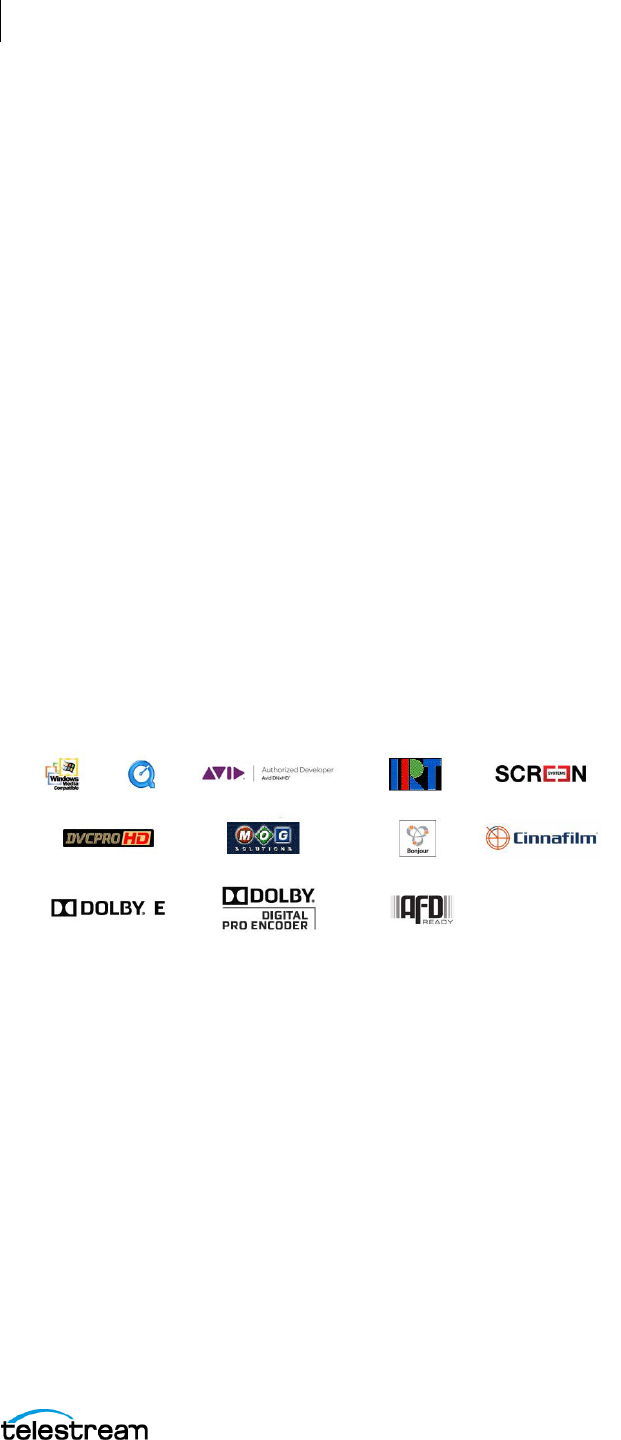
4
Redistributions in binary form must reproduce the above copyright notice, this list of conditions and
the following disclaimer in the documentation and/or other materials provided with the distribution.
Neither the name of Diversified Sales and Service, Inc. nor the names of its contributors may be used to
endorse or promote products derived from this software without specific prior written permission.
THIS SOFTWARE IS PROVIDED BY THE COPYRIGHT HOLDERS AND CONTRIBUTORS “AS IS” AND ANY
EXPRESS OR IMPLIED WARRANTIES, INCLUDING, BUT NOT LIMITED TO, THE IMPLIED WARRANTIES OF
MERCHANTABILITY AND FITNESS FOR A PARTICULAR PURPOSE ARE DISCLAIMED. IN NO EVENT SHALL
THE COPYRIGHT OWNER OR CONTRIBUTORS BE LIABLE FOR ANY DIRECT, INDIRECT, INCIDENTAL,
SPECIAL, EXEMPLARY, OR CONSEQUENTIAL DAMAGES (INCLUDING, BUT NOT LIMITED TO,
PROCUREMENT OF SUBSTITUTE GOODS OR SERVICES; LOSS OF USE, DATA, OR PROFITS; OR BUSINESS
INTERRUPTION) HOWEVER CAUSED AND ON ANY THEORY OF LIABILITY, WHETHER IN CONTRACT,
STRICT LIABILITY, OR TORT (INCLUDING NEGLIGENCE OR OTHERWISE) ARISING IN ANY WAY OUT OF THE
USE OF THIS SOFTWARE, EVEN IF ADVISED OF THE POSSIBILITY OF SUCH DAMAGE.
Swagger. Licensed from SmartBear.
Telerik. RadControls for ASP.NET AJAX copyright Telerik All rights reserved.
VoiceAge. This product is manufactured by Telestream under license from VoiceAge Corporation.
x264 LLC. The product is manufactured by Telestream under license from x264 LLC.
Xceed. The Software is Copyright ©1994-2012 Xceed Software Inc., all rights reserved.
ZLIB. Copyright (C) 1995-2013 Jean-loup Gailly and Mark Adler.
Other brands, product names, and company names are trademarks of their respective holders, and are
used for identification purpose only.
MPEG Disclaimers
MPEGLA MPEG2 Patent
ANY USE OF THIS PRODUCT IN ANY MANNER OTHER THAN PERSONAL USE THAT COMPLIES WITH THE
MPEG-2 STANDARD FOR ENCODING VIDEO INFORMATION FOR PACKAGED MEDIA IS EXPRESSLY
PROHIBITED WITHOUT A LICENSE UNDER APPLICABLE PATENTS IN THE MPEG-2 PATENT PORTFOLIO,
WHICH LICENSE IS AVAILABLE FROM MPEG LA, LLC, 4600 S. Ulster Street, Suite 400, Denver, Colorado
80237 U.S.A.

5
MPEGLA MPEG4 VISUAL
THIS PRODUCT IS LICENSED UNDER THE MPEG-4 VISUAL PATENT PORTFOLIO LICENSE FOR THE
PERSONAL AND NON-COMMERCIAL USE OF A CONSUMER FOR (i) ENCODING VIDEO IN COMPLIANCE
WITH THE MPEG-4 VISUAL STANDARD (“MPEG-4 VIDEO”) AND/OR (ii) DECODING MPEG-4 VIDEO THAT
WAS ENCODED BY A CONSUMER ENGAGED IN A PERSONAL AND NON-COMMERCIAL ACTIVITY AND/OR
WAS OBTAINED FROM A VIDEO PROVIDER LICENSE IS GRANTED OR SHALL BE IMPLIED FOR ANY OTHER
USE. ADDITIONAL INFORMATION INCLUDING THAT RELATING TO PROMOTIONAL, INTERNAL AND
COMMERCIAL USES AND LICENSING MAY BE OBTAINED FROM MPEG LA, LLC. SEE HTTP://
WWW.MPEGLA.COM.
MPEGLA AVC
THIS PRODUCT IS LICENSED UNDER THE AVC PATENT PORTFOLIO LICENSE FOR THE PERSONAL USE OF
A CONSUMER OR OTHER USES IN WHICH IT DOES NOT RECEIVE REMUNERATION TO (i) ENCODE VIDEO
IN COMPLIANCE WITH THE AVC STANDARD (“AVC VIDEO”) AND/OR (ii) DECODE AVC VIDEO THAT WAS
ENCODED BY A CONSUMER ENGAGED IN A PERSONAL ACTIVITY AND/OR WAS OBTAINED FROM A
VIDEO PROVIDER LICENSED TO PROVIDE AVC VIDEO. NO LICENSE IS GRANTED OR SHALL BE IMPLIED
FOR ANY OTHER USE. ADDITIONAL INFORMATION MAY BE OBTAINED FROM MPEG LA, L.L.C. SEE HTTP://
WWW.MPEGLA.COM.
MPEG4 SYSTEMS
THIS PRODUCT IS LICENSED UNDER THE MPEG-4 SYSTEMS PATENT PORTFOLIO LICENSE FOR
ENCODING IN COMPLIANCE WITH THE MPEG-4 SYSTEMS STANDARD, EXCEPT THAT AN ADDITIONAL
LICENSE AND PAYMENT OF ROYALTIES ARE NECESSARY FOR ENCODING IN CONNECTION WITH (i) DATA
STORED OR REPLICATED IN PHYSICAL MEDIA WHICH IS PAID FOR ON A TITLE BY TITLE BASIS AND/OR (ii)
DATA WHICH IS PAID FOR ON A TITLE BY TITLE BASIS AND IS TRANSMITTED TO AN END USER FOR
PERMANENT STORAGE AND/OR USE. SUCH ADDITIONAL LICENSE MAY BE OBTAINED FROM MPEG LA,
LLC. SEE HTTP://WWW.MPEGLA.COM FOR ADDITIONAL DETAILS.
Limited Warranty and Disclaimers
Telestream, LLC (the Company) warrants to the original registered end user that the product will
perform as stated below for a period of one (1) year from the date of shipment from factory:
Hardware and Media—The Product hardware components, if any, including equipment supplied but
not manufactured by the Company but NOT including any third party equipment that has been
substituted by the Distributor for such equipment (the “Hardware”), will be free from defects in
materials and workmanship under normal operating conditions and use.
Warranty Remedies
Your sole remedies under this limited warranty are as follows:
Hardware and Media—The Company will either repair or replace (at its option) any defective Hardware
component or part, or Software Media, with new or like new Hardware components or Software Media.
Components may not be necessarily the same, but will be of equivalent operation and quality.

6
Software Updates
Except as may be provided in a separate agreement between Telestream and You, if any, Telestream is
under no obligation to maintain or support the Software and Telestream has no obligation to furnish
you with any further assistance, technical support, documentation, software, update, upgrades, or
information of any nature or kind.
Restrictions and Conditions of Limited Warranty
This Limited Warranty will be void and of no force and effect if (i) Product Hardware or Software Media,
or any part thereof, is damaged due to abuse, misuse, alteration, neglect, or shipping, or as a result of
service or modification by a party other than the Company, or (ii) Software is modified without the
written consent of the Company.
Limitations of Warranties
THE EXPRESS WARRANTIES SET FORTH IN THIS AGREEMENT ARE IN LIEU OF ALL OTHER WARRANTIES,
EXPRESS OR IMPLIED, INCLUDING, WITHOUT LIMITATION, ANY WARRANTIES OF MERCHANTABILITY OR
FITNESS FOR A PARTICULAR PURPOSE. No oral or written information or advice given by the Company,
its distributors, dealers or agents, shall increase the scope of this Limited Warranty or create any new
warranties.
Geographical Limitation of Warranty—This limited warranty is valid only within the country in which
the Product is purchased/licensed.
Limitations on Remedies—YOUR EXCLUSIVE REMEDIES, AND THE ENTIRE LIABILITY OF TELESTREAM,
LLC WITH RESPECT TO THE PRODUCT, SHALL BE AS STATED IN THIS LIMITED WARRANTY. Your sole and
exclusive remedy for any and all breaches of any Limited Warranty by the Company shall be the
recovery of reasonable damages which, in the aggregate, shall not exceed the total amount of the
combined license fee and purchase price paid by you for the Product.
Damages
TELESTREAM, LLC SHALL NOT BE LIABLE TO YOU FOR ANY DAMAGES, INCLUDING ANY LOST PROFITS,
LOST SAVINGS, OR OTHER INCIDENTAL OR CONSEQUENTIAL DAMAGES ARISING OUT OF YOUR USE OR
INABILITY TO USE THE PRODUCT, OR THE BREACH OF ANY EXPRESS OR IMPLIED WARRANTY, EVEN IF
THE COMPANY HAS BEEN ADVISED OF THE POSSIBILITY OF THOSE DAMAGES, OR ANY REMEDY
PROVIDED FAILS OF ITS ESSENTIAL PURPOSE.
Further information regarding this limited warranty may be obtained by writing:
Telestream, LLC
848 Gold Flat Road
Nevada City, CA 95959 USA
You can call Telestream during U. S. business hours via telephone at (530) 470-1300.

7
Regulatory Compliance
Electromagnetic Emissions: FCC Class A, EN 55022 Class A, EN 61000-3-2/-3-3, CISPR 22 Class A
Electromagnetic Immunity: EN 55024/CISPR 24, (EN 61000-4-2, EN 61000-4-3, EN 61000-4-4, EN 61000-
4-5, EN 61000-4-6, EN 61000-4-8, EN 61000-4-11)
Safety: CSA/EN/IEC/UL 60950-1 Compliant, UL or CSA Listed (USA and Canada), CE Marking (Europe)
California Best Management Practices Regulations for Perchlorate Materials:
This Perchlorate warning applies only to products containing CR (Manganese Dioxide) Lithium coin
cells. Perchlorate Material-special handling may apply. See www.dtsc.ca.gov/hazardouswaste/
perchlorate.

8

9
Contents
Introduction 17
ScreenFlow Movies 18
ScreenFlow Slide Shows 18
ScreenFlow Trial Mode 18
Installation 19
Licenses (Telestream Web Store Only) 20
Licensing ScreenFlow 20
Deactivating a Serial Number 20
Removing or Changing the ScreenFlow License 21
Updating ScreenFlow 21
Installing ScreenFlow via Telestream Web Store 21
Unlocking ScreenFlow via Telestream Web Store 22
Activating Your Telestream Web Store License 22
Installing Telestream Audio 23
Upgrading Telestream Audio Manually 24
Upgrading Telestream Audio Via the New Recording Tab 24
Uninstalling the Telestream Audio Driver 24
Configuring the Telestream Audio Capture Device 25
Deactivating Your ScreenFlow License 25
Removing ScreenFlow from Your Computer 26
Launching ScreenFlow 27
Configuration 29
Configuring ScreenFlow Helper 29
The ScreenFlow Document Formats 30
Configuring the ScreenFlow Document Format 30
Configuring Recording Options 30
Setting the Countdown Window Preference 31
Setting Permissions for Recording 31
Configuring the Canvas 32
Changing the Canvas Size 32

Contents
10
ScreenFlow User Guide
Configuring Video Properties 33
Configuring Audio Properties 33
Configuring Screen Recording Properties 34
Configuring Callout Properties 34
Configuring Annotations Properties 35
Changing Shortcut Keys 35
Tutorials 37
Tutorial 1: Recording a Screencast 37
Selecting Your Sources 37
Recording Video and Audio 38
Capturing Part of the Screen 38
Tutorial 2: Editing a Screencast 39
Trimming a Clip 39
Adding Transitions 40
Adding a Video or Audio Filter 40
Tutorial 3: Exporting or Publishing a Screencast 41
Exporting a Screencast 41
Publishing a Screencast 41
Documents and Recordings 43
Documents 43
Creating a Document 43
Specifying the Default Document Format 44
Creating a Document Template 44
Creating a Document from a Template 45
ScreenFlow Recordings 46
Adding Recordings to a ScreenFlow Document 46
Enabling Recording of Computer Sound 46
Recording Clips 47
Recording iOS devices 47
Stopping, Pausing & Resuming Your Recording 48
Recording When you Start ScreenFlow 48
Adding Clip Markers While Recording 49
Viewing the Recording Monitor 49
Setting the Recording Timer 49
Configuring a Recording 50
Partial Screen Capture 50
Viewing the Media Library 52
Tips for Screencasting 52
Setting Your Display Resolution 52
Best Text for Screencasts 53
Approaches for Narrated Screencasts 53
Recording Everything at Once 53
Recording Your Display—Then Adding Narration 54

Contents
11
ScreenFlow User Guide
Media Editing 55
Viewing the ScreenFlow User Interface 55
Finding Keyboard Shortcuts 55
Editing Clips 56
Adding Clips to a Media Library 56
Adding Clips to the Timeline or Canvas 56
Viewing Clip Metadata 57
Deleting Clips 57
Editing on the Canvas 57
Zooming and Panning the Canvas 58
Clips on the Canvas 58
Selecting a Clip 58
Placing a Clip Spatially on the Canvas 58
Resizing or Scaling a Clip on the Canvas 58
Cropping a Clip on the Canvas 59
Rotating a Clip on the Canvas 59
Editing in the Timeline 59
Navigating the Timeline with the Scrubber 59
Measuring Duration with Scale 60
Zooming In and Out on the Timeline 60
Detaching Timelines 61
Timeline Tracks 61
Adding and Deleting Tracks 62
Customizing Tracks with the Track Controller 62
Creating and Closing Gaps in a Single Track 62
Creating a Gap Across All Tracks 62
Closing a Gap Across All Tracks 63
Timeline Markers 63
Adding a Timeline Marker 63
Jumping to a Marker 63
Deleting Markers 64
Timeline In and Out Points 64
Creating Timeline In and Out Points 64
Editing Tracks Between Timeline In and Out Points 65
Clips on the Timeline 65
Arranging and Adjusting Clips in the Timeline 65
Splitting a Clip in the Timeline 65
Trimming a Clip in the Timeline 66
Giving a Clip a Custom Name 66
Deleting Clips Between Timeline Markers 66
Adding a Clip Marker 66
Changing Clip Play Speed 67
Grouping and Un-grouping Clips 67
Nested Clips 68
Creating a Nested Clip 68
Un-nesting a Nested Clip 68
Viewing and Editing Nested Clips 69

Contents
12
ScreenFlow User Guide
Locking Clips 69
Creating Rolling Edits 69
Creating a Freeze Frame 70
Adding Transitions 70
Configuring Video Transitions 71
Configuring Audio Transitions 71
Labels 72
Adding Snapback Action 72
Adding a Video or Audio Filter 72
Adding a Lookup Table (LUT) Video Color Filter 73
Removing a Filter 73
Re-ordering Filters 74
Configuring a Filter 74
Removing a Filter Background 75
The Chroma Key Filter 75
Chroma Keying a Clip 76
Chroma Key Filter Settings 76
Selecting a Chroma Key Color 77
Refining the Chroma Key Filter Settings 77
Adding and Configuring a Text Clip 78
Formatting Text and Titles 78
Animating Text 79
Adding an Annotation Clip 79
Adding and Configuring Annotation Items 79
Adding Freehand Annotations 81
Adding Freehand Callouts to Images 81
Modifying Style with Style Presets 82
Adding a Clip to the Media Library 82
Duplicating a Media File from a Clip 83
Deleting a Clip from the Media Library 83
Renaming a Clip in the Media Library 83
Relinking a Clip to a Media File 83
Previewing a Clip in the Media Library 83
Navigating the Media Library 83
Finding Clips with the Media Library Filter 84
Finding a Clip Using Media Library Search 84
Adding a Clip to the Timeline 84
Deleting All Unused Media 84
Adding Media to the Global Library 85
Deleting Media from the Global Library 85
Purchasing the Stock Media Library 85
Importing a Stock Media File 86
Previewing a Stock Media File 86
Displaying and Previewing Closed Captions 86
Adjusting Video to Accommodate Caption Text 87
Viewing Closed Captions 89
Navigating Caption Boxes 89
Editing Caption Text 89

Contents
13
ScreenFlow User Guide
Changing Caption Display Time 90
Deleting All Text from Captions 90
Setting the Caption Language 90
Generating Closed Captions 90
Exporting Closed Captions as SRT Subtitles 91
Importing Closed Captions as SRT Subtitles 91
Adjusting Recorded App Audio 91
Reducing Background Audio Volume (“Ducking”) 91
Adding Narration 92
Media Export and Project Archiving 93
Video Encoding 93
Exporting Video 93
Customizing Animated GIF or Animated PNG Outputs 94
Customizing H.264/AAC (MPEG-4) Codec Settings 94
Managing Export Presets 95
Video File Size Considerations 95
Reducing Video File Size 96
Reducing the Frame Rate 96
Estimated Export Time 96
Video Publishing 96
Publishing to Video Hosts 96
Exporting Batches 97
Archiving a ScreenFlow Project 98
Windows in ScreenFlow 99
The ScreenFlow User Interface 99
The Editor Window 101
The Canvas Window 103
The Timeline Window 103
Timeline Buttons 104
The Transitions Inspection Window 106
Transitions 106
The Clip Editor 107
The Properties Window 108
Video Properties 109
Audio Properties 111
Mix Output Pane 112
The Effect Pane 112
The Audio Filters Pane 113
The Audio Mixer 113
Video Motion Properties 114
Screen Recording Properties 115
Callout Properties 116
Touch Callout Properties 118
Annotations Properties 119

Contents
14
ScreenFlow User Guide
Text & Titles Properties 120
Media Library 124
Menus 127
ScreenFlow Helper Menu 127
ScreenFlow Menu 129
File Menu 130
The New Dialog 131
The New Recording Pane of the New Dialog 132
The Advanced Options Pane for New Recordings 134
The Export Settings Dialog 136
Customization Dialog for Animated GIF or Animated PNG 140
Customization Dialog for H.264/AAC (MPEG-4) 140
The “Publish to” Dialogs 142
The Publish to Vimeo Settings 142
The Publish to YouTube Settings 143
Publish to Google Drive Settings 144
Publish to Dropbox Settings 144
Publish to Wistia Settings 145
Publish to Box Settings 145
Publish to Imgur Settings 146
Edit Menu 146
Mark Menu 149
Clip Menu 150
Insert Menu 152
Actions Menu 153
Font Menu 155
Arrange Menu 155
View Menu 156
Window Menu 158
Purchase Menu (Telestream Web Store Only) 160
Help Menu 161
Editor Drop-Down Menu 161
The Recording Monitor 162
The Media Library Context Menu 162
ScreenFlow Settings 165
General Settings Tab 166
Timeline Settings Tab 166
Canvas Settings Tab 168
Shortcuts Settings Tab 168
Proxy Settings Tab 169
Advanced Settings Tab 169
Licenses Settings Tab 171

Contents
16
ScreenFlow User Guide
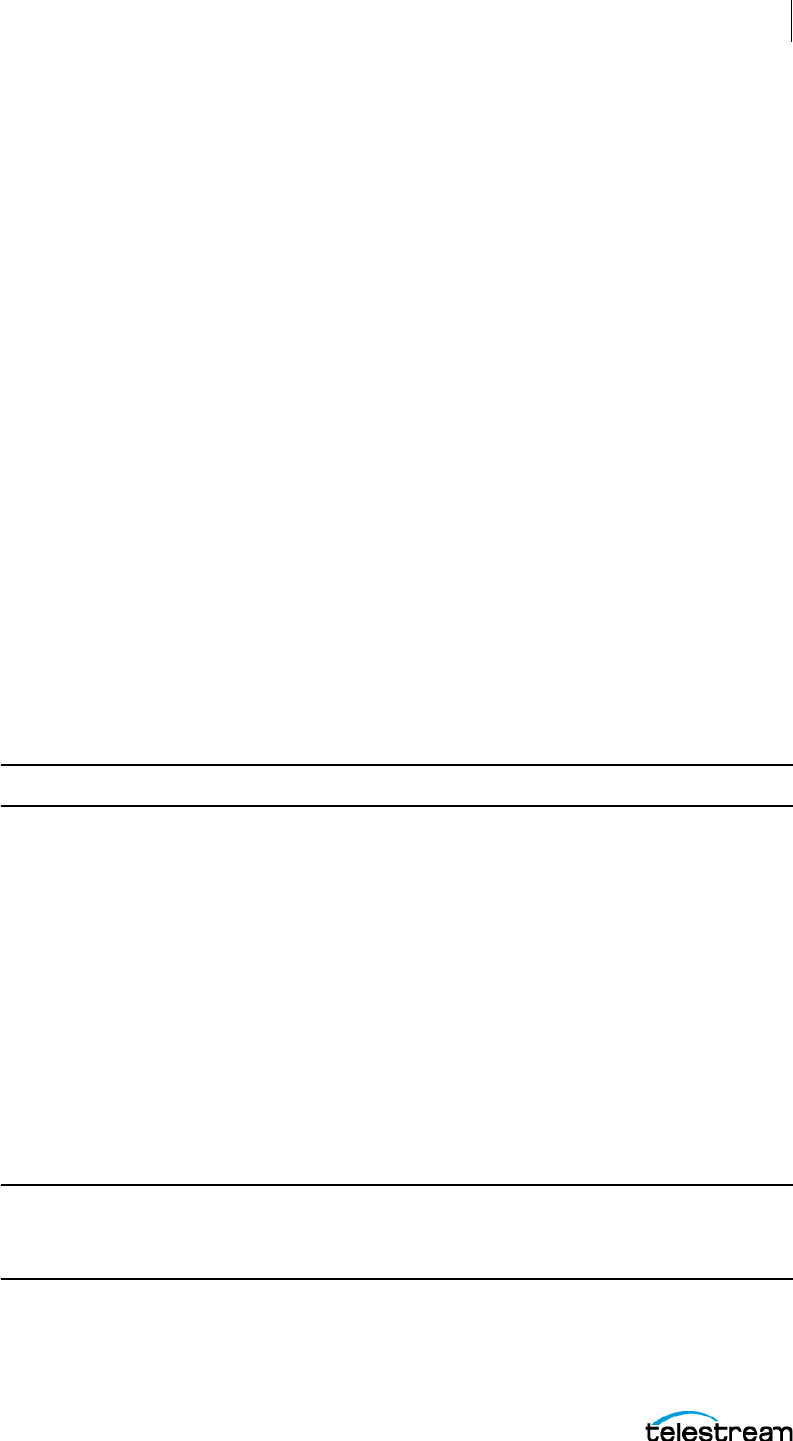
17
Introduction
Telestream ScreenFlow is a Mac-based tool for screen recording and video editing.
Topics
■ Introducing ScreenFlow
■ ScreenFlow Movies
■ ScreenFlow Slide Shows
■ ScreenFlow Trial Mode
Note: To install ScreenFlow, see Installation.
Introducing ScreenFlow
ScreenFlow enables you to compose, edit, and export screencasts. You can create
software demos, tutorials, application previews, training videos, and business
presentations. With ScreenFlow and ScreenFlow Helper, you can record your display,
camera video, and audio simultaneously. The ScreenFlow editing interface lets you
combine video, still images, voice-overs, text, and music. You can add call-outs and
transitions. When you’re done. ScreenFlow encodes your video to MPEG-4, and
publishes it to any of several video-hosting platforms.
ScreenFlow is built on Cocoa, with full support for 64-bit architecture, ColorSync, and
Retina displays.
Note: ScreenFlow can record the computer screen as well as camera video.
Throughout this guide, the computer screen is referred to as the display—as in display
video—in keeping with Apple terminology.

Introduction
ScreenFlow Movies
18
ScreenFlow User Guide
ScreenFlow Movies
ScreenFlow helps you make movies quickly and easily. Import your clips into the media
library, and drop them into the timeline. Join and sync clips in a single drop. Then, add
transitions, voice-overs, and music beds. ScreenFlow includes tools for trimming clips,
nesting and grouping clips, adding transitions, and adding effects to video and sound.
ScreenFlow Slide Shows
Slide shows have never been easier to make. You can use images in leading formats
such as PNG, TIFF, and JPEG. Set the duration for each image. Add transitions, text
overlays, and graphics. Add your own voice-overs and music beds. Then, use
ScreenFlow to render your slide show for publication or distribution.
ScreenFlow Trial Mode
If you acquired ScreenFlow directly from Telestream, ScreenFlow operates in trial mode
until you purchase and activate a license. In trial mode, all ScreenFlow features are
available, but your movies are watermarked when you export or publish them.
If you acquired ScreenFlow from the Mac App Store, ScreenFlow behaves differently.
The App Store has its own installation and licensing procedure.
To unlock ScreenFlow, go to Unlocking ScreenFlow via Telestream Web Store.
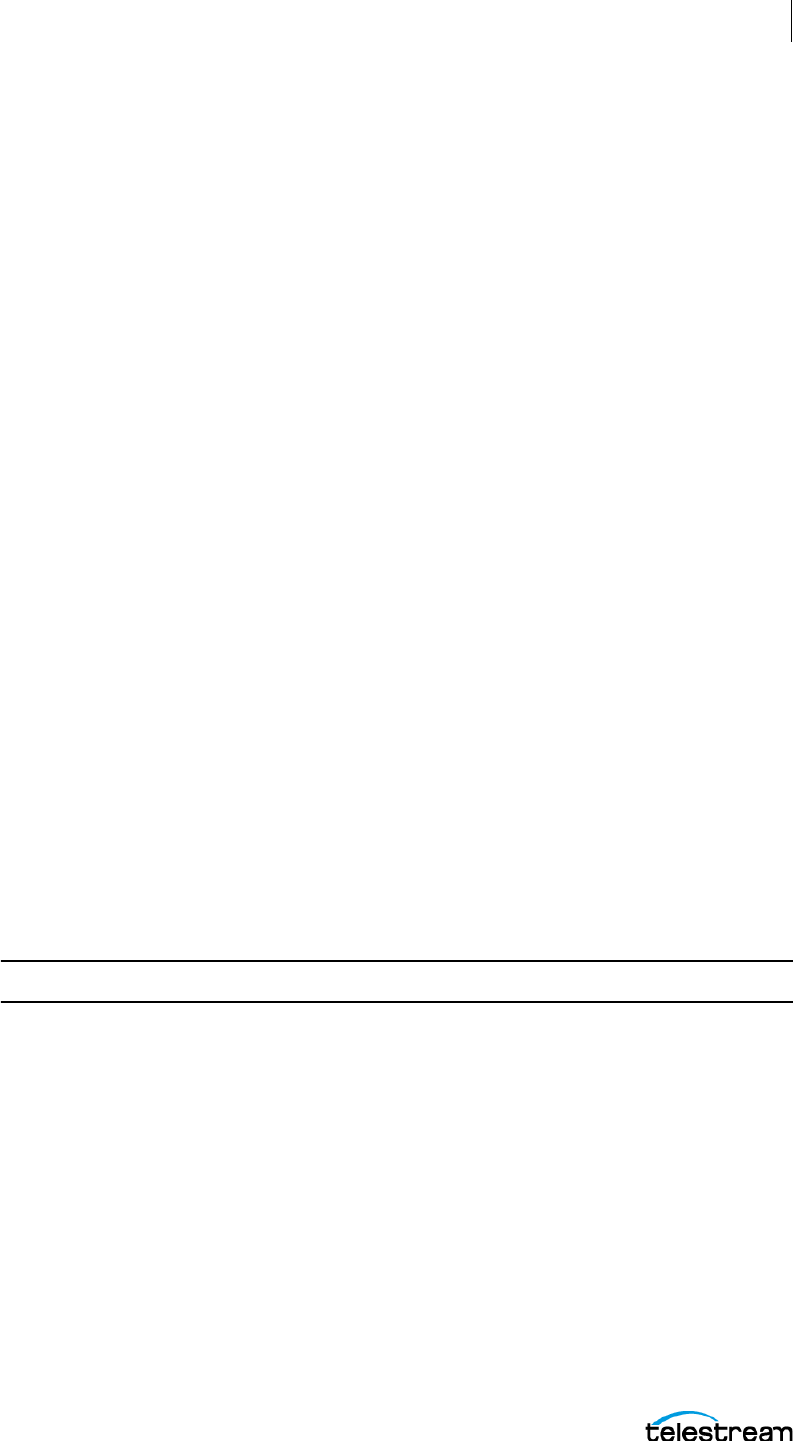
19
Installation
You can install, upgrade, and uninstall ScreenFlow, and related subsystems, on any Mac
meeting the ScreenFlow system requirements.
Topics
■ System Requirements
■ Licenses (Telestream Web Store Only)
■ Installing ScreenFlow via Telestream Web Store
■ Unlocking ScreenFlow via Telestream Web Store
■ Activating Your Telestream Web Store License
■ Installing Telestream Audio
■ Deactivating Your ScreenFlow License
■ Removing ScreenFlow from Your Computer
■ Launching ScreenFlow
Note: Be sure to review the system requirements before installing ScreenFlow.
System Requirements
• Intel-based Mac2 CPU with 64-bit processor (Core i3 or higher); or Apple M1 (or
higher) CPU.
• Operating Systems
– macOS Monterey 12
– macOS Big Sur 11.3
– macOS Catalina 10.15
• Minimum 4 GB RAM
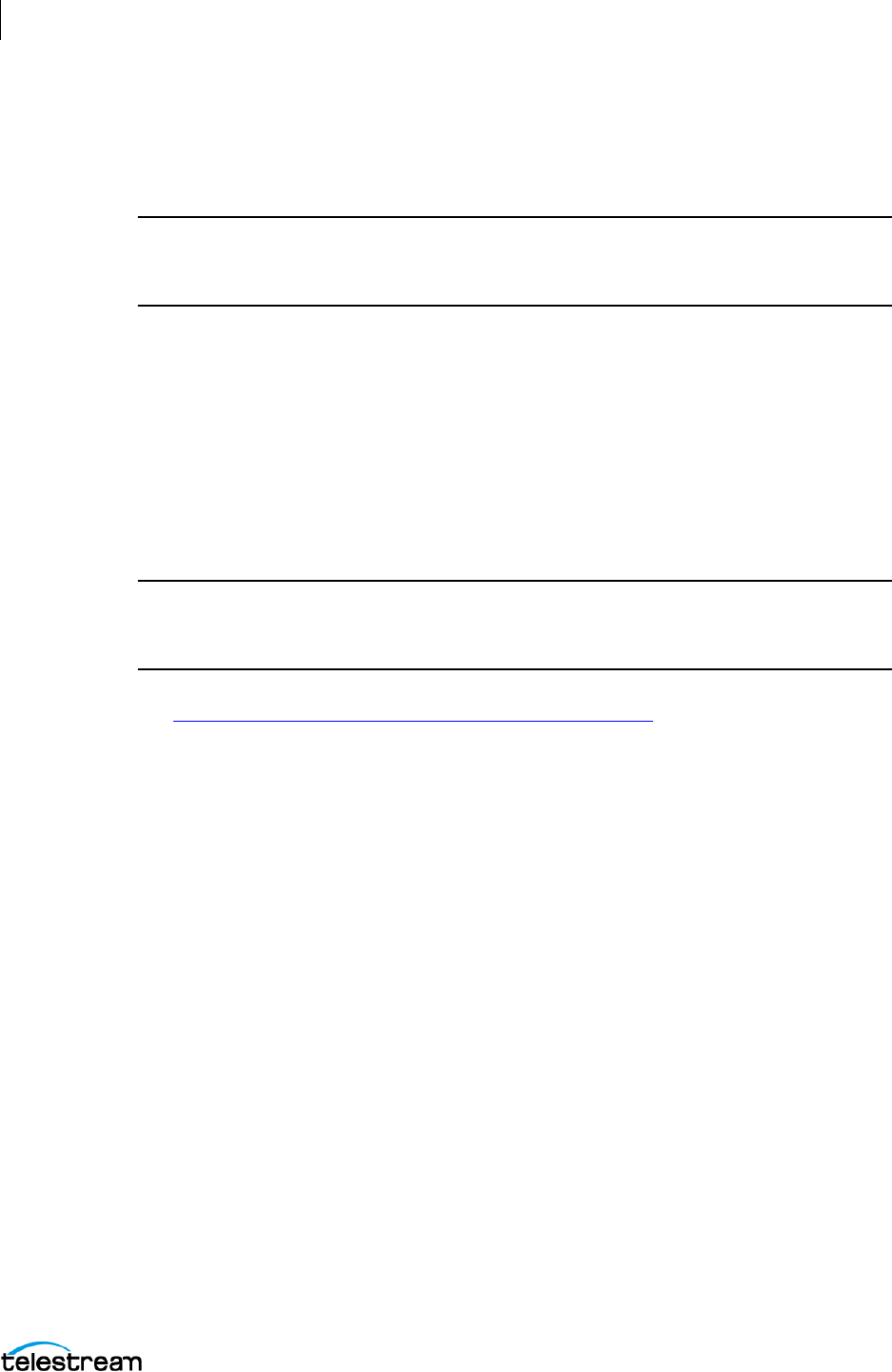
Installation
Licenses (Telestream Web Store Only)
20
ScreenFlow User Guide
• 20 GB hard drive
• Apple macOS-approved graphics card
• Online Help browser requirements: Safari.
Note: ScreenFlow does not support “Hackintosh” systems.
ScreenFlow requires a GPU officially supported by Apple.
ScreenFlow does not support NVIDIA “Web Drivers.”
Licenses (Telestream Web Store Only)
You must license ScreenFlow to fully enable export capabilities. If ScreenFlow is not
licensed, all exported files are watermarked.
The Licenses tab of the Settings dialog displays your serial number and allows you to
manage your licenses.
Only administrators can unlock license functions. Guests can’t remove your license.
Note: If you purchased ScreenFlow through the Mac App Store, ScreenFlow doesn’t
display the Licenses tab. The Mac App Store has its own licensing and updating
processes.
See Production & Streaming: Renewal & Licensing Questions
.
Licensing ScreenFlow
To activate a ScreenFlow license, do the following:
1. Select ScreenFlow > Settings.
2. Select the Licenses tab.
See Licenses Settings Tab.
3. Click Purchase. Select and purchase a ScreenFlow product.
Telestream emails you the serial number for ScreenFlow.
4. Enter the serial number into the Serial Number field, and click Activate.
Deactivating a Serial Number
To deactivate a ScreenFlow license, do the following:
1. Select ScreenFlow > Settings.
2. Select the Licenses tab.
See Licenses Settings Tab.
3. Enter the serial number into the Serial Number field.
4. Click Deactivate.
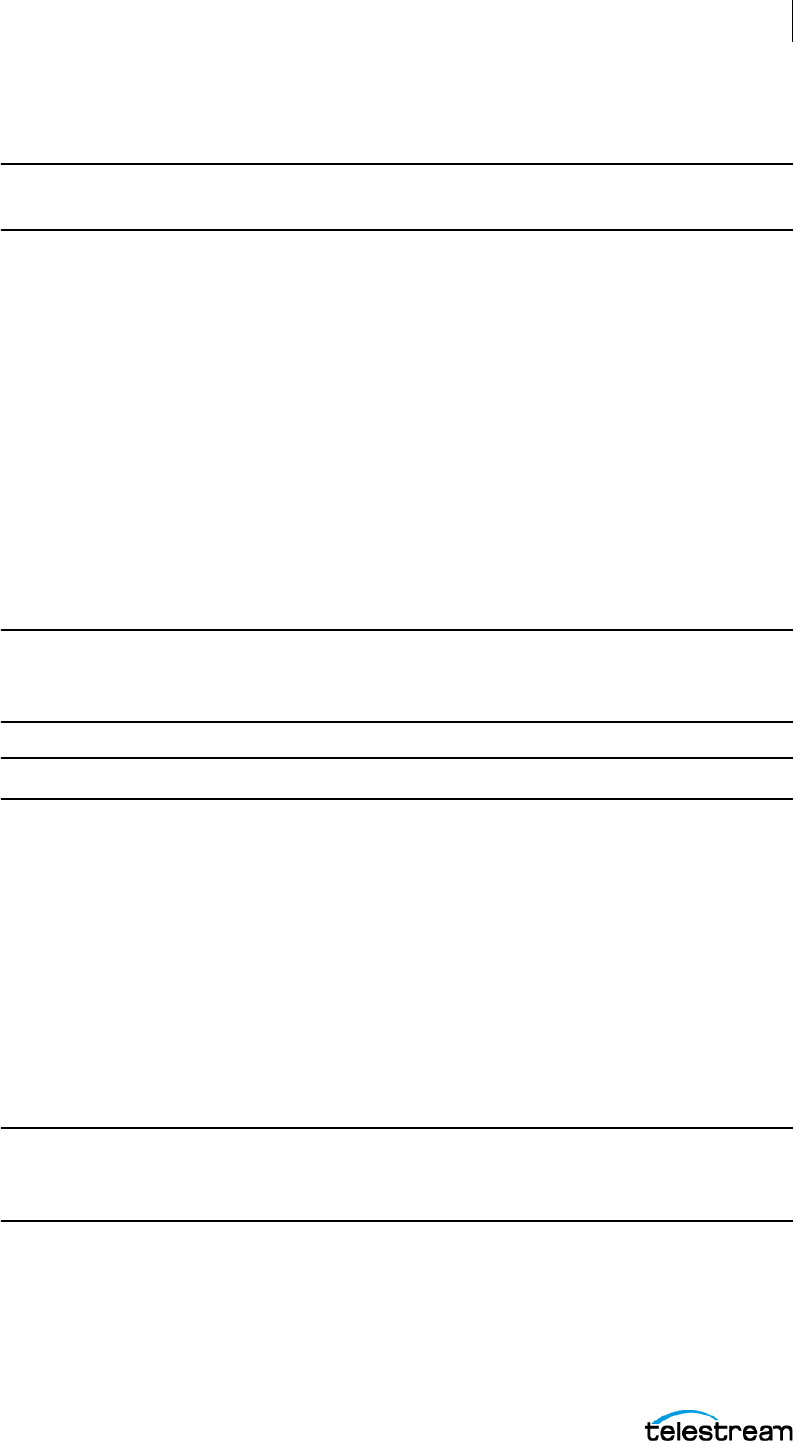
Installation
Installing ScreenFlow via Telestream Web Store
21
ScreenFlow User Guide
Removing or Changing the ScreenFlow License
Note: Don’t use this method if you purchased ScreenFlow from the Mac App Store.
The App Store has its own installation and licensing procedure.
To remove or change the ScreenFlow license, do the following:
1. Click the lock at the bottom of the window.
2. Make the changes desired.
3. When done, click the lock again.
Updating ScreenFlow
You can check for updates to ScreenFlow by selecting ScreenFlow > Check for Updates.
When ScreenFlow displays the Software Update screen, click Install Update.
Installing ScreenFlow via Telestream Web Store
Note: Use this method only if you purchased ScreenFlow directly from the Telestream
Web Store. If you purchased ScreenFlow from the Mac App Store, refer to the Mac App
Store installation and upgrade instructions.
Note: You must be logged in as an administrator in order to continue.
ScreenFlow is available from Telestream as a DMG installer file, as well as from the Mac
Apps Store. This topic is for users who have downloaded ScreenFlow from the
Telestream Web site.
To install ScreenFlow, do the following:
1. To download and launch the ScreenFlow installer, do one of the following:
– Using the Safari browser, download or open the ScreenFlow DMG installer file.
MacOS automatically mounts the disk image and runs the installer.
– Using a browser other than Safari, download the ScreenFlow DMG installer file.
Double-click the DMG file to run the ScreenFlow installer.
Note: The installer attempts to close applications including QuickTime, Final Cut Pro,
Episode Desktop, and Pipeline Control before installation. If the installer can’t close
these applications, installation will fail after about a minute.
The installer displays an icon for ScreenFlow and an icon for the Applications folder.
2. Drag the ScreenFlow icon onto the Applications folder.
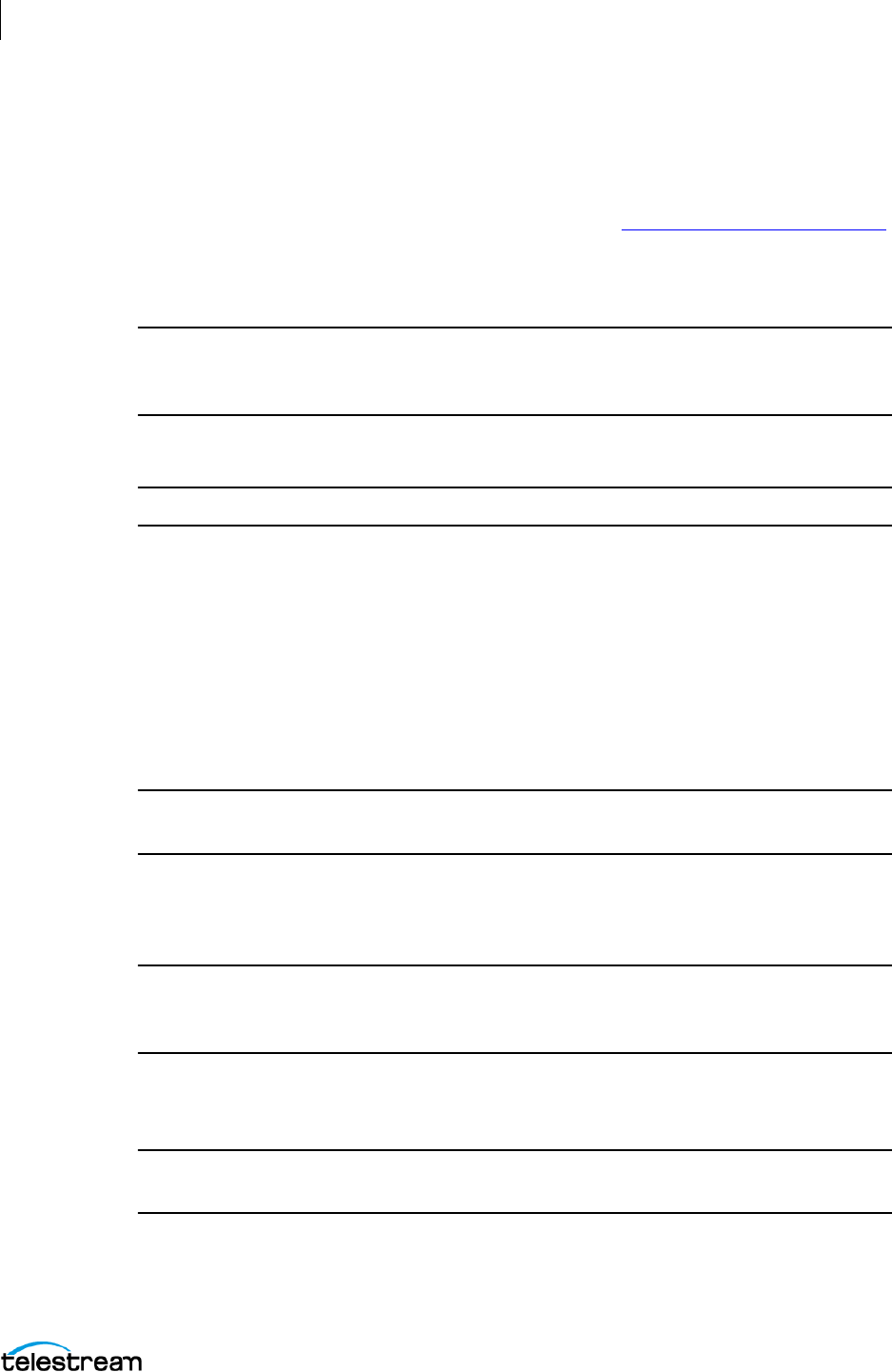
Installation
Unlocking ScreenFlow via Telestream Web Store
22
ScreenFlow User Guide
3. Enter an administrative user name and password to continue.
Your computer installs ScreenFlow.
4. When installation is complete, close the installer.
See also Purchase Menu (Telestream Web Store Only) and Install and Activate ScreenFlow
.
Unlocking ScreenFlow via Telestream Web Store
Note: Use this method only if you purchased ScreenFlow directly from the Telestream
Web Store. If you purchased ScreenFlow from the Mac App Store, refer to the Mac App
Store installation and upgrade instructions.
You must purchase a ScreenFlow license in order to export movies without watermarks.
Note: You must be logged in as an administrator in order to continue.
To purchase a ScreenFlow license, do the following:
1. Start ScreenFlow.
2. Select ScreenFlow > Settings and click the Licenses tab.
See Licenses Settings Tab.
3. Click Purchase. This redirects you to the Telestream online store where you can
purchase or upgrade your license.
When the purchase is complete, ScreenFlow installs the license automatically.
Note: If ScreenFlow doesn’t display a Purchase button, ScreenFlow already is
purchased, registered, activated, and unlocked.
Activating Your Telestream Web Store License
Note: Use this method only if you purchased ScreenFlow directly from the Telestream
Web Store. If you purchased ScreenFlow from the Mac App Store, refer to the Mac App
Store installation and upgrade instructions.
If you have already purchased a license through the Telestream Web Store, Telestream
sent you an email receipt containing your license key.
Note: If your Macintosh is not connected to the Internet, follow the instructions in the
Manual Activation Guide to activate your license and unlock ScreenFlow.
The easiest way to register the license key and activate ScreenFlow is to click on the link
provided in your email receipt. If the link doesn’t work, register ScreenFlow as follows:
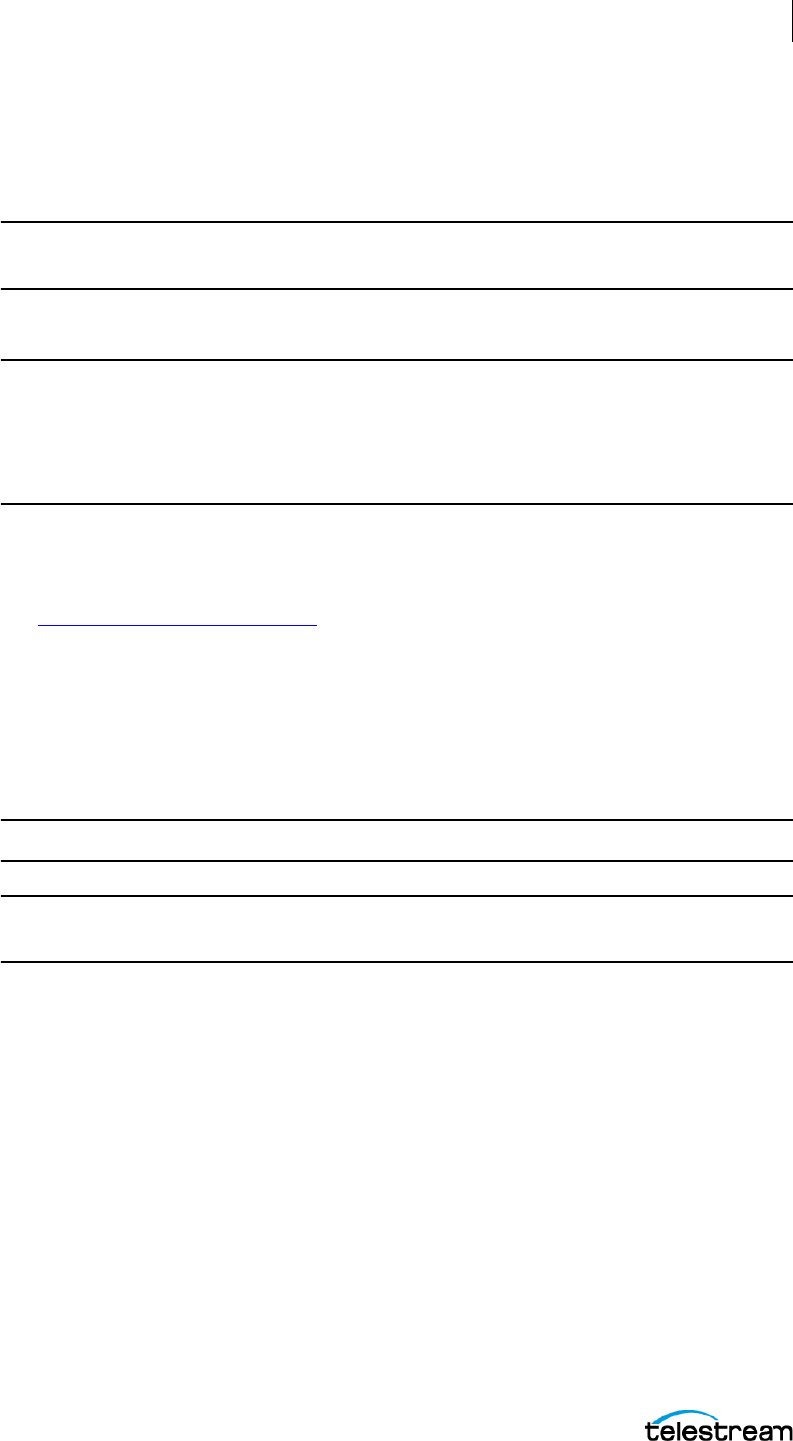
Installation
Installing Telestream Audio
23
ScreenFlow User Guide
1. Launch ScreenFlow.
2. Select ScreenFlow > Settings and click the Licenses tab.
See Licenses Settings Tab.
Note: If ScreenFlow doesn’t display a Purchase button, ScreenFlow already is
purchased, registered, activated and unlocked.
3. Enter your serial number and click Activate.
Note: If the Activate button is dimmed, the license is invalid. Double-check your
license from the e-mail. Make sure that all letters are capitalized, dashes are included,
and all 0s are zeros, not the capital letter O. It might help to copy and paste your serial
number from your e-mail. Don’t copy any additional text such as spaces. If you still
have activation problems, contact technical support.
Your serial number is activated and ScreenFlow is unlocked. Close the Settings window
to continue.
See Install and Activate ScreenFlow
.
Installing Telestream Audio
To capture computer audio, ScreenFlow must install the Telestream audio driver.
ScreenFlow starts the installation process automatically if you attempt to record
computer audio without the driver installed.
Note: To proceed, log in as an administrator.
Note: If you purchased ScreenFlow from the Mac App Store, ScreenFlow directs you
to the Telestream website to download and install the driver.
To install the Telestream audio driver manually, follow these steps:
1. In ScreenFlow, select ScreenFlow > Settings. Then click the Advanced tab.
See Advanced Settings Tab.
2. Using the Installer application, click the Install Driver button.
ScreenFlow displays the Install Telestream Audio dialog.
3. Click Continue.
The installer displays a space-requirement message.
4. Click Install.
5. To install the driver, enter your password and click OK.
The Installer installs the Telestream audio driver.
6. To close the Installation Complete dialog, click Close.
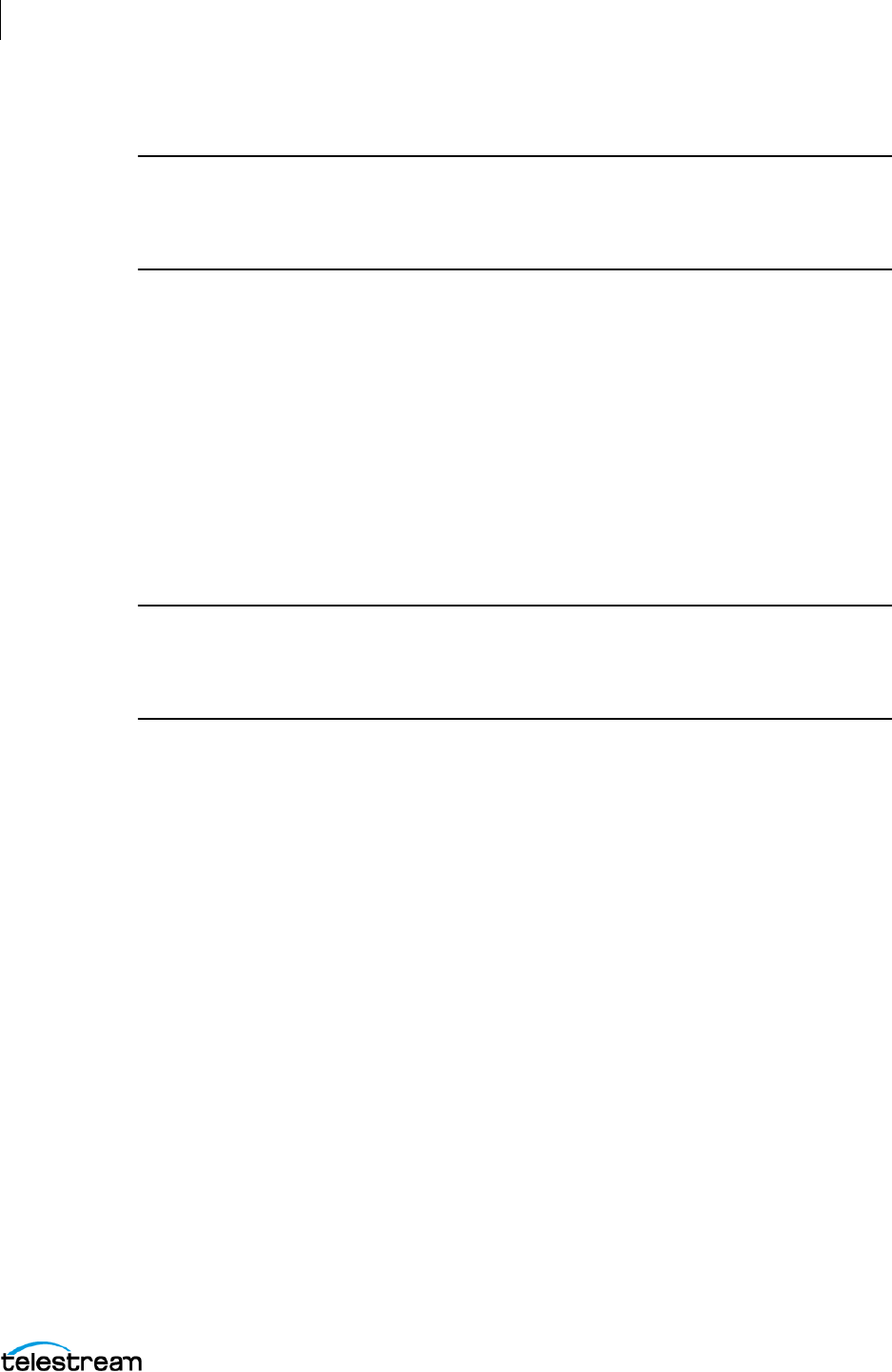
Installation
Installing Telestream Audio
24
ScreenFlow User Guide
Upgrading Telestream Audio Manually
Note: If ScreenFlow prompts you to upgrade the audio driver, select Cancel to exit the
upgrade message. Before installing the new audio driver, uninstall the current audio
driver. Then, install the latest version of the audio driver, either manually or using the
Record Computer Audio checkbox.
To upgrade the Telestream audio driver manually, do the following:
1. In ScreenFlow, select ScreenFlow > Settings. Then click the Advanced tab.
See Advanced Settings Tab.
2. Click the Install Driver button to display the Install window, then click Continue.
3. When ScreenFlow displays the space requirement message, click Install.
4. Enter your password and click Install Software.
5. After ScreenFlow installs the Telestream audio driver, click Close.
Upgrading Telestream Audio Via the New Recording Tab
Note: If ScreenFlow prompts you to upgrade the audio driver, select Cancel to exit the
upgrade message. Before installing the new audio driver, uninstall the current audio
driver. Then, install the latest version of the audio driver, either manually or using the
Record Computer Audio checkbox.
To upgrade the Telestream audio driver through the New Recording tab, do the
following:
1. Launch ScreenFlow to display the Welcome window.
2. Select New Recording.
3. Check Record Computer Audio.
4. When ScreenFlow displays the upgrade message, select Upgrade, and click
Continue.
5. When ScreenFlow displays the space requirement message, click Continue.
6. Enter your password and click Install Software.
7. After ScreenFlow installs the Telestream audio driver, click Close.
Uninstalling the Telestream Audio Driver
To uninstall the Telestream audio driver, do the following
1. Select ScreenFlow > Settings.
2. Click the Advanced tab.
See Advanced Settings Tab.
3. Click Uninstall Driver and enter the password.
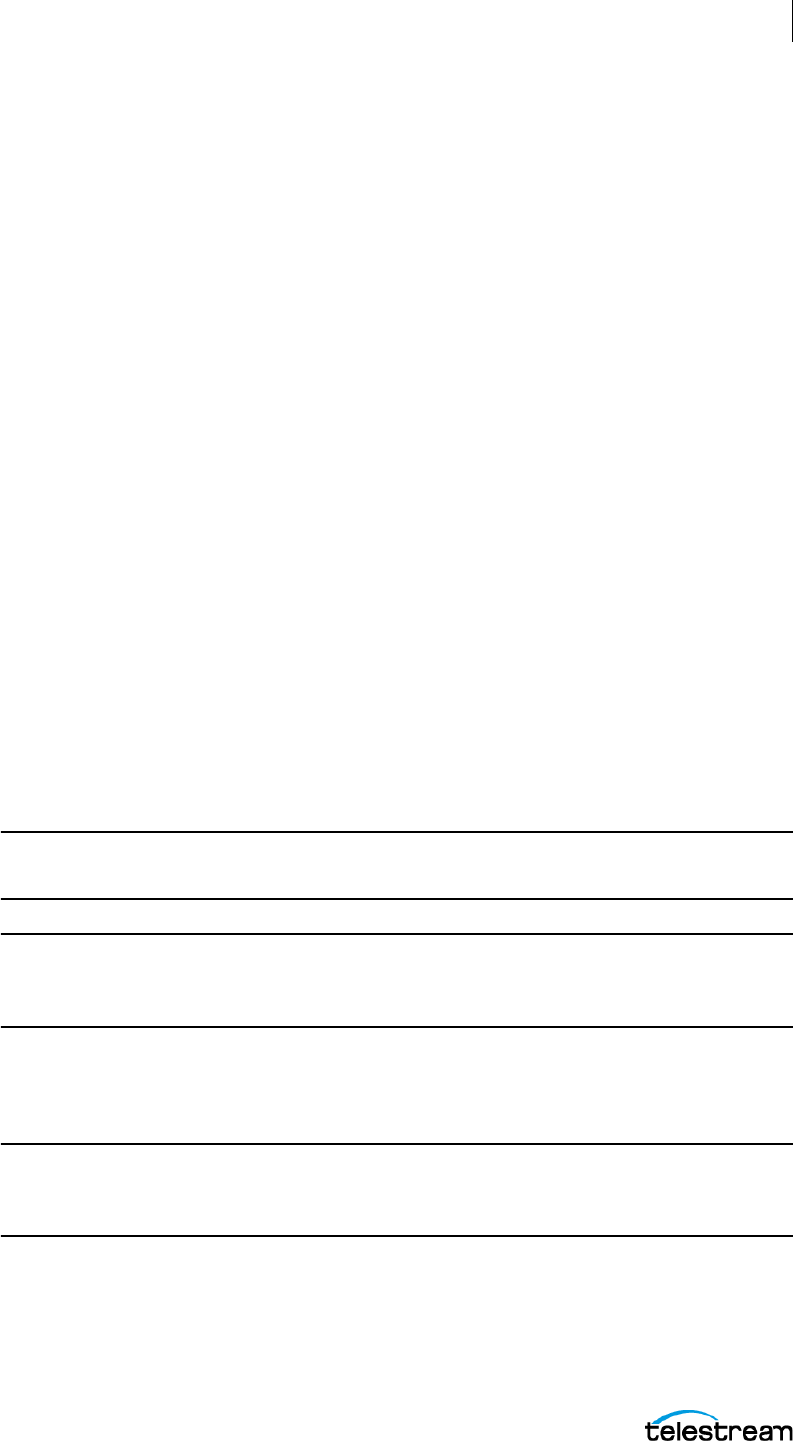
Installation
Deactivating Your ScreenFlow License
25
ScreenFlow User Guide
Configuring the Telestream Audio Capture Device
You can use Audio MIDI setup to control the sample rate at which the Telestream Audio
Capture device records audio. The sample rate you select for the Telestream Audio
Capture device is the sample rate at which ScreenFlow records the audio. The
ScreenFlow default sample rate is 48 kHz.
ScreenFlow has an inherent latency. Audio flows to the Telestream audio driver, back to
ScreenFlow recording system, then out through the speakers. However, you can
configure the audio driver to eliminate latency. To enable recording without latency, do
the following:
1. Go to ScreenFlow > Settings > Advanced.
See Advanced Settings Tab.
2. Check both of these boxes:
– Allow device to be Sound Output
– Disable Sound Output Monitoring
3. Open Audio MIDI setup and press the (+) button. Then select Create Multi-Output
Device.
4. Add your system speakers to this multi-output device.
5. Add Telestream Audio Capture to this multi-output device.
6. Click the Gear button and select Use This Device For Sound Output.
7. (Optional) If desired, also select Play Alerts and Sound Effects Through This Device.
When configured in this way, audio flows immediately to your output device.
ScreenFlow can now record the audio without adding latency to the recording.
Note: When you configure ScreenFlow without latency, ScreenFlow disables the
audio level controls.
Note: Consider configuring your Digital Audio Workstation (DAW) to route desired
channels to the Telestream Audio Capture Device. The DAW adds an output from the
DAW directly to ScreenFlow, while leaving your workflow untouched.
Deactivating Your ScreenFlow License
Note: Use this method only if you purchased ScreenFlow directly from the Telestream
Web Store. If you purchased ScreenFlow from the Mac App Store, refer to the Mac App
Store installation and upgrade instructions.
If you want to use your ScreenFlow license on another computer, you must deactivate it
first.
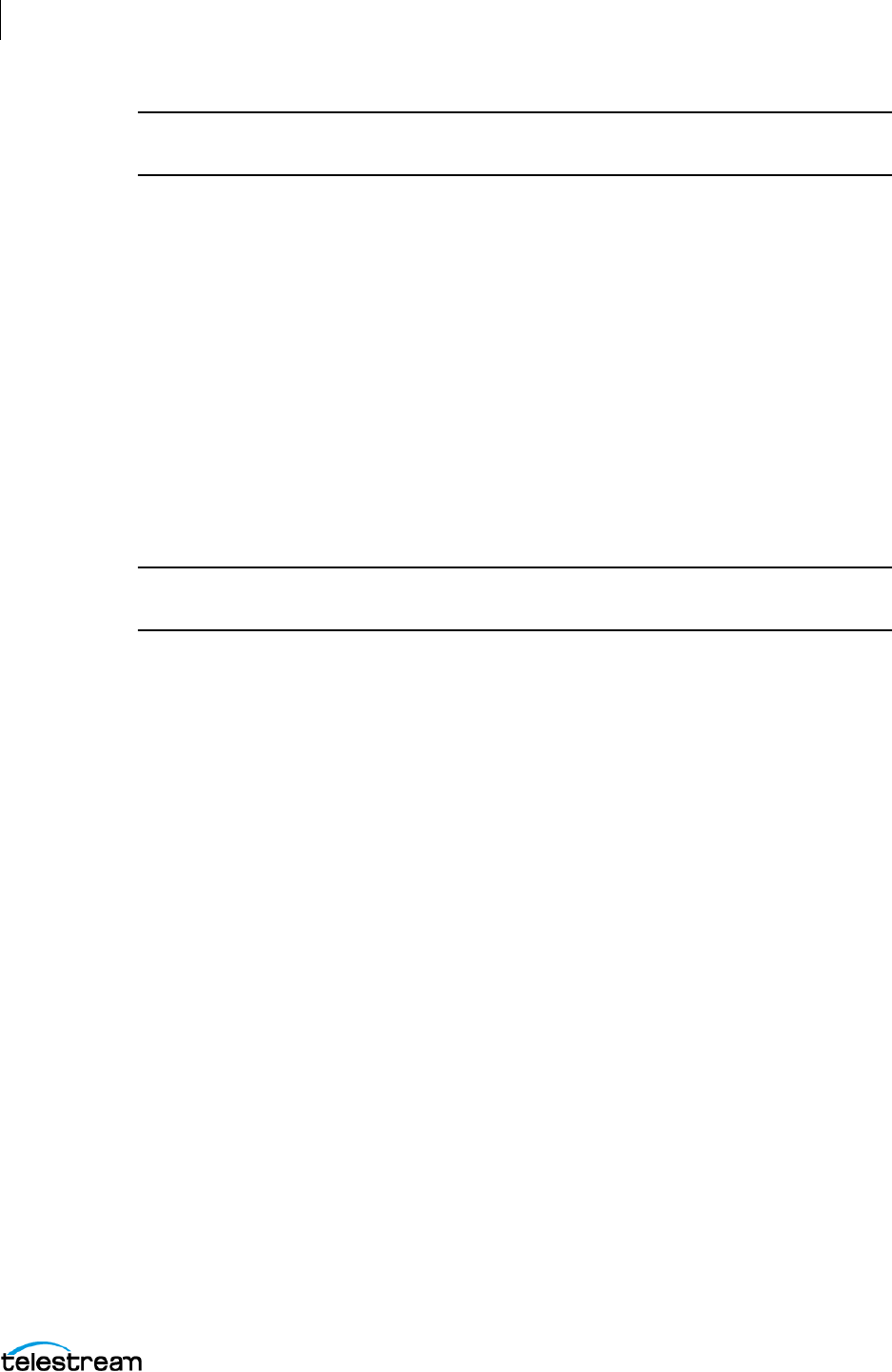
Installation
Removing ScreenFlow from Your Computer
26
ScreenFlow User Guide
Note: You must log in as an administrator. If you don’t have an administrative
account, create one in order to continue.
To deactivate the ScreenFlow license, do the following:
1. Launch ScreenFlow.
2. Select ScreenFlow > Settings and click the Licenses tab.
See Licenses Settings Tab.
3. Click Deactivate to deactivate the license on the computer. Now, you can use the
same license in ScreenFlow running on another computer. Please allow 15 minutes
before reactivating your license.
Removing ScreenFlow from Your Computer
To uninstall ScreenFlow, open the Applications folder and drag the ScreenFlow
application to the trash.
Note: The ScreenFlow license is stored separately, so you don’t need to re-activate
your license if you reinstall ScreenFlow.
To completely remove a version of ScreenFlow that has been upgraded to a newer
version, do the following:
1. Save any work in progress, and make sure ScreenFlow is not open.
2. Open a new Finder window.
3. Select the GO menu at the top of screen, press and hold the Option key and select
the Library that is displayed.
4. In the Library folder open the Caches folder.
5. Delete all folders that start with net.telestream.ScreenFlow (4/5/6/7/8/9).
6. Open a new Finder window.
7. Select the GO menu at the top of screen, select
Computer > [your computer name] > Library > Preferences.
8. In the Preferences folder, delete all folders that start with net.telestream.ScreenFlow
(4/5/6/7/8/9). You will be asked for your admin password.
9. Delete all of the following files:
– ~/Library/Preferences/WSG985FR47.net.telestream.ScreenFlowhelper.plist
– ~/Library/Saved Application State/net.telestream.ScreenFlow6/7/8/9/
10.savedState
– ~/Library/Application Support/ScreenFlow/Global Library
10. Select the GO menu at the top of screen, select
Computer > [your computer name] > System > Extensions.
11. Delete this file: TelestreamAudio.kext.
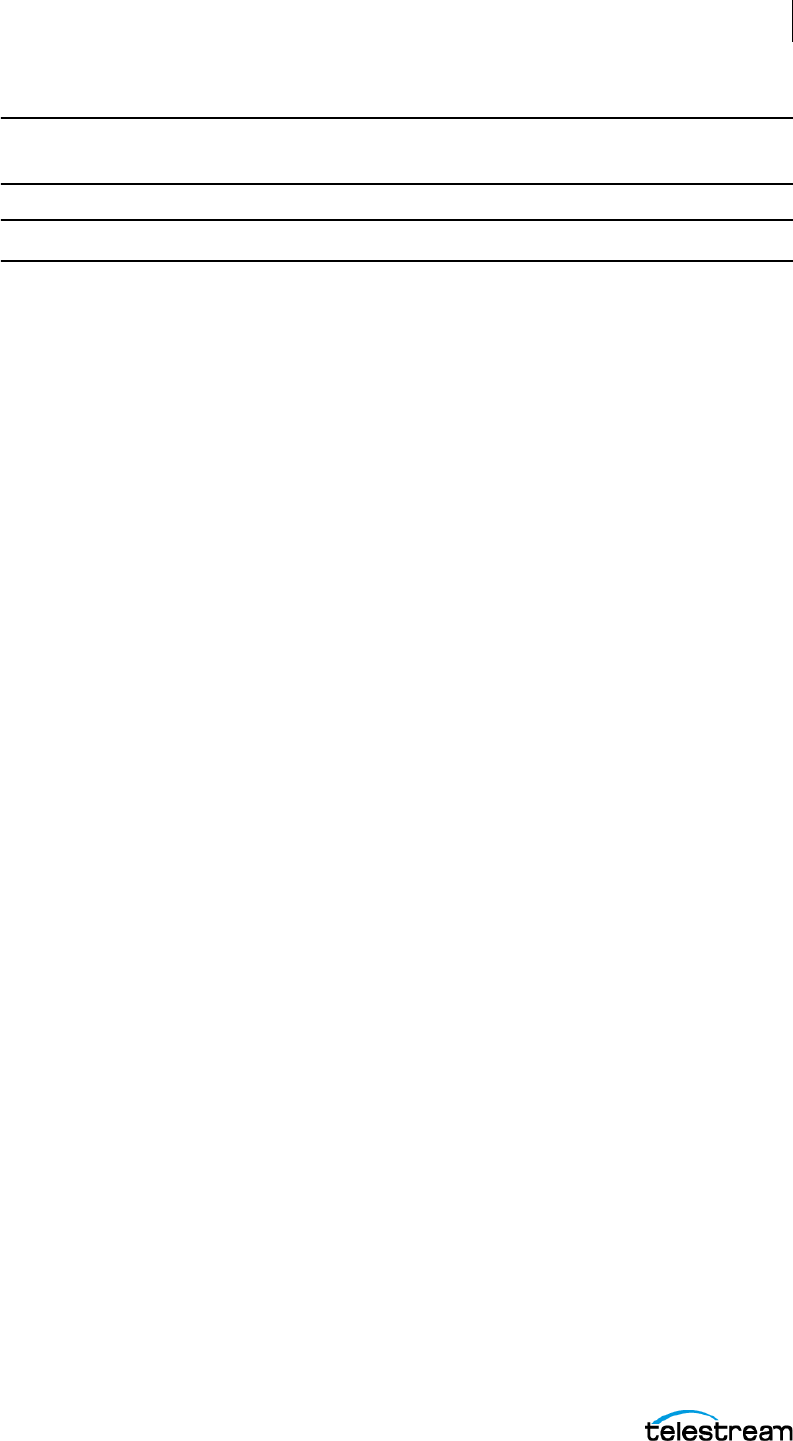
Installation
Launching ScreenFlow
27
ScreenFlow User Guide
Note: Some of these files may not be present, because the associated feature was not
used.
Note: You may need also to reactivate your license.
Launching ScreenFlow
To launch ScreenFlow, follow these steps:
1. Open your Applications folder.
2. Drag ScreenFlow onto your dock bar.
3. Click the ScreenFlow icon to launch the application.
ScreenFlow displays a Welcome window.

Installation
Launching ScreenFlow
28
ScreenFlow User Guide

29
Configuration
You can customize ScreenFlow to meet your needs through ScreenFlow settings.
Topics
■ Settings
■ Configuring ScreenFlow Helper
■ The ScreenFlow Document Formats
■ Configuring Recording Options
■ Setting the Countdown Window Preference
■ Setting Permissions for Recording
■ Configuring the Canvas
■ Configuring Video Properties
■ Configuring Audio Properties
■ Configuring Screen Recording Properties
■ Configuring Callout Properties
■ Configuring Annotations Properties
■ Changing Shortcut Keys
Settings
To choose settings, select ScreenFlow > Settings. Then, click the tab desired.
See ScreenFlow Settings and Deleting Cache & Preferences
.
Configuring ScreenFlow Helper
Configure ScreenFlow Helper to launch, either when you log in to your computer, or
only when you start ScreenFlow. Once launched, ScreenFlow Helper runs in the
background so that you can start and stop recording without changing the state of
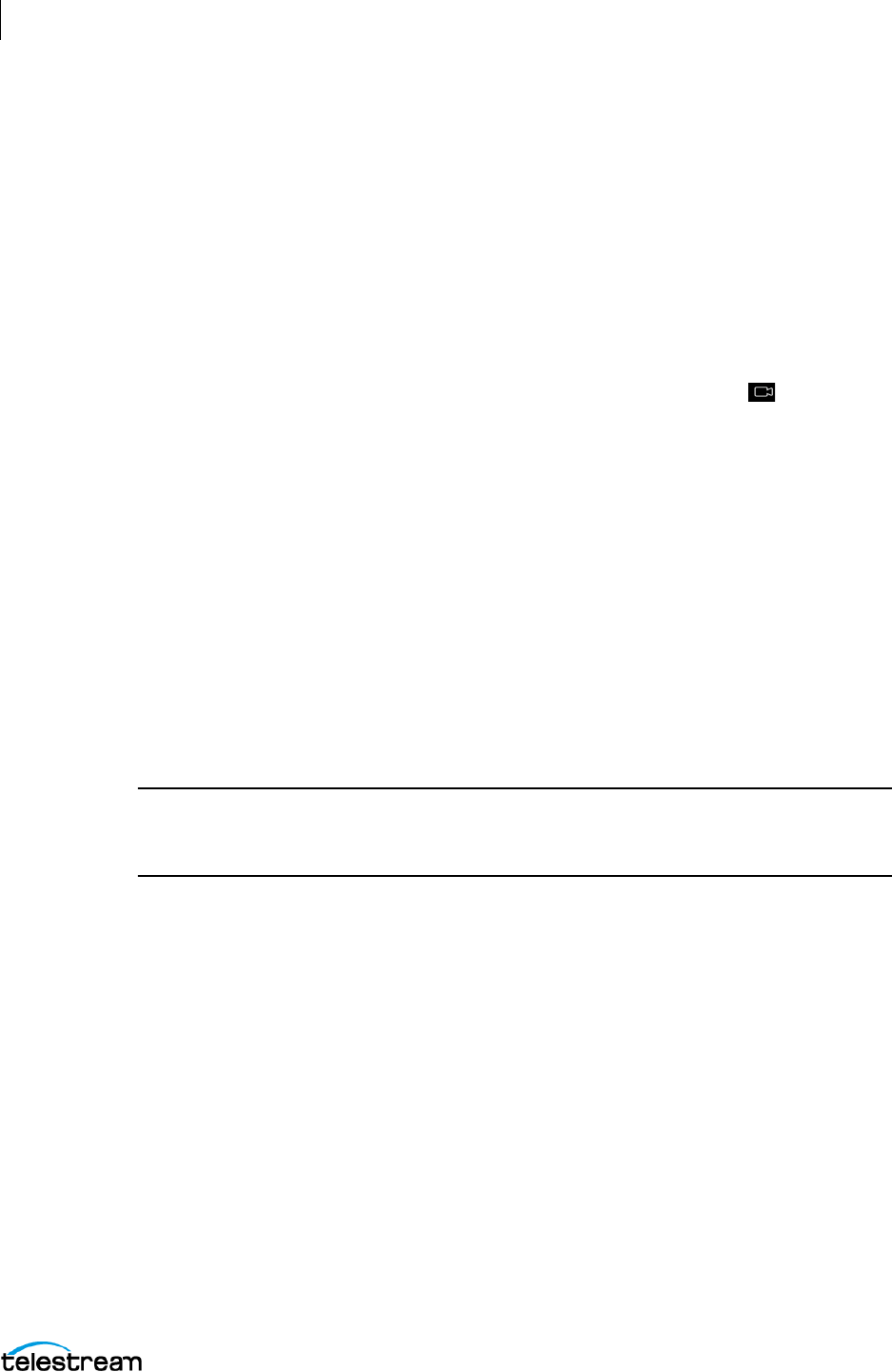
Configuration
The ScreenFlow Document Formats
30
ScreenFlow User Guide
your system. To have ScreenFlow Helper launch when you boot your computer, or to
disable ScreenFlow Helper from starting when you boot your computer, do the
following:
1. Select ScreenFlow > Settings > General.
2. Do one of the following:
• To have ScreenFlow Helper launch when you boot your computer, check the box
for Launch Screenflow Helper at user login.
• To have ScreenFlow Helper not launch when you boot your computer, uncheck the
box for Launch Screenflow Helper at user login.
When ScreenFlow Helper is running, it displays a camera-menu button , in the menu
bars for ScreenFlow and Finder.
The ScreenFlow Document Formats
ScreenFlow stores the settings of its properties, and references to related media files, in
document files. There are two types of ScreenFlow document files: the Packaged
Document format type and the ScreenFlow Flat Document type.
When you choose Packaged Document, ScreenFlow stores the media files associated
with the document, as a document bundle, in the document file itself. ScreenFlow
saves the Packaged-Document document in a file with the extension SCREENFLOW.
When you choose the ScreenFlow Flat Document file format, ScreenFlow doesn’t
bundle the associated media files. Instead, ScreenFlow stores pointers to the media files
in a document file with the extension SCREENFLOWF.
Note: ScreenFlow contains references, called bookmarks, to ScreenFlow Flat
Document files.When you move a Flat Document file to a different folder, ScreenFlow
automatically tracks the file to its new location. You don’t need to relink the file.
Configuring the ScreenFlow Document Format
To configure the ScreenFlow document format, do the following:
1. Select ScreenFlow >Settings > Advanced.
2. Select a file format from the Default File Format drop-down menu.
3. To close the Settings dialog, click the red “x.”
Configuring Recording Options
ScreenFlow provides several settings for recording. The recording options are displayed
on the General tab and on the Advanced tab.
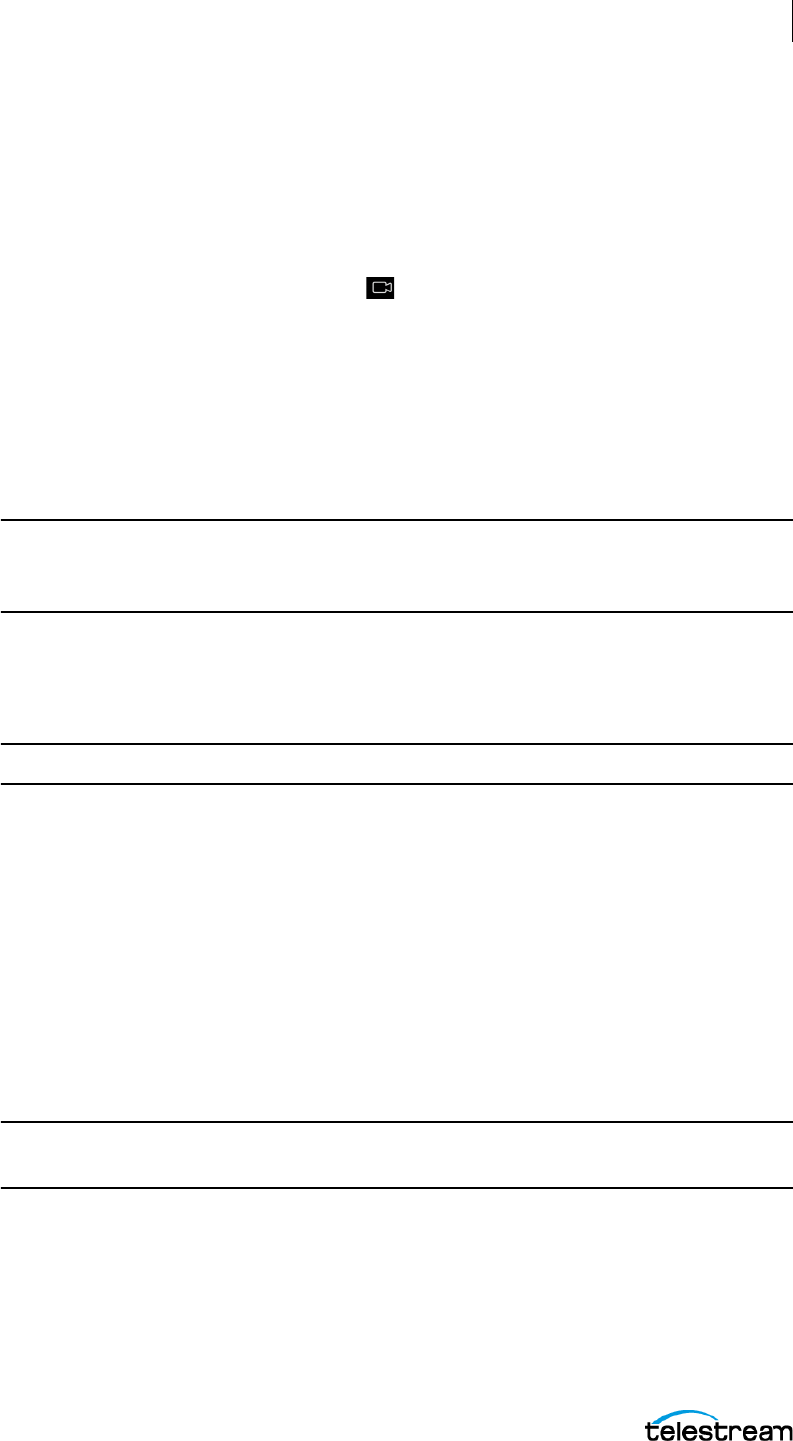
Configuration
Setting the Countdown Window Preference
31
ScreenFlow User Guide
You can set up ScreenFlow to record video and audio from various cameras and
microphones, depending on your document, and you can change these settings at any
time.
To configure your recording options, do the following:
1. Do one of the following:
• Click the ScreenFlow Helper button and select Configure Recording.
If the New Recording option is grayed-out, you must first open an existing recording
or create a new one.
• Select File > New.
• Select File > Add Additional Recording.
See ScreenFlow Helper Menu.
ScreenFlow displays the New Recording dialog.
Note: Add Additional Recording allows you to not record the screen, and allows you to
close ScreenFlow automatically before recording. Configure Recording always records
the screen. The recording options are identical in both windows.
2. Check the box next to Record on one or more of the source rows, and select a
source from each drop-down menu.
3. Click the Plus (+) to add more Record options and source menus.
Note: You can also add recordings from the media library.
Setting the Countdown Window Preference
By default, each time you start recording, ScreenFlow displays the countdown window,
providing a delay to allow you to prepare for recording. By default, the countdown is
set to five seconds. To change the countdown preference (or to enable or disable the
countdown), do the following:
1. Select ScreenFlow > Settings > General.
See General Settings Tab.
2. Set the countdown delay for up to ten seconds.
Note: To skip a countdown in progress, simply click on the countdown window.
ScreenFlow begins recording immediately.
Setting Permissions for Recording
Before you can record audio or video, you must give ScreenFlow permission to access
your devices. To set device permissions, do the following:
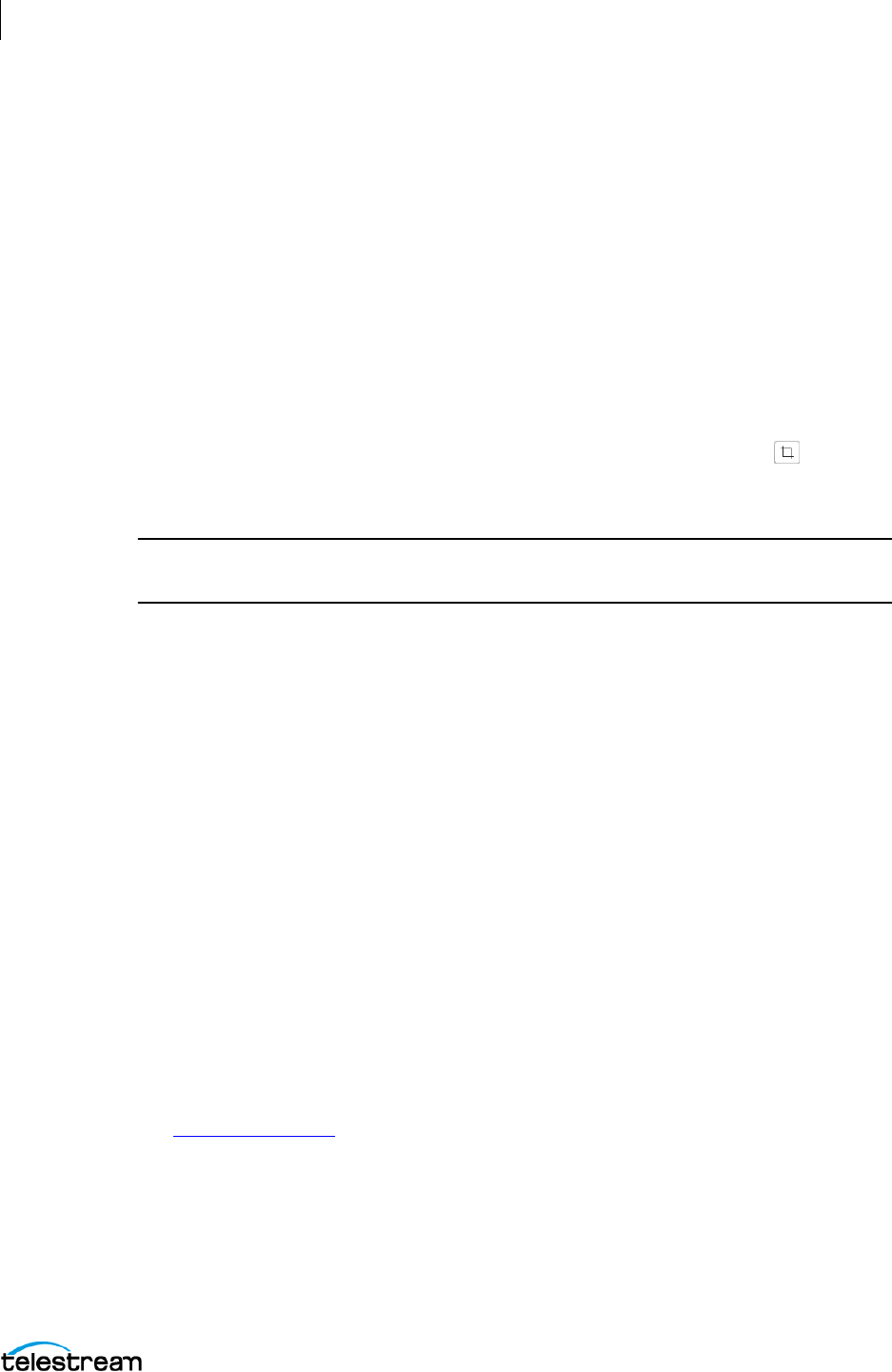
Configuration
Configuring the Canvas
32
ScreenFlow User Guide
1. On the Welcome screen, click Permissions.
ScreenFlow opens the Grant ScreenFlow Permissions dialog.
2. Click a Recording field or the Optional field.
ScreenFlow opens the Security & Privacy control panel.
3. Set the permission for the device or function named in the field.
4. Close the control panel.
Configuring the Canvas
Before you start working on a document, configure the Canvas. This determines the
frame size and background color of your video outputs.
1. To view and configure the Canvas properties, click the Canvas button in the
Editor window.
See The Properties Window.
Note: When ScreenFlow displays Canvas controls, you can’t use the Canvas. Click the
button again to hide the controls.
2. Click the green check mark to save your settings and close the Canvas control bar.
3. To view and configure Canvas settings, click the Canvas tab on the Settings dialog.
See Canvas Settings Tab and The Canvas Window.
Changing the Canvas Size
By default, ScreenFlow sets the Canvas size to the size of the screen when you begin
capturing. Document Settings enables you to change the Canvas size of the document
you have created.
To change the Canvas size, do the following:
1. Select File > Document Settings.
ScreenFlow displays the Canvas settings window.
These settings are similar to the options offered when you create a new document.
2. Select a preset or enter the width and height needed, and select a Timeline
framerate. Click Update.
ScreenFlow immediately resizes the Canvas to the new dimensions.
See Document Settings
, File Menu, and The Canvas Window.
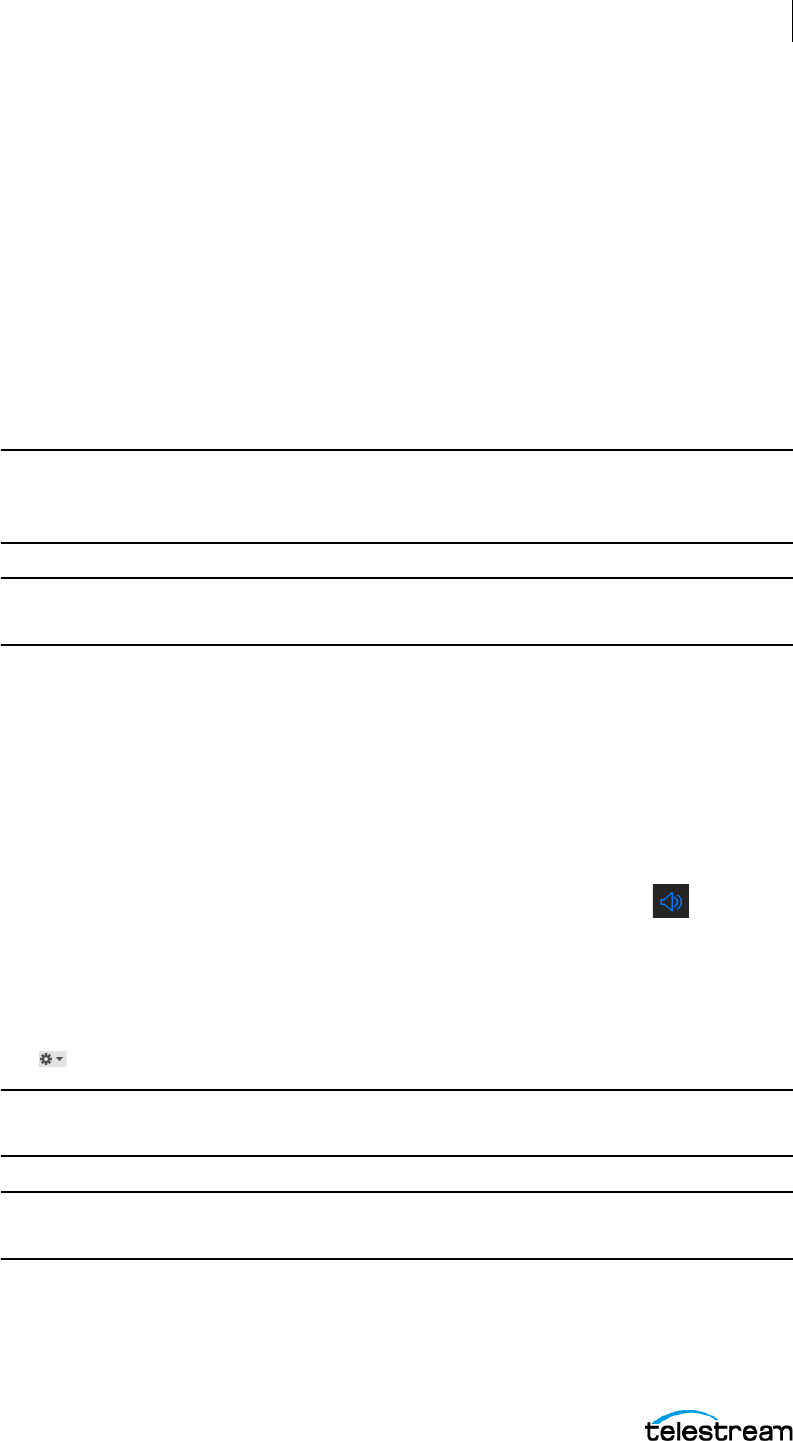
Configuration
Configuring Video Properties
33
ScreenFlow User Guide
Configuring Video Properties
You can configure video properties to make visual changes to screen recordings,
camera-based video, stills, and imported video clips. To add video properties to a clip,
do the following:
1. Select a video clip or still-image clip—or place the scrubber at the start or end of a
video action.
2. To display the Video Properties tab, in the Properties window, click the Video
Properties button.
See The Properties Window.
3. In the Video Properties tab, select the properties desired.
Note: You can also add video actions (transitional properties which change over
time) to a clip. ScreenFlow displays actions as yellow rectangles inside the clip. You can
apply properties to those actions.
Note: To create transitions, you can add video actions to both the start and end of a
clip.
Configuring Audio Properties
You can apply audio properties to any clip which contains audio, including clips with
both video and audio. To add audio properties to a clip, do the following:
1. Select a video clip with audio, an audio clip, or a screen recording clip with audio—
or place the scrubber at the start or end of an audio action.
2. To display the Audio Properties tab, click the Audio Properties button in the
Properties window.
See Audio Properties.
3. In the Audio Properties tab, select the properties desired.
4. To reset all audio properties in the selected clip to default values, click the gear icon
at the top-right corner of the pan and select Reset to Defaults.
Note: You can also add audio actions (transitional properties which change over
time) to a clip. You can apply properties to audio actions.
Note: To create transitions, you can add audio actions to both the start and end of a
clip.
In the Timeline, ScreenFlow displays a waveform for each video clip with a soundtrack.
This waveform provides a visual representation reflecting volume changes.
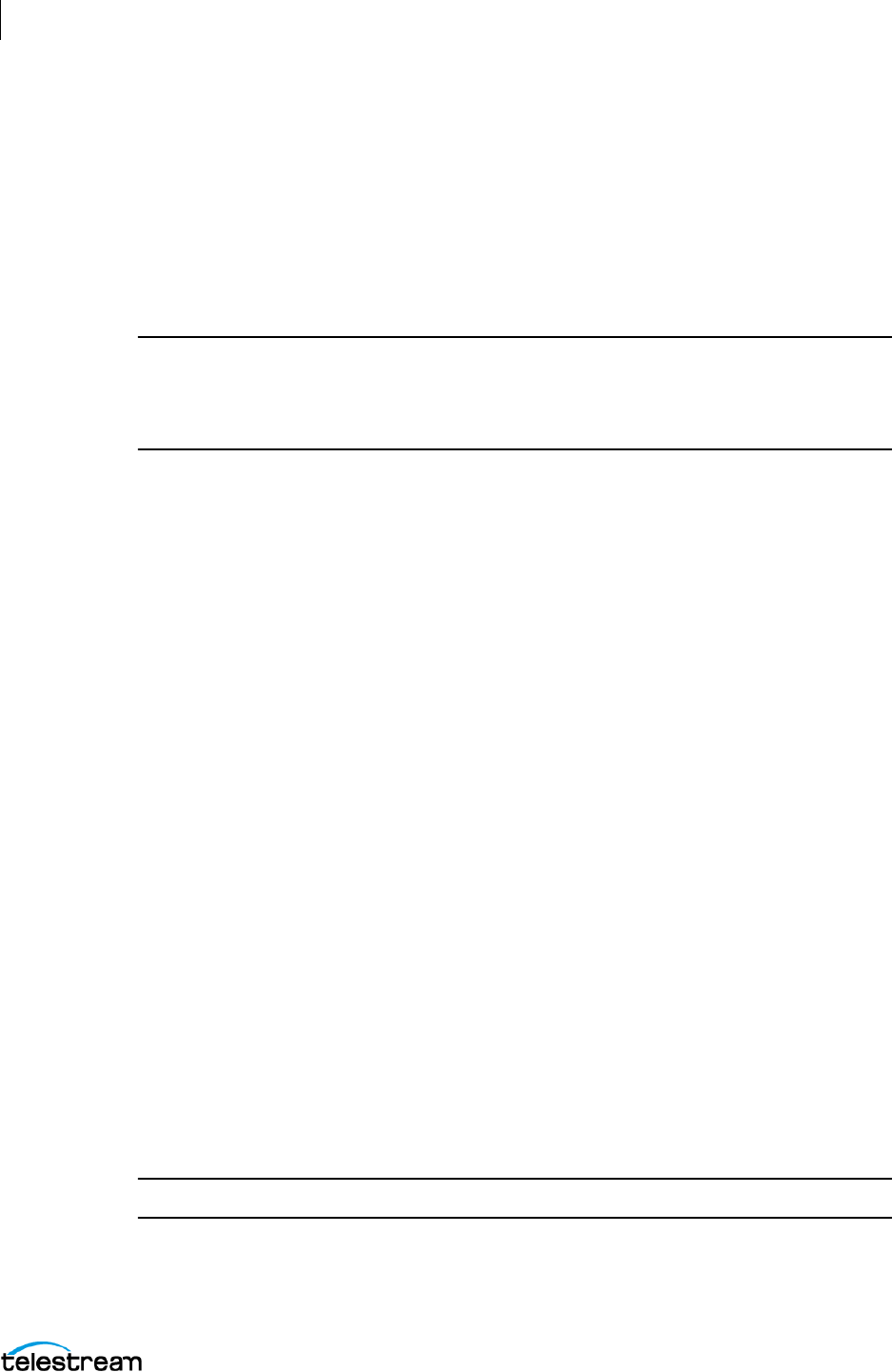
Configuration
Configuring Screen Recording Properties
34
ScreenFlow User Guide
See Audio Properties.
Configuring Screen Recording Properties
ScreenFlow records your computer displays in proprietary-format video clips saved in
the ScreenFlow document with an SCC extension. Only ScreenFlow can open these SCC
files. Because ScreenFlow manages these files automatically, you rarely have to work
with them directly.
Note: You can apply screen-recording properties only to ScreenFlow screen-
recording clips. If you try to apply properties to recording actions, ScreenFlow applies
the properties to the whole clip. ScreenFlow doesn’t apply screen recording properties
to clips recorded by other applications.
To apply screen-recording properties, do the following:
1. Select a screen recording or select the start or end of a screen recording action in
the clip.
2. To display the Screen Recording Properties tab, click the Screen Recording Properties
button in the Properties window.
3. In the Screen Recording Properties tab, select the properties desired.
When you add a screen recording action, ScreenFlow displays the action in yellow.
See Screen Recording Properties.
Configuring Callout Properties
Callouts are transitional properties: they change over time. Use callouts to highlight
specific portions of the screen.
You can add cursor and foreground-window callouts only to screen recording clips. You
can add freehand callouts to video clips, still-image clips, and screen recording clips.
You can’t apply callout properties at a clip level, only to specific callouts within a clip.
To apply screen-recording properties, do the following:
1. Select a video clip.
2. Click the +Action button to add a new callout.
3. To display the Callout Properties tab, click the Callout Properties button in the
Properties window.
4. Select the properties desired.
Note: You must add and/or select a callout before configuring its settings.
See Callout Properties.
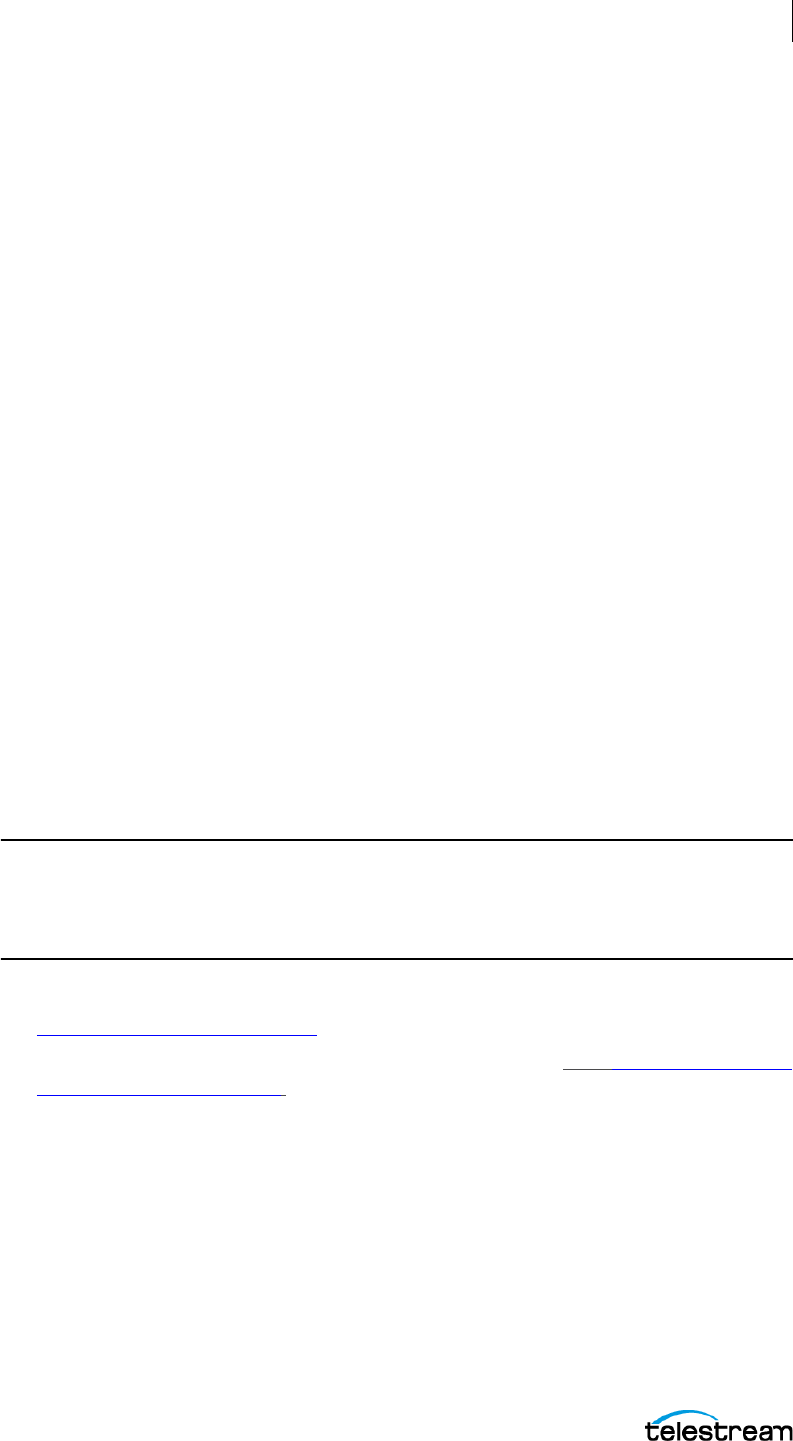
Configuration
Configuring Annotations Properties
35
ScreenFlow User Guide
Configuring Annotations Properties
You can use annotations for displaying simple shapes in your document. Annotations
are clips you can add to your timeline. Annotations behave like image clips. You can
apply several video properties—such as scaling, position, x/y/z rotation, and opacity—
and video actions to annotations.
To display the Annotations Properties tab, click the Annotations Properties button in the
Properties window.
See Annotations Properties.
Changing Shortcut Keys
You can customize the ScreenFlow keyboard shortcut commands through the
Shortcuts tab. To change a shortcut keyboard command assignment, do the following:
1. Select ScreenFlow > Settings.
ScreenFlow opens the Settings dialog.
2. Select the Shortcuts tab.
See Shortcuts Settings Tab.
3. Click a shortcut in the list, to the right of the shortcut name.
ScreenFlow displays the editable shortcut field.
4. Enter a new key combination for the shortcut.
Modified shortcuts are updated immediately, in either the main menu, ScreenFlow
Helper menu, or with the keyboard-only functionality.
Note: If you enter a key combination that already has a shortcut associated with it, a
warning triangle appears next to each shortcut in conflict. The filter bar changes to
include a Conflict Filter, allowing you to display only the conflicted shortcuts. You must
resolve each conflict.
For a complete list of ScreenFlow keyboard shortcuts that you can customize, see
ScreenFlow keyboard shortcuts
.
Also see Finding Keyboard Shortcuts, Shortcuts Settings Tab, and
Keyboard Shortcuts
and Hotkey Customizations.

Configuration
Changing Shortcut Keys
36
ScreenFlow User Guide

37
Tutorials
Take the following three tutorials before beginning your first ScreenFlow document.
You’ll gain a basic familiarity with the program before you begin a project.
First, record or import video. Next, edit the screencast. Finally, export your finished
video to a file or publish it directly to a video hosting service.
Topics
■ Tutorial 1: Recording a Screencast
■ Tutorial 2: Editing a Screencast
■ Tutorial 3: Exporting or Publishing a Screencast
Tutorial 1: Recording a Screencast
Before creating a video for publication, record a few sample screencasts. This will
familiarize you with ScreenFlow recording options. First, select the sources you want to
record. Then, record a screencast.
Selecting Your Sources
To select your video and audio sources, do the following:
1. Connect any external video or audio sources to your Mac by cable.
2. On the Welcome screen, click New Recording.
ScreenFlow opens the New Recording dialog, showing fields for selecting sources.
3. Check the box next to the first Record field to enable the field.
4. In the first Record field, click the arrows to the right of the field.
ScreenFlow opens a drop-down menu of sources.
5. Click a source from the list that you want to record.
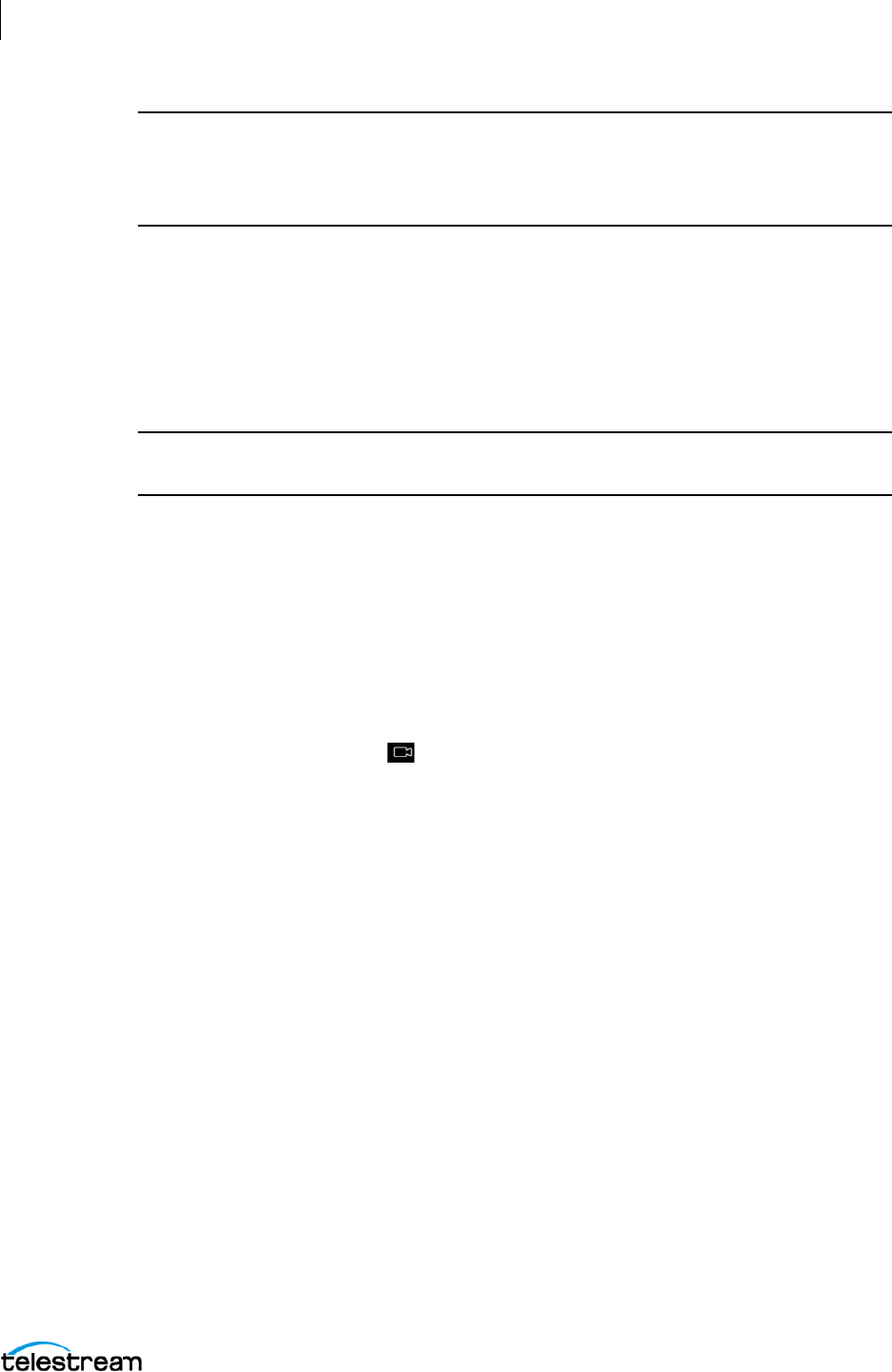
Tutorials
Tutorial 1: Recording a Screencast
38
ScreenFlow User Guide
Note: When you select Computer Audio as a source, ScreenFlow might display the
message, Recording Audio from other applications in ScreenFlow. If it does, please
consult ScreenFlow 7.3.1: New Audio Driver located on the Telestream Knowledge Base
at: New Audio Driver.
6. To add another source, check the box for another Record field, and select the
desired source from the drop-down menu. Repeat this step for every source you
want to add.
7. To add additional source fields, click the “+” icon toward the bottom of the dialog.
8. Click the icon containing an ellipse (...) to the right of a source field, to open
advanced options for the source. Select the option desired.
Note: Also, you can select sources by navigating to Configure Recording in ScreenFlow
Helper.
Recording Video and Audio
1. Click the Record button.
ScreenFlow enters a countdown mode before recording. You can change the
length of this countdown.
2. After the countdown, create a short presentation.
3. To stop the recording: press Shift-Command-2 or select Stop Record from the
ScreenFlow Helper menu in the upper-right corner of your display.
ScreenFlow captures all sources synchronously, whether audio, video, or both.
ScreenFlow combines display video and computer audio into one clip and saves
the clip as an SCC file. ScreenFlow also combines camera video and microphone
audio into another clip and adds it to your document.
When you stop recording, ScreenFlow opens your recording in the ScreenFlow Edi-
tor window with all of your recorded sources placed at the beginning of the time-
line. The media elements on the timeline reference your document’s stored media.
Capturing Part of the Screen
To record only a portion of the screen, do the following:
1. On the New Recording dialog, click the Partial Screen Record button to the left of the
red Record button.
ScreenFlow darkens the screen and draws a rectangular capture area.
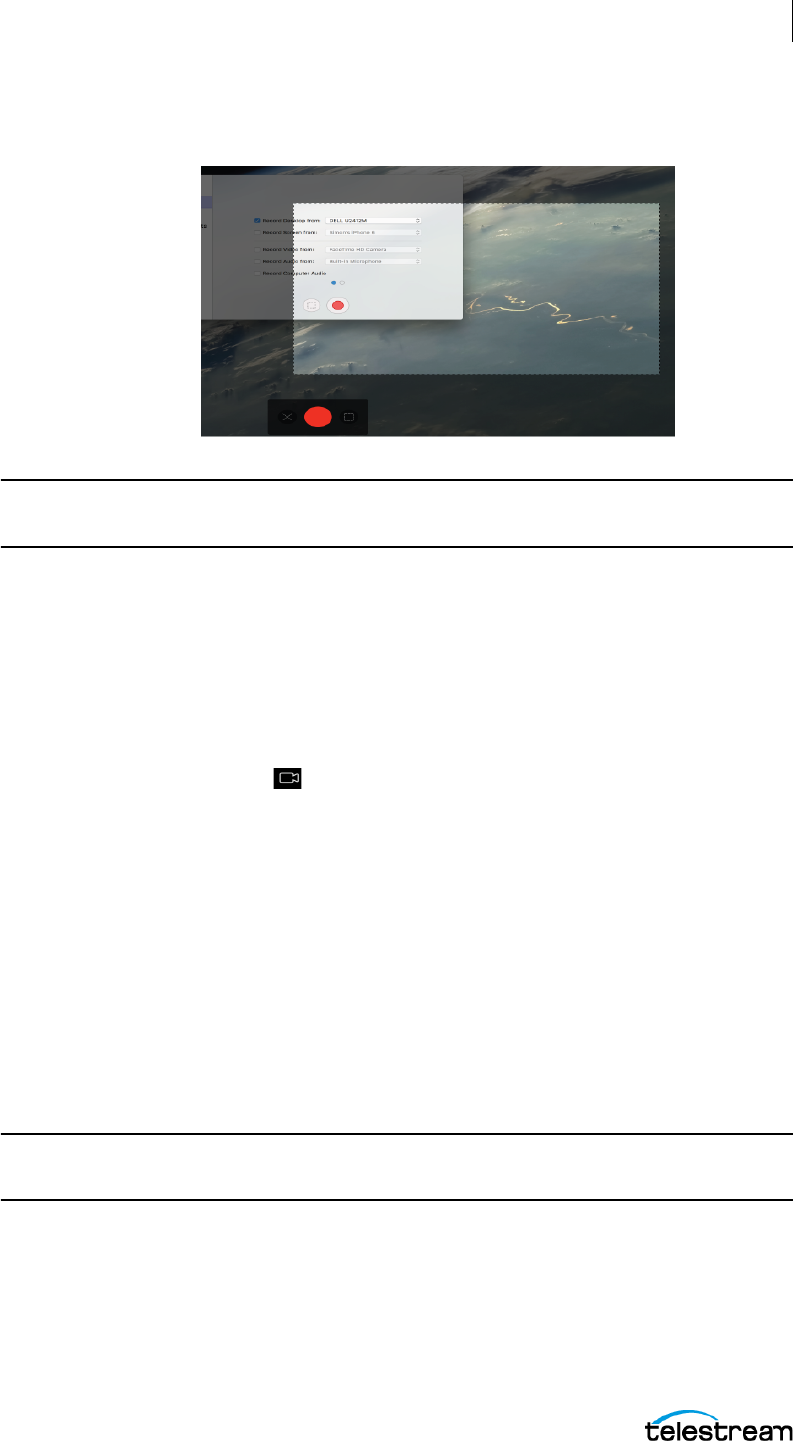
Tutorials
Tutorial 2: Editing a Screencast
39
ScreenFlow User Guide
Figure 1. The ScreenFlow Capture Area
Note: While the rectangular selection is present, you can’t interact with any windows
on the desktop.
2. Drag an edge or corner of the rectangle to resize it.
3. Click the Record button.
ScreenFlow enters a countdown mode before recording. You can change the
length of this countdown.
4. After the countdown, create a short presentation.
5. To stop the recording: press Shift-Command-2 or select Stop Record from the
ScreenFlow Helper menu in the upper-right corner of your display.
When you stop recording, ScreenFlow opens your recording in the ScreenFlow edit-
ing window with all of your recorded sources placed on the timeline.
You can cancel partial-screen capture, start the recording, or use presets to constrain
the region you are capturing from the control strip towards the bottom of the screen.
For more information about partial screen capture, see the ScreenFlow User Guide.
Tutorial 2: Editing a Screencast
This tutorial introduces some basic ScreenFlow editing techniques.
For a description of the ScreenFlow user interface, see the ScreenFlow User Guide.
Note: Changes made on the timeline or in the Editor window do not alter your
original recorded media.
Trimming a Clip
To trim a clip, do any of the following:
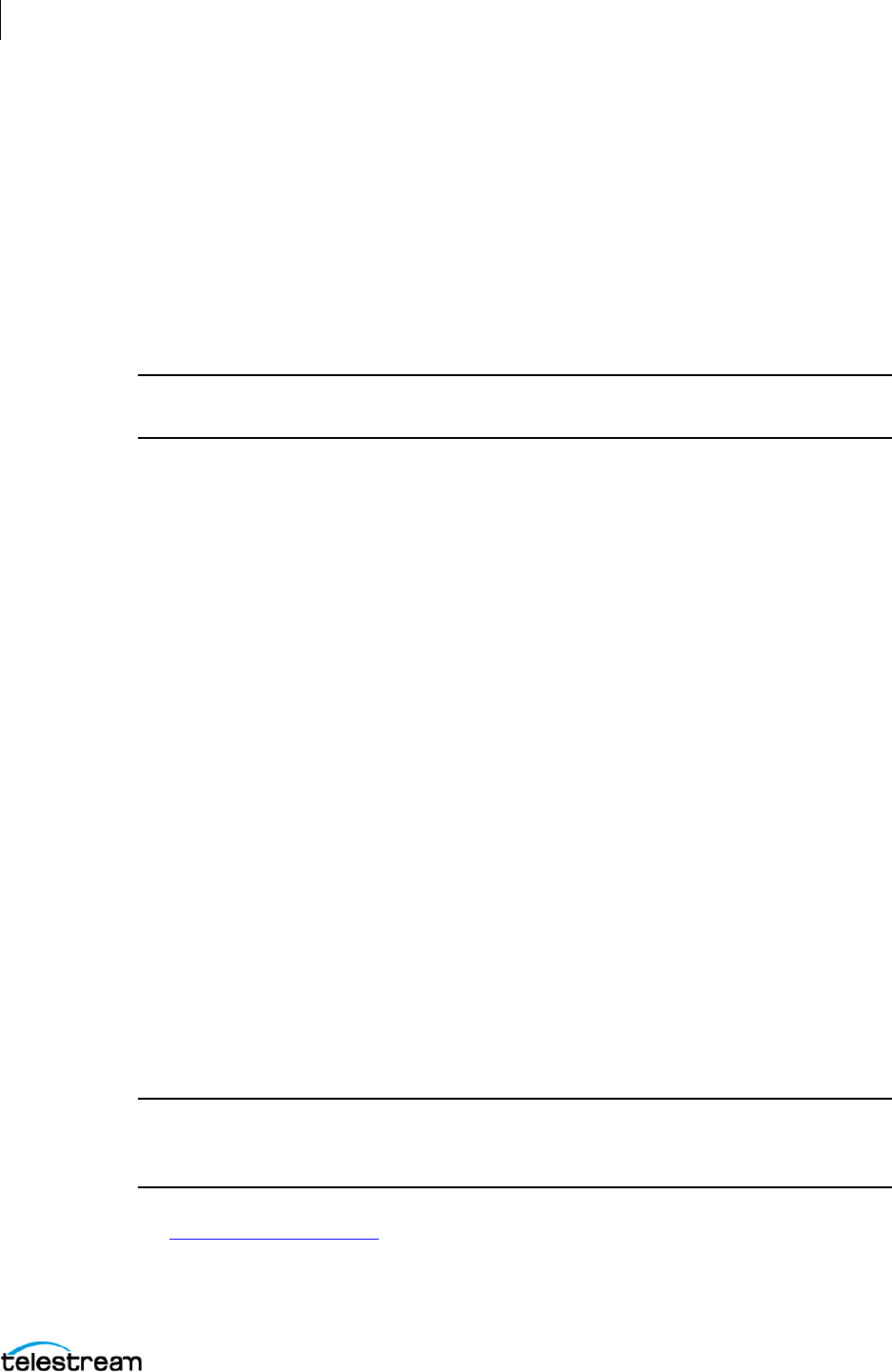
Tutorials
Tutorial 2: Editing a Screencast
40
ScreenFlow User Guide
• To trim the beginning of the selected clip, position the scrubber at the time you
want the clip to begin, then press the W key or select Clip > Trim Front to Scrubber.
This trims the clip up to the scrubber, thus changing the start time.
• To trim the end of the clip, position the scrubber at the time where you want the
clip to end, then press the E key or select Clip > Trim End to Scrubber. This trims the
clip after the scrubber.
• To shorten a clip, grab either edge of the clip and drag it inward toward the clip
center.
• To lengthen a previously-trimmed clip, pull either edge out from the clip center.
Note: Trimming changes the amount of time the clip plays; it doesn’t modify the
referenced media file.
Adding Transitions
To add a transition, select a clip and do one of the following:
• Select Clip > Add Starting Transition to add a transition to the front of the clip.
• Select Clip > Add Ending Transition to add a transition to the end of the clip.
• Select Clip > Add Starting & Ending Transition to add a transition to both ends.
You can also create transitions between two clips by dragging one clip over an adjacent
clip. The section where the two clips overlap is the transition.
Adding a Video or Audio Filter
To add a filter to one or more clips, follow these steps:
1. Select the video or audio clip to filter.
2. Select the Video or Audio properties tab, as appropriate.
3. Next to the Filters and Effects heading in the Video tab, or next to the Audio Filters
heading in the Audio tab, click the (+) button.
ScreenFlow displays the list of available filters.
4. Scroll through the list of filters. Alternatively, in the Audio tab, enter a filter name
into the Search field and press Enter.
5. Select a filter, and click Add to add it to the filter list for the selected clip.
Note: If a manufacturer's audio unit plug-in does not work in a “sandbox”
environment, it will not work in the Mac App Store version of ScreenFlow. Contact the
manufacturer of the audio plugin directly for information on plugin sandbox support.
See Video Filters and Effects
.
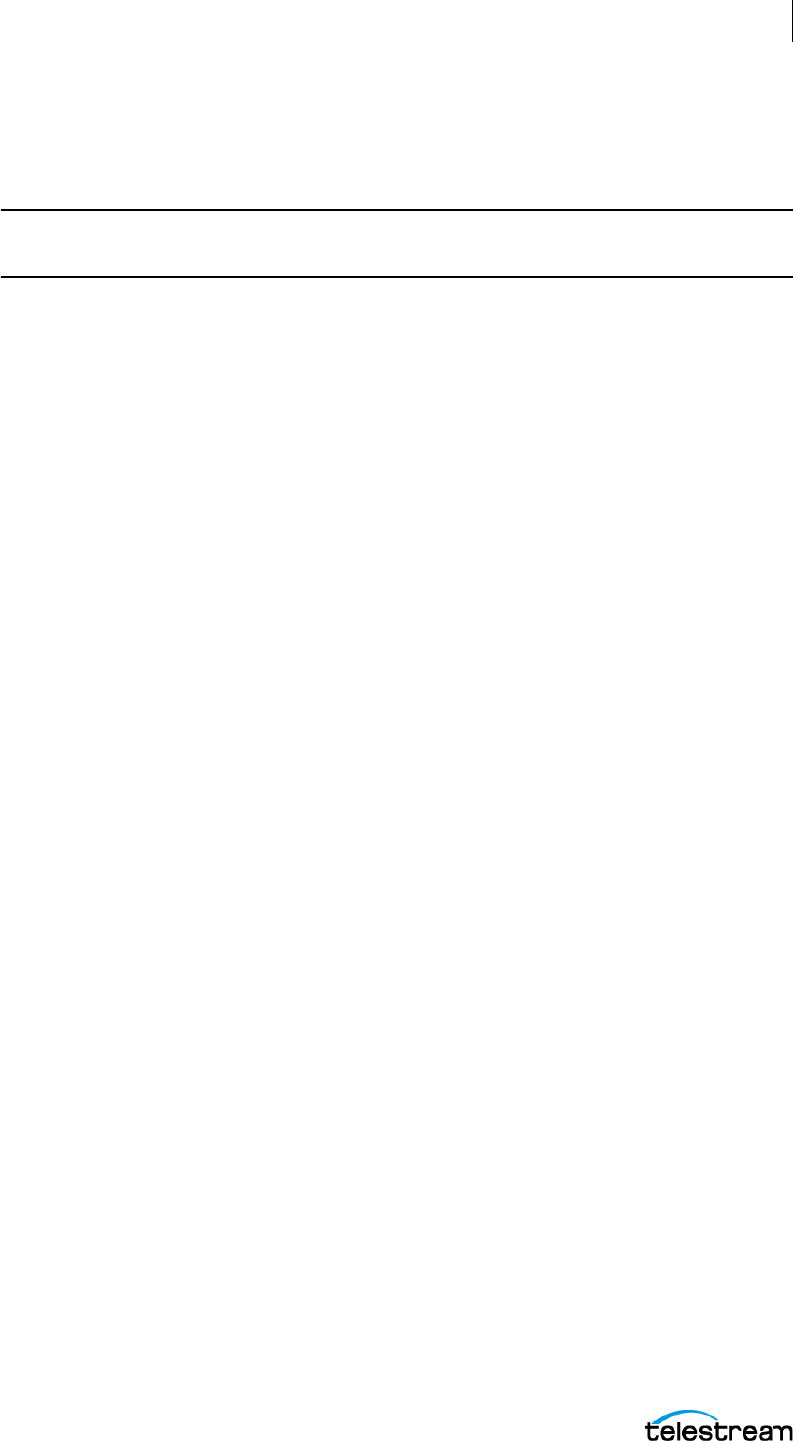
Tutorials
Tutorial 3: Exporting or Publishing a Screencast
41
ScreenFlow User Guide
Tutorial 3: Exporting or Publishing a Screencast
This tutorial introduces techniques for exporting or publishing your screencast.
Note: ScreenFlow screencasts are not video files—they are saved as ScreenFlow
documents (with a SCREENFLOW extension), which only ScreenFlow can open.
You can export screencasts to standard video file formats, or you can publish them
directly to a video hosting service, such as Vimeo or YouTube.
The correct export settings for your screencast depends on the complexity of your
screencast and the intended use of the video.
Exporting a Screencast
To export a screencast, do the following:
1. Select File > Export or press Command-E to export your presentation.
ScreenFlow opens the Export dialog.
2. Select the desired settings for your screencast.
See The Export Settings Dialog in the ScreenFlow User Guide.
Publishing a Screencast
To publish a screencast to a video hosting platform, do the following:
1. Select File > Publish to [platform] for the platform desired.
ScreenFlow opens the Publish to dialog for the chosen platform.
2. Select the desired settings for your screencast.
See The “Publish to” Dialogs in the ScreenFlow User Guide.

Tutorials
Tutorial 3: Exporting or Publishing a Screencast
42
ScreenFlow User Guide
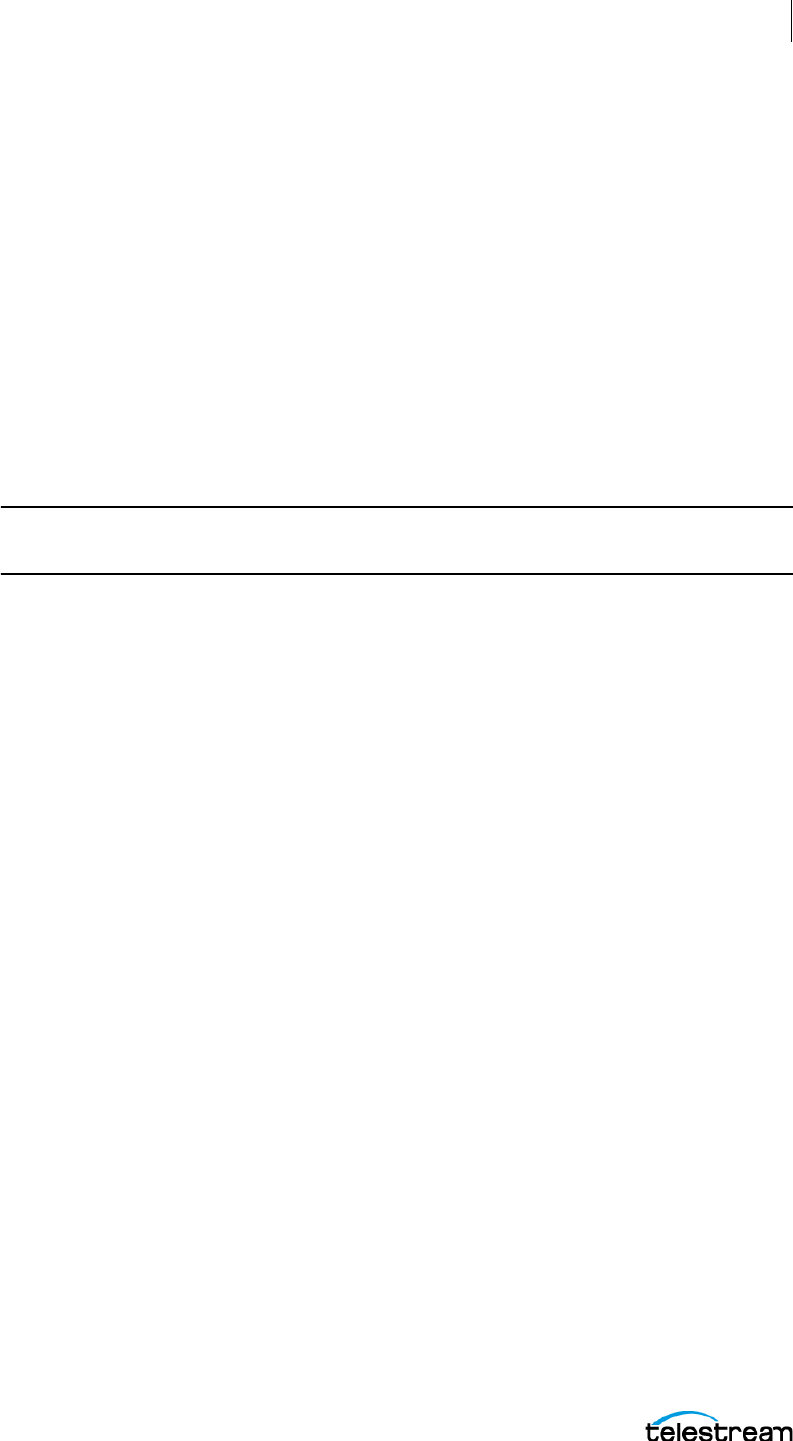
43
Documents and Recordings
You can use ScreenFlow to create documents and to record media.
Note: ScreenFlow automatically stops recording when there is one gigabyte or less
free on your system disk volume.
Topics
■ Documents
■ ScreenFlow Recordings
■ Tips for Screencasting
Documents
Before you start recording, create a document. ScreenFlow saves a media library, SCC
files, properties, and various commands in each document file. ScreenFlow saves
documents in files with either the Packaged Document format extension SCREENFLOW
or with the ScreenFlow Flat Document format extension SCREENFLOWF.
Creating a Document
To create a ScreenFlow document, do the following:
1. Select File > New or press Command-N.
ScreenFlow displays the New dialog.
See The New Dialog.
2. Select the New Document tab.
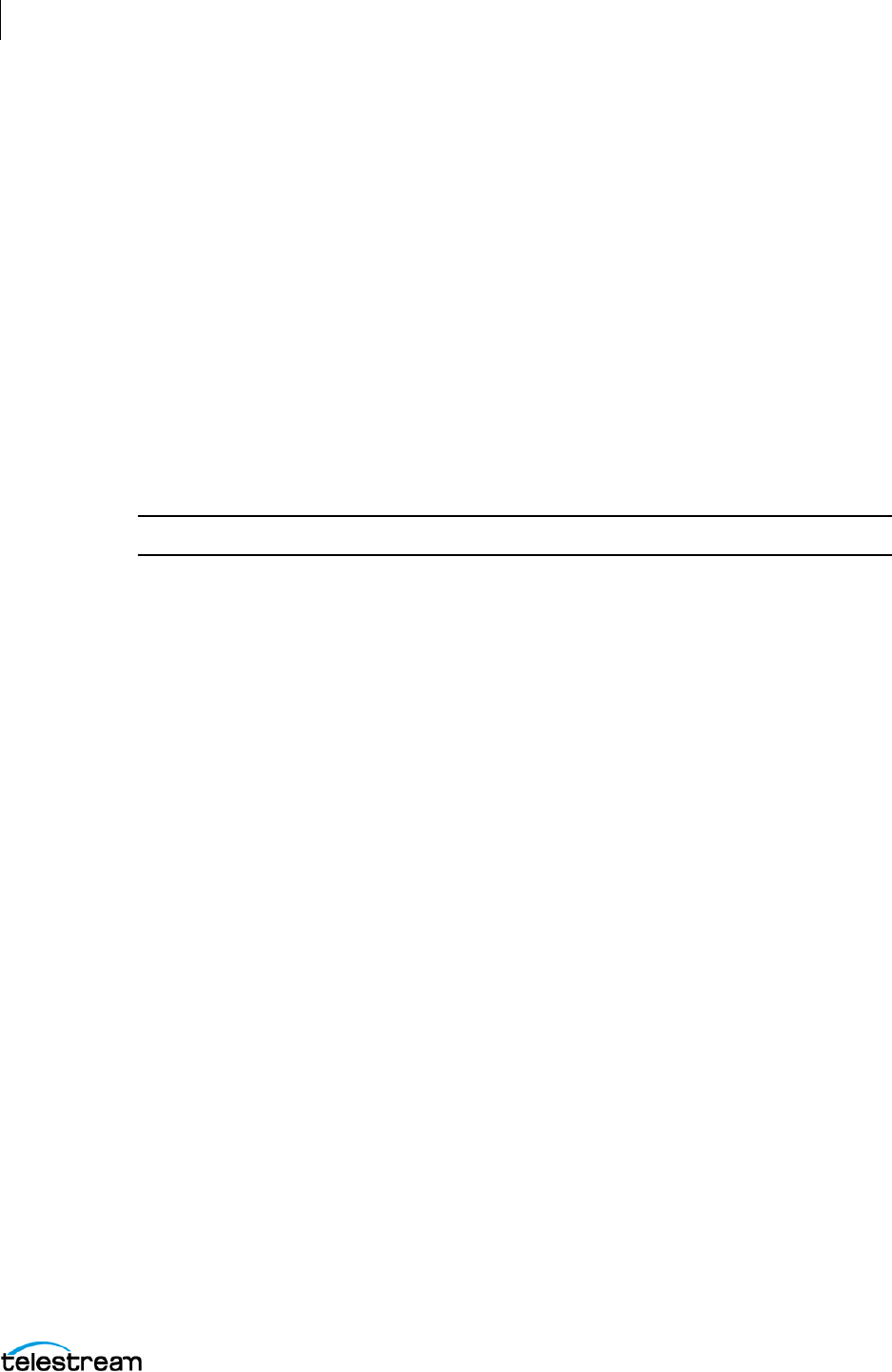
Documents and Recordings
Documents
44
ScreenFlow User Guide
3. Select properties for the document as desired.
ScreenFlow displays a dialog which allows you to set your canvas size to any dimen-
sion, regardless of your display size. Valid document dimensions are any even num-
ber between 2 and 8192 as minimum and maximum, respectively.
See The Properties Window.
4. Click Save.
When you first save a document, ScreenFlow opens a popup menu at the bottom
of the Save panel. Here, you can choose between the Packaged Document format
and the ScreenFlow Flat Document format.
See The ScreenFlow Document Formats.
Specifying the Default Document Format
You can set the default document format.
Note: You can override this default when you first save a document.
To can set the default document format, do the following:
1. Click ScreenFlow > Settings > Advanced.
2. Open the File Format drop-down menu, and select the desired format.
See The ScreenFlow Document Formats.
Creating a Document Template
You can use a document as a template for creating other documents. This allows you to
specify consistent starting, variable, and ending content. When you create a document
made from a template, ScreenFlow determines the starting and ending content based
on the Template Placeholder Clip information, and places the variable content
(recordings) in the middle.
You can share templates between different computers. ScreenFlow automatically reads
templates in the shared template folder.
To create a template from any unsaved ScreenFlow document, do the following:
1. Create a new document.
See Creating a Document.
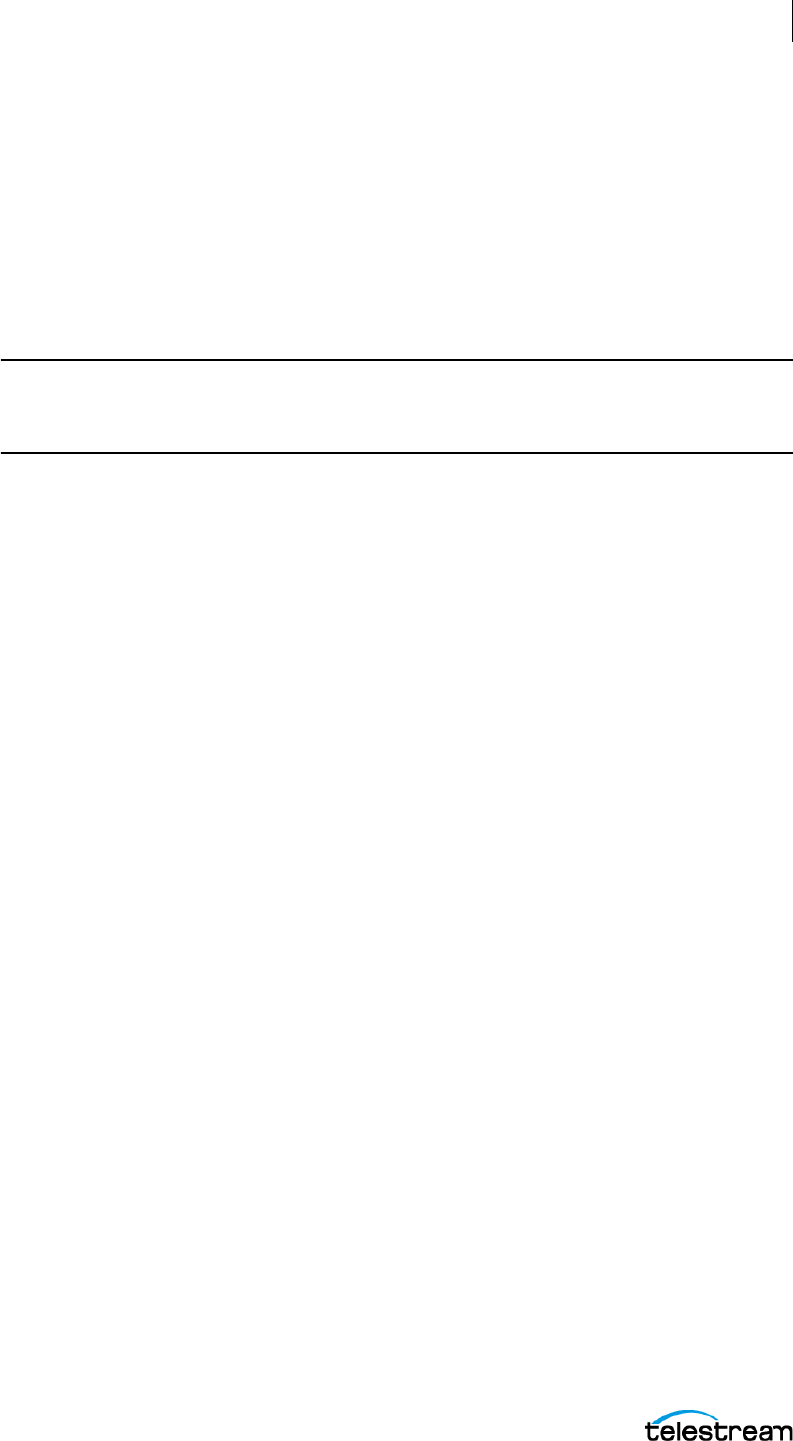
Documents and Recordings
Documents
45
ScreenFlow User Guide
2. Select Insert > Template Placeholder Clip.
ScreenFlow displays the placeholder dialog.
You must insert a template placeholder clip before you can save a document as a
template. If you haven’t inserted a template placeholder clip, ScreenFlow displays
the message No Template Placeholder Clips.
The Template Placeholder Clip gives you control over the variable portion of the
template. The placeholder also determines the options presented when you create
a new document from an existing template.
Note: You can position, scale, and rotate the placeholder clip like other clips.
However, ScreenFlow labels the placeholder clip so it stays matched with the correct
content when you create a document from the template.
3. (Optional) When adding a Screen Recording or Camera placeholder, you can add an
audio placeholder clip at the same time, enabling the configuration of audio-
specific properties.
4. In the placeholder dialog, select the type of template placeholder clip: Screen
Recording, Camera, or IOS Device.
5. Select File > Save As Template.
ScreenFlow displays a dialog box allowing you to name your template.
6. Enter a template name and click Save.
ScreenFlow saves the template in a sub-folder of the Users Library folder located at:
~/Library/Application Support/ScreenFlow/Templates/.
This sub-folder contains all the content needed by the template. However, the new
template file is given the a file extension of ScreenFlowTEMPLATE (not SCREEN-
FLOW which is used for ScreenFlow documents). ScreenFlow manages this tem-
plate folder by deleting and updating files as needed, so you should not make any
changes directly.
Once a document has been converted to a template, the Save as Template menu
item is disabled.
Creating a Document from a Template
After a template has been created and saved, it’s ready for immediate use. To create a
new document from a template, do the following:
1. Select File > New.
ScreenFlow displays the New dialog.
See The New Dialog.
2. Select the New From Template tab.
3. Select a template, then click the Open button. You can also edit a selected template
by clicking the Edit Template button.
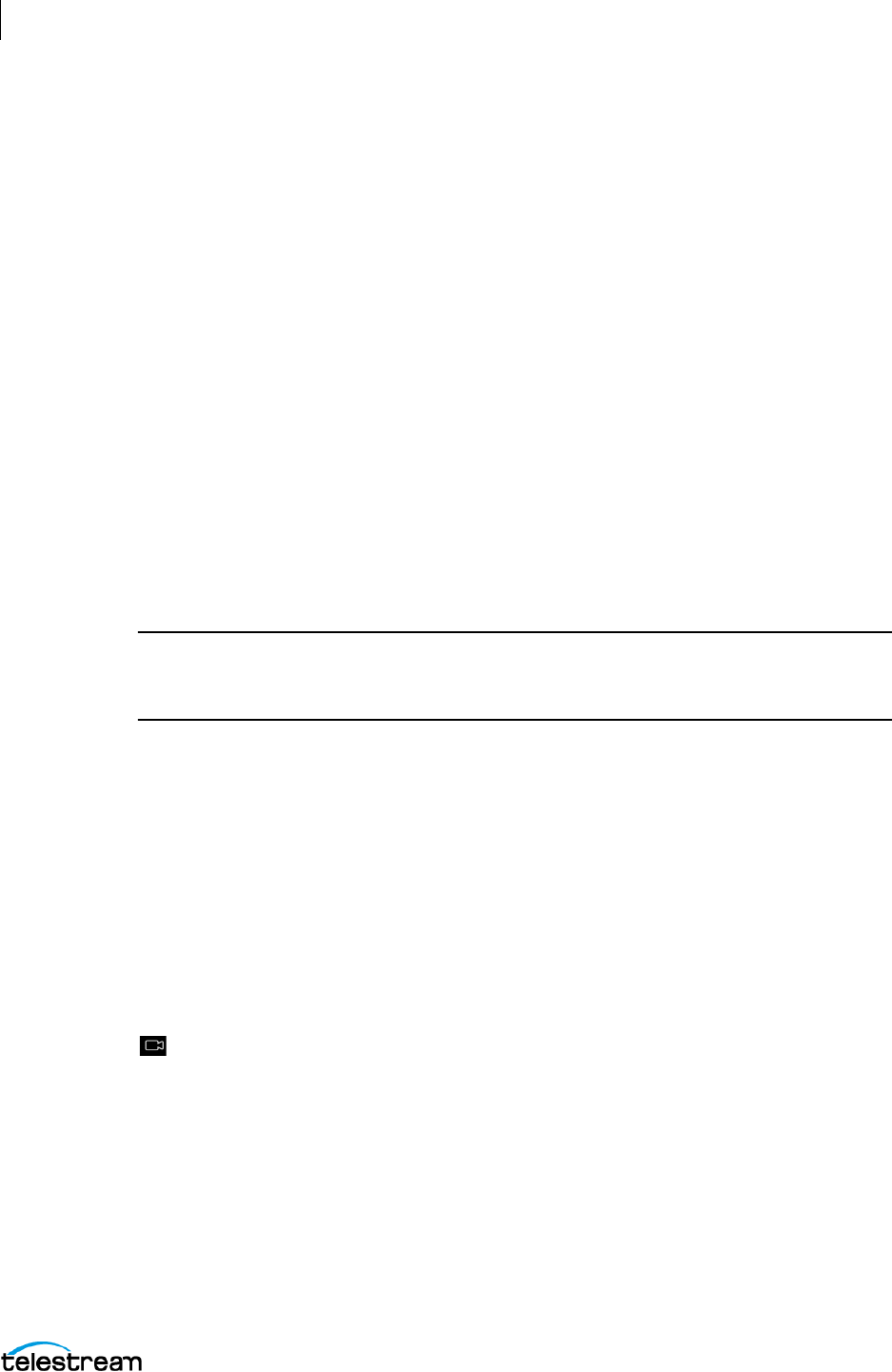
Documents and Recordings
ScreenFlow Recordings
46
ScreenFlow User Guide
4. Click the gear button to set up the recording.
ScreenFlow displays the recording settings window.
5. Set up your recording as needed.
6. Click the radio button to open the other settings window.
ScreenFlow displays the other recording settings window.
7. Finish setting up your recording.
8. Click the Record button to begin recording, using your new template.
ScreenFlow Recordings
With ScreenFlow, you can record video and audio from a variety of devices.
ScreenFlow records display video, computer audio, camera video, and microphone
audio into proprietary Screencast files, with the file extension SCC. In addition to audio
and video, SCC files contain spatial and temporal information about mouse tracking
and key presses. This data enables powerful special effects to enhance your screencast.
ScreenFlow stores screencast files in a ScreenFlow-controlled location, and adds
screencast files to the document media library.
Note: ScreenFlow captures video at a maximum of 60 fps, even from sources with
frame rates higher than 60 fps. ScreenFlow automatically down-converts higher-than-
60 fps video to 60 fps.
Adding Recordings to a ScreenFlow Document
To record a clip and add it to an open document, do the following:
1. Make sure the document window is open and selected.
2. Then, select File > Add Additional Recording (Shift-Command-R) or press the
Add Recording button in the media library.
3. Verify your settings and click Record.
Depending on your settings, ScreenFlow displays the countdown window, and then
begins recording. During recording, the camera icon on the ScreenFlow Helper button
displays a black dot. When you stop recording, ScreenFlow adds the clip you just
recorded to the document.
Enabling Recording of Computer Sound
You can enable ScreenFlow to record sounds produced by your computer. To enable
recording of computer sound, do the following:
1. Select File > Add Additional Recording (Shift-Command-R) or press the Add
Recording button in the media library.
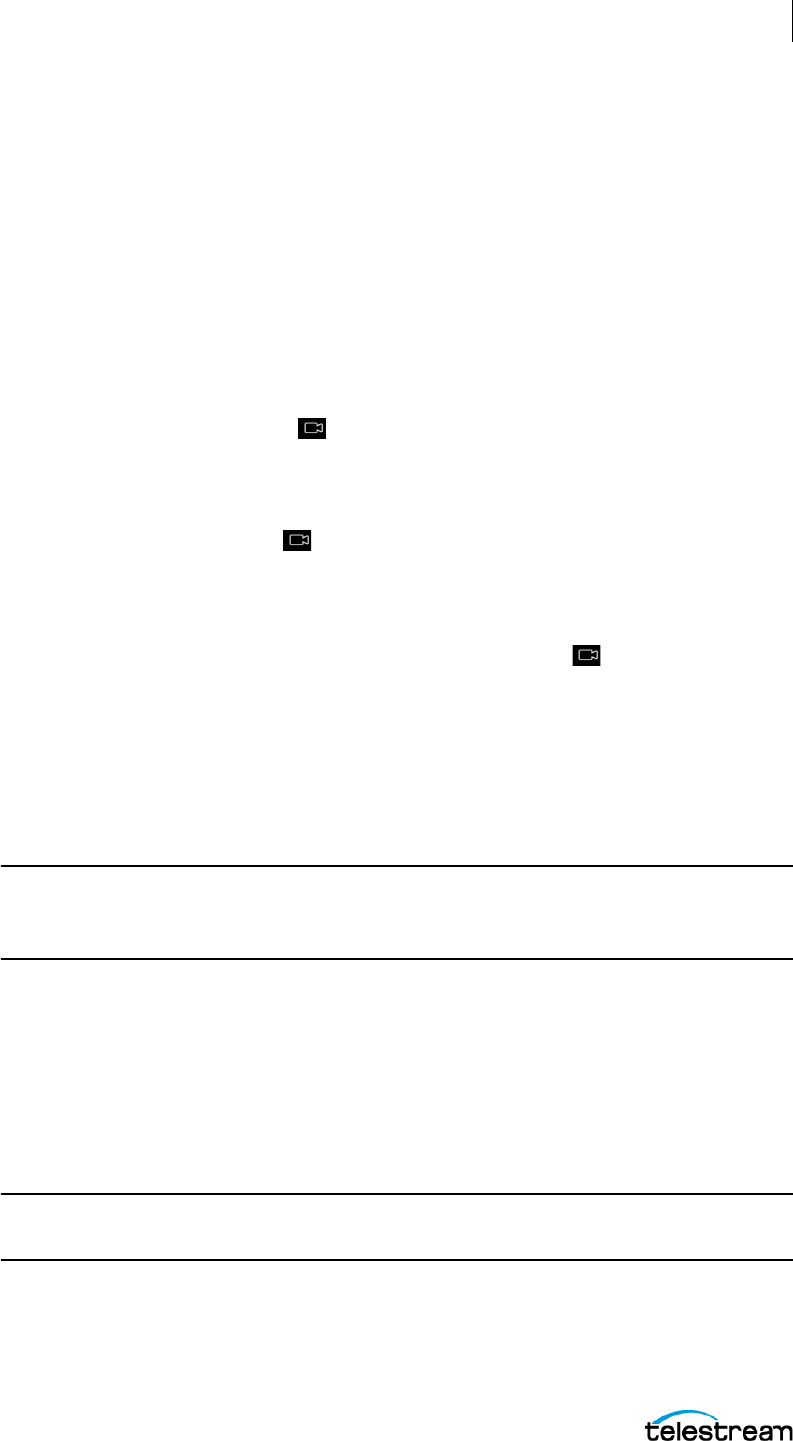
Documents and Recordings
ScreenFlow Recordings
47
ScreenFlow User Guide
2. In the New Recording dialog, check an empty box for a Record field.
3. Select Computer Audio from the drop-down menu.
4. If ScreenFlow offers to install a new audio driver, click Install.
5. To configure ScreenFlow to record the audio from individual apps to separate clips,
click the circle containing three dots. Then check the box for Separate recorded apps
into individual clips.
Recording Clips
To record a clip without deciding which document to add it to first, do the following:
1. Click the ScreenFlow Helper button.
2. Select Record, or select File > New > New Recording and click the red Record button.
Depending on your settings, ScreenFlow displays the countdown window, and
then ScreenFlow begins recording. During recording, the camera icon of the
ScreenFlow Helper button displays a black dot.
When you stop recording, ScreenFlow displays a Recording Complete window so
that you can create a new document with your recording, or add your recording to
any open document.
3. To verify your settings first, click on the ScreenFlow Helper button and select
Configure Recording.
4. Click the Record button. Depending on your settings, ScreenFlow displays the
countdown window, and then ScreenFlow begins recording.
When you stop recording, ScreenFlow displays the Recording Complete window, as
shown above, so that you can add your recording to an open document, start a new
one, or discard your recording.
Note: The only limitation on the length of your recording is the amount of space
available on your hard drive. ScreenFlow automatically stops recording when you
have less than 100 MB free on your system disk volume.
Recording iOS devices
ScreenFlow enables you to record the screen of your iOS device. You must have your
device connected to your computer with an Apple Lightning-USB cable.
1. Connect your device to the computer and check iTunes to verify that macOS
detects the device.
Note: If it is the first time the iOS device is connected to your computer, you will be
asked if you trust the device. Select Trust to continue.
2. Open ScreenFlow and select New Recording.
3. Select your iOS device from the Record Desktop from drop-down list.
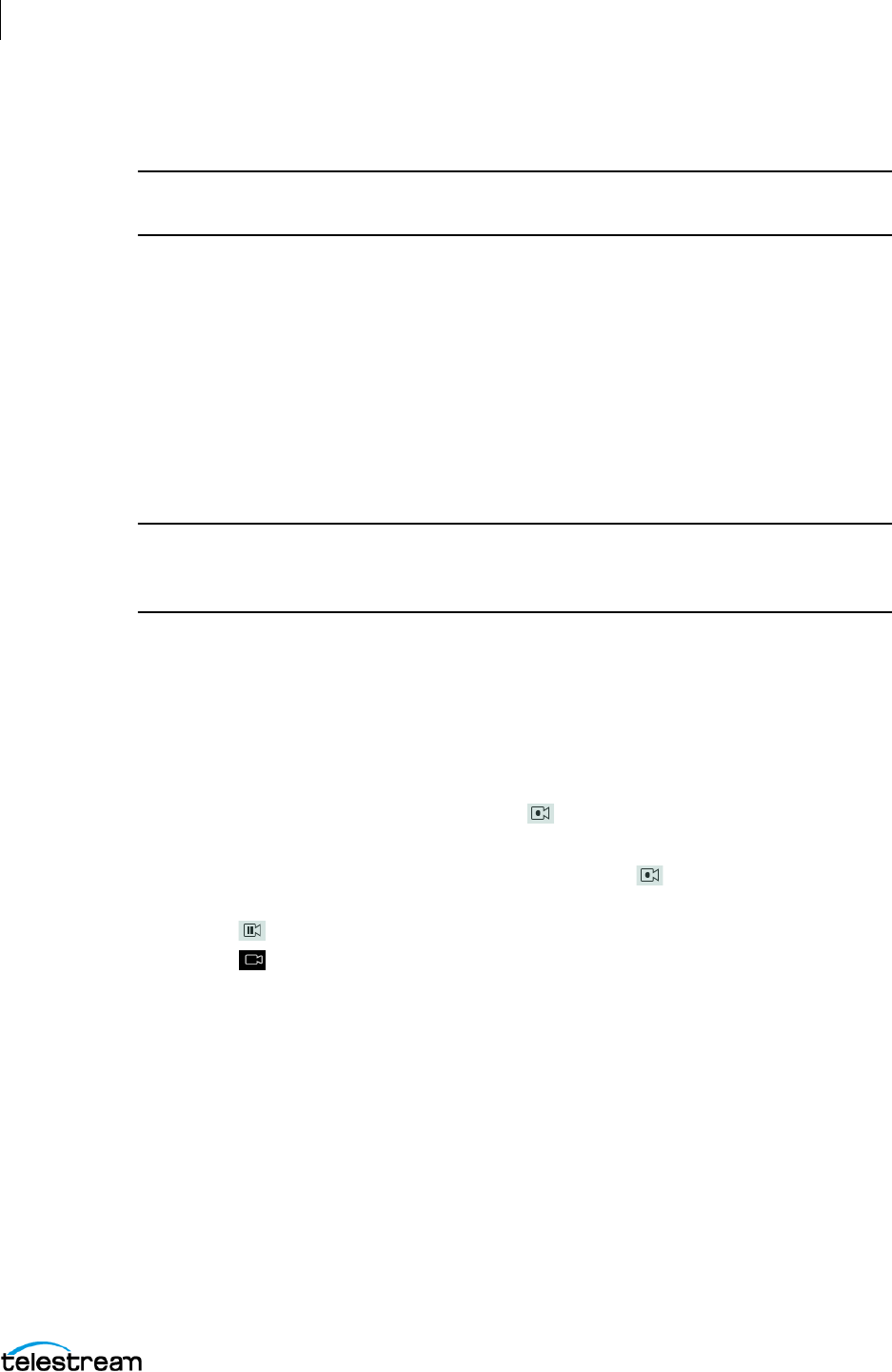
Documents and Recordings
ScreenFlow Recordings
48
ScreenFlow User Guide
4. Click the Record button. After the countdown, you can begin recording your iOS
device.
Note: ScreenFlow doesn’t preview your iOS screen, but records it. ScreenFlow doesn’t
record touches or swipes. You can add callouts to simulate touches and swipes.
5. When done, stop the recording.
ScreenFlow displays your iOS device on the canvas. ScreenFlow automatically ori-
ents the screen for apps that display in landscape mode. You may need to adjust
the canvas size.
6. (Optional) Display a recording monitor by selecting Show Recording Monitor from
the Record configuration menu.
The monitor displays stereo volume meters, a Preview Volume slider, and an Add
Marker button. Preview Volume allows you to hear the system audio playing on your
iOS device through your computer audio output as it is being recorded.
Note: If you do not hear iOS audio while recording, toggle the ringer/vibrate switch
on your iOS device. Also, if you record computer audio while monitoring iOS audio,
you will hear iOS audio twice in the screencast.
When you play or scrub through the video, the iOS device displays all of the actions you
performed.
Stopping, Pausing & Resuming Your Recording
• Before you start recording, it’s good to know how to stop. To stop recording in
ScreenFlow, click the ScreenFlow Helper menu button, and select Stop Record
or press Shift-Command-2.
• To pause your recording, click the ScreenFlow Helper menu button and select
Pause. When you pause recording, the solid black recording dot changes to a pause
symbol . To start recording again, select Resume from the ScreenFlow Helper
button .
Recording When you Start ScreenFlow
To record a clip for a new document, do the following:
1. Start ScreenFlow.
ScreenFlow displays the recording window.
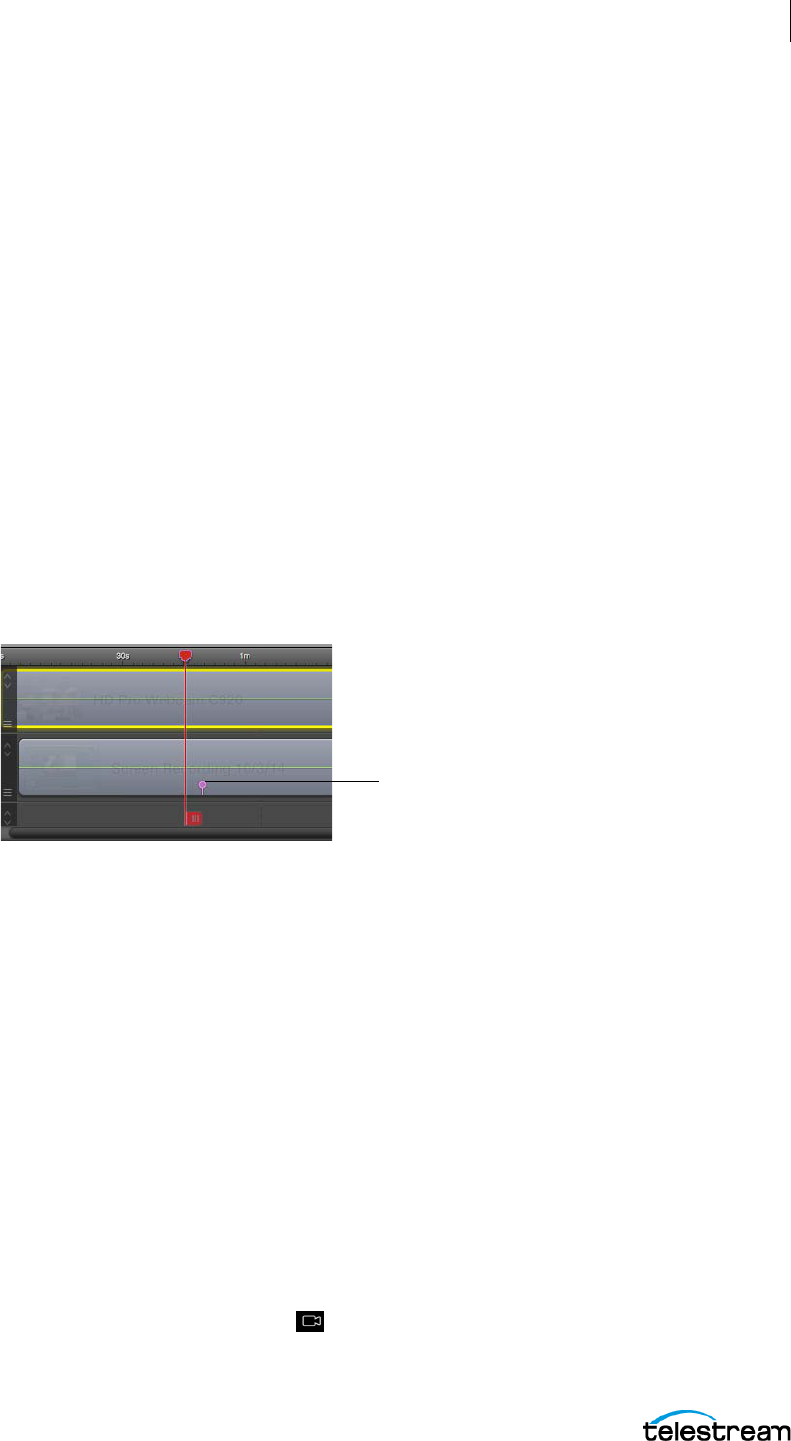
Documents and Recordings
ScreenFlow Recordings
49
ScreenFlow User Guide
2. Click the red Record button to start recording your first clip.
During recording, the camera icon of the ScreenFlow Helper button displays a black
dot.
When you stop recording, ScreenFlow displays a window that lets you add your
recording to a new document, add it to an existing document, or discard the docu-
ment.
Adding Clip Markers While Recording
ScreenFlow enables you to attach markers directly to your clips. During a recording, if
something important or notable occurs, it may be desirable to create a marker during
the recording process to provide quick access, later, when organizing a document.
ScreenFlow enables the Add Marker menu item only during recording, and disables it
when the recording is paused or stopped.
• To set a clip marker during recording click the Add Marker button.
Once you’ve completed your recording, ScreenFlow displays, in the timeline, any
markers you added, and attaches the markers to the primary clip.
See also Adding a Clip Marker and Adding a Timeline Marker.
Viewing the Recording Monitor
To open the Recording Monitor, click the ScreenFlow Helper (camera) button, then select
Show Recording Monitor.
See The Recording Monitor.
Setting the Recording Timer
You can configure ScreenFlow to record a screencast, and to stop recording,
unattended. For example, you can start recording a webinar, and set ScreenFlow to
automatically stop recording when the webinar is over.
To set up ScreenFlow to stop recording after a certain time, do the following:
1. Click the ScreenFlow Helper menu and select Configure Recording.
Marker on
timeline

Documents and Recordings
ScreenFlow Recordings
50
ScreenFlow User Guide
2. Use the Stop Recording option on the second panel to specify the elapsed time to
stop the recording.
3. Click Set Timer, then start recording.
Elapsed-time recording is a one-off event—you must set it every time you want to use
it.
Configuring a Recording
1. To configure a recording, do one of the following:
• Launch ScreenFlow.
ScreenFlow launches ScreenFlow Helper and the Configure Recording window.
• Select File > New > New Recording or ScreenFlow Helper > Configure Recording.
2. Click the Show Advanced Options (three dots) button.
See The Advanced Options Pane for New Recordings.
When you stop recording, you can add this new recording to a new document, or add
the recording to a ScreenFlow document that’s already open. If you have no other
documents open, ScreenFlow automatically creates a document file for the new
recording.
Partial Screen Capture
Partial screen capture enables you to record a selected portion of the screen. To capture
a portion of a screen, do the following:
1. Make sure the document window is open and selected.
2. Then, select File > Add Additional Recording (Shift-Command-R) or press the
Add Recording button in the media library.
ScreenFlow opens the Welcome dialog.
3. Click the partial-screen record button (the dashed rectangle icon to the left of the
main record button).
ScreenFlow darkens the screen, and displays a rectangular selection area.

Documents and Recordings
ScreenFlow Recordings
51
ScreenFlow User Guide
4. Click and drag to resize the selection area. While setting the selection area, you
can’t interact with any other windows.
There is a control strip at the bottom of the focused screen where you can cancel
out of this mode, start the recording, or use presets to constrain the region you are
capturing.
5. If there are multiple displays connected, click on the display to record.
Once you click on a display, the control strip moves to the display selected. The pre-
set button displays a popup giving you some constraint presets, such as 1280x720.
You can also enter a fixed width and height directly.
6. (Optional) You can use shortcut keys to move the rectangle around the screen. If
you hold the Shift key while nudging, ScreenFlow increases the movement. If you
move the mouse over a window and press the space bar, ScreenFlow resizes the
selection rectangle to fit just that window. You can use the Escape key at any time
to exit out of selection mode.
Note: The selection rectangle is always cropped to a single display, and can’t span
multiple displays.
7. To record, click the red record button.
The selection area disappears and the standard recording countdown begins. The
recording inherits any other recording settings, such as camera and microphone
settings, from the main user interface. ScreenFlow sets the canvas size to the size of
the region you selected.
Cancel
Record
Presets
Partial screen
record button
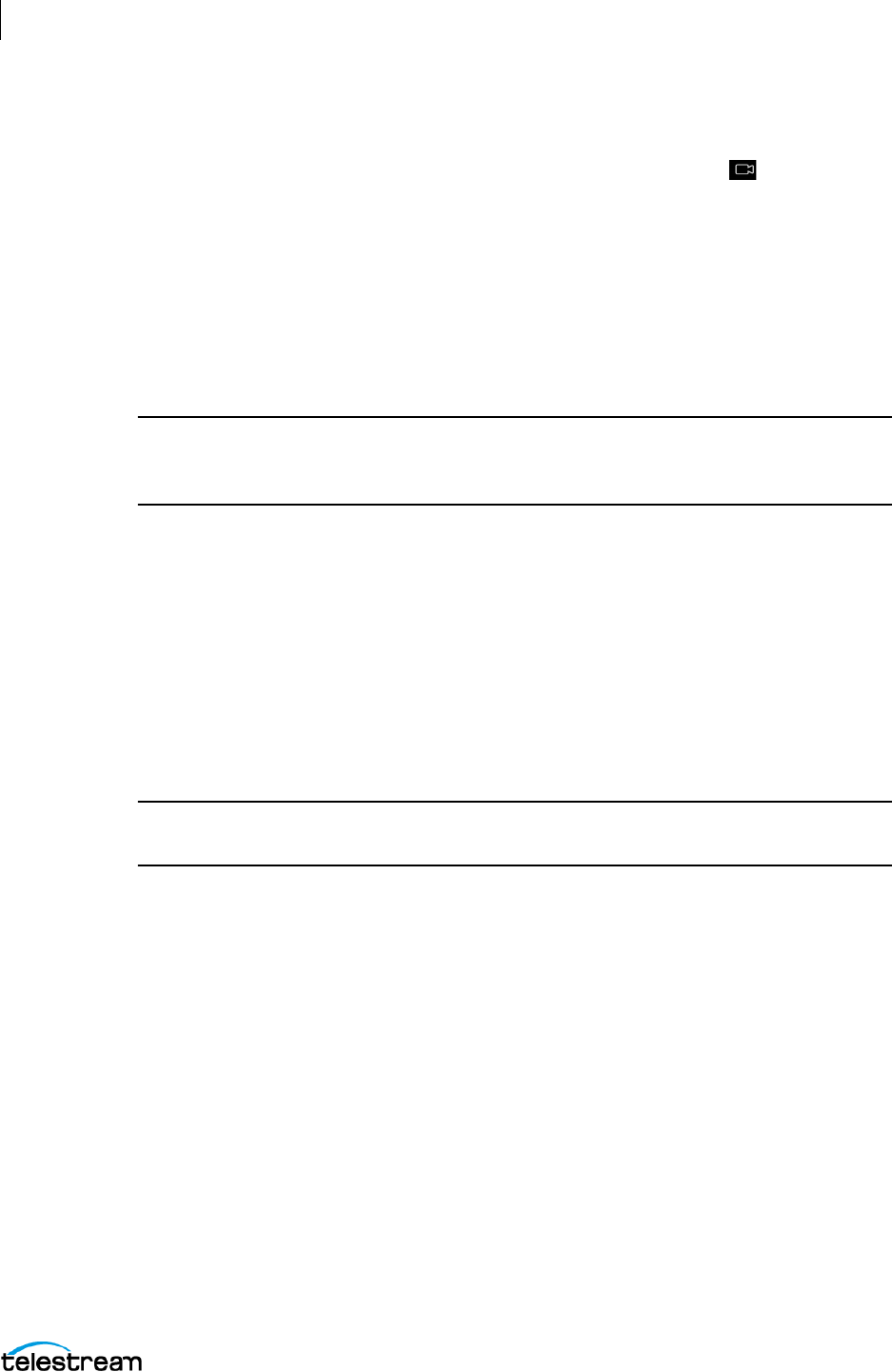
Documents and Recordings
Tips for Screencasting
52
ScreenFlow User Guide
ScreenFlow remembers the selection rectangle size and location the next time you
enter region selection mode. However, ScreenFlow doesn’t display this preset rectangle
automatically if you pick Record from the ScreenFlow Helper button . Clicking
Record continues recording only in full screen mode. You can activate region recording
only through the front-end window.
Once the recording has ended, you can interact with the new document as usual.
Viewing the Media Library
Once you’ve recorded or imported the first media file into a ScreenFlow document,
ScreenFlow creates a media library for the ScreenFlow document.
Note: ScreenFlow saves or duplicates every file you add to the library in the Media
folder. ScreenFlow recordings are media files with an SCC extension. Only ScreenFlow
opens SCC files.
For Packaged Document format documents, ScreenFlow keeps the media library in a
folder inside the SCREENFLOW document file itself. For Flat Document format
documents, ScreenFlow keeps the media folder inside the SCREENFLOWF document
folder. In either case, the media folder contains SCC files and copies of external media
files. These are managed by the media library as you record clips, add files, or delete
files.
To view the media folder, do the following:
1. Control-click (right-click) the project file in Finder and select Show Package Contents.
2. Open the Media folder to view the files in the media library for this document.
Caution: Unless directed by customer service, you should not delete or rename
files in this directory, which could corrupt your document.
Tips for Screencasting
Before you begin your screencast, it’s useful to consider how you and your users intend
to use your screencast, how you want to organize your media, and how best to present
your screencast on screen.
Setting Your Display Resolution
Before you begin recording, consider the resolution of your display and the intended
export resolution of your screencast. Typically, you shouldn’t export your screencast at
the resolution at which you recorded it. Export your final video at a lower resolution
than screen resolution—especially if you are recording a high resolution display or a
Retina display (maximum 2880 x 1800). This is especially important when you have text
which must be legible.

Documents and Recordings
Tips for Screencasting
53
ScreenFlow User Guide
Telestream recommends that you check your display resolution, via Mac System
Preferences > Displays, before recording. Lower your display resolution as much as
possible without impairing your ability to view your screencast clearly. To prevent
quality loss, don’t lower the resolution below your intended export resolution.
Best Text for Screencasts
Digital video was designed primarily for capturing real world images, so it is often
difficult to capture the thin lines of text legibly. Here are a few tips to consider for text in
your video:
• Use font sizes of 25 points or more. Larger characters always render better than
small ones.
• Don’t use serif fonts like Times Roman. Always use sans-serif fonts such as Arial or
Helvetica.
• Use boldface fonts, since they render better, especially at smaller sizes.
• Don’t use odd values for the output movie's frame height or width. Always use even
numbers. Also, importing sources with odd height or width values can result in
illegible titles.
• Always generate non-interlaced video. Interlaced video is prone to poor quality text
rendering, and can introduce flickering.
The Lossless preset is the only preset which you can specify as interlaced.
Approaches for Narrated Screencasts
When creating narrated screencasts, consider two different approaches. For a simple
demo, you might narrate the demo as you perform it. For a more complex demo, you
might record the demo first; then add narration in a separate step.
Recording Everything at Once
Using this method, you record each recording source in a single session—
simultaneously recording the display, camera video, microphone audio, and computer
audio. When you are done recording, you can use the editing tools to finalize your
screencast document.
For example, you might start a screencast by recording your display, then cut to a
Picture-in-Picture of a camera recording, as you demonstrate the application. Later, you
fade out your video, leaving only the audio to narrate the remaining moments of the
screencast.
This method is considered a single-pass production. It works well when your subject
matter is simple, straightforward, or short. For longer or more complex screencast
screencasts, you might find the second approach more comfortable.

Documents and Recordings
Tips for Screencasting
54
ScreenFlow User Guide
Recording Your Display—Then Adding Narration
Using this method, you first record the display (optionally, without computer audio),
demonstrating your application or subject matter without any video or voice-over.
When you have finished your demonstration, you record your camera and microphone
sources while playing the video preview of your demonstration in ScreenFlow. You can
do this in a single long recording or in several short recordings.
You then edit your recordings to align your narration with your demonstration or fade
your camera recording in and out when appropriate.
This workflow is effective when the screencast involves a series of complex mouse or
keyboard operations, or when you have several comprehensive steps or tasks to
achieve.
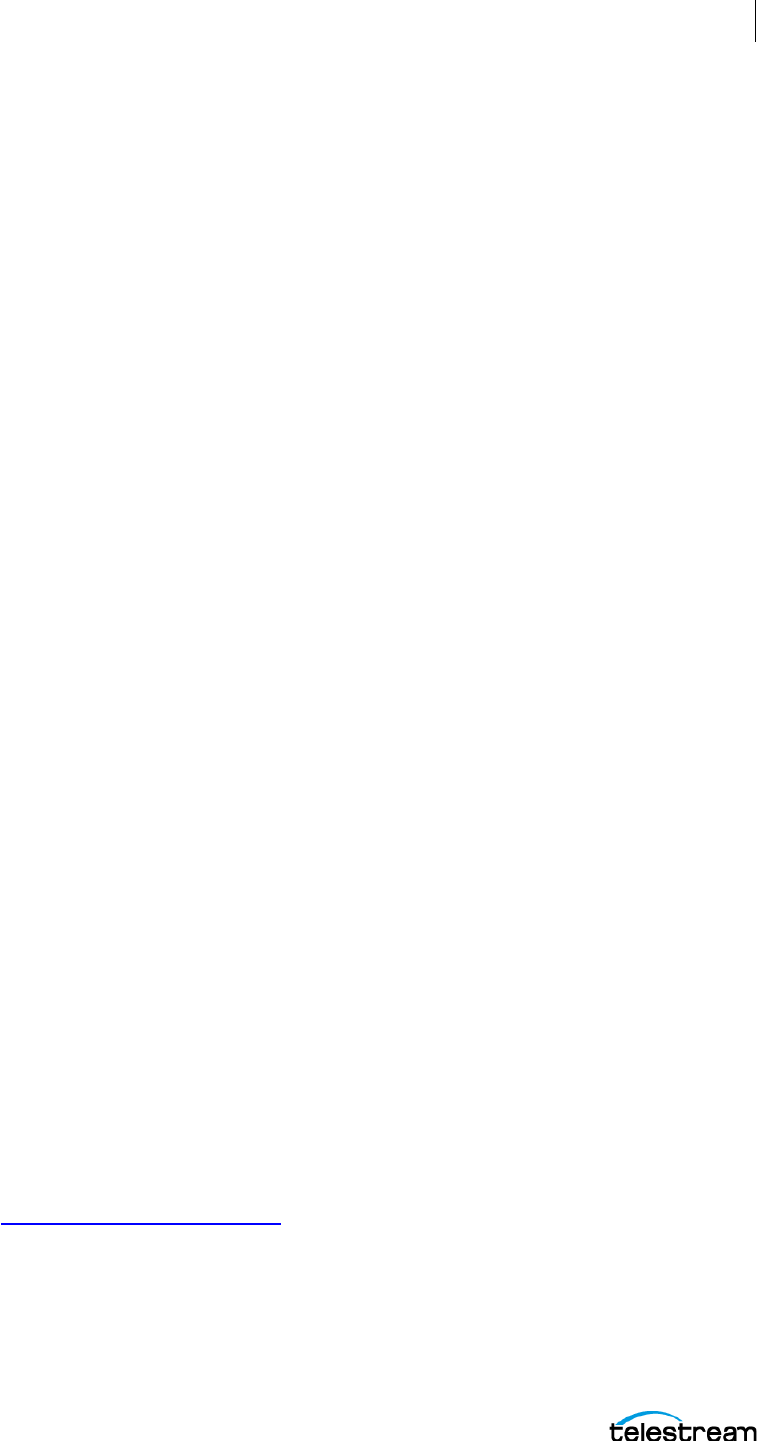
55
Media Editing
You can use ScreenFlow to add media to your document, and to edit your media into a
finished video.
Topics
■ Viewing the ScreenFlow User Interface
■ Finding Keyboard Shortcuts
■ Editing Clips
■ Editing on the Canvas
■ Editing in the Timeline
Viewing the ScreenFlow User Interface
To view the ScreenFlow user interface, launch ScreenFlow.
For descriptions of the various windows in ScreenFlow, see The ScreenFlow User
Interface.
For descriptions of ScreenFlow menus, see Menus.
For descriptions of ScreenFlow properties, see Properties.
Finding Keyboard Shortcuts
To speed up your workflow, you can start many ScreenFlow features with keyboard
shortcut commands.
• For a complete list of ScreenFlow keyboard shortcuts that you can customize, see
ScreenFlow keyboard shortcuts
.
Also see:
Shortcuts Settings Tab
Changing Shortcut Keys
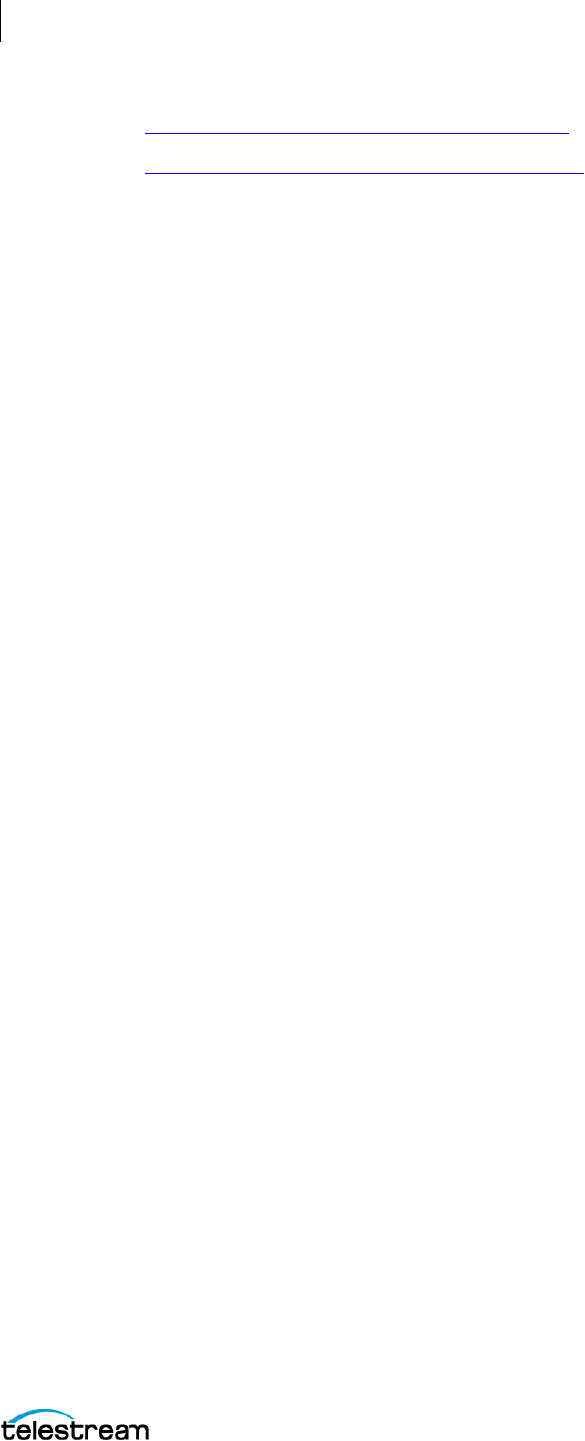
Media Editing
Editing Clips
56
ScreenFlow User Guide
Keyboard Shortcuts and Hotkey Customizations
ScreenFlow Tutorial - 3 Handy Timeline Shortcuts
Editing Clips
Before editing, you add clips to a ScreenFlow document. Clips are the building blocks of
every ScreenFlow screencast. A clip in ScreenFlow points to one or more media files,
but doesn’t contain the media files. A clip does contain all the information needed to
play and render the media file. Clip information can include start and stop times,
transitions, and other assigned properties.
Whether you record your display directly, or record a camera and microphone,
ScreenFlow adds clips for those recordings to your document. You can also add still
images or media files recorded outside of ScreenFlow.
ScreenFlow supports video and audio file formats that QuickTime Player can play in
macOS 10.6.x and higher. ScreenFlow also supports many image formats, including
PNG, JPEG, GIF, and TIFF.
The media library holds all the clips for a ScreenFlow document. You can add clips to a
media library by dragging and dropping media files into the media library.
Alternatively, ScreenFlow adds a clip to the media library for every media file you drop
into the ScreenFlow timeline.
See The Properties Window for more detail on how to add media to your library.
Adding Clips to a Media Library
Drag a clip from the file system (Desktop or Finder window) directly onto the
ScreenFlow timeline. This allows you to place the clip on the track you want, at the
point on the timeline you want. ScreenFlow automatically adds the clip to the media
library.
Adding Clips to the Timeline or Canvas
To add clips to your timeline or canvas, do one of the following:
• To add a clip to the timeline at the scrubber, double-click the clip in the media
library.
• To place the clip on the track you want, at the location you want, drag a clip from
the media library directly onto the timeline.
• To add several clips sequentially by time onto a single track, select the clips sequen-
tially and-drag the group onto the timeline.
• To place clips as stacked layers on the timeline, hold the Shift key down while click-
ing and dragging multiple clips onto the timeline.
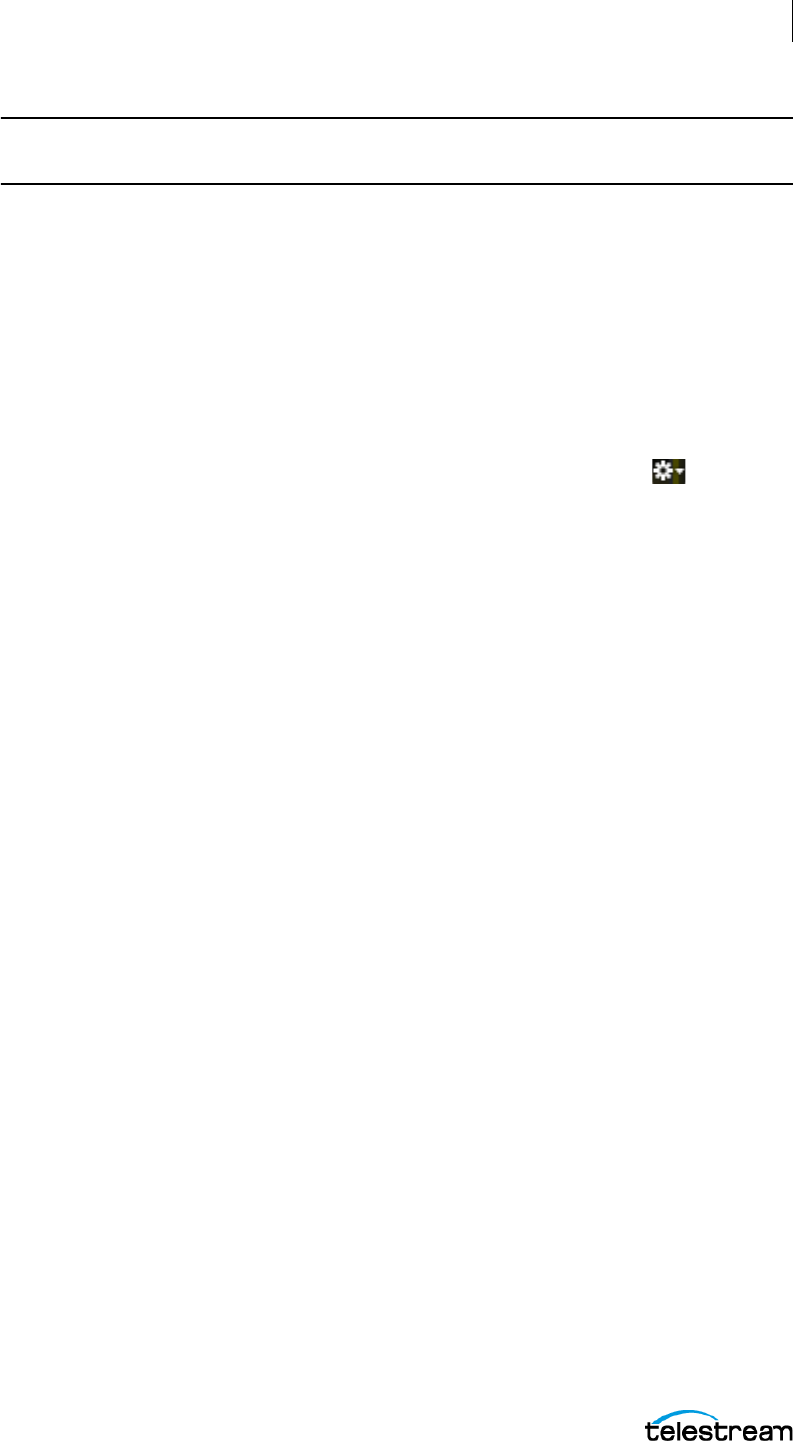
Media Editing
Editing on the Canvas
57
ScreenFlow User Guide
Note: You can select one or more clips using lasso selection—click and drag across
some portion of several clips to select them.
• To place a clip to the timeline at the current scrubber position, click the plus (+) icon
and select a clip from the drop-down list.
• To place a clip spatially on the canvas, drag the clip from the media library directly
onto the canvas. ScreenFlow also places the clip in a new top track on the timeline
at the scrubber.
• Copy and paste clips in the same document, or copy and paste clips between open
ScreenFlow document windows.
ScreenFlow derives the default name of a clip from the media file it references. To
change the name of a clip, double-click on the text or click the gear icon on the clip,
and select Rename Clip. The new name does not change the name of the source file.
Viewing Clip Metadata
To view the metadata of a video clip, do the following:
1. Select the Media Library tab in the Properties window.
See Media Library.
2. Click the Metadata button, and select a clip.
Deleting Clips
To delete clips from your document do one of the following:
• Select a clip on the canvas or timeline and press Delete or select Edit > Delete. This
removes the clip from the canvas and timeline, but leaves the original clip in the
media library.
• Select a clip in the media library and press Delete or select Edit > Delete. This
removes the clip from the canvas, timeline, and media library. If the clip is on the
timeline, ScreenFlow displays a Delete dialog. Click Delete to continue.
These deletions remove the clips from the document. They don’t delete the refer-
enced media files.
Editing on the Canvas
You can place clips in different parts of the screen using the Canvas.
See the Canvas in the screenshot in the topic, The ScreenFlow User Interface.

Media Editing
Editing on the Canvas
58
ScreenFlow User Guide
Zooming and Panning the Canvas
You can zoom in and out on the canvas to view details or see the big picture. When the
canvas is larger than the panel, scroll bars appear so that you can scroll in any direction
to view hidden portions of the canvas.
To zoom in or out on the canvas, hold down the Option Key and move the scroll wheel.
You can also use these commands:
• Zoom in—select View > Zoom In (Command-=)
• Zoom out—select View > Zoom Out (Command--)
• Zoom to full pixel size—select View > Zoom to 100% (Option-Command-0 (zero))
• To scroll the canvas with a mouse, hold down the spacebar and drag. Also, you can
use normal trackpad actions.
• If you press the Space Bar while moving the Canvas, the position values are not
changed.
ScreenFlow changes the position values in the Video tab accordingly.
See The Transitions Inspection Window.
Clips on the Canvas
After you add clips to your document, you can edit the clips on the canvas. For example,
you can arrange clips spatially, and can crop, resize, rotate, or add filters.
Selecting a Clip
To select a clip, click the clip on the canvas or on the timeline.
ScreenFlow highlights the clip both on the canvas and the timeline, and displays
the properties of the selected clip in the Properties window.
See Properties.
Placing a Clip Spatially on the Canvas
To place a clip anywhere on the canvas, drag the clip and drop it at the location desired.
As the clip approaches the vertical or horizontal center of the canvas, yellow guide-
lines appear to help you center the clip.
Alternatively, select the clip and click the Video Properties tab. To change the clip
location on the canvas, adjust the X and Y values in the Video Properties tab.
See Moving Images
.
Resizing or Scaling a Clip on the Canvas
To resize (or scale) a clip up or down, select the clip, and do one of the following:
• Select any resize handle, and drag.

Media Editing
Editing in the Timeline
59
ScreenFlow User Guide
• Hold down the Command key while turning the scroll wheel on your mouse.
• Click the Video Properties tab. Drag the Scale slider or manually enter a percentage.
• Select Arrange > Scale.
• Right-click on a clip in the canvas to access the following controls:
– Scale to Fit Enlarges clip to fill the window, while maintaining its scale.
– Stretch Enlarges clip to fill the window, without maintaining its scale (fills the
entire window).
– Reset Restores the clip to its original scale and size.
Cropping a Clip on the Canvas
To crop a clip, select the clip and do one of the following:
• Press and hold the Control key, and drag any resize handle inward.
• To preserve the aspect ratio, press and hold Control-Shift while dragging a handle.
• Select the Video Properties tab. Click the Details icon. Drag the left, right, top and
bottom sliders, or manually enter a pixel value.
Rotating a Clip on the Canvas
To rotate a clip on its access, do one of the following:
• Click and drag the center handle of the clip; then rotate it.
• Select the Video Properties tab. Drag the X, Y, and Z thumbwheels, or manually enter
a degree value.
Editing in the Timeline
You can use the controls in the Timeline to navigate your document.
See The Timeline Window.
Navigating the Timeline with the Scrubber
In the timeline, the red vertical bar with the red flag handle at the bottom is the
scrubber. The scrubber identifies the current temporal position of the frame displayed
on the canvas. ScreenFlow displays the timecode of this frame in the toolbar.
See the scrubber in the screenshot in the topic, The ScreenFlow User Interface.
• To scrub (move) through your screencast, grab the top handle (in the time scale)
and move it right or left.
Note: As you use the scrubber to scrub your screencast, the canvas updates in real
time.
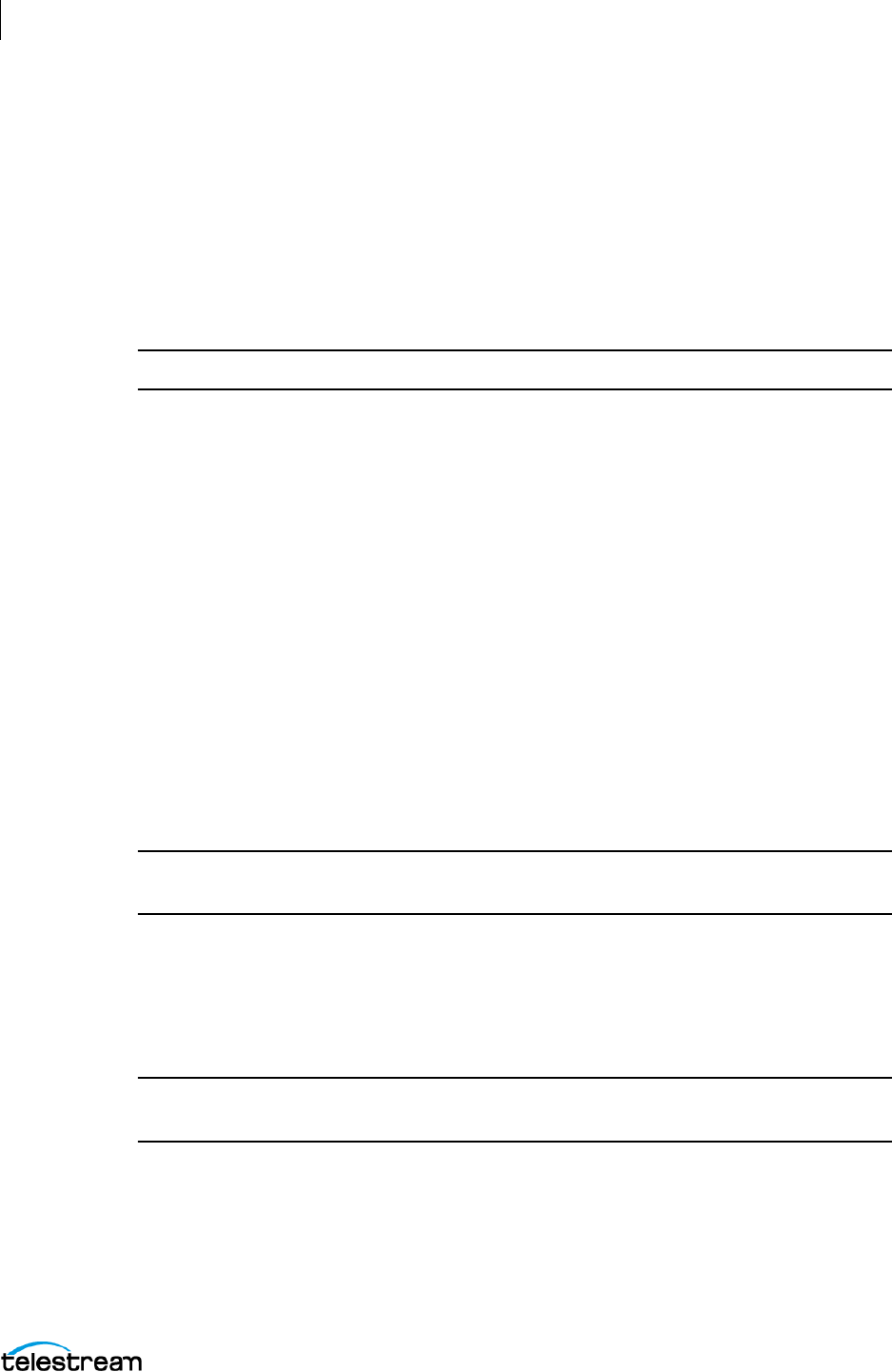
Media Editing
Editing in the Timeline
60
ScreenFlow User Guide
• To jump the scrubber to the beginning of the timeline, press the Home key. Alterna-
tively, select Mark > Go to > Project Start.
• To jump the scrubber to the end of the timeline, press the End key. Alternatively,
select Mark > Go to > Project End.
• To move the scrubber a frame at a time, press the left or right arrow keys. Alterna-
tively, select Mark > Go to > Previous Frame or Mark > Go to > Next Frame.
• To insert empty time across all layers on the timeline, drag the red flag handle of
the scrubber.
Note: This action splits clips that fall under the scrubber,
See The Timeline Window.
Measuring Duration with Scale
ScreenFlow displays the scale at the top of the timeline. The scale is a precise measure
of the total length of time in the screencast.
You can view the start and stop time of each clip (or action in a clip) by dragging the
scrubber to the beginning or end of the clip.
See the scrubber in the screenshot in the topic, The ScreenFlow User Interface.
Zooming In and Out on the Timeline
You can zoom in on an area of the timeline to make adjustments—or zoom out to see
the big picture.
See the screenshot in the topic, The ScreenFlow User Interface.
Note: Apple Magic Trackpad and MacBook Pro users can use pinch gestures to zoom
in/out on the timeline.
To zoom in or out of the timeline, do one of the following:
• Drag the scale slider in the lower left corner of the timeline.
At maximum magnification, each line on the scale represents a single frame of
video.
Note: You can also click repeatedly on the small and large magnifier icons to
incrementally zoom in or out.
• To fit the entire screencast in the timeline, select View > Zoom Timeline to Fit (Con-
trol-T).
• To zoom in, select View > Zoom Timeline In (=).
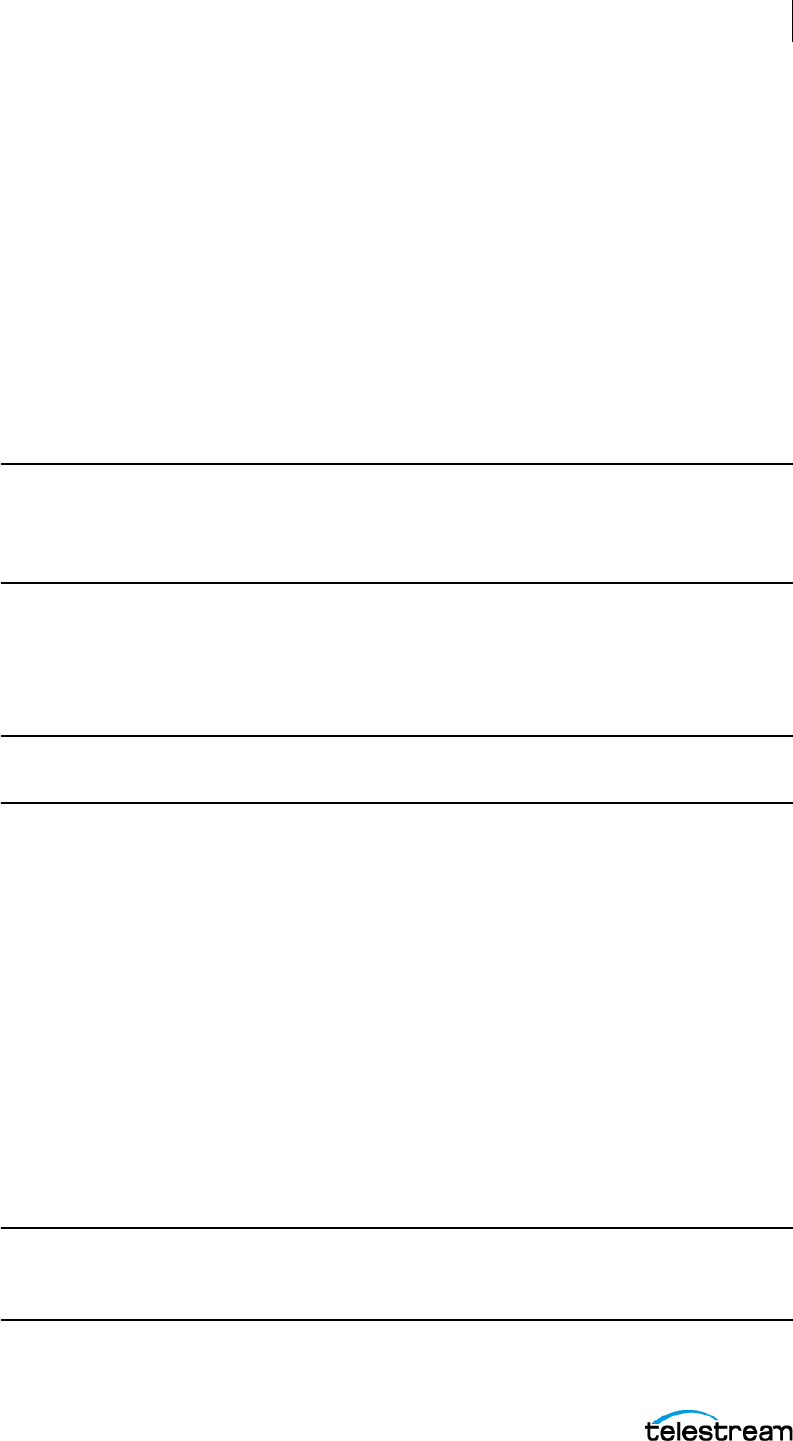
Media Editing
Editing in the Timeline
61
ScreenFlow User Guide
• To zoom out, select View > Zoom Timeline Out (-) menu items.
See The Timeline Window.
Detaching Timelines
You can detach the timeline window, or any timeline tab, from the ScreenFlow layout.
You can move a timeline window independently from the ScreenFlow layout, even
onto a second monitor.
To detach a timeline, select Window > Detached Timeline
ScreenFlow detaches the timeline window from the ScreenFlow layout.
See The Timeline Window.
Note: With Detached Timeline enabled, ScreenFlown opens documents in the
detached-timeline state by default. Also, ScreenFlow re-opens currently-open
documents in detached-timeline mode. ScreenFlow retains this setting, and applies it
when the application is reopened.
The initial position of a detached timeline window is close to the normal location of the
timeline in the ScreenFlow layout. ScreenFlow appends “-Timeline” to the name of the
detached timeline window. The detached timeline window maintains its own title bar,
Close, Maximize and Minimize controls.
Note: Closing a detached timeline window closes the entire document associated
with it.
Timeline Tracks
The timeline is divided into tracks. Tracks allow you to superimpose clips on one
another. If clips are place on different tracks at the same point in time, the clip in a
higher track appears on top of the clip in a lower track.
Clips in the top track can’t be obscured. Clips in the bottom track always appear below
clips in all other tracks.
When you place a text box on a track higher than a track with a video clip in it,
ScreenFlow superimposes the text on top of the video. If you place the text box on the
track below the video clip, the video clip obscures the text.
You can place multiple clips sequentially in a single track or you can place clips
separately on individual tracks. You can create as many tracks as you need.
Note: QuickTime X and VLC require a chapter marker on the first frame of your
project. To prevent QuickTime or VLC chapter markers from moving from their
intended locations, set a chapter marker at the very beginning of your project.

Media Editing
Editing in the Timeline
62
ScreenFlow User Guide
Adding and Deleting Tracks
• To add a track, drag a clip into the timeline below the existing tracks.
ScreenFlow creates a new lowest track.
• To delete a track, select the track and press the Delete key.
Customizing Tracks with the Track Controller
Use the track controls at the left of each track to adjust the track height or to re-arrange
track order.
See track controls in the screenshot in the topic, The ScreenFlow User Interface.
• To adjust the height of a track, click the down arrow to decrease track height; or
click the up arrow to increase track height.
• To re-arrange a track’s position, select the track position handle and drag the track
up or down in relation to the other tracks on the timeline. Drop the track into the
new position.
This allows you to move all of the clips in a track to a higher or lower layer, rather
than moving one clip at a time.
• To create a new track for a clip, drag the clip downward past the bottom of the low-
est track. When ScreenFlow creates a new track, drop the clip into the new track.
• To hide or unhide the video in a track, click the eye icon on the left end of the track.
To mute or unmute the audio in a track, click the speaker icon on the left end of the
track.
Creating and Closing Gaps in a Single Track
• To create a gap in a track between existing clips, drag to shift the clips to the left or
right as desired.
• To close a gap in a track, click in the gap. ScreenFlow highlights the gap in purple
with diagonal gray stripes. Press the Delete key, or control-click and select Close
Gap.
Creating a Gap Across All Tracks
Occasionally, you might want to create a gap in all tracks of the timeline, to make room
for additional clips. To create a gap in all tracks, do the following:
1. Position the scrubber where you want the gap to occur.
See the scrubber in the screenshot for the topic, The ScreenFlow User Interface.
2. Grab the handle (red flag) at the bottom of the scrubber and move it to the right.
As the gap is created and widened, all clips to the right of the scrubber (in every
track) move to the right to create the timeline gap. If the scrubber is positioned
over any clip, ScreenFlow splits the clip in two.
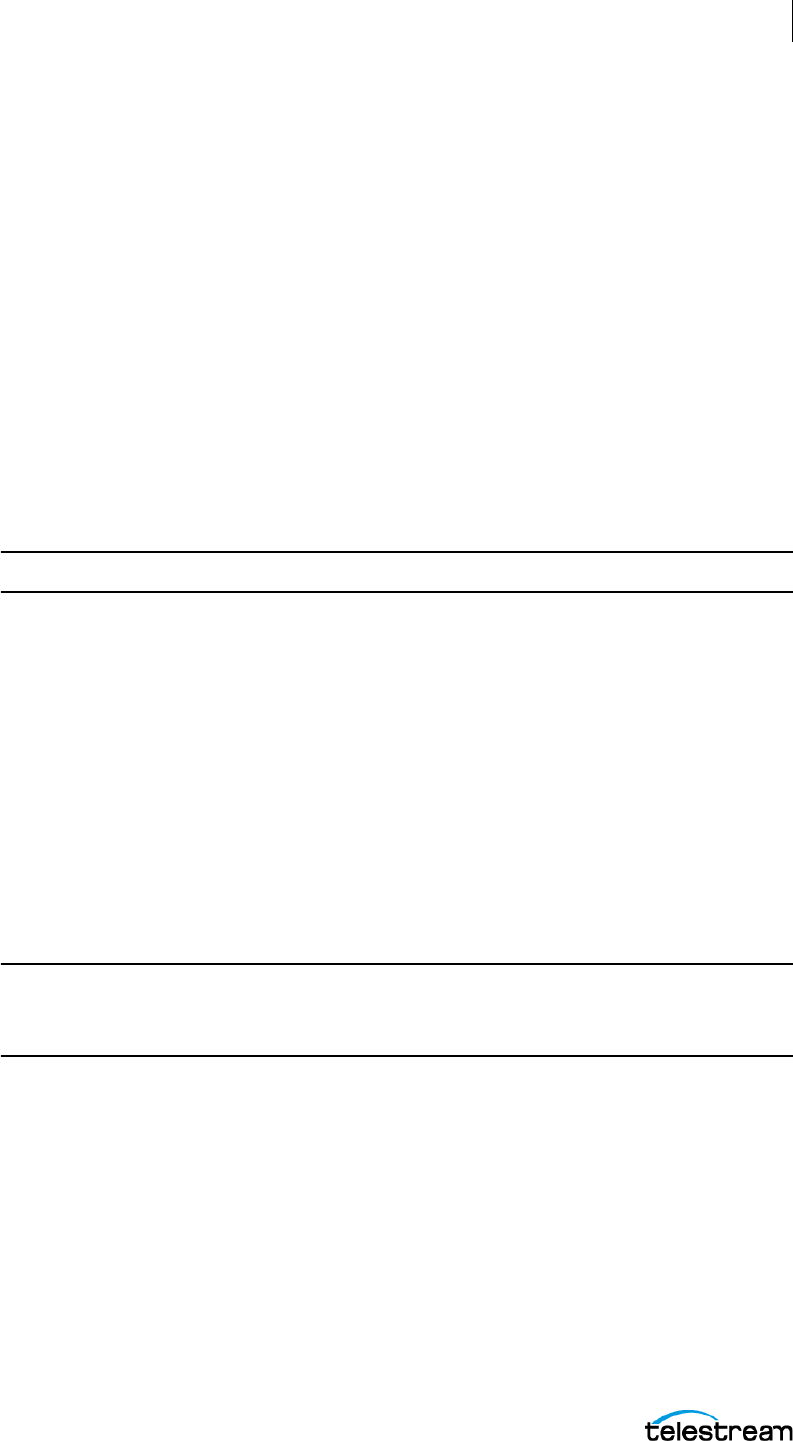
Media Editing
Editing in the Timeline
63
ScreenFlow User Guide
Closing a Gap Across All Tracks
To close a gap in all tracks, do the following:
1. Position the scrubber at the beginning of the gap you want to close.
See the scrubber in the screenshot for the topic, The ScreenFlow User Interface.
2. Drag the bottom scrubber handle (red flag) to the left.
This doesn’t join clips which have been split; it just butts them together. If clips
overlap, this forms a transition.
Timeline Markers
You can place markers on your timeline to identify milestones on your screencast.
Timeline markers are particularly useful for editing complex screencasts. Unlike clip
markers, timeline markers remain at their locations on the timeline, regardless of
changing clip locations.
Note: You can export marker locations as chapter markers in supported formats.
Adding a Timeline Marker
To add a timeline marker, do the following:
1. Add an unnamed marker in one of the following ways:
• Move the scrubber to the desired location and select Mark > Markers > Add.
• Control (right)-click in the time scale (scrubber jumps) and select Add Marker.
• Select Window > Markers, then move the scrubber to the desired location and in the
Markers window, click the plus (+) icon at the bottom left.
ScreenFlow displays a dialog so you can name the marker.
2. After entering the name of the marker, click OK.
Note: Markers display as orange ticks on the time scale if they are named, but display
in blue if blank or unnamed. You can select them to rename them, or drag them to re-
arrange them.
Jumping to a Marker
To jump to a given marker, do the following:
1. Select Window > Markers.
ScreenFlow displays the Markers window.
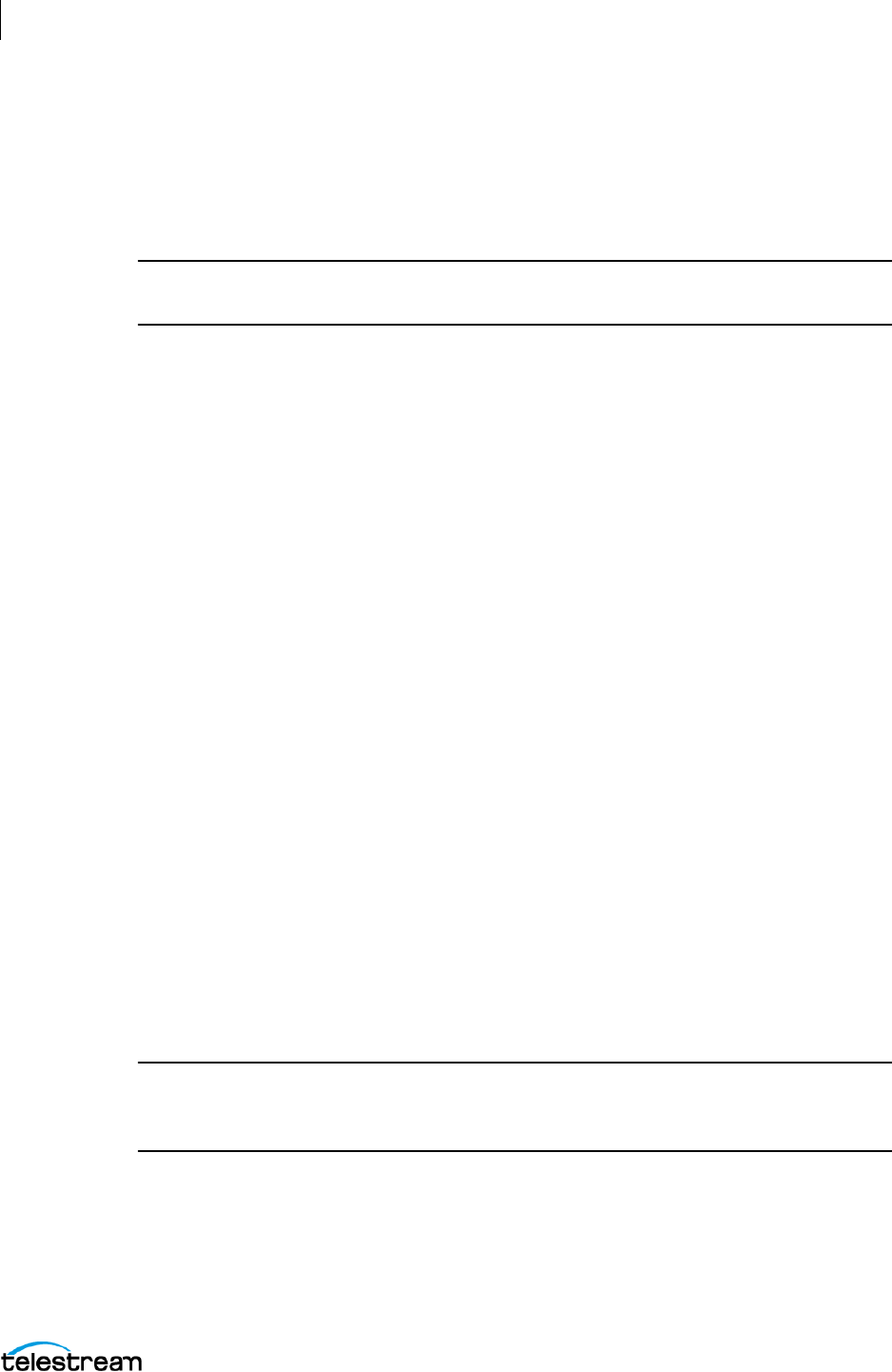
Media Editing
Editing in the Timeline
64
ScreenFlow User Guide
2. Do one of the following:
– Click the arrow to the left of a marker to quickly move to that marker in the
timeline.
– Control (right)-click in the time scale—select the marker that you want to jump
to.
Note: You can use keyboard shortcuts for jumping to markers. See Shortcuts Settings
Tab.
Deleting Markers
To delete markers, do one of the following:
• Control- (right)-click the orange or blue marker in the time scale and select Delete.
• In the Markers window, select the marker and press Delete or click the minus (-) icon
at the bottom left.
• Move the scrubber over the marker and select Marker > Delete Marker.
Timeline In and Out Points
You can place in and out points on the timeline, so that you can edit the contents of
tracks between the in and out points.
Creating Timeline In and Out Points
You can create in and out points on your timeline, and use them in the editing of tracks.
To set timeline in and out points, do the following:
1. Place the scrubber at the desired in point. Select Mark > Mark In Point (or press I).
Alternatively, press shift-click to the left of the scrubber.
ScreenFlow highlights the timeline in blue from the beginning of the timeline to
the in point.
2. Place the scrubber at the desired out point and select Mark > Mark Out Point (O) to
set the out point. Alternatively, press shift-click to the right of the scrubber.
ScreenFlow highlights the timeline in purple from the out point to the end of the
timeline.
Note: When you create an in point without an out point, ScreenFlow automatically
sets the out point to the end of the last clip. When you create an out point without an
in point, ScreenFlow sets the in point to the beginning of the timeline.
See The Timeline Window.
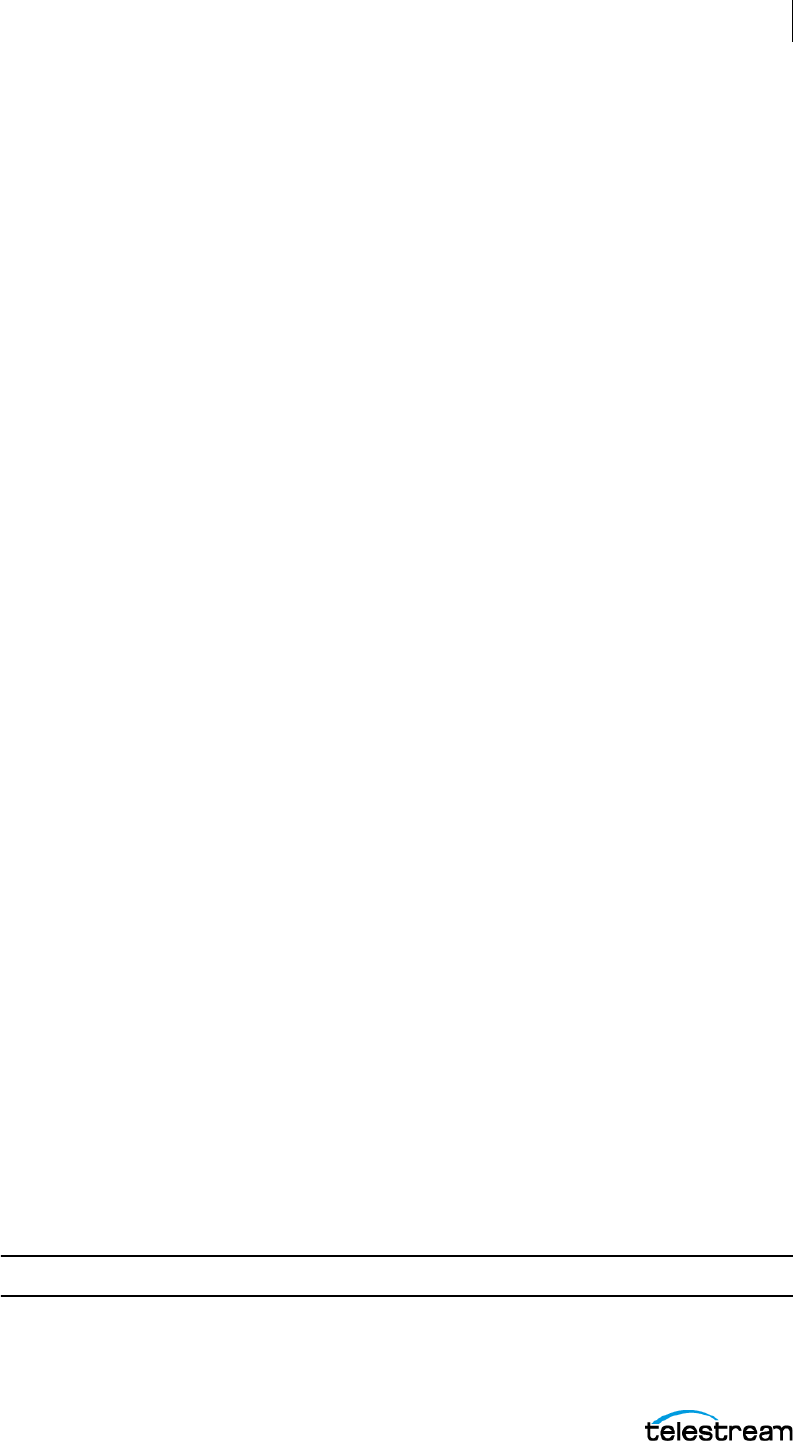
Media Editing
Editing in the Timeline
65
ScreenFlow User Guide
Editing Tracks Between Timeline In and Out Points
You can export or delete a section of the timeline you’ve marked with in and out points,
as follows:
• To delete the selected (marked) section of the timeline and close the gap, select
Edit > Ripple Delete (Command-Backspace).
ScreenFlow deletes all clips between the in and out points on all tracks. ScreenFlow
shifts all clips to the right of the deletion to the left, closing gaps. After performing
in and out point operations, ScreenFlow removes the timeline in and out points.
• To delete the selected (marked) section of the timeline, without closing the gap,
select Edit > Delete.
ScreenFlow deletes all clips between the in and out points on all tracks, leaving a
gap on the timeline. After performing in and out point operations, ScreenFlow
removes the timeline in and out points.
• To publish the range of clips bounded by the points, select
File > Publish to Selected Range > Vimeo > YouTube > Google Drive > Dropbox >
Wistia.
ScreenFlow displays the selected Publish dialog. Proceed as appropriate for the
publisher.
See Media Export and Project Archiving for details.
• To export the range of clips bounded by the points, select File > Export Selected
Range.
See Video Encoding.
Clips on the Timeline
You can trim clips directly on the tracks in the ScreenFlow timeline.
Arranging and Adjusting Clips in the Timeline
• To adjust the start time of a clip relative to other clips, click and drag a clip left or
right in a track.
• To move a clip from one track to another, click and drag the clip.
Splitting a Clip in the Timeline
To split a clip into two smaller clips, position the scrubber between the frames where
you want the split to occur,. Then press the T key or select Edit > Split.
ScreenFlow splits the selected clip at the scrubber. Then, ScreenFlow selects the
newly-created clip to the left of the split.
Note: Press Shift-T to split the clip and have ScreenFlow select the clip on the right.
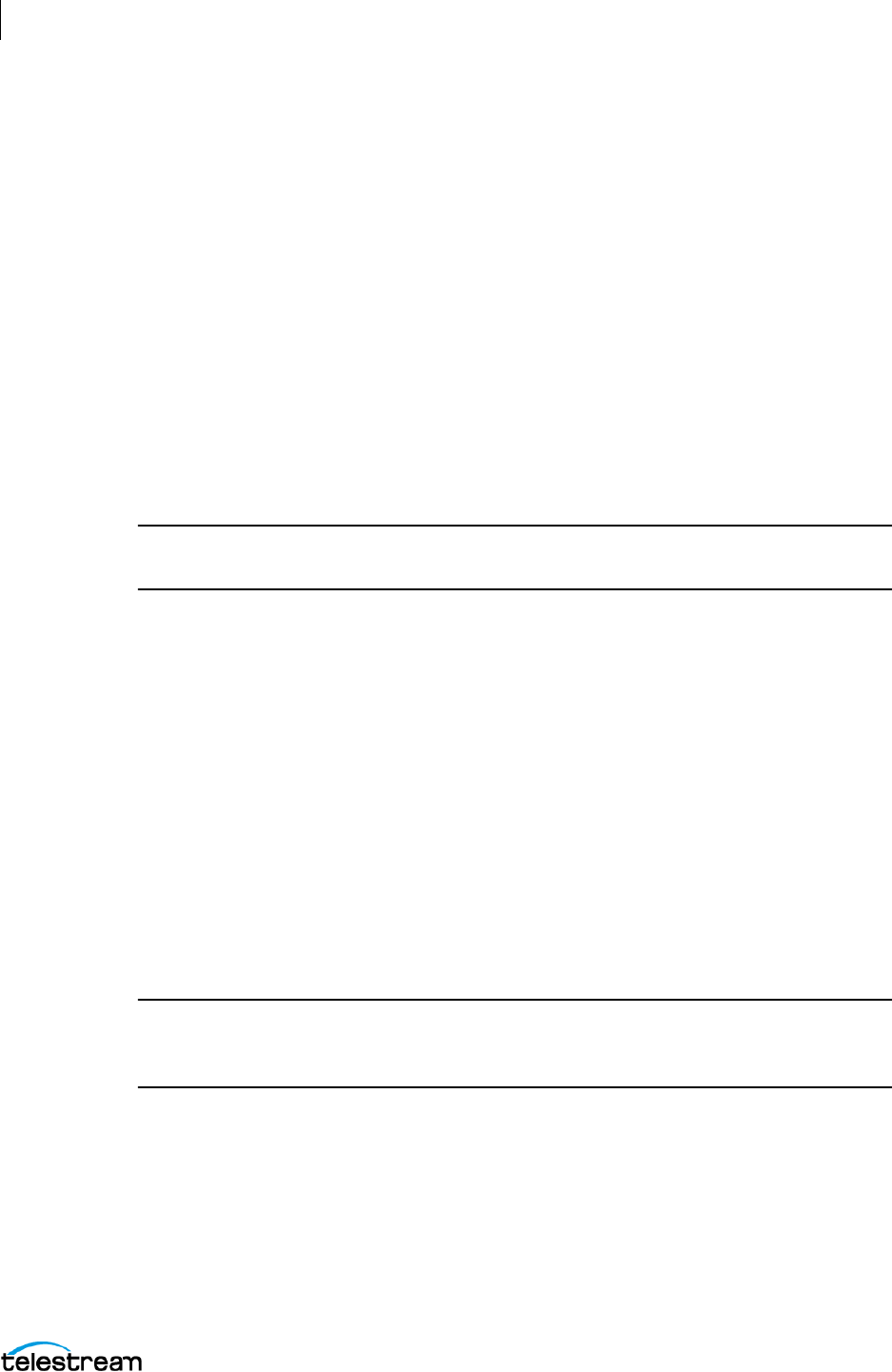
Media Editing
Editing in the Timeline
66
ScreenFlow User Guide
Trimming a Clip in the Timeline
• To trim the front of a clip to the location of the scrubber, select the clip. Place the
scrubber at the time when you want the clip to begin. Then, press the W key or
select Clip > Trim Front to Scrubber.
This trims the beginning of the clip up to the scrubber, changing the clip start time.
• To trim the end of the clip to the scrubber, select the clip. Place the scrubber at the
time where you want the clip to end. Then press the E key or select
Clip > Trim End to Scrubber.
This trims the end of the clip back to the location of the scrubber., changing the
end time.
• To trim either end of a clip, grab the desired end of the clip and drag it inward
towards the center of the clip.
• To restore frames in a previously-trimmed clip, grab the desired end of the clip and
drag it outward from the center of the clip.
Note: Trimming changes the amount of time the clip plays; it doesn’t modify the
referenced media file.
Giving a Clip a Custom Name
To give a clip a custom name, do the following:
1. Double-click the clip on the timeline.
2. Enter a custom name for the clip.
ScreenFlow renames the clip in the timeline, but doesn’t rename its referenced
media files in the media library.
Deleting Clips Between Timeline Markers
To delete all assets between two markers from the timeline, do the following:
1. Mark In and Out points on your timeline.
2. Select Delete to remove all assets from the timeline between the In and Out points:
Note: To shift clips left to fill the hole created by the deletion, use Ripple Delete
(Command-backspace), the scrubber handle, or right-click (Control-click) in the empty
space and select Close Gap.
Adding a Clip Marker
Clip markers remain on their clips even when you move the clips.Timeline markers
remain at their locations on the timeline, regardless of changing clip locations.
To add a clip marker, do the following:
1. Select a clip and make sure the scrubber is within the bounds of the clip.

Media Editing
Editing in the Timeline
67
ScreenFlow User Guide
2. Select Mark > Markers > Add to Clip.
3. When ScreenFlow displays the popup dialog box, enter a name for your marker,
and click Create.
You can create the marker without a name. Clicking away from the popup cancels
the Add To Clip operation.
ScreenFlow places the marker at the bottom of the parent clip.
4. (Optional) To reposition the marker, drag and drop it.
5. (Optional) To change the name of the marker, double-click it. Enter a new name
into the marker popup.
6. (Optional) To view all markers, select Window > Markers.
ScreenFlow displays a list of all markers.
Note: You can convert clip markers to chapter markers for YouTube or QuickTime
exports.
See Adding Clip Markers While Recording and Mark Menu.
Changing Clip Play Speed
You can change the play speed of individual clips on the timeline.
To change the play speed of a clip, do one of the following:
• Press and hold the Option key and move your cursor to the edge of the clip. The
cursor displays a clock icon indicating that you are changing the clip speed. Move
the edge of the clip inward to speed the clip up and outward to slow the clip down.
• Click on the gear icon. Select Show Clip Inspector, and do one of the following:
– Use the slider or manually enter a percentage value.
– Change the duration to change the speed. Short is faster, longer is slower.
– To play the clip backwards, check Play Clip in Reverse.
– To prevent editing of the clip, check Locked.
ScreenFlow marks the clip with a speed badge—a turtle or rabbit icon—to indicate
that the clip speed was decreased or increased.
Grouping and Un-grouping Clips
You can group a set of clips together to link them to one another in their current order.
You can move a group in a single operation.
Note: Since they are on the same timecode, grouping a screencast clip with a
corresponding iSight clip makes it easy to keep the two in sync.
Do one of the following:
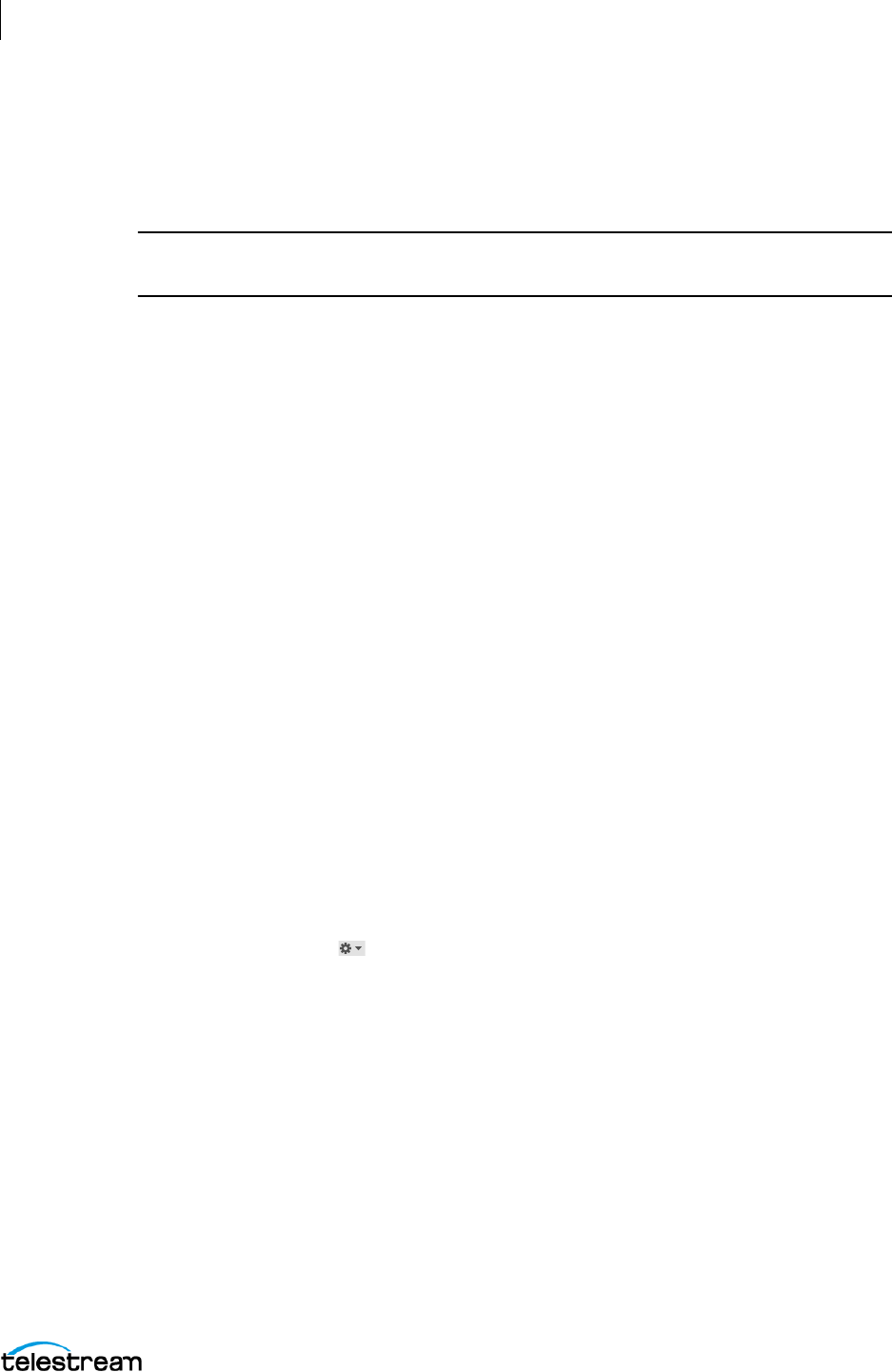
Media Editing
Editing in the Timeline
68
ScreenFlow User Guide
• To group a set of clips together, select the clips you want to group, and select
Edit > Group or press Command-G.
• To ungroup a group of clips, select the group, then select Edit > Ungroup or press
Command-U.
Note: ScreenFlow also supports nesting of clips to reduce timeline complexity. For
details, see Nested Clips.
Nested Clips
After you add many clips to the timeline, it could become hard to manage. A solution:
create nested clips for complex clip sequences.
You can merge a sequence of multiple clips into a single, nested clip. This reduces the
visual complexity of the high-level timeline.
You can do any of the following with clip nesting:
• Display the contents of each nested clip on its own tab in the timeline.
• Re-use nested clips in various tracks and timelines.
• Edit a nested clip, thereby changing to the whole set of nested clips as a unit.
• Nest clips recursively. That is, you can nest a sub-set of the clips already in a nested
clip.
• Nest one nested clip inside another nested clip.
• Create a nested clip from an existing nested clip and another clip.
Creating a Nested Clip
1. To nest a set of clips, select the clips you want in the set and do one of the
following:
• Select Edit > Nest Clips.
• Click the gear icon on one of the clips and select Nest Clips (Option-Control-N).
• Control (right)-click one of the clips and select Nest Clips (Option-Command-N).
ScreenFlow replaces the set of nested clips with a single clip the length of the now-
nested clips on the timeline. Also, ScreenFlow opens a new timeline tab displaying
the nested clip.
ScreenFlow supports up to ten levels of nesting.
Un-nesting a Nested Clip
To un-nest a nested clip, do the following:
1. Select the nested clip.
2. Select Edit > Unnest Clips.
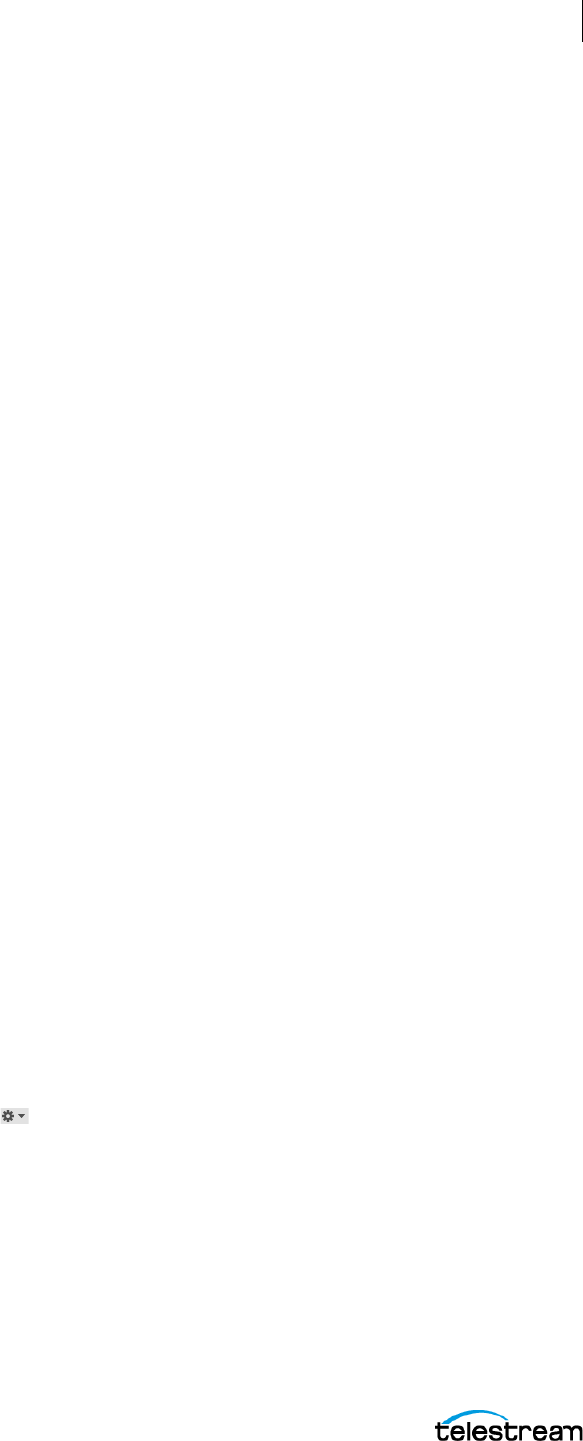
Media Editing
Editing in the Timeline
69
ScreenFlow User Guide
Viewing and Editing Nested Clips
To display the clips inside of a nested clip, double-click the nested clip in the Timeline
tab.
To display the tab bar, select View > Show Tab Bar. (Uncheck it to hide it again). The tab
bar displays the Timeline tab at the far left. The Timeline tab displays the entire view of
the timeline, including nested clips in relation to all other clips.
Additional tabs display the name of each nested clip in the Timeline tab. To change it,
double-click on the name in the clip and rename it. The name on the tab automatically
updates when you change the master clip’s name.
To display the clips inside a given nested clip, select the tab for that clip. ScreenFlow
hides the Timeline tab contents, and uses the entire window to display all of the clips
that comprise the nested clip. ScreenFlow opens the nested clip and displays all of its
contents on the timeline.
To view the big picture of your timeline, you can click the Timeline tab at any time.
Nesting also provides another benefit: You can apply video filters and actions such as
color correction or effect filtering to a nested clip. These changes apply to all clips
inside the nested clip.
You can organize nested-clip tabs to suit the needs of your document. For example, you
might display nested clip tabs in the same order in which the nested clips appear in the
timeline. Alternatively, you could display nested clip tabs alphabetically. To move a tab,
click and drag it to its new location.
When you delete a nested clip, all clips inside are deleted, and its tab is automatically
removed from the timeline as well.
Keep in mind that after you have trimmed a video, the untrimmed portion displays with
diagonal lines.
Locking Clips
To prevent a clip from modification, lock the clip so that it can’t be altered in any way on
the timeline. When you lock a clip, it appears dim and can’t be modified or moved.
To lock a clip, select it and use one of these methods:
• Select Arrange > Lock Clip.
• Click the gear icon on the clip and select Show Clip Inspector, then check Locked
or select Lock Clip (Option-Command-L).
To unlock the clip, select it and select Arrange > Unlock Clip or display the gear menu
and select Show Clip Inspector or select Unlock Clip (Option-Command-L).
Creating Rolling Edits
The rolling edit feature is enabled when two clips are connected to each other with no
gap between them. To create a rolling edit, do the following:
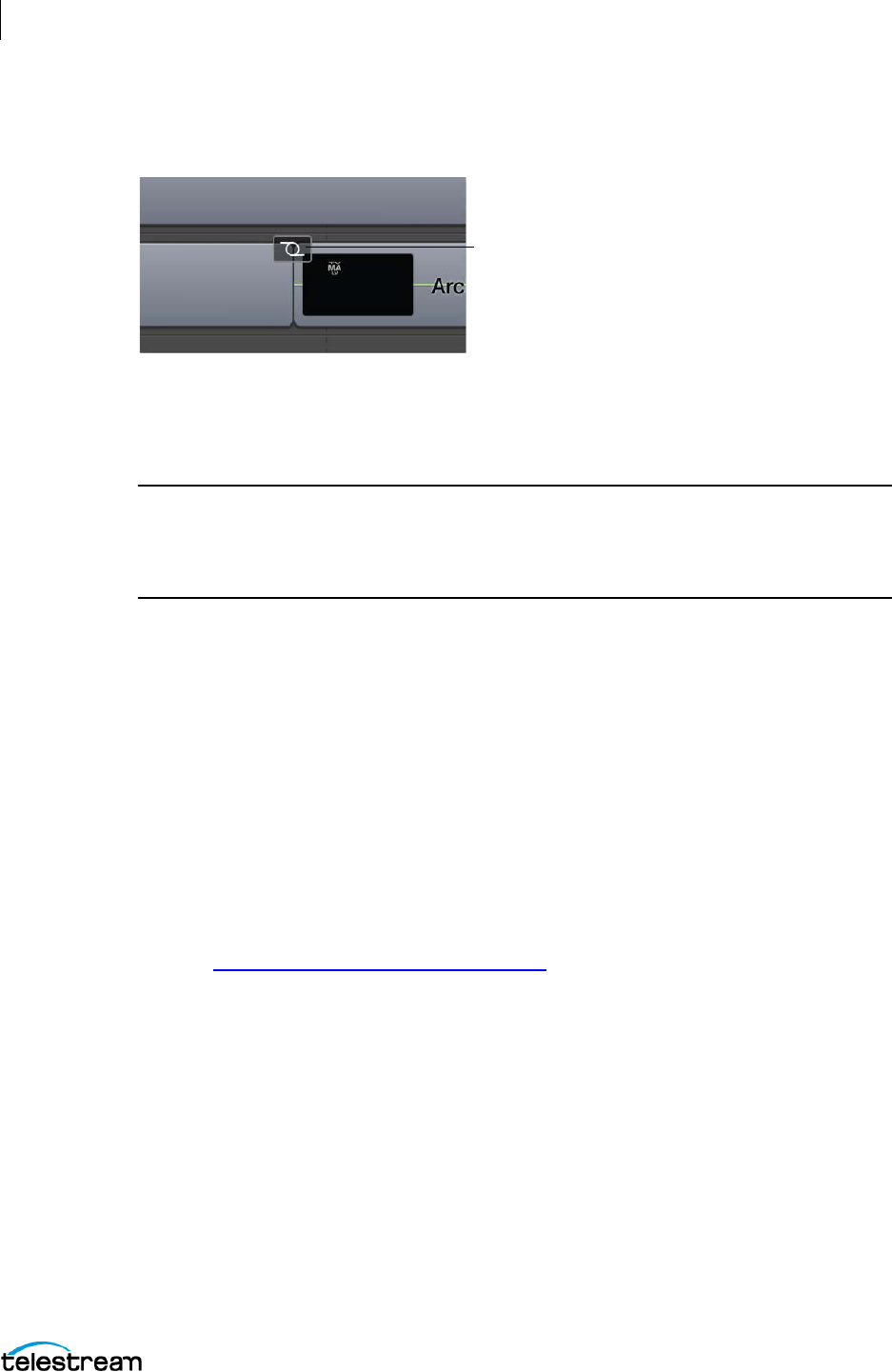
Media Editing
Editing in the Timeline
70
ScreenFlow User Guide
1. Move the mouse over the seam of the two clips.
The rolling edit icon appears at the top of the clips.
2. To activate rolling edit mode, click on this icon.
3. To alter the duration of the clip on the left, and alter the in-point and duration of
the clip on the right, move the mouse left and right.
Note: When the clips have a potentially infinite duration (text or still image clips), the
only limit on the operation is that no clip can shrink smaller than a single frame. When
the clips have a finite duration (recorded clips), the clips cannot be resized past the
amount of content available.
Creating a Freeze Frame
To create a freeze frame, do the following:
1. Select the desired clip and move the scrubber to the frame you want to freeze.
2. Select Clip > Add Freeze Frame to create a still image of the current frame of video.
This command splits the video into two clips, and adds a two-second freeze frame
clip between the two split clips.
3. (Optional) Modify the duration of the freeze frame by expanding or contracting the
freeze frame clip.
See Clips on the Timeline.
See also How Transitions Affect Clips and Layers
.
Adding Transitions
To add a transition, select a clip and do one of the following:
• Select Clip > Add Starting Transition to add a transition to the front of the clip.
• Select Clip > Add Ending Transition to add a transition to the end of the clip.
• Select Clip > Add Starting & Ending Transition to add a transition to both ends.
You can also create transitions between two clips by dragging one clip over an adjacent
clip. The section where the two clips overlap is the transition.
See The Transitions Inspection Window.
Rolling edit icon

Media Editing
Editing in the Timeline
71
ScreenFlow User Guide
Configuring Video Transitions
To configure a transition, do the following:
1. Double-click the Transition icon in the clip.
Figure 1. Transition Icon in Timeline Window
ScreenFlow displays the Transitions Inspector.
See The Transitions Inspection Window.
2. Click a transition icon to choose one of the transition types.
ScreenFlow displays a notice for transitions that are not configurable.
3. Click on a transition icon to see a demonstration of the transition action.
The transition keeps performing until you move the cursor off the icon.
4. Configure the transition properties (width, height, color, angle, opacity, etc.) using
the controls displayed on the right side of the Transition Inspector window.
5. Click the Preview button to preview the transition in your clip on the canvas.
You can also set the transition duration value in seconds in the duration field at the
bottom of the Transition Inspector window.
6. Show the Transition Groups area by clicking the arrow in the bottom left corner of
the window. (Click it again to hide them).
7. Click All to display all available transitions.
When you hover over a transition a star appears.
8. Click the star to add the transition to the list of favorites.
9. To remove a transition from your list of favorites, click the star again.
10. Click Favorites to display a list of your most used transitions.
11. Click Built-in macOS to display transitions that are built into the operating system.
Configuring Audio Transitions
Audio transitions are applied to audio clips in the same manner as video transitions.
However, since there is no visual media in an audio clip, there is one transition—a
volume transition, which is automatically applied.
Audio transitions have no user-settable properties. Starting and ending audio
transitions fade in and fade out. Overlapping transitions fade from one clip to the
succeeding clip simultaneously.
Transition icon.
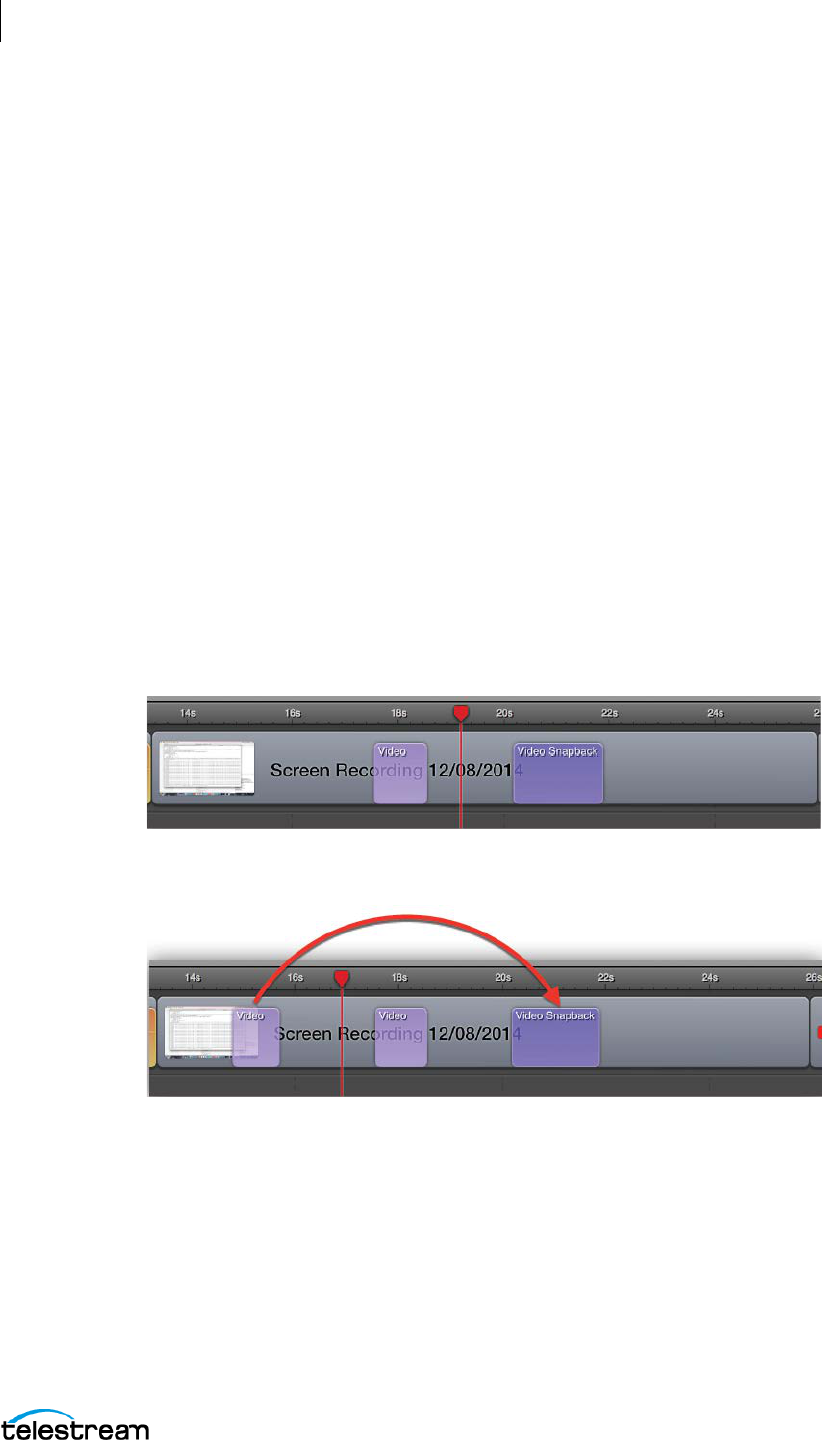
Media Editing
Editing in the Timeline
72
ScreenFlow User Guide
Labels
ScreenFlow enables you to color code clips in the timeline for quick navigation and
labeling. You can create labels from the Edit menu or by right-clicking the clip. One or
more clips need to be selected in the timeline for the Label menu item to be enabled.
When the Label menu item displays, click the desired color to identify the selected clips.
Click X to remove the color label from the clip(s). There are four colors available for
labeling.
Adding Snapback Action
Snapback actions are available for each of the three types of override actions: Video,
Audio, and Screen Recording. They behave like any other type of action. For example,
you cannot have two video (or video Snapback) actions occupying the same time
period. A snapback action will restore the state from before the previous action was
executed.
To add a Snapback Action, select Actions > Add Snapback Action, and select Video,
Audio, or Screen Recording.
In the example below, the values are restored from the clip itself, since there is no
action behind the Video action.
In this example, the Video Snapback reverses the previous action.
You can’t add a Snapback Action if there is no action to snapback to. If you try to add a
snapback action, ScreenFlow displays a warning.
Adding a Video or Audio Filter
ScreenFlow provides a vast array of filters. These add effects to video, still images, and
audio.
To add a filter to one or more clips, follow these steps:
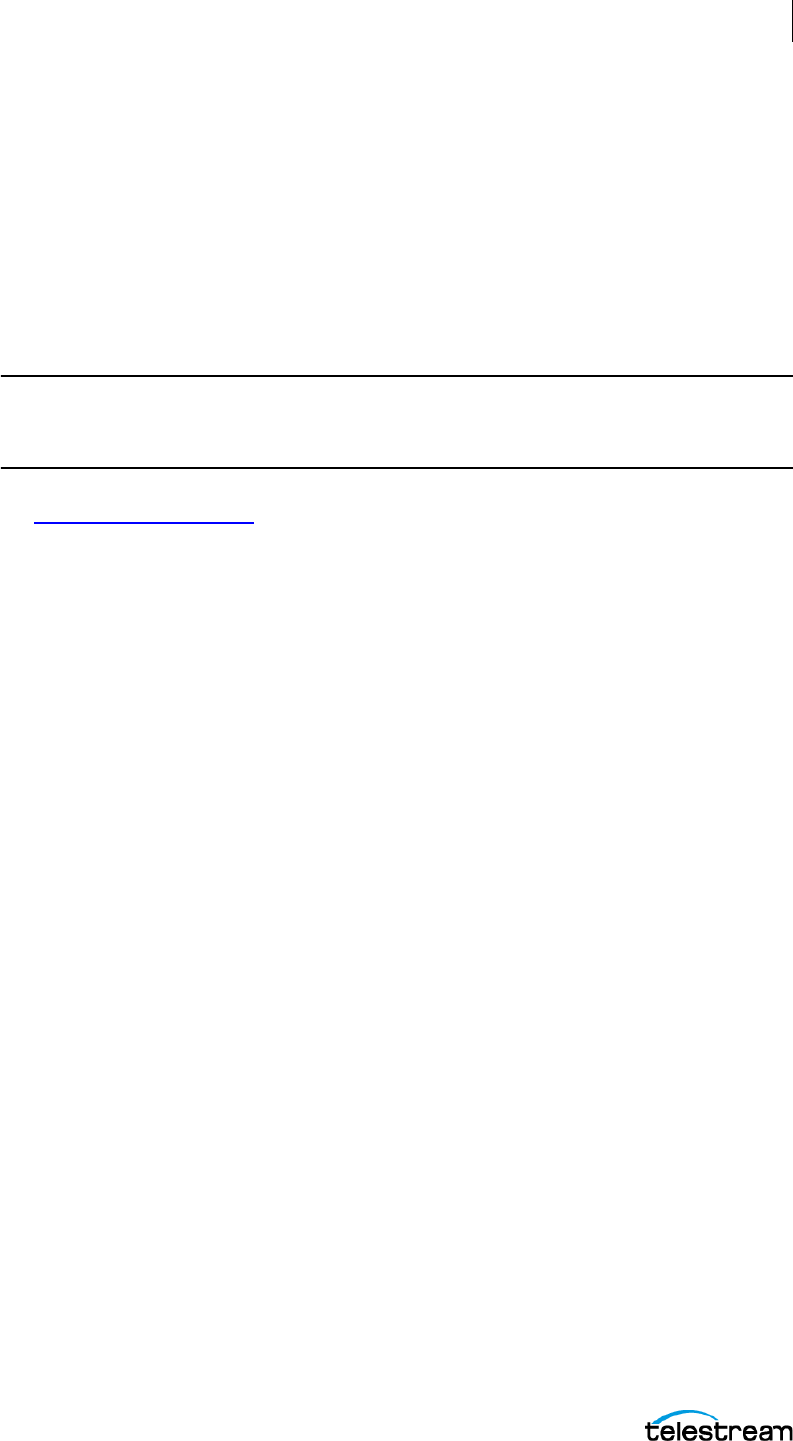
Media Editing
Editing in the Timeline
73
ScreenFlow User Guide
1. Select the video or audio clip that you want to add the filter to.
2. Select the Video or Audio properties tab, as appropriate.
3. Next to the Filters and Effects heading in the Video tab, or next to the Audio Filters
heading in the Audio tab, click the (+) button.
ScreenFlow displays the list of available filters.
4. Scroll through the list of filters. Alternatively, in the Audio tab, enter a filter name
into the Search field and press Enter.
5. Select a filter, and click Add to add it to the filter list for the selected clip.
Note: If a manufacturer's audio unit plug-in does not work in a “sandbox”
environment, it will not work in the Mac App Store version of ScreenFlow. Contact the
manufacturer of the audio plugin directly for information on plugin sandbox support.
See Video Filters and Effects
, The ScreenFlow User Interface, and The Properties Window.
Adding a Lookup Table (LUT) Video Color Filter
You can apply third-party video color filters supplied in CUBE-format lookup tables
(LUTs).
To add an LUT video color filter to one or more clips, do the following:
1. Select the video clip you want to add the filter to.
2. Select the Video properties tab.
3. Next to the Filters and Effects heading in the Video tab, click the (+) button.
ScreenFlow displays the list of available video filters.
4. Click the Import... button.
ScreenFlow opens a file browser.
5. Browse to the CUBE lookup-table file containing the desired filter. Select the CUBE
lookup table desired, and click Open.
6. Select the filter desired, and click Add.
ScreenFlow adds the LUT color filter to the filter list for the selected clip, and adds
the CUBE file to the list of available color filters.
7. (Optional) To adjust the settings of the LUT filter, in the Video properties tab under
Filters & Effects, check the box for Color Effects, select a style from the Style drop-
down menu, and drag the Intensity slider to adjust the intensity of the LUT color
effect.
Removing a Filter
To remove a filter that has been added to a clip, follow these steps:
1. Select the clip that you want to remove the filter from.
2. Select the Video or Audio properties tab, as appropriate.
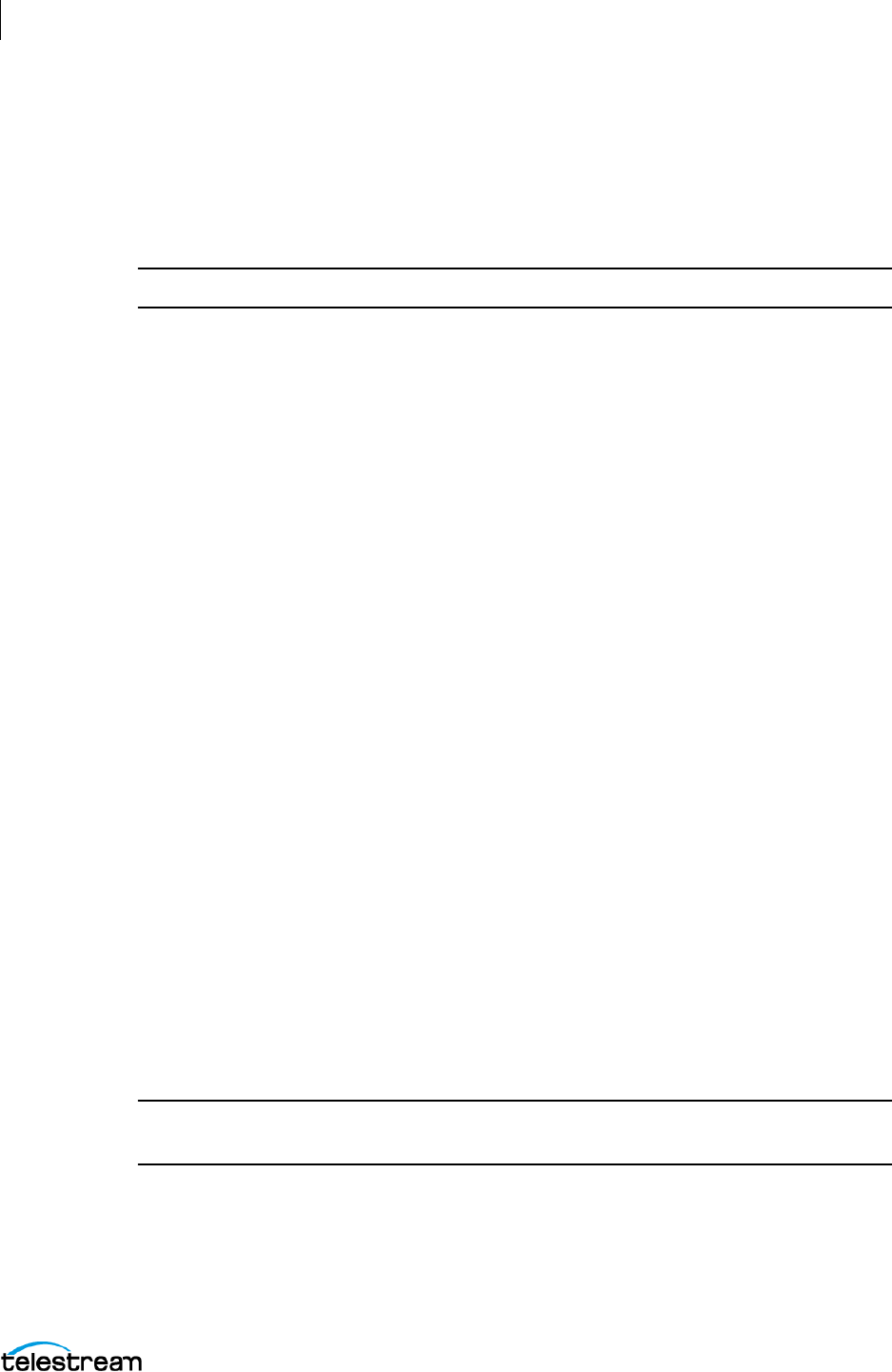
Media Editing
Editing in the Timeline
74
ScreenFlow User Guide
3. To display the filters, click the Filters & Effects triangle on the Video properties tab, or
click the Audio Filters triangle on the Audio properties tab.
4. Scroll through the list of filters on the clip until you find the one you want to delete.
5. Select the filter, and click the Filter Delete (x) button.
ScreenFlow deletes the filter from the clip.
Note: You can disable a filter temporarily, by unchecking its name.
Re-ordering Filters
A filter has different effects, depending on where it is stacked in relation to any other
active filters. Filters are applied in list order, from top to the bottom, of the list of filters
on the clip.
To set the order in which ScreenFlow applies the filters, do the following:
1. Select the clip that has the filters you want to re-order.
2. Select the Video or Audio properties tab, as appropriate.
3. To display the filters, click the Filters & Effects triangle on the Video properties tab, or
click the Audio Filters triangle on the Audio properties tab.
4. Scroll through the filters to identify the one you want to re-arrange.
5. Click on the grab icon just to the left of the checkbox by its name.
6. Drag the filter up or down the list to re-order its application in relation to other
filters in the list.
Configuring a Filter
Video filters that have a visual position coordinate display a cross-hairs button which
allows you to adjust the position on the canvas. The label of the parameter you are
editing also appears on the canvas when adjusting the position.
When multiple clips are selected, ScreenFlow attempts to display the list of filters in the
Video Properties tab where the filters have similar settings. For example, if two clips have
two identical filters in the same order, ScreenFlow will display the two filters regardless
of whether any of the individual parameters are the same. However, if the two clips
have the same filters but in different order, ScreenFlow displays a Multiple Filters
message.
Note: Filter processing is CPU-intensive. Expect export and publishing times to
increase with the number of filters enabled.
After you configure a filter, you can test it out by playing the video.
To configure a filter, follow these steps:
1. Select the clip that has the filter you want to configure.
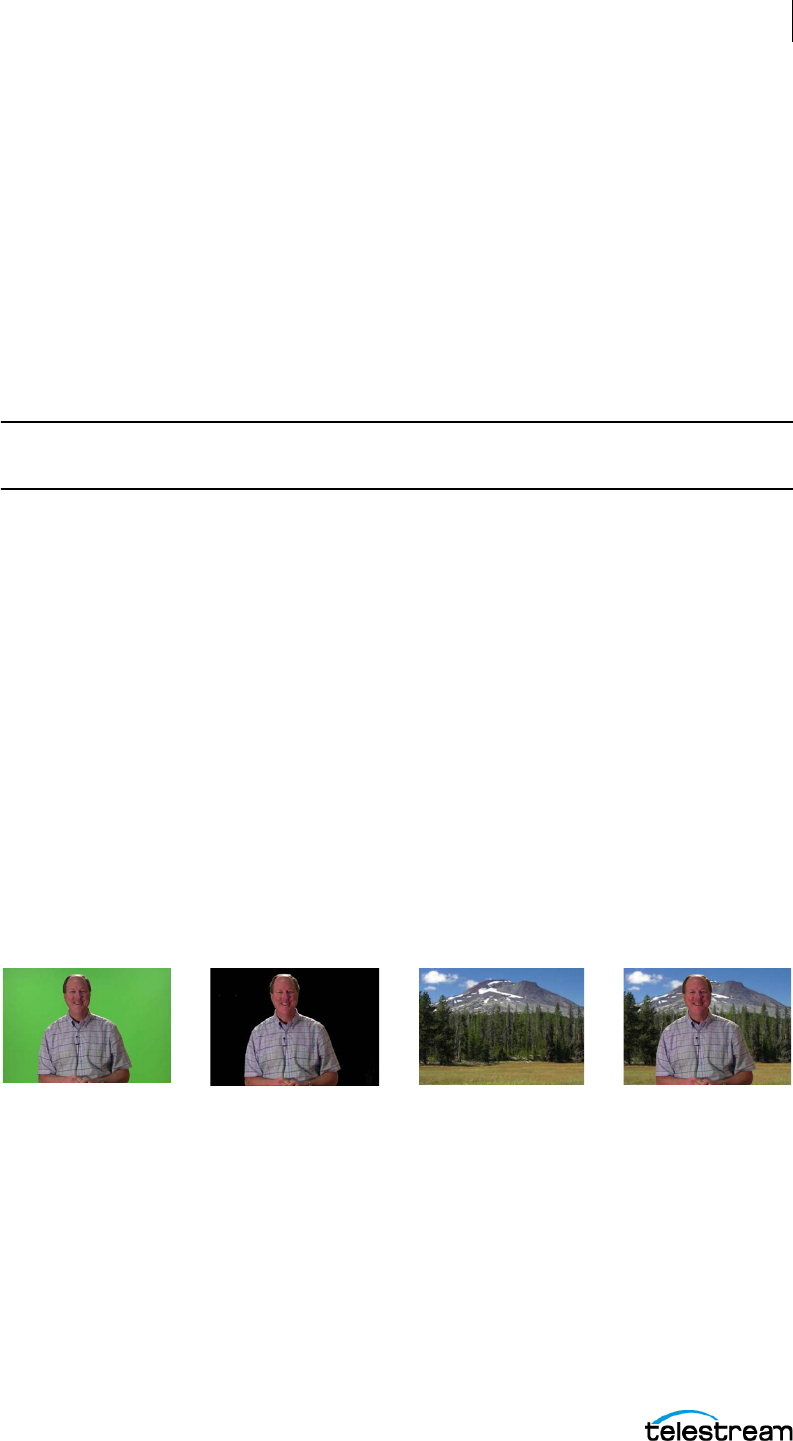
Media Editing
Editing in the Timeline
75
ScreenFlow User Guide
2. Select the Video or Audio properties tab, as appropriate.
3. To display the filters, click the Filters & Effects triangle on the Video properties tab, or
click the Audio Filters triangle on the Audio properties tab.
4. Scroll through the filters to locate the one you want to configure.
5. Adjust the controls as necessary.
Removing a Filter Background
You can remove a background from a ScreenFlow effect or from imported camera
video.
Note: You can’t remove backgrounds from screen recordings, which don’t have
ScreenFlow filters. Filters are not visible when screen recordings are selected.
To remove a background from an effect, do the following:
1. Select a video clip on the timeline, and navigate to
View > Switch to Inspector > Video > Filters & Effects.
2. Click the Add button (+), select Background Removal, and click Add.
ScreenFlow removes the background from the selected clip.
The Chroma Key Filter
The chroma key video filter creates transparency in a selected clip, based on a unique
color. ScreenFlow makes all pixels of the key color transparent. Clips in tracks lower
than the chroma key clip show through the transparent areas of the chroma key clip.
For example, if you chroma-key a shot of a weatherman standing in front of a green
screen, you can make a shot of a weather map appear in the green areas.
Figure 2. Typical Chroma Key Filter Application
Green and blue are the two most commonly used colors for chroma keying because
people don’t have much green or blue in their skin or hair color. However, for special
purposes, you can key on colors other than green or blue.
For best results, light the background screen brightly and evenly, and make sure the
talent isn’t wearing anything that matches the background screen.
Original clip Green color keyed out Background - 2nd track Final composite clip
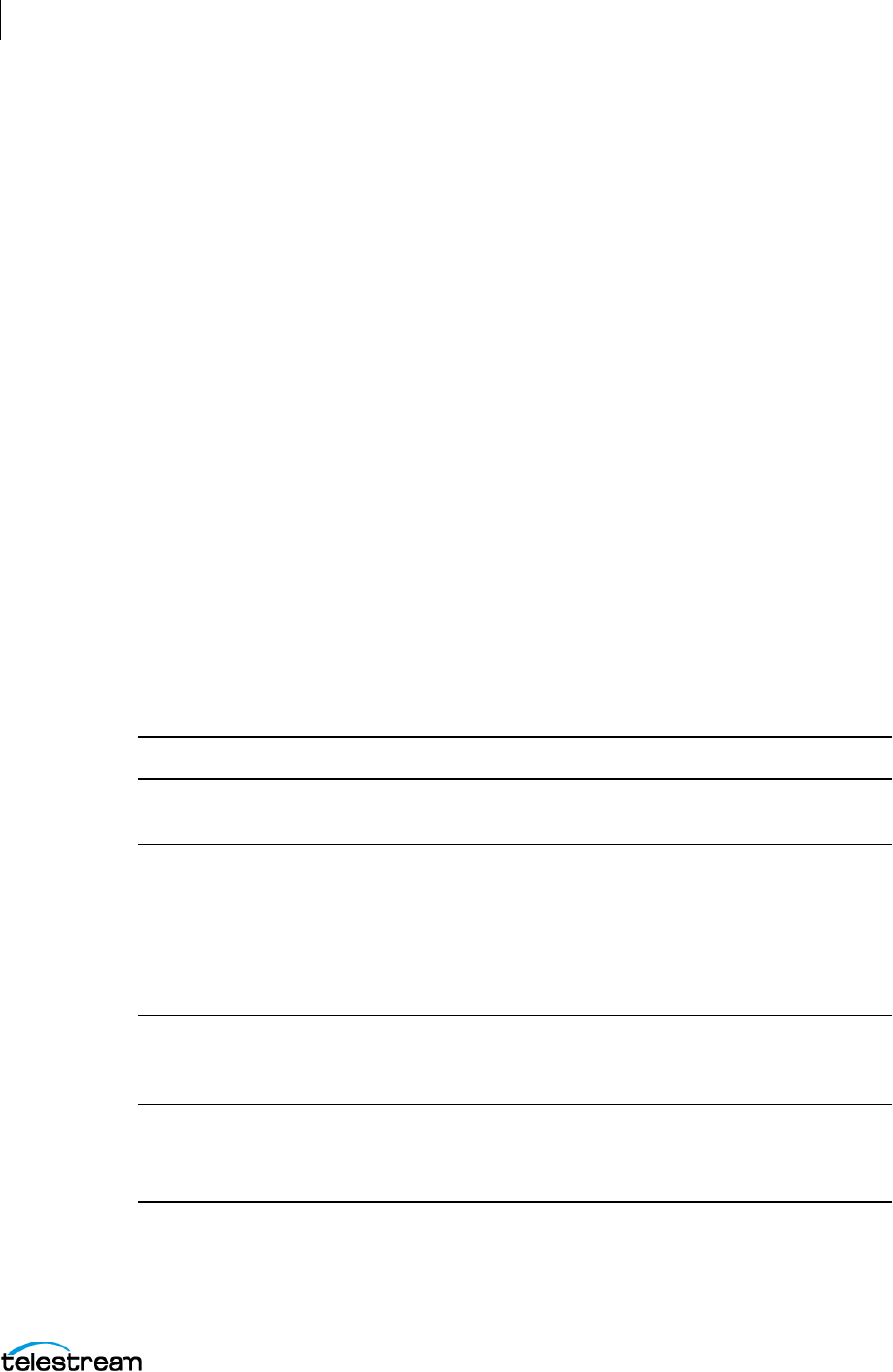
Media Editing
Editing in the Timeline
76
ScreenFlow User Guide
Chroma Keying a Clip
To chroma key a clip, do the following:
1. Shoot your subject against a chroma key screen.
2. Shoot your background image or clip.
3. Add these clips to your document.
4. Select a background color on the canvas for chroma key testing.
5. Add the Chroma Key filter and set it up.
See Chroma Key Filter Settings.
6. Test your clip by previewing it, and adjust chroma key settings as necessary.
See Refining the Chroma Key Filter Settings
7. If necessary, split your clips. Then, add and adjust the chroma key filter.
8. When you’re satisfied with the chroma key, add your background image or clip to
the screencast in the track immediately below the target clip.
Chroma Key Filter Settings
Settings for the Chroma Key filter are described in the table below.
For details on adding filters, see Video Properties.
Adjust the Chroma Key settings as needed. For details, see Selecting a Chroma Key Color.
Table 1. Chroma Key Filter Settings
Menu Item Description
Color Click to refine the key (to specify the color to be converted to
transparency. See Selecting a Chroma Key Color.
White Clip Use the slider to adjust the whiteness tolerance to reduce
white pixel transparency. Adjust the gray scale value (0 to
255) to the right, until the entire background is transparent.
In a source with lots of very bright white, the background may
bleed through the white part of the image. To avoid this,
adjust the White Clip value.
Tolerance Use the slider to specify how far from the chroma key color is
considered background. Adjust to remove more or less of the
background color without affecting the foreground image.
Angle Use the slider to specify the angle around the chosen color.
The amount of color varies, depending on how far from the
center of the color space the selected color is.
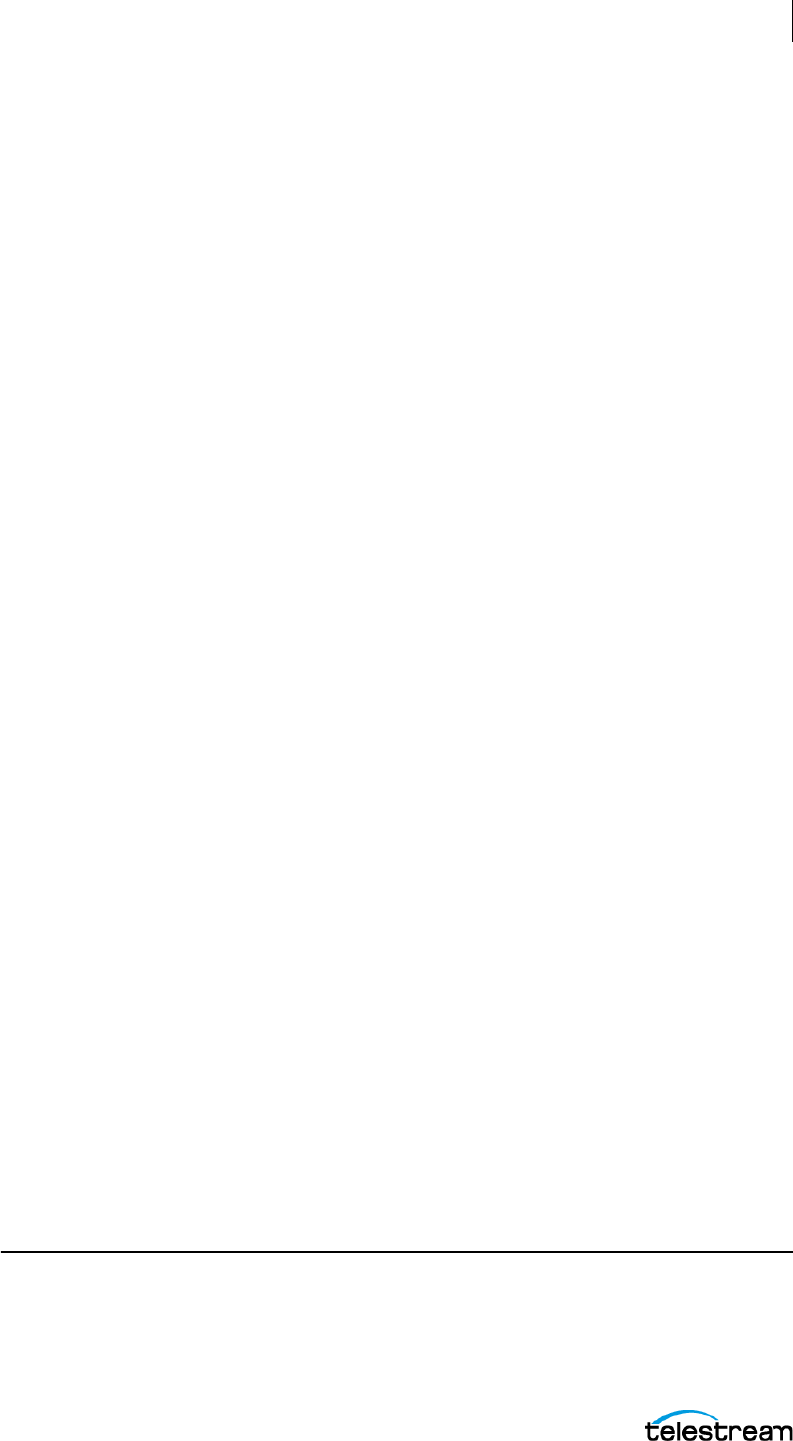
Media Editing
Editing in the Timeline
77
ScreenFlow User Guide
Selecting a Chroma Key Color
It ‘s important to choose the correct color for the chroma key. The color should match
or closely match the background. ScreenFlow selects the color displayed in the box by
analyzing the current frame. Sometimes this is not the best color.
To select the chroma key color, do one of the following:
• Click the desired color in the original image.
It's often best to click next to the edge of an object that is not going to be removed.
The color near the object is often the most effective chroma key color.
• Click the Color button to open the Refine Key window in the upper right corner of
the Canvas window.
Use the Refine Key image to refine the key as required.
When the Refine Key window is open, you can click anywhere in the clip image on
the canvas to select a new color.
• Click directly in the Refine Key window to adjust the selected color.
The Refine Key color range displays the colors that are near (in value) to the cur-
rently selected color.
The Refine Key window does not display all colors in the image.
Refining the Chroma Key Filter Settings
You can find the most effective chroma key settings by adjusting all three parameters,
viewing results over time, and adjusting them again. Here’s a suggested pattern of
refinement:
1. Temporarily move your background or image clip out of the way, so that the canvas
color can be used as a backdrop against your foreground image.
2. Next, adjust the White Key value by dragging the slider from left to right.
As the opaque area shrinks, pay close attention to the edges of the foreground
image.
3. (Optional) If the background starts showing through, creating a shadow, drag the
Tolerance level to the left. This eliminates the shadows around the edge.
4. Then, return to the White Key parameter and completely eliminate the opaque
areas so that the entire background is fully transparent.
5. Switch back and forth adjusting the White Key and Tolerance sliders to strike a
perfect balance as you scrub your clip.
6. Finally, reduce the Angle slider value to zero. Move the slider to the right until the
background is completely transparent.
7. Scrub the clip to make sure the chroma key works well across the entire clip.
Note: Sometimes the color of a background varies over time. A clip might need
different keys in different sections. To add different chroma keys to a clip, split the
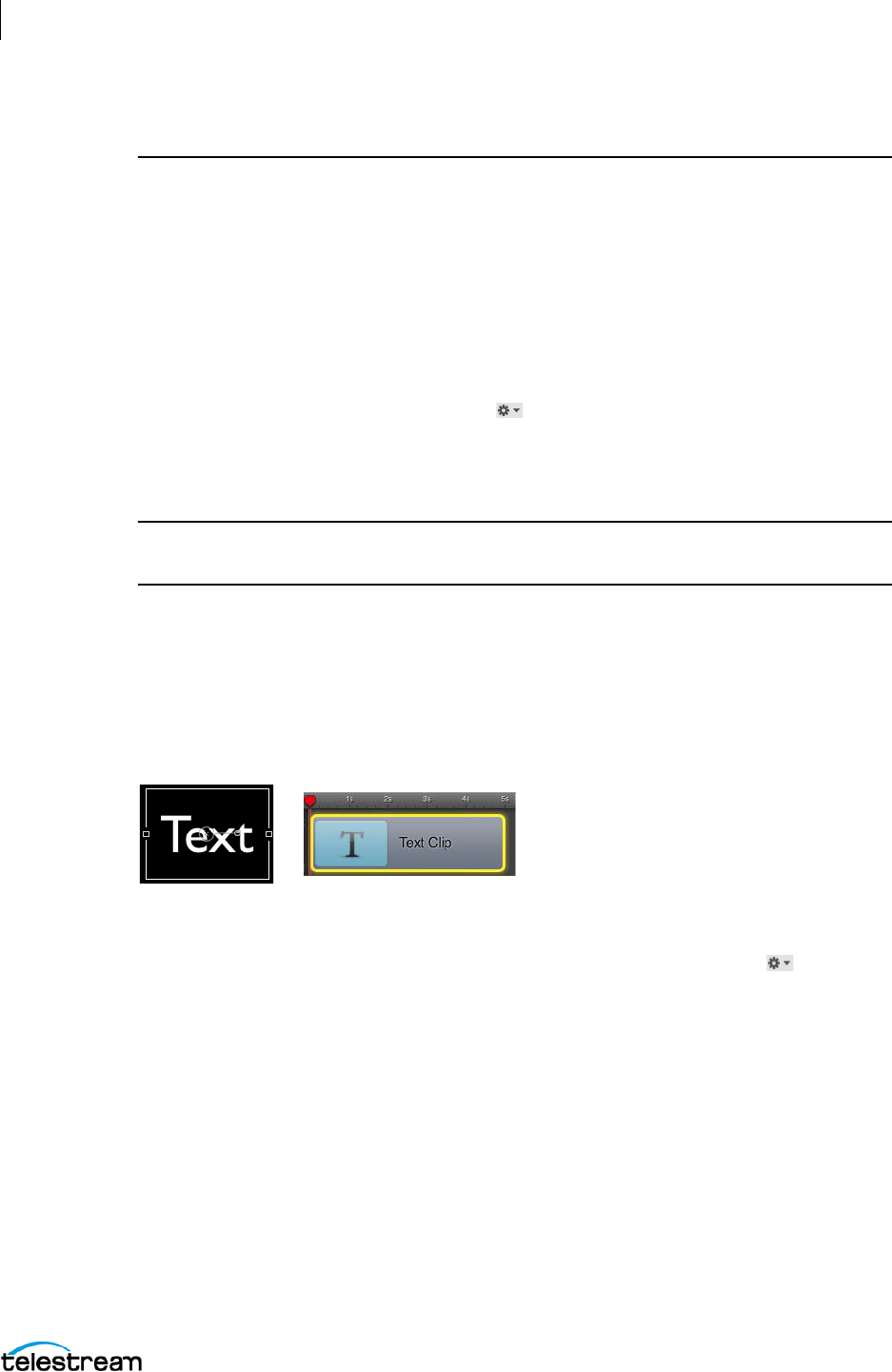
Media Editing
Editing in the Timeline
78
ScreenFlow User Guide
source clip into several clips. Then apply a slightly different key color to each of the
clips.
Adding and Configuring a Text Clip
To display the Text Properties tab, click the Text Properties icon in the Properties window.
See Text & Titles Properties.
To add a text clip, do the following:
1. Place the scrubber at the location where you want the clip to start.
2. Click Add Text Box, click the gear icon on the Text Properties tab and select Add
Text Box, or select Insert > Text Box.
ScreenFlow adds a five-second text clip in a new, top track (which you can move
anywhere on the timeline).
Note: To change the default duration of your Text clip, go to
ScreenFlow > Settings > Timeline.
ScreenFlow creates a text clip with the word Text in it.
3. Select the text to edit it.
You must have at least one character in the clip, or ScreenFlow automatically
deletes it. If you later remove all text, ScreenFlow deletes the clip automatically.
Figure 3. Sample Text Clip on Canvas (left) and Timeline (right)
4. With the text selected, adjust the text properties.
5. To reset all properties in this tab to default values, click the gear icon and select
Reset to Defaults. ScreenFlow applies the settings for Make Settings Default for New
Text Clips.
For descriptions of the Text & Titles controls, see Text & Titles Properties.
Formatting Text and Titles
You can design on-screen text, determining font, color, animation, and more, with the
controls in the Text & Titles tab of the Properties window.
To format text or titles, do the following:
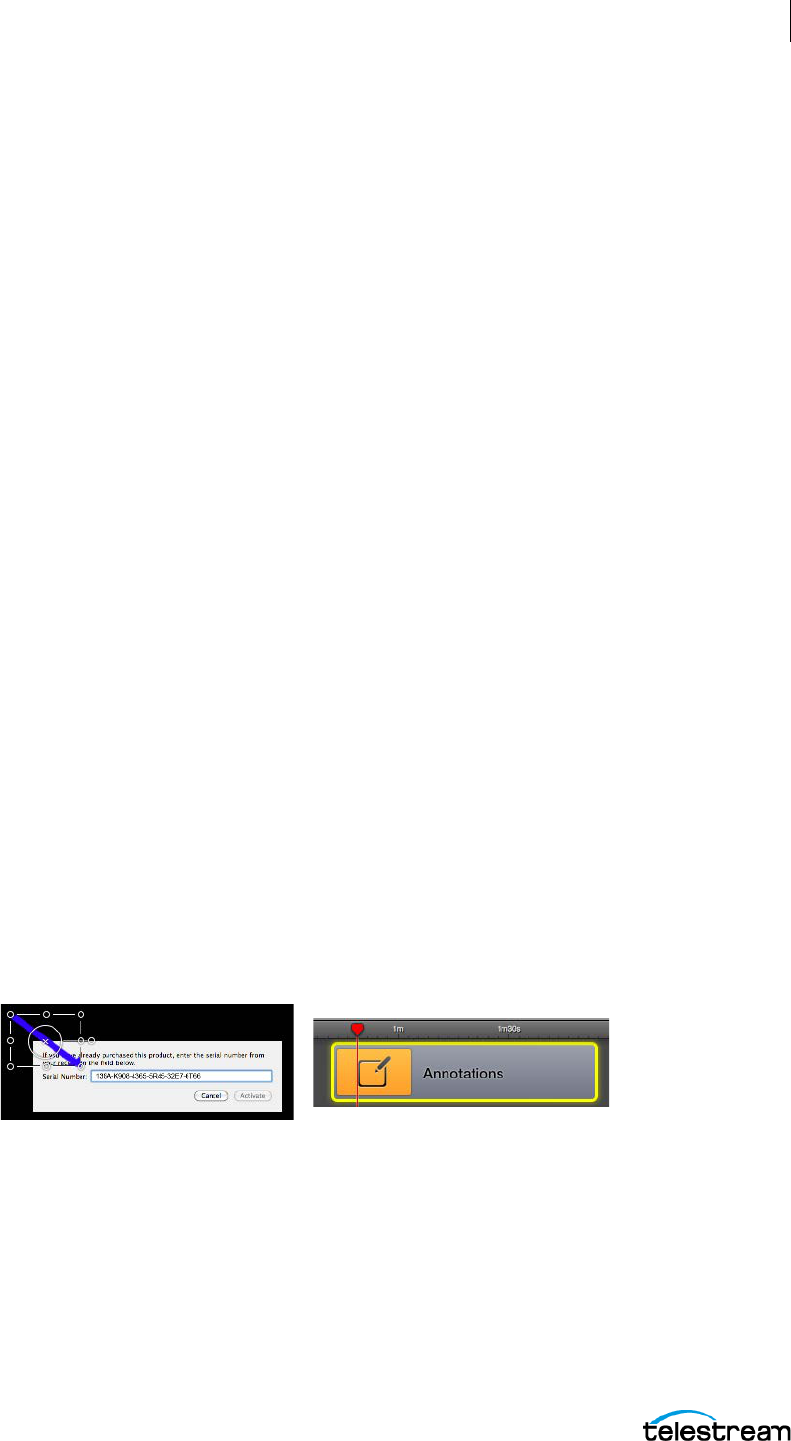
Media Editing
Editing in the Timeline
79
ScreenFlow User Guide
1. On the Canvas, select a text box containing text. On the Properties window, click
the Text & Titles tab.
See The Properties Window.
2. Use the controls in the Text & Titles tab to customize the text.
For descriptions of the Text & Titles controls, see Text & Titles Properties.
Animating Text
To animate text within a text box, do the following:
1. Create a text clip.
See Adding and Configuring a Text Clip.
2. Select the text box, or a range of text within the text box.
3. On the Properties window, select the Text & Titles tab.
See The Properties Window.
4. Check the box for Build In Animation, and select the animation settings desired.
See Build In Animation checkbox in Text & Titles Properties.
5. Check the box for Build Out Animation, and select the animation settings desired.
See Build Out Animation checkbox in Text & Titles Properties.
Adding an Annotation Clip
To add an annotation clip, set the scrubber in the location where you want the clip to
start, and click the Add icon (+). ScreenFlow adds a five-second annotation clip in a
new, top track (which you can move anywhere on the timeline you want).
When you create an annotation clip, you must immediately add at least one object to
the clip, or ScreenFlow will automatically delete it. As a matter of fact, if you later
remove all annotations, ScreenFlow deletes the annotation clip automatically.
Figure 4. Sample Annotations Clip on Canvas (left) and Timeline (right)
Adding and Configuring Annotation Items
To add annotation items to an annotation clip, follow these steps.
1. Select the clip to which you wish to add an Annotation.
2. Choose the Annotations Property tab.
3. Choose an Annotation Object from Tool Palette.
4. Adjust object on canvas to desired effect.
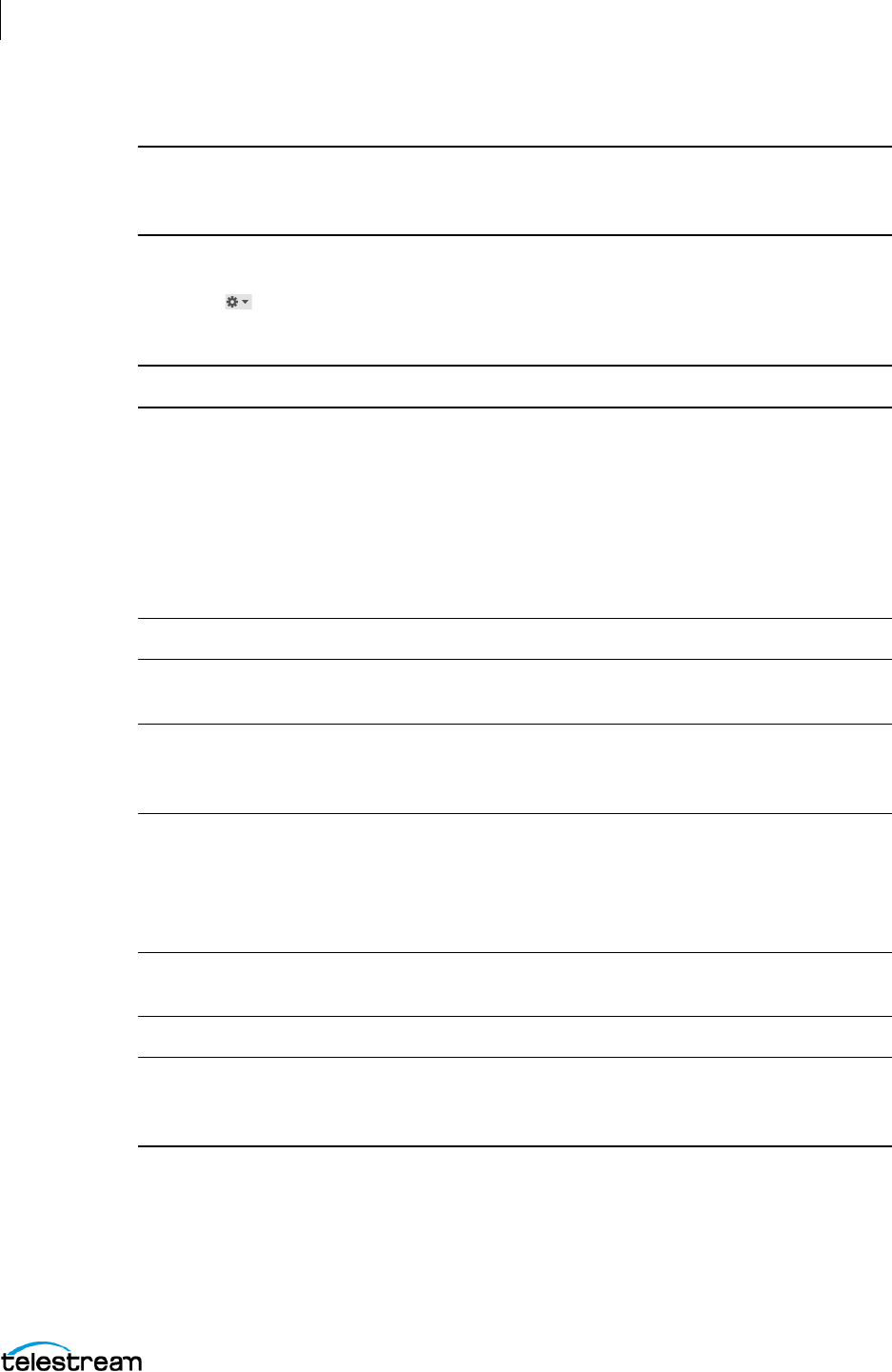
Media Editing
Editing in the Timeline
80
ScreenFlow User Guide
While selected, you can adjust the item’s properties.
Note: Notice that as you are drawing, the timeline loses focus and darkens. Drawing is
a modal operation: When you’re done drawing and configuring objects, you must click
on the timeline to continue working on the canvas or timeline.
To save these settings for new annotations clips you may add in the future, click the
gear icon and select Make Settings Default.
See Annotations Properties.
Table 2. Annotations Properties Controls
Control Description
Shapes Choose from the types of annotations in the tool bar:
• Line (arrow)
• Line
• Square (filled)
• Square
• Circle
Color Click to select the color of the annotation.
Opacity Use the slider (or enter the percentage value manually) to set
the opacity of the selected object.
Thickness Use the slider or manually enter the value to specify the
thickness (in pixels) of annotation lines (range: 2 to 350).
Default: 55.
Shadow Check to create a shadow on objects in the annotation. Use
the slider or manually enter the value (in pixels) to specify the
opacity of the shadow (range: 1 to 60). Default: 25. The value
creates a gradual loss in opacity as the shadow spreads from
the center.
Outline Check to create an outline around objects in the annotation.
Use the slider to specify the thickness of the outline.
Color Click to select the color of the outline.
Endpoints Select a shape to affix to the end of a line segment. The first
and second field represent the starting and finishing point of
the line segment, respectively.
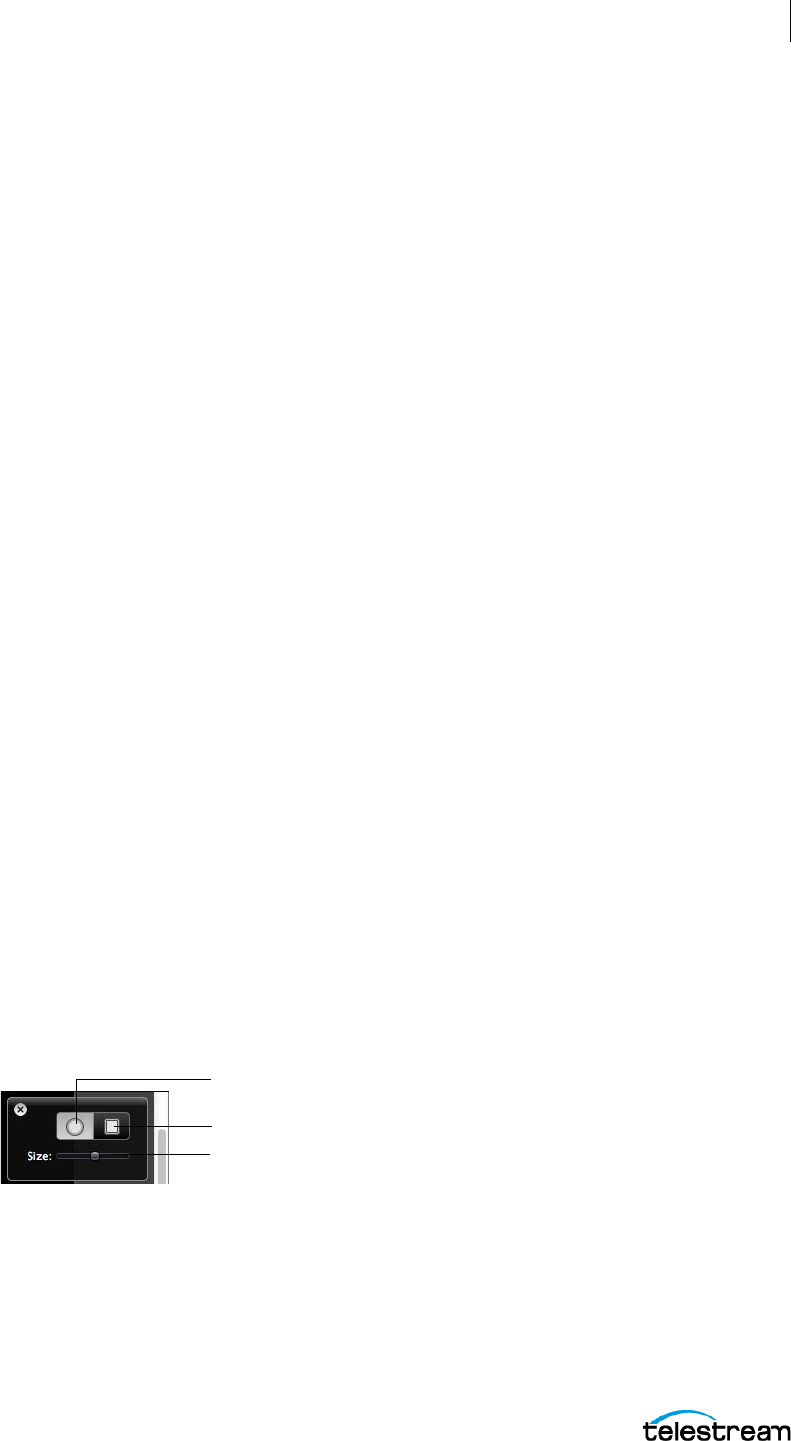
Media Editing
Editing in the Timeline
81
ScreenFlow User Guide
Adding Freehand Annotations
You can also create freehand annotations (freehand drawings accessible through the
existing annotation’s Inspector panel). This feature enables you to draw smooth and
accurate freehand lines and shapes, move and resize them, and change properties such
as: color, opacity, shadow, and outline.
To add a new Freehand Annotation, click the Freehand button on the Annotations tab,
then click the Add button (+) to place a freehand Annotation in the timeline.
Freehand annotations are stored as Bezier Curves, which are generated from a list of
mouse points. Freehand annotations are drawn like any other annotation type. Lines
are created by dragging the mouse along the canvas to draw lines.
One difference between Freehand Annotations and other annotation types is that
Freehand Annotations are not automatically selected when the mouse is released from
drawing. This prevents you from having to deselect a drawing each time you want to
create a new one. Another difference is that in order to select a Freehand Annotation,
you are required to hold down the Command Key. This is to prevent users from
selecting other freehand annotations while drawing.
Adding Freehand Callouts to Images
You can highlight freehand areas directly on images, using either a circular paint brush
or a rectangle tool. You can use freehand callouts to blur out sensitive data or create a
highlighted box around the content you are discussing, for example.
To create a freehand callout, follow these steps:
1. Set the location of the scrubber.
2. Select an image on your canvas.
3. Click the Callout Properties tab, click the + Action button, and click Freehand.
(Because you’re working on an image, Freehand is the only callout option.)
4. When ScreenFlow displays the tool palette in the upper right corner of the canvas,
select either the brush or the rectangle tool. If you select the brush, you can set the
size of the brush.
Figure 5. Freehand Callout Tool Palette
5. Draw the highlighted region on your selected image using your mouse. To
brush-on a highlighted area, select the brush tool, set the brush size, then click and
drag the mouse to define an area. To create a rectangle highlighted area, select the
rectangle tool, then click and drag the mouse to define an area.
6. Use the callout properties to adjust the look of your callout.
Brush tool
Rectangular tool
Brush size adjust

Media Editing
Editing in the Timeline
82
ScreenFlow User Guide
7. To remove a brushed-on freehand callout, select the brush tool, then hold down
the Option key and the left mouse button while moving the mouse over the
highlighted area to erase it. To remove a rectangle freehand callout, select the
rectangle tool, then hold down the Option key and the left mouse button while
moving the mouse over the highlighted area to select it. When you release the
mouse button, the callout is removed.
Modifying Style with Style Presets
To create video style presets based on existing presets, do the following:
1. Click the Video tab in the Properties window.
See the Properties window on the screenshot in the topic, The ScreenFlow User Inter-
face.
2. Select a video in the timeline.
3. Click the Style Presets button at the upper-right of the tab to open the Style
Presets window.
ScreenFlow displays the Styles Presets window.
4. Click the plus (+) button to create a new style based on the current properties of
your video.
ScreenFlow displays the next setup window.
5. Select parameters to include in the new style preset.
6. Click the plus (+) button.
ScreenFlow displays the next setup window.
7. Rename the style preset from its default name.
8. (Optional) You can also update the preset or delete it by clicking on the gear icon to
open a drop-down menu.
Once you have created a list of style presets, you can associate them with any video by
selecting a video and choosing a style preset from the list.
Adding a Clip to the Media Library
To add clips to the screencast, you can drag clips from the Media Library onto your
canvas or timeline.
To add a clip to your media library, do one of the following:
• Record a source in ScreenFlow.
ScreenFlow records a media file, creates a clip associated with the media file, and
adds the clip to the document media library.
• Drag the media file from the Finder into the media library.
ScreenFlow creates a clip associated with the media file in the media library.

Media Editing
Editing in the Timeline
83
ScreenFlow User Guide
• Drag the media file from the Finder onto the timeline.
ScreenFlow creates a clip associated with the media file in the media library, and
adds the clip to the timeline.
• In the Media Library tab, click Add Media.
ScreenFlow displays a File System dialog. ScreenFlow creates clips in the media
library for media files you select.
Duplicating a Media File from a Clip
To copy the media file associated with a clip to the computer file system, drag the clip
from the Media Library out to your desktop, target folder or server.
MacOS duplicates the source media file in the new location.
Deleting a Clip from the Media Library
To delete a clip from your media library, do the following:
• Right-click the clip, and select Delete Media.
ScreenFlow deletes the clip from the Media Library. If this clip is used on the time-
line, ScreenFlow deletes the clip from the timeline as well.
Renaming a Clip in the Media Library
To rename a clip, do the following:
1. Select the clip.
2. Click on the clip name, and enter a new name.
ScreenFlow renames this clip wherever it appears on the timeline, except in those
instances where the clip has a custom name.
Relinking a Clip to a Media File
Moving or renaming a media file breaks the link between the file and the clip in your
ScreenFlow document. To relink the file to the clip, click the relinking button.
Previewing a Clip in the Media Library
To preview a clip before placing it on the timeline, hover the cursor over the clip.
ScreenFlow displays a scrubber for previewing the clip before adding it to the canvas or
timeline.
Navigating the Media Library
To display the media library, click the Media Library tab in the Properties window.
See Media Library.

Media Editing
Editing in the Timeline
84
ScreenFlow User Guide
You can also view the Media Library on the left side of the ScreenFlow main window.
Finding Clips with the Media Library Filter
You can find clips by filtering the media library to show only certain types.
To select a filter, do the following:
1. Click the Filter button.
ScreenFlow opens the Filter window.
2. Click a filter to open its menu and select a type.
ScreenFlow displays all clips matching the selected type.
Finding a Clip Using Media Library Search
You can search for any text in the clip name by entering a text string in the search field.
The list of clips changes as you type.
Adding a Clip to the Timeline
To add a clip to your timeline, do one of the following:
• Drag the clip from the Media Library to either the canvas or to the timeline.
• Double-click on the clip to add to the timeline at the scrubber location.
ScreenFlow places the selected clip at the location of the scrubber in the timeline.
Note: You can select one or more clips using lasso selection. Click and drag across
some portion of each clip to select it.
For complete details on these and other ways to add clips to your document, see
Editing Clips.
Deleting All Unused Media
At the completion of a project, you might have clips in a ScreenFlow document that
you haven’t used in the timeline. These unused files make your ScreenFlow document
unnecessarily large. To delete such orphaned media sources from the Media Library, do
the following:
1. Click the Media Library tab.
See the Properties window in the screenshot of the ScreenFlow user interface in the
topic, The ScreenFlow User Interface.
2. Click the gear button.
ScreenFlow opens a drop-down menu.

Media Editing
Editing in the Timeline
85
ScreenFlow User Guide
3. Select Remove All Unused Media.
ScreenFlow displays a list of unused media.
4. Click Delete to delete all the unused sources from the Media Library.
Adding Media to the Global Library
You can store media files in the global library for use in any number of ScreenFlow
documents.
1. Select the Media Library tab in the Properties window.
See Media Library.
2. Click the globe button.
3. Do one of the following:
• Drag and drop media files into the global library panel
• Click the plus (+) button, navigate to a file and select it
Once you’ve added content to the global library through one inspector panel, the
content appears in the global library of all ScreenFlow documents.
ScreenFlow stores global library contents here:
~/Library/Application Support/ScreenFlow/GlobalLibrary
ScreenFlow creates a hard link from the original content to the Global Library folder.
Deleting Media from the Global Library
1. To delete an item from the global library, do one of the following:
• Right-click on the file icon, and select Delete Media.
• Select the file icon and press the Delete key.
ScreenFlow warns you that other ScreenFlow documents might reference the file
you want to delete.
2. Click Delete or cancel the operation.
When ScreenFlow deletes the item, ScreenFlow deletes the file in the global library.
Purchasing the Stock Media Library
To access the Stock Media Library, you first must purchase it. To purchase the Stock
Media Library, do the following:
1. Select File > New.
ScreenFlow opens the New dialog.
See The New Dialog.
2. Click the Stock Media Library tab.
3. Click Buy to purchase the Stock Media Library.

Media Editing
Editing in the Timeline
86
ScreenFlow User Guide
Importing a Stock Media File
You can query, filter, and preview all of the content in the Stock Media Library. However,
to add clips from the Stock Media Library to a ScreenFlow document, you must
purchase the Stock Media Library.
To import files from the Stock Media Library, do the following:
1. Click the Media Library tab on the inspection panel.
2. Do one of the following:
• Click the Stock Media button.
• Enter a search term into the Search field at the bottom of the Media Catalog win-
dow.
ScreenFlow populates the Stock Media Library as you enter your search term.
3. Select the stock media file desired.
4. Do one of the following:
• Right-click on any stock media icon to access its menu. From this menu, choose to
add the stock media file to the timeline at the scrubber position, add the media to
the Global Library, or download different format versions of the media.
Stock media video comes in these formats: HDMP4, 4KMOV, HDMOV, and 4KMP4.
Stock media audio comes in these formats: WAV and MP3. Stock media still images
come in these formats: PNG and JPG.
• Drag and drop the clip onto either the timeline or the canvas.
ScreenFlow creates a temporary clip in the timeline until it fully downloads the
media file. A spinner shows the download progress. Once the download is com-
plete, ScreenFlow replaces the clip’s temporary source with the newly-downloaded
source. If you delete the clip before the download is done, ScreenFlow cancels the
download.
Previewing a Stock Media File
You can preview any stock media clip by scrubbing or playing the clip. To preview a
stock media clip, select a clip, and do one of the following:
• Move the scrubbing slider.
• Click the Play button.
Displaying and Previewing Closed Captions
You can use the ScreenFlow caption editor to add, edit, and publish ADA-compliant
soft subtitles as caption tracks to a screencast (Figure 6).
You can include captions in MPEG-4 outputs, and in outputs for YouTube. You can
create caption tracks in multiple languages. Also, you can export captions as SRT
subtitle files.
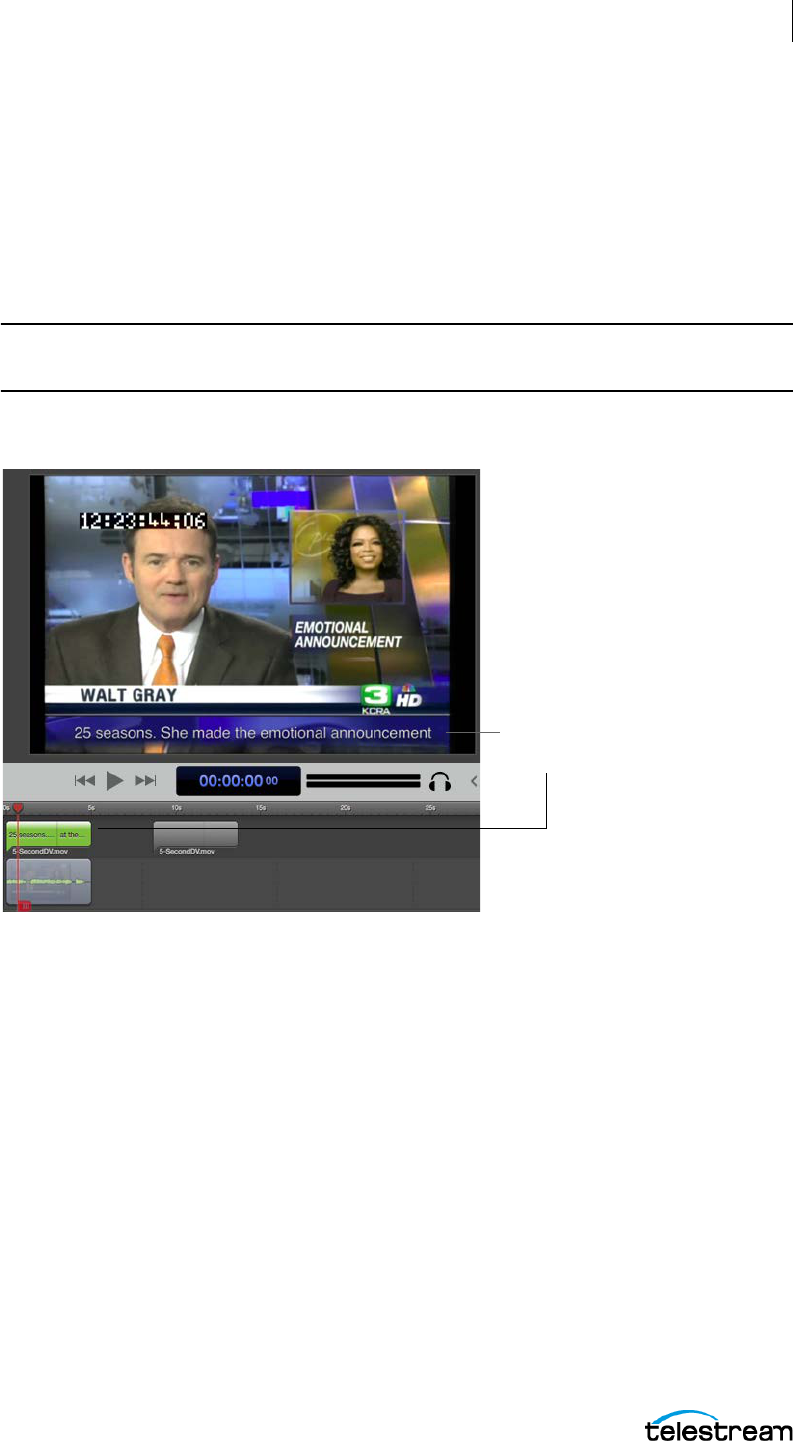
Media Editing
Editing in the Timeline
87
ScreenFlow User Guide
Caption clips are permanently joined to their parent clips, and are the same length as
their parent clips. You can’t move caption clips independently. When you move, copy,
or delete a parent clip, you move, copy, or delete the caption clip with it.
Caption clips contain one or more caption boxes, each one lasting three seconds. The
number of boxes depends on the total duration of the parent clip. You can adjust the
durations of the caption boxes. The caption boxes contain the text to display. Click each
caption box independently to add text.
Note: To view closed captions in a movie player, you must enable closed caption
viewing. Enabling closed caption viewing in players is beyond the scope of this guide.
Figure 6. Screencast with Closed Captions
Closed caption text is rendered on-screen in white, sans-serif type, centered at the
bottom of the screen.
To display closed captions on the canvas, select View > Show Captions. As you scrub or
preview the screencast, ScreenFlow displays closed captions on the canvas along with
all other visual elements in the screencast.
Adjusting Video to Accommodate Caption Text
To provide a suitable background on which to display caption text clearly, use black or
another dark background color, and consider using one of the following techniques:
• Shorten the computer video frame vertically to create an empty rectangle at the
bottom. (This creates a minor distortion in the image.)
Captions are rendered on the
frame from the text you enter
in caption clips.
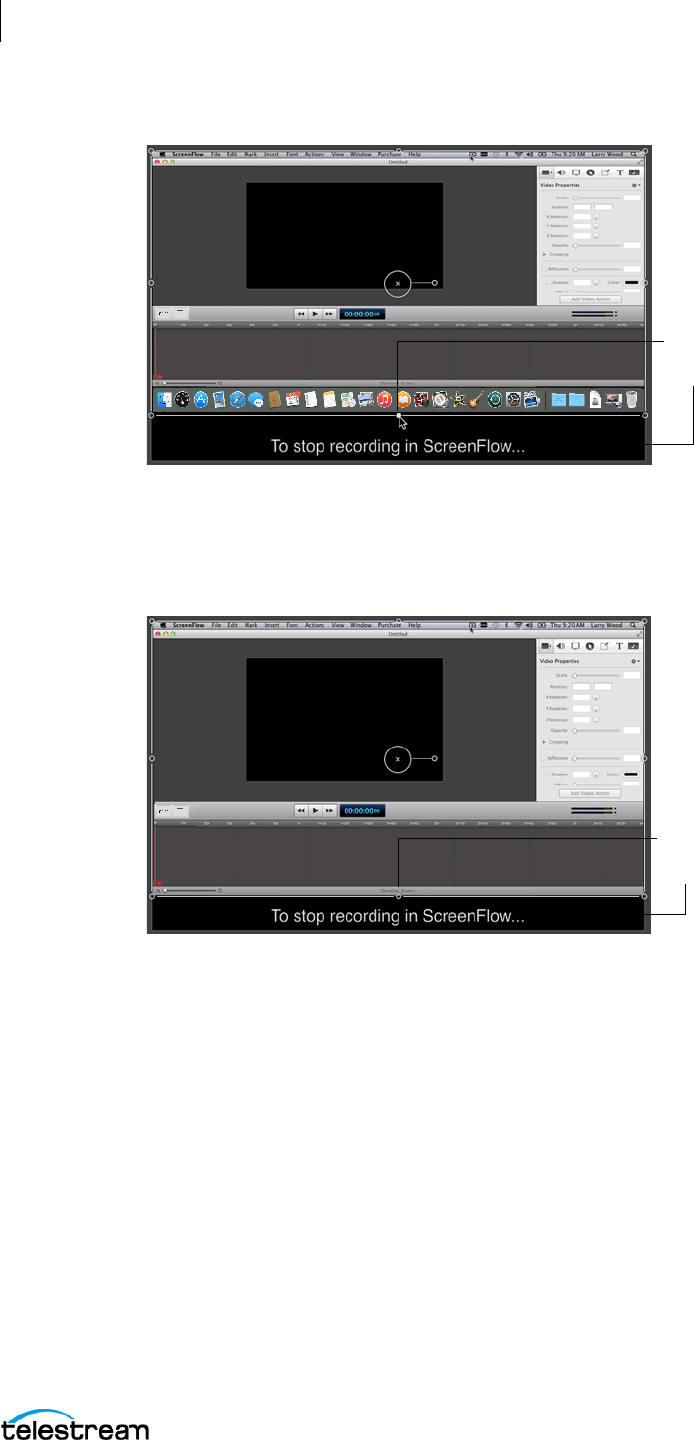
Media Editing
Editing in the Timeline
88
ScreenFlow User Guide
Figure 7. Shortening Video Frame Up for Captions
• Crop the computer video frame upward (Figure 8)—preserving the application
window, but hiding the dock bar at the bottom. (This doesn’t distort the image.)
Figure 8. Cropping Video Frame for Captions
• Reduce the frame proportionally (Figure 9), positioning it at the top center of the
canvas.
You can leave the canvas as-is—with pillars on each side of the frame—or shorten
the canvas horizontally to eliminate the pillars.
Shorten video frame
upward to create space for
closed caption text.
Crop bottom of video
frame to create space for
closed caption text.
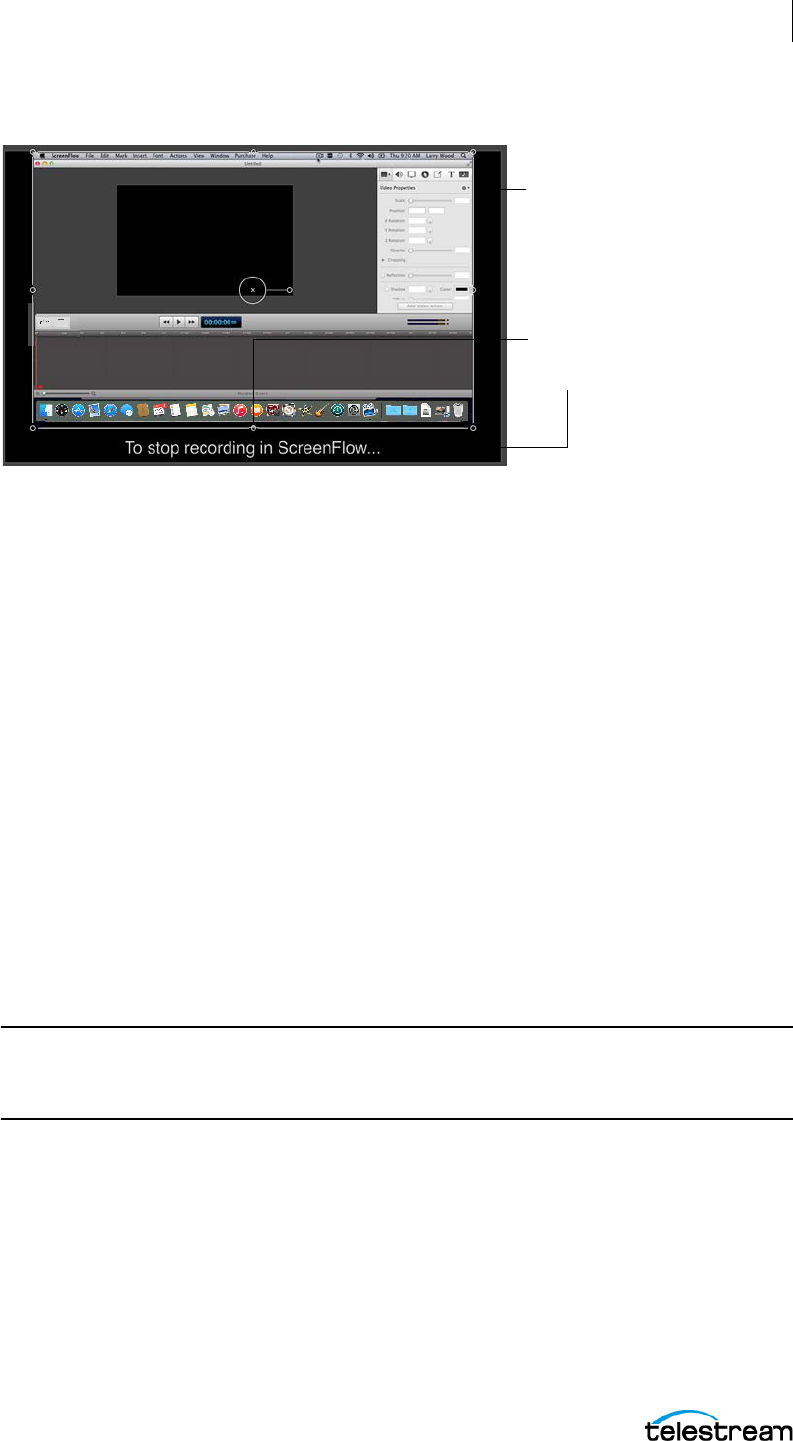
Media Editing
Editing in the Timeline
89
ScreenFlow User Guide
Figure 9. Shrinking Video Frame for Captions
Viewing Closed Captions
To view closed captions, select View > Show Captions Track.
ScreenFlow displays the caption track at the top of the timeline. Each clip on the
timeline with an audio track has a corresponding caption clip. ScreenFlow can show
only one caption track at a time.
If there is more than one audio clip in the screencast at the same time (for example, a
voice-over and a music bed), ScreenFlow displays the audio clip on the highest track.
Navigating Caption Boxes
To move between caption boxes, do one of the following:
• Press the left and right arrows in the caption playback controls.
• Press the tab key to advance to the next box and use Shift-tab to go to the previous
box.
The scrubber jumps to the beginning of the next (or previous) box, and displays its
text, so you can add or edit it.
Note: When transitioning to the next caption, captions with a duration of 0.9 seconds
or shorter get skipped over. Transitioning jumps only to captions that are one second
or longer in duration.
Editing Caption Text
To edit text in a clip’s caption box, do the following:
1. Click the target box.
ScreenFlow displays the caption editor, where you can enter text and test it for
appropriate time length, adjusting the length as necessary.
Reduce video frame to
create space for closed
caption text.
Leave pillars or reduce
canvas size horizontally to
remove them.

Media Editing
Editing in the Timeline
90
ScreenFlow User Guide
2. (Optional) To display closed caption text on multiple lines, press Enter to add line
returns.
Changing Caption Display Time
Do one of the following:
• To lengthen the display time of a caption box, press Command-up arrow.
• To reduce the display time of a caption box, press Command-down arrow.
You can also change the time in the caption editor.
Deleting All Text from Captions
To delete all of the text in all captions, do the following:
1. Control-click a caption box.
2. Do one of the following:
• Select Clear All Captions
• Select Edit > Captions > Clear All Captions.
Setting the Caption Language
To set the caption language, do the following:
1. Control-click on the caption box.
2. Do one of the following:
• Select Set Language
• Select Edit > Captions > Set Language.
3. Select the language you want to display captions in.
Generating Closed Captions
You can generate closed captions when exporting or publishing in these formats:
• Export the screencast as an MP4 (H.264 video) file. Select the Web-High or Web-
Low preset or any Apple device preset, or a customized derivative. You’ll need to
check Add Captions Track on the export window.
For details, see Video Encoding.
• Publish the screencast to YouTube. You’ll need to check Add Captions Track on the
export window.
For details, see Publishing to Video Hosts.
• Export with burned-in captions. To do this, check the Burn In Captions checkbox,
under Options in the Export window.

Media Editing
Editing in the Timeline
91
ScreenFlow User Guide
Exporting Closed Captions as SRT Subtitles
To export your closed captions into an SRT subtitle file, do the following:
1. Control-click on the timeline.
2. Select Export to SRT or Edit > Captions > Export to SRT.
ScreenFlow displays a Save As dialog.
3. Name the file, select a location, and save the file.
Importing Closed Captions as SRT Subtitles
To Import an SRT file, do the following:
1. Select Edit > Captions > Import from SRT.
2. Pick the SRT file you wish to import.
3. In the file dialog window, select the language of the caption file.
ScreenFlow parses the imported SRT file and generates captions for each entry. If there
are any existing captions for the imported language, ScreenFlow clears them before the
import. The import always overwrites any existing captions and does not merge them.
If there are any gaps in time between captions in the imported SRT file, ScreenFlow
inserts spacer captions to keep the captions in sync. ScreenFlow imports the captions
into the first audio clip on the timeline. If the captions are longer than the clip,
ScreenFlow doesn’t split them onto other audio clips.
Adjusting Recorded App Audio
If you have configured ScreenFlow to record computer audio, the Audio Properties tab
displays controls for Recorded App Audio. You can set volume levels for each app
individually using these controls. To set app volume levels, do the following:
1. Check the box near the name of each app you want to control.
2. To set the volume of an app, drag and drop the slider for the app to the desired
level.
See Audio Properties.
Reducing Background Audio Volume (“Ducking”)
To enable ScreenFlow to automatically reduce the volume of background audio under
narration (ducking), do the following:
1. In the Properties window, select Audio Properties.
2. Check the box for Ducking.
3. Select narration clip(s).
ScreenFlow highlights narration clips with a yellow border.
4. Select the Audio Inspector tab in the properties inspector.
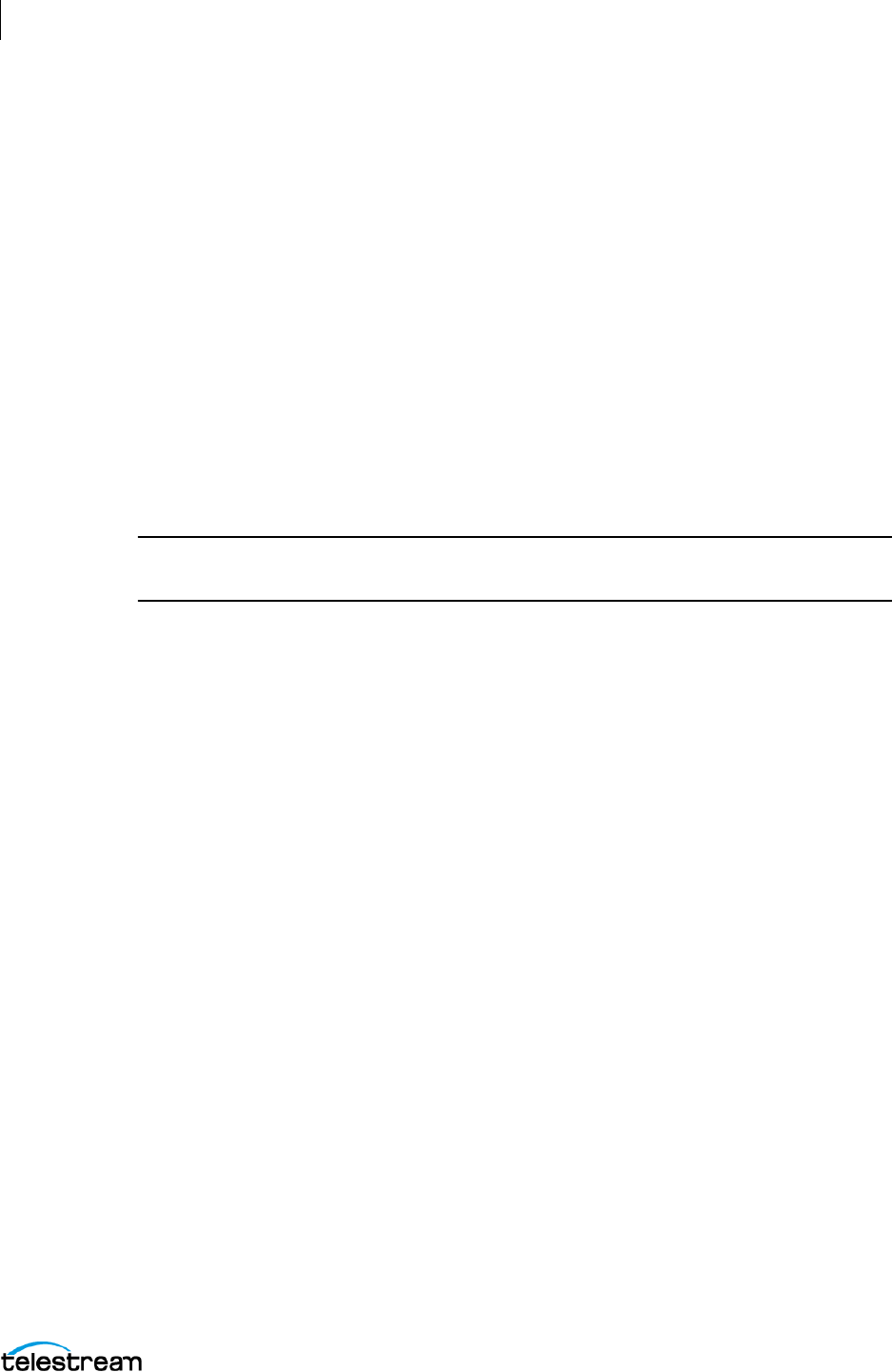
Media Editing
Editing in the Timeline
92
ScreenFlow User Guide
5. Select Ducking.
6. Adjust the percentage slider to desired level of ducking.
See Audio Properties.
Adding Narration
You can add a narration to an existing recording.To add a narration, do the following:
1. Select Insert > Narration.
ScreenFlow displays the settings window.
2. Select an audio device.
3. (Optional) To set a recording duration, check the End After checkbox, and enter a
time in seconds.
4. (Optional) To hear the audio already in your document, uncheck Mute Audio During
Narration.
Note: The Mute Audio Playing During Narration box is checked by default to prevent
feedback while adding narrations.
5. To start recording your narration, click the Record button.
ScreenFlow displays a count-down window to let you know when to begin your
narration, and displays a progress bar on the timeline.
6. Click the Stop button when you finish your narrative.
If you selected the End After option, as the finish time approaches, an ending
countdown appears on the screen. When the recording ends manually or automat-
ically, ScreenFlow adds the narration to the document.
7. Save the recording or discard it.

93
Media Export and Project
Archiving
You can use ScreenFlow to export your video to a standard video file, to upload your
video to a video hosting service, and to archive your screencast project.
Topics
■ Video Encoding
■ Video Publishing
■ Exporting Batches
■ Archiving a ScreenFlow Project
Video Encoding
When you’re done editing your project, you encode it: you convert it to a standard video
format for publication and distribution.
ScreenFlow provides two methods of encoding:
• Export a standard video file. Then distribute or publish the file.
• Publish a video file directly to an online video service such as Vimeo, YouTube, Goo-
gle Drive, Dropbox, Wistia, Box, or Imgur. ScreenFlow converts the project to the
appropriate video format as part of the publication process.
Note: If you have in and out points set in your project, the menu item displays Export
Selected Range. ScreenFlow exports the media between the in and out points.
See Publish To
.
Exporting Video
Note: Apple has deprecated QuickTime in favor of AVFoundation. ScreenFlow export
options using the QuickTime APIs have been removed.
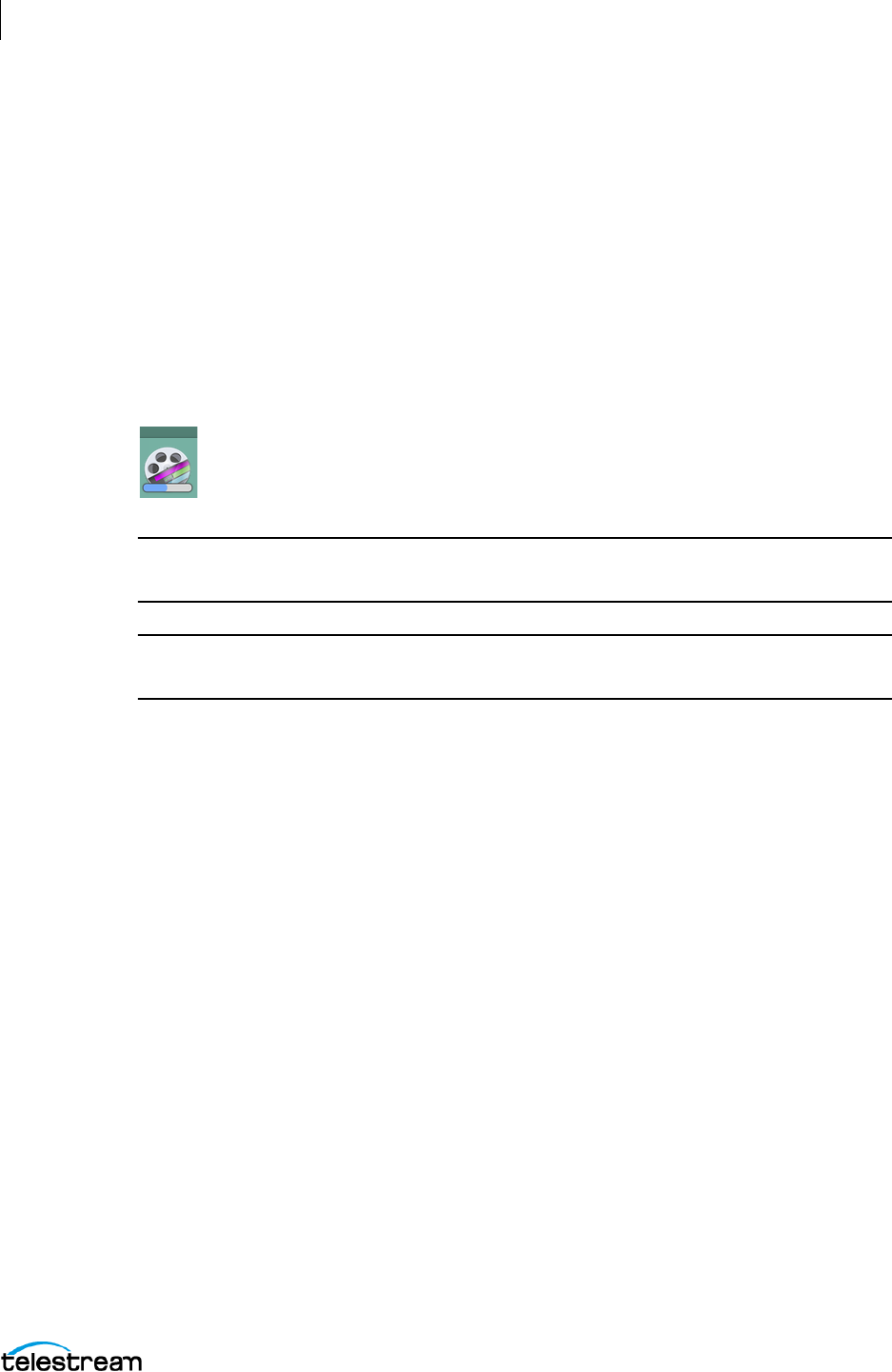
Media Export and Project Archiving
Video Encoding
94
ScreenFlow User Guide
To export your video, do the following:
1. Select File > Export.
ScreenFlow opens the Export Settings dialog.
See The New Recording Pane of the New Dialog.
2. Configure your export settings.
3. Click Export to begin encoding the project into a video file.
ScreenFlow displays a progress dialog.
When exporting a ScreenFlow project, ScreenFlow displays an export-progress overlay.
This allows you to minimize the application during export, while still monitoring the
time remaining.
Note: ScreenFlow displays an alert if you try to select a drive formatted with FAT 16 or
FAT 32.
Note: If you export your video from an unlicensed version of ScreenFlow, ScreenFlow
watermarks your exported video.
See The New Recording Pane of the New Dialog.
Customizing Animated GIF or Animated PNG Outputs
To customize Animated GIF or Animated PNG outputs, do the following:
1. Select File > Export.
ScreenFlow opens the Export Settings dialog.
See The New Recording Pane of the New Dialog.
2. Click the Manual button.
3. In the Preset drop-down menu, select Animated GIF or Animated PNG.
4. Click the Customize button.
ScreenFlow displays the customization dialog for animated GIF or animated PNG.
See Customization Dialog for Animated GIF or Animated PNG.
5. Select the desired values for the fields in the customization dialog.
6. Click OK.
Customizing H.264/AAC (MPEG-4) Codec Settings
To customize settings for Web-High, Web-Low, Lossless - ProRes with Alpha, or iOS App
Preview, do the following:

Media Export and Project Archiving
Video Encoding
95
ScreenFlow User Guide
1. Select File > Export.
ScreenFlow opens the Export Settings dialog.
See The New Recording Pane of the New Dialog.
2. Click the Manual button.
3. In the Preset drop-down menu, select Web-High, Web-Low, Lossless - ProRes with
Alpha, or iOS App Preview.
4. Click the Customize button.
ScreenFlow displays the customization dialog.
See Customization Dialog for H.264/AAC (MPEG-4).
5. Select the desired values for the fields in the customization dialog.
6. Click OK.
Managing Export Presets
To manage export presets, do the following:
1. Select File > Export.
ScreenFlow opens the Export Settings dialog.
See The New Recording Pane of the New Dialog.
2. Click the Manual button.
3. Click the Manage button.
ScreenFlow displays the preset management dialog.
4. Check the box to the left of the preset to show it in the Preset list. Uncheck it to hide
it.
5. Click the Copy button to the right of the preset to generate a copy of the preset so
that you can modify it.
ScreenFlow displays custom presets in the list at the bottom of the window.
6. To change the custom preset name, double-click the name. Click the Edit button to
customize your preset.
7. To create a new Custom Preset, select an existing preset in the list, then click the Plus
(+) button.
8. Once you’ve created the new Preset, click the Edit button to edit it. Click the Minus (-
) button to delete it.
9. Click OK.
Video File Size Considerations
Video files often become very large, making them difficult to send to others, download,
or post to servers via the Internet.
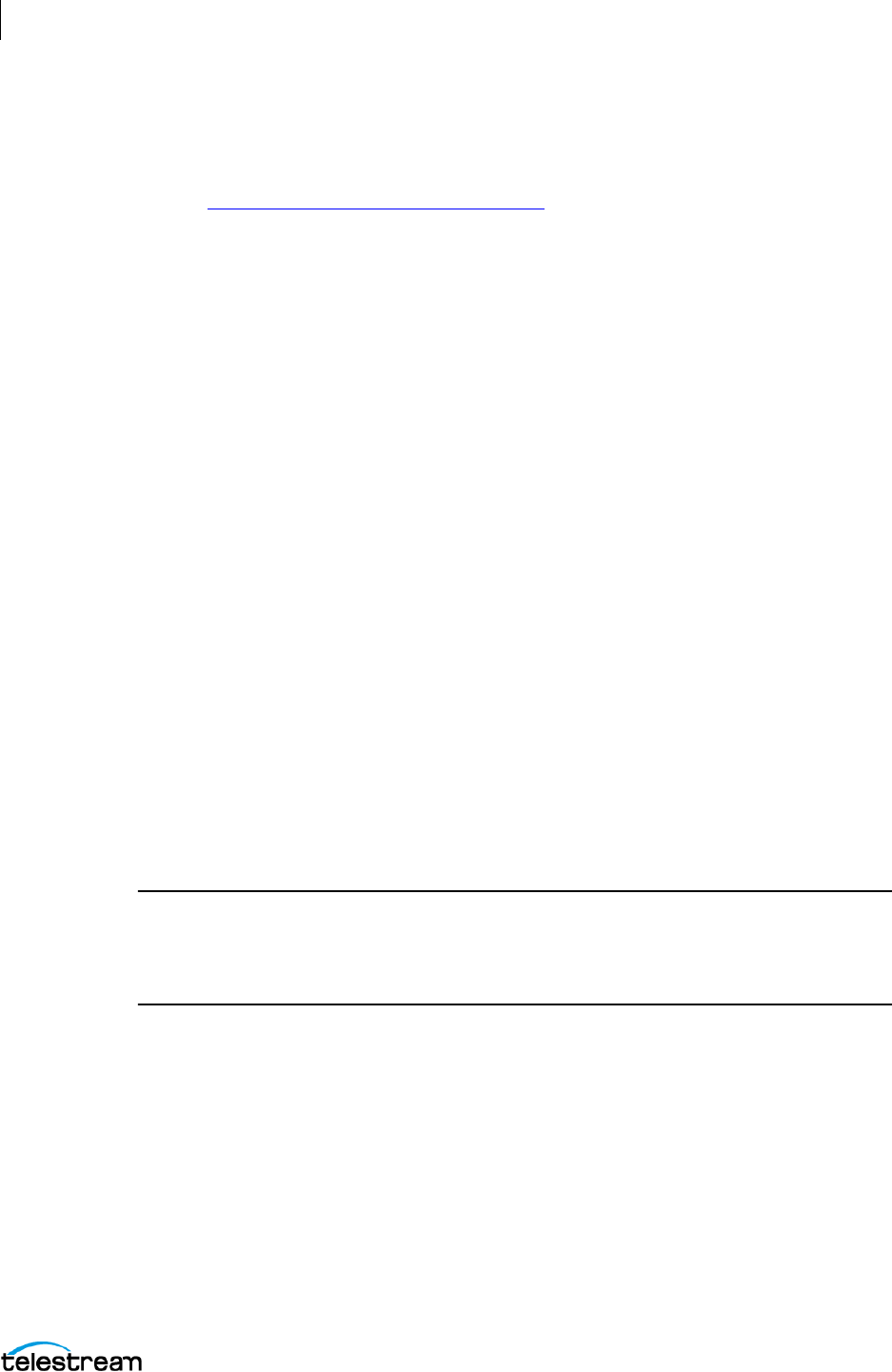
Media Export and Project Archiving
Video Publishing
96
ScreenFlow User Guide
The resolution of video clips in your project typically is higher than the resolution of the
video file you need to export. For example, your original screen resolution might be
1280 x 800 pixels, but you might need an output video file of only 640 x 400 resolution.
See ScreenFlow: Estimate Exported File Size
.
Reducing Video File Size
To preserve the aspect ratio of your project, use the Scale by Dimensions option as
opposed to Scale to a custom size. For general purposes, you may want to scale by 50%.
Reducing the Frame Rate
ATSC video standard frame rates are either 30 fps or 60 fps. You can reduce the size of
the output video by reducing the frame rate. If you reduce the frame rate below 24 fps,
motion in the video will appear less smooth.
You can experiment with codec settings to determine the frame size and frame rate
works best for your project. Find out if your target platform or audience requires certain
frame sizes and frame rates.
Estimated Export Time
When exporting, ScreenFlow displays the estimated time needed for encoding at the
bottom of the screen. The accuracy of this estimate depends on many factors in the file
being exported, and the estimate might change over time.
Video Publishing
You can publish videos from ScreenFlow to various video-hosting platforms.
ScreenFlow encodes videos correctly for each platform, and uploads them to the
platforms.
Note: If you check Save Copy to Disk the Location button is enabled, enabling you to
select the location for the file to be written to disk. If you do not choose a location, the
file will be saved to your Movies folder. If you do not specify a file extension,
ScreenFlow uses MP4.
Publishing to Video Hosts
To publish your video to a video-hosting platform, do the following:
1. Select File > Publish to, and select one of the video-hosting platforms from the
menu.
ScreenFlow opens the Publish to dialog for the platform chosen.
2. Configure the settings for the platform chosen.
See The “Publish to” Dialogs.
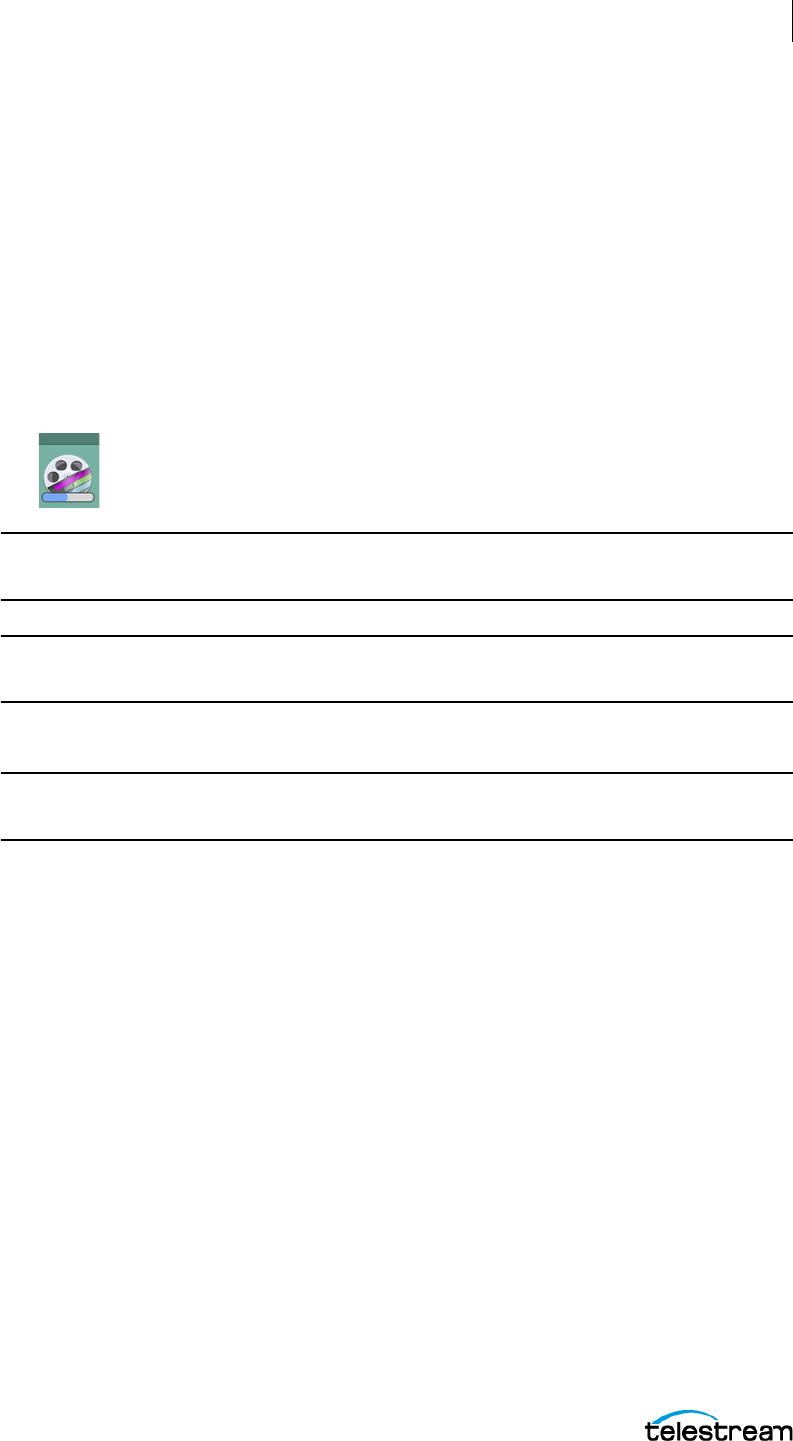
Media Export and Project Archiving
Exporting Batches
97
ScreenFlow User Guide
3. Click Sign In.
ScreenFlow displays a Log In window.
4. Enter your email and password. Then click Log In.
The target platform displays the Publish To [platform] window.
5. Click Publish when finished.
The target platform returns the URL for uploads when it has completed the upload.
When exporting a ScreenFlow project, ScreenFlow displays an export-progress
overlay. This allows you to minimize the application during export, while still moni-
toring the time remaining. Also, ScreenFlow displays an Upload Manager button
(upward-pointing arrow) under the canvas.
Note: ScreenFlow displays an alert if you try to select a drive formatted with FAT 16 or
FAT 32.
Note: If you are using an unlicensed version of ScreenFlow your exported video will
be watermarked.
6. To display details of the upload, click the Upload Manager button.
Note: ScreenFlow displays any upload errors in the Upload Manager window. Click
the yellow warning triangle to display more information about the error.
7. To view the uploaded video on the video host, click the Upload Manager button.
8. To clear the completed uploads from the list, click the Clear button.
Exporting Batches
ScreenFlow Batch Export encodes batches of ScreenFlow documents into formats you
specify. This is quicker than encoding documents individually.
To export a batch of files, do the following:
1. Select File > Batch Export.
This opens the Batch Export dialog.
See File Menu.
2. Click the plus (+) button located in the bottom left corner of the dialog, or drag and
drop documents onto the Documents pane.
ScreenFlow loads the documents into the batch queue. The documents list displays
an icon, the document name, and the duration for each document.
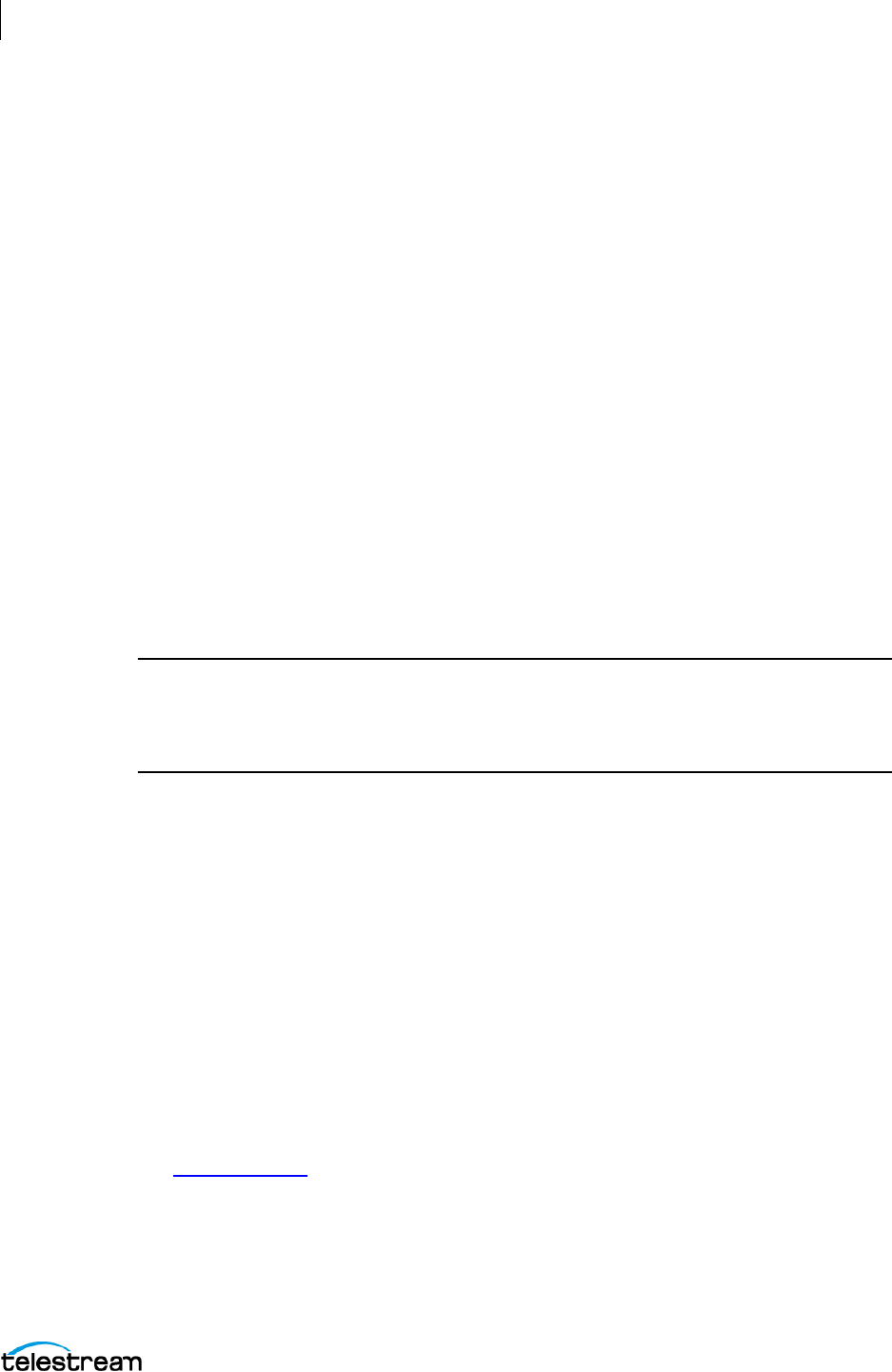
Media Export and Project Archiving
Archiving a ScreenFlow Project
98
ScreenFlow User Guide
3. In the Output Folder field, click Choose. Choose a folder for the exported files.
The default folder is the Movies directory.
4. Select a preset from the Preset menu.
5. (Optional) Customize the preset by clicking Customize.
6. To manage the arrangement of the list of presets, click Manage.
7. Select desired options by checking their boxes.
The export settings are the same ones displayed in the Export Settings dialog.
See The New Recording Pane of the New Dialog.
8. Click Begin.
ScreenFlow encodes the documents according to the settings chosen, and saves
the exported files to the chosen output folder.
In a batch export, ScreenFlow applies the settings across the entire batch. You can’t
configure batch export settings on an individual document.
Once ScreenFlow starts the batch processing, ScreenFlow dims the options and dis-
plays a progress bar for each document. ScreenFlow also displays a progress bar at
the bottom right of the Batch Export dialog, showing the progress of the whole
batch.
9. (Optional) Click the Cancel button to stop the processing.
Note: By default, if you quit ScreenFlow with the Batch Export window open, when
the application reopens, ScreenFlow doesn’t reload the documents. To have
ScreenFlow reload the documents by default, go to the Mac System General
Preferences. Check the box for Close windows when quitting an application.
Archiving a ScreenFlow Project
You can archive a ScreenFlow project upon completion. ScreenFlow truncates screen
recordings to the sections of the recordings used in the timeline, and saves the project
in a ScreenFlow file. To archive a project, do the following:
1. Navigate to File > Archive.
2. In the Save As field, enter a filename for the archived project.
3. In the Where field, select a location from the drop-down menu.
4. Click Save.
ScreenFlow removes unused content from the project and saves the project in a file
with the extension SCREENFLOW.
See Archive Storage
.

Windows in ScreenFlow
The ScreenFlow User Interface
99
ScreenFlow User Guide
Windows in ScreenFlow
You can control most of the features of ScreenFlow through the ScreenFlow user
interface.
Topics
■ The ScreenFlow User Interface
■ The Editor Window
■ The Timeline Window
■ The Clip Editor
■ The Properties Window
The ScreenFlow User Interface
You create ScreenFlow documents through the ScreenFlow user interface. You can add
media, text, actions, and other effects. You can arrange elements spatially and
temporally in your screencast. You can configure elements to behave just the way you
want. Also, you can preview your screencast and adjust the results.
You can arrange screencast elements spatially and temporally. You can configure the
display and behavior of each element. You can also preview and modify your
screencast.
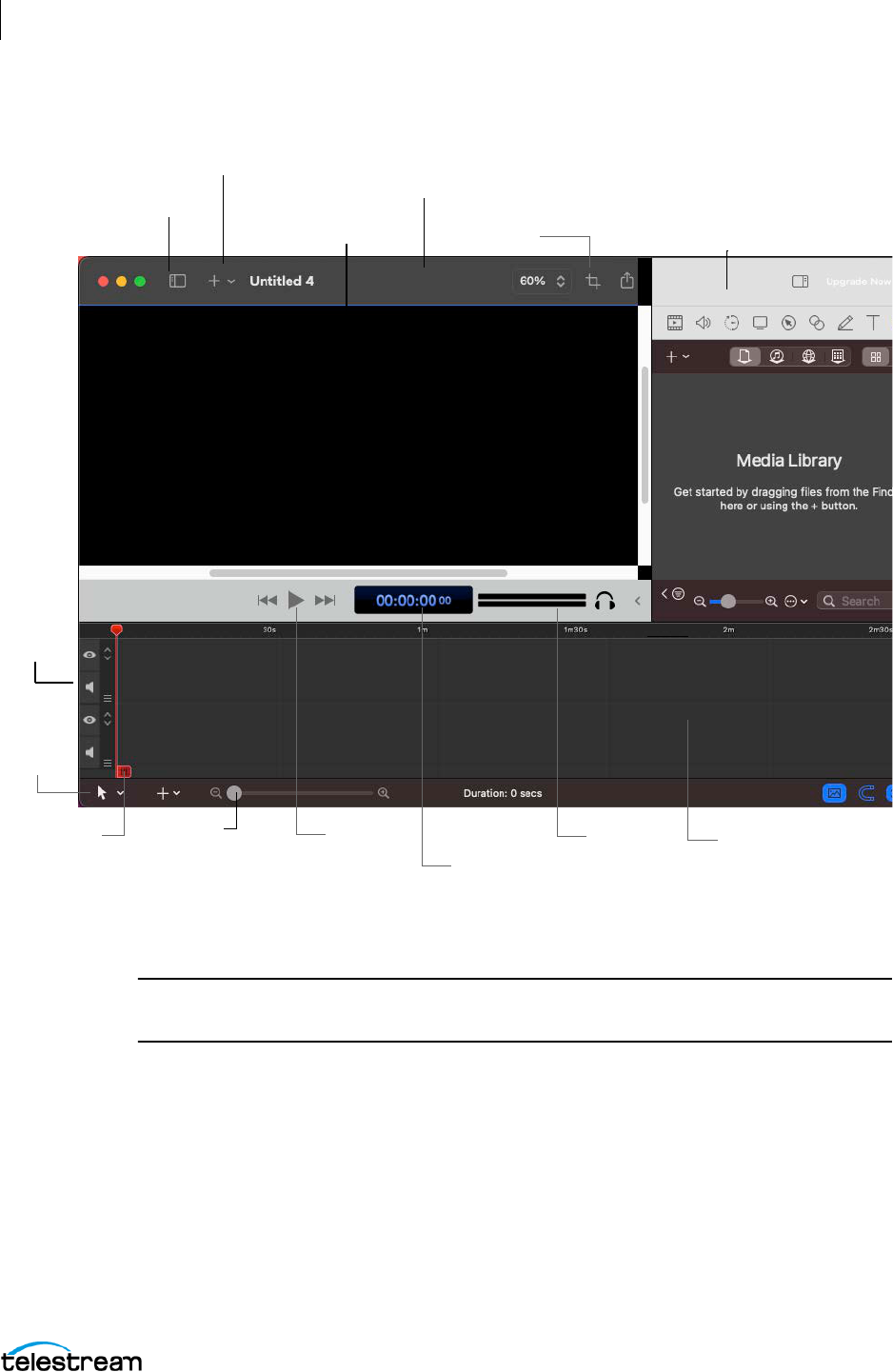
Windows in ScreenFlow
The ScreenFlow User Interface
100
ScreenFlow User Guide
Figure 1. ScreenFlow User Interface Overview
Each ScreenFlow document is stored in a ScreenFlow document file. You can open
several ScreenFlow documents to work on them simultaneously.
Note: To create a new, untitled ScreenFlow document for a new screencast, see
Creating a Document.
The user interface contains the Editor window, the Timeline, and the Properties window.
You can resize the Canvas and Timeline windows by clicking and dragging the toolbar
up or down. Click anywhere in the region of the toolbar directly below the toolbar icons
(and above the timeline) and drag the toolbar up or down to resize the windows.
All windows work together to help you create, edit, and preview your screencast.
The Timeline
Window
Canvas Button
Playback
Controls
The Properties
Window
Audio
Meters
Timeline
magnification
slider
Timecode Display
Scrubber
Tools
Menu
The Editor Window
The Canvas Window
Track
controls
Open/Close Clip Editor
Editor Drop-Down Menu Button
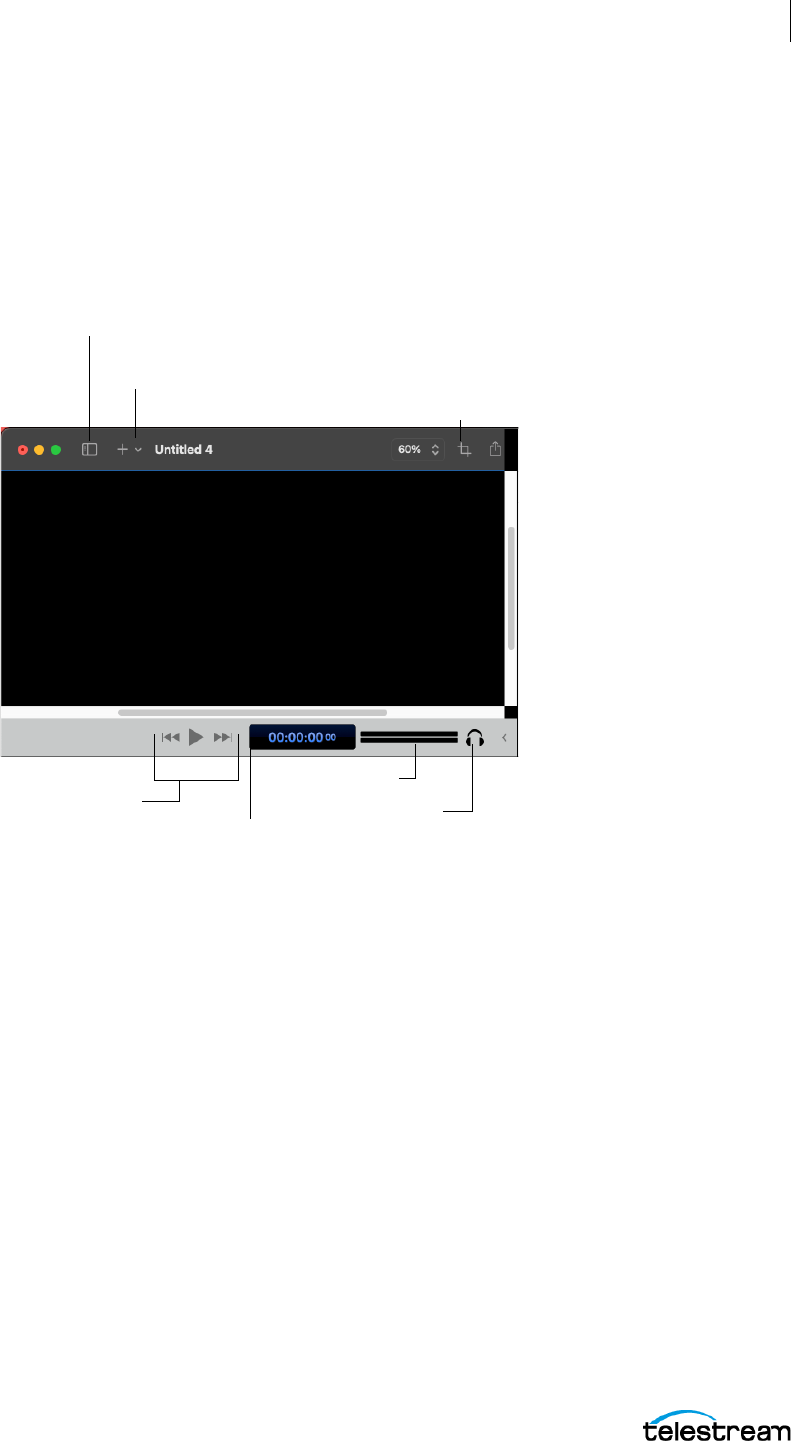
Windows in ScreenFlow
The Editor Window
101
ScreenFlow User Guide
The Editor Window
The Editor window is a spatial representation of the visual clips of your screencast (and
their properties, actions, etc.), based on the position of the scrubber on the timeline. At
any given point in time, elements in a screencast might be entirely or partially visible in
the frame, or off-screen entirely. You use the Editor window to arrange, resize and
configure these elements.
It displays several tools you’ll use to configure your canvas, preview your video, and
monitor your audio, as described below, in Table 1.
Canvas Button
Playback Controls
Audio Meter
<headphone icon>
Open/Close Clip Editor
Timecode Display
Editor Drop-Down Menu Button

Windows in ScreenFlow
The Editor Window
102
ScreenFlow User Guide
See Editor Drop-Down Menu and Customizable Toolbar.
Table 1. The Editor Window
Control Description
Open/Close Clip
Editor
When clicked, ScreenFlow opens or closes the Clip Editor
window.
Editor Drop-Down
Menu Button
When clicked, ScreenFlow opens or closes the Editor Drop-
down menu.
See Editor Drop-Down Menu.
Canvas Button Click the Canvas button (far left) to display the canvas
controls—click it again to hide them. You can use these
controls to view and adjust Canvas properties: the Canvas size
(and resulting frame size of your exported video) and
background color.
For details, see Configuring the Canvas.
Playback Controls Use the playback controls (center) to play your screencast as
well as jump to the beginning or end of your screencast.
You can also use the traditional video editor’s JKL keystrokes
for Rewind, Stop, and Playback. Press J or L repeatedly to
speed up rewind/playback respectively.
ScreenFlow displays the timecode of the screencast directly
to the right of the playback controls. You can set timecode to
SMPTE or ScreenFlow.
See Timeline Settings Tab.
Timecode Display &
Progress Display
Displays the timecode at the scrubber location.
If you load a long media file onto the time line (or move a
long file to another location in the time line), the progress is
displayed in percent in the right side of the timecode display.
Audio Meter The audio meter (far right) displays audio volume. The top
meter represents the left channel; the bottom, the right
channel.
<headphone icon> Click the headphone icon to toggle (on and off) muting of the
preview audio (headphones).
Progress
display
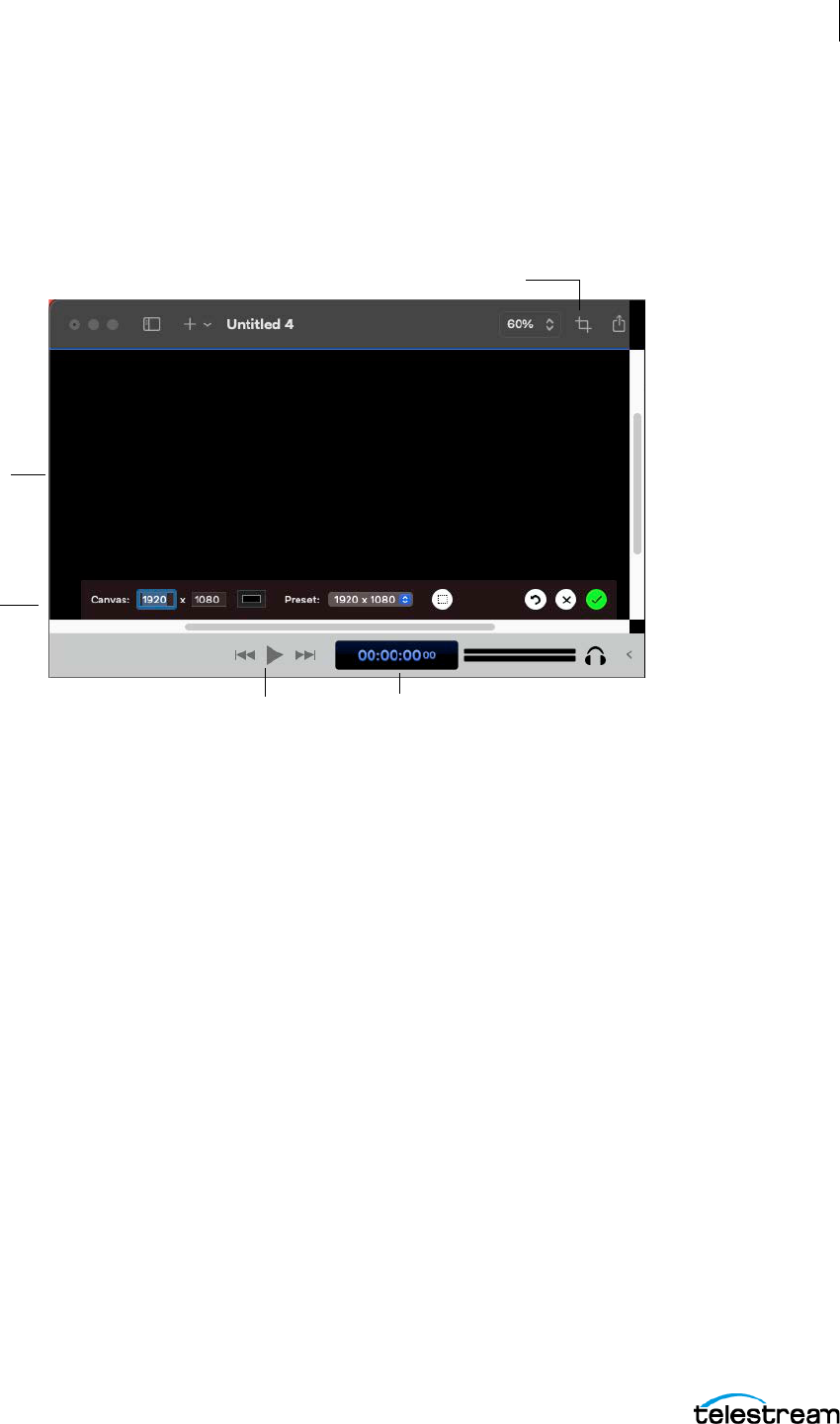
Windows in ScreenFlow
The Timeline Window
103
ScreenFlow User Guide
The Canvas Window
The Canvas is a real-time video preview window. Canvas controls enable you to size and
position the visual elements of your screencast.
Figure 2. The Canvas Window
The center rectangle (which may be obscured by a clip) represents the video frame of
your screencast. The Canvas dimensions determine the frame size of your exported
video.
The gray space around the video frame rectangle is workspace; space that isn’t
included in exported video. You can use this space for off- or partially off-screen visual
elements for scaling or pan effects.
See Editing on the Canvas and Configuring the Canvas.
The Timeline Window
The bottom window (directly below the playback controls) is the Timeline—a temporal
representation of your screencast, with a time scale at the top. The Timeline enables you
to arrange the clips in your screencast in play order, and add fades and other effects.
The elements on the timeline reference media in your screencast media library.
Changes made on the Timeline or in the Editor window do not alter your original media
clips in the media library.
For details, see The Timeline Window.
The timeline (Figure 3) is a temporal representation of your screencast. The timeline
displays all of the clips in your screencast and represents the start and end time for each
Canvas work
area
Canvas Button
Playback Controls
Timecode Display & Progress Display
Canvas
properties
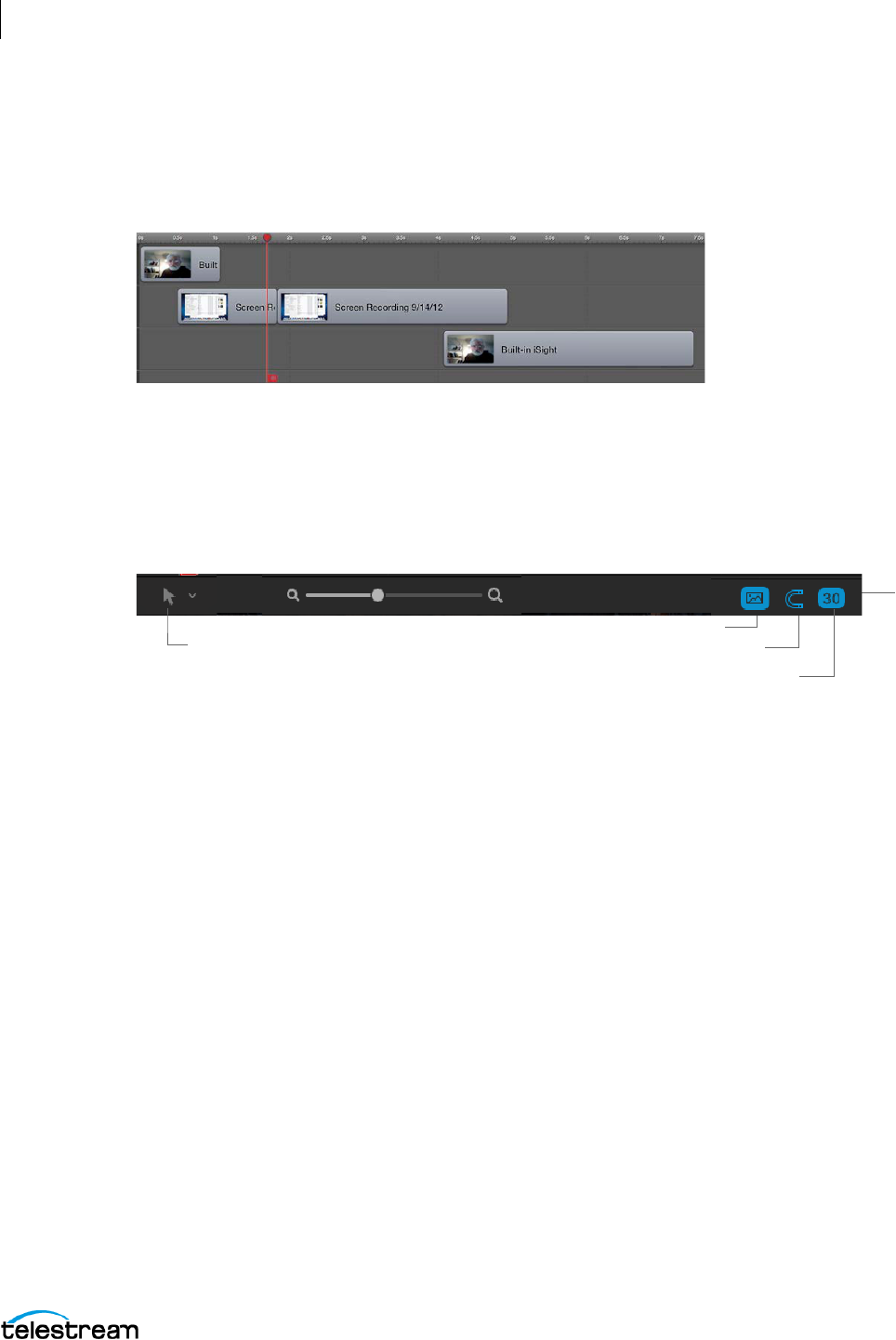
Windows in ScreenFlow
The Timeline Window
104
ScreenFlow User Guide
of the clips. You can use the timeline to arrange clips in the order you want them
played. You can also layer them, and crop them. You can also use the timeline to add
actions (such as fade) to your clips.
Figure 3. The Timeline Displaying Media Clips
The timeline is divided vertically into tracks to allow you to arrange clips that overlap at
certain points on the timeline.
Timeline Buttons
There are four timeline buttons.
Mouse Tool Button
When clicked, ScreenFlow opens the Mouse Tool pane. The Mouse Tool lets you select
how the mouse is used on the timeline.
Thumbnail Button
Snapping Button
Framerate Button
Mouse Tool Button
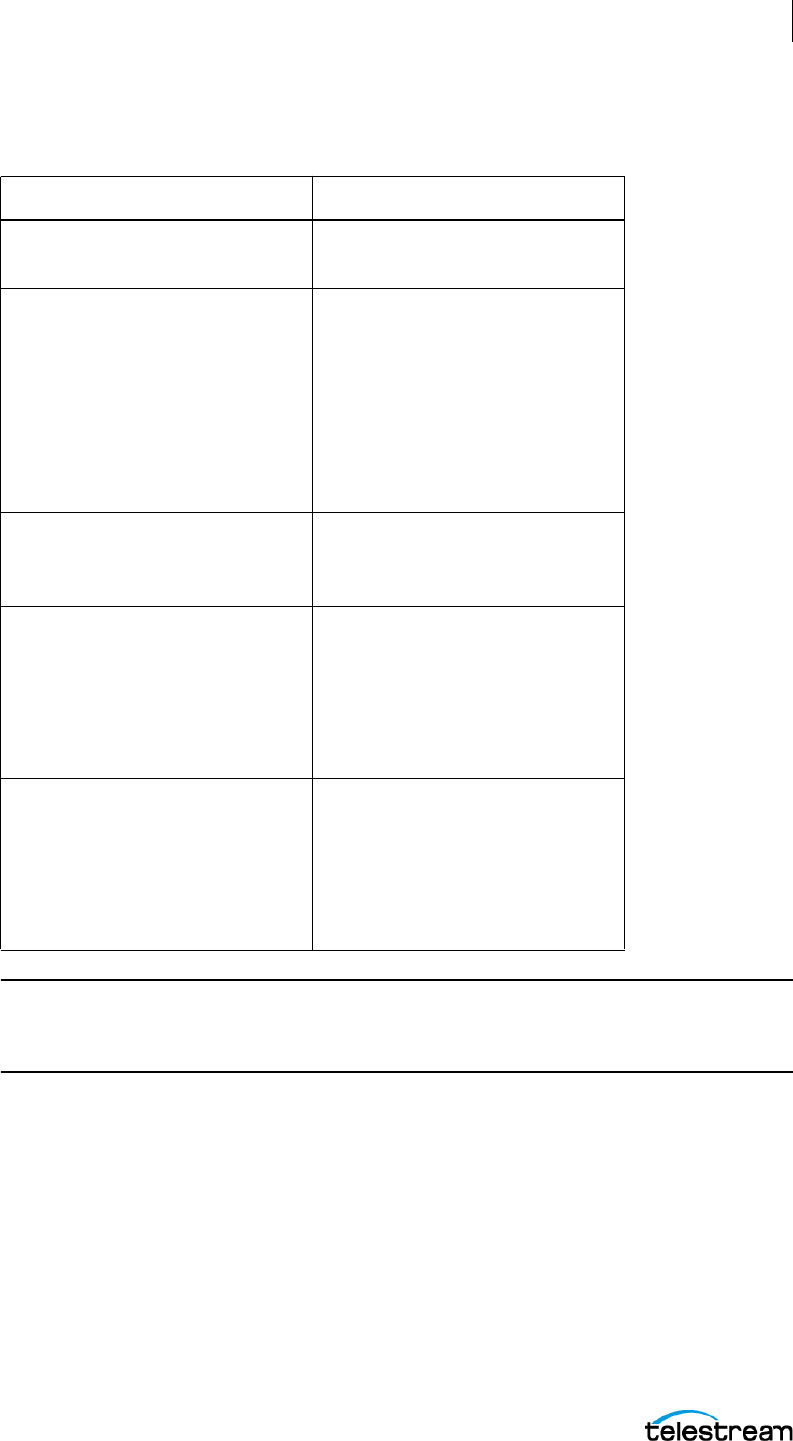
Windows in ScreenFlow
The Timeline Window
105
ScreenFlow User Guide
Note: If you hold down the shortcut key for a mouse tool, you can access it
immediately. If you release the key after 1/4 second, ScreenFlow restores the previous
tool.
Thumbnail Button
When clicked, ScreenFlow opens the Thumbnail pane.
To display thumbnails, check Thumbnails and then select either Single, or Track.
To display waveforms, check Waveforms and the select either Single or Stereo.
Snapping Button
Click the Snapping button to turn snapping on or off. When snapping is on, the button
is displayed in blue. When off, it changes to white.
Table 2. The Mouse Tool Button
Mouse Tool Button Description
Select The mouse selects items on the
timeline. Shortcut: “A.”
Zoom Enables you to click and drag a
region to zoom. If the mouse is
clicked once (without dragging),
it zooms in on the timeline one
step per click. If the Option key
is held down while clicking, it
zooms out one step per click.
Shortcut: “Z.”
Hand Mouse moves the timeline by
clicking and dragging with the
mouse. Shortcut: “H.”
Blade When rolling over the timeline, a
red line will follow the cursor. If
the mouse is clicked, the
timeline will have all clips split at
that mouse position. Shortcut:
“B.”
Track Select Cursor changes to a right facing
arrow. Clicking on the timeline
in this mode selects clips that
are forward in time the current
selection (from left to right).
Shortcut: “N.”
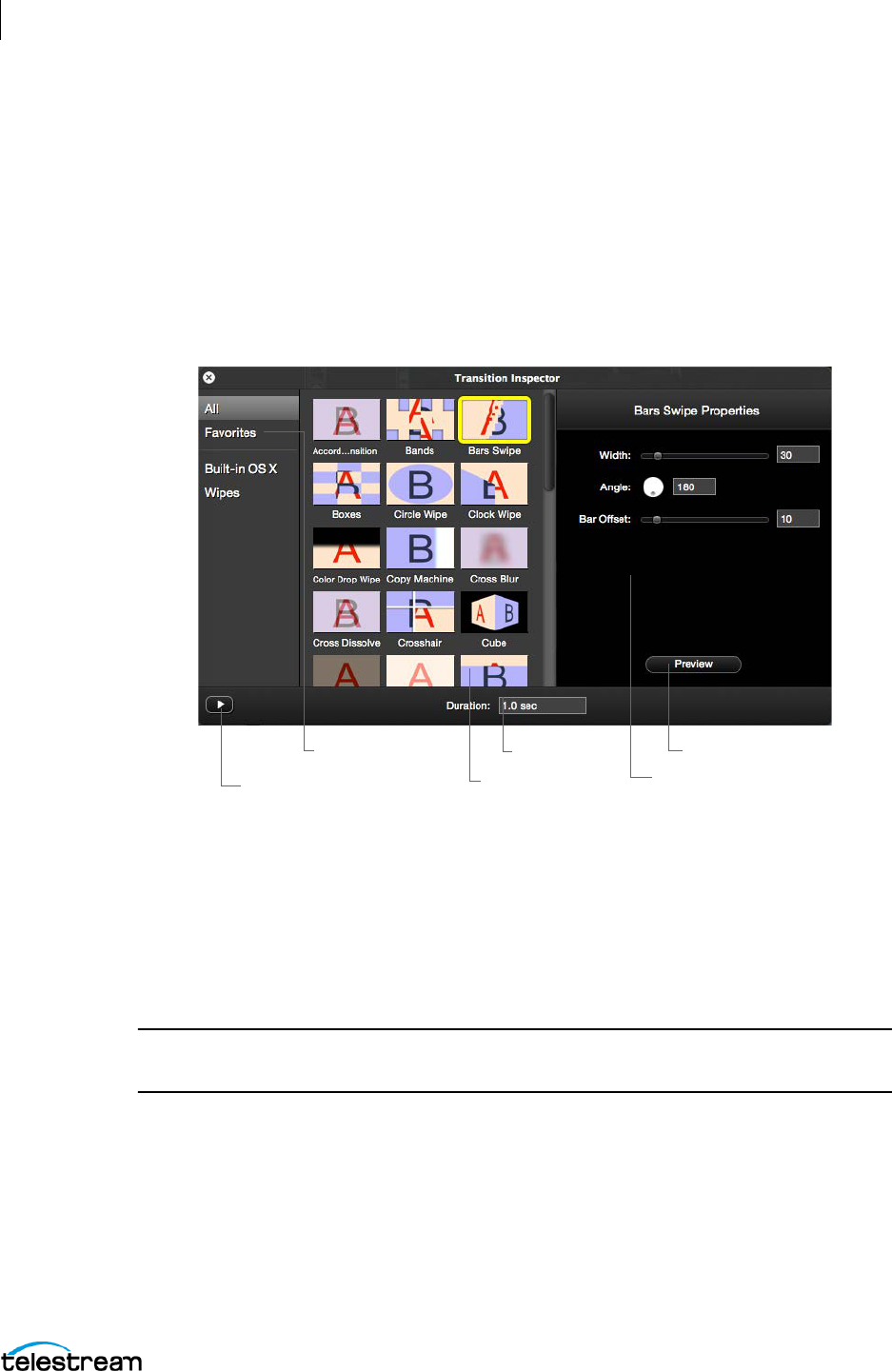
Windows in ScreenFlow
The Timeline Window
106
ScreenFlow User Guide
Framerate Button
When clicked, ScreenFlow opens the Framerate menu. Select framerate settings and
click Update when finished.
The Transitions Inspection Window
Figure 4. Transitions Inspector Window
Transitions
You can add transitions only between clips in the same track. The default duration of a
transition is one second. You can expand or contract the duration by moving the thin
vertical line separating the transition from the main part of the clip. You may need to
zoom in on the timeline to make it easier. As you adjust the duration of the transition,
ScreenFlow displays the time value in real time.
Note: You can also change the default duration of transitions in the ScreenFlow
Settings >Timeline tab.
See Timeline Settings Tab, and Adding Transitions.
Favorites
Transition groups button
Preview button
Transition Controls
Transition icons
Duration field
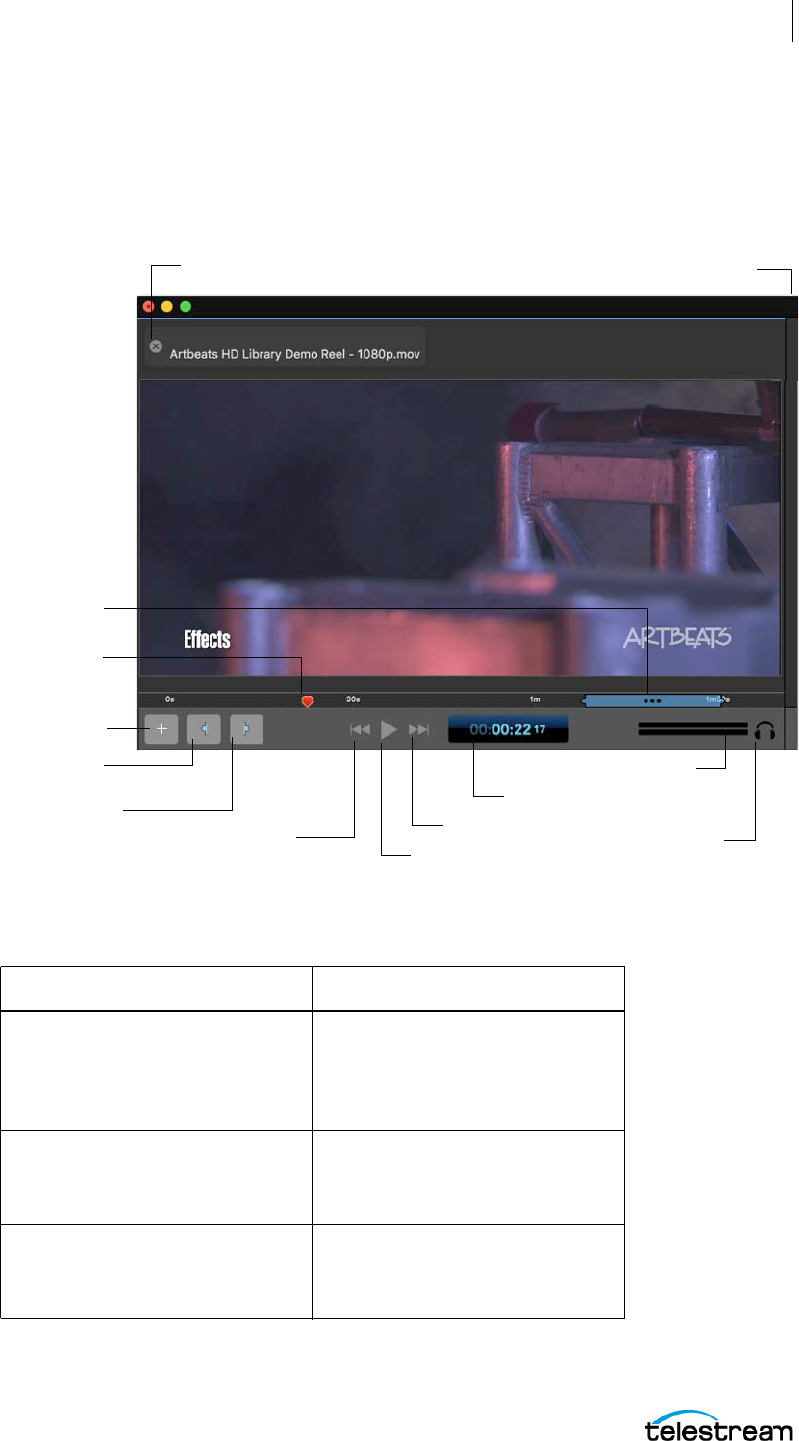
Windows in ScreenFlow
The Clip Editor
107
ScreenFlow User Guide
The Clip Editor
The Clip Editor enables you to select an individual clip, view it in a clip editor on the left-
hand side of the main document user interface. You can preview the clip and perform
quick edits, adding the resulting clip directly to the timeline.
Table 3. (Sheet 1 of 2)
Button Description
Close Window Click X to close the Clip Editor.
You can also select View > Hide
Clip Editor and View > Show Clip
Editor.
Adjust Size Click and grab the edge of the
Clip Editor window to adjust its
size.
Scrubber Click and move the scrubber to
change the display location in
the media.
Close Window
Add In-Point
Add Media
Jump to Beginning
Play/Pause
Jump to End
Timecode Display
Audio Meters
Mute Audio
I/O Section
Adjust Size
Add Out-Point
Scrubber
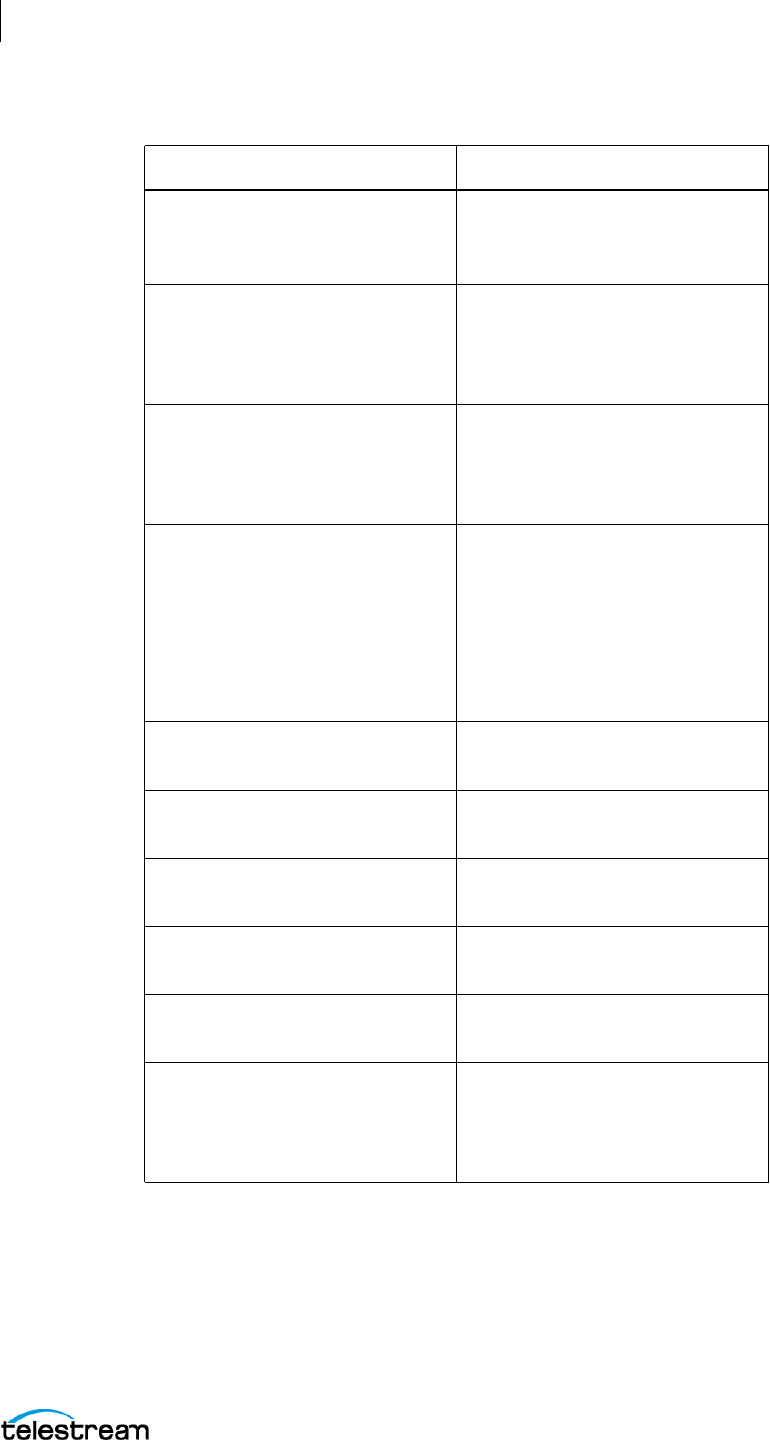
Windows in ScreenFlow
The Properties Window
108
ScreenFlow User Guide
The Properties Window
The upper-right window is the Properties window. The Properties window contains
these tabs: Video, Audio, Video Motion, Screen Recording, Callout, Touch Callout,
Annotations, Text and Titles, and Media Library.
Add Media Click the Plus (+) button to add
the media (in its current state) to
the Timeline.
Add In-Point Click to add an in-point at the
scrubber location. A blue bar
will display to indicate the
selected section of the clip.
Add Out-Point Click to add an out-point at the
scrubber location. A blue bar
will display to indicate the
selected section of the clip.
I/O Section After setting an In-Point and
Out-Point, you can move these
points by clicking on the either
end of the blue bar and moving
them. Selecting the three dots
in the center move the entire I/O
selection.
Jump to Beginning Click to jump the scrubber to
the beginning of the media.
Jump to End Click to jump the scrubber to
the end of the media.
Play/Pause Click to start playback of the
media. Click again to pause it.
Timecode Display Displays the time location of the
scrubber in the media.
Audio Meters Displays audio levels (left and
right channels) during playback.
Mute Audio Click the headphone button to
mute playback audio. Clicking
the button again turns the audio
back on.
Table 3. (Continued) (Sheet 2 of 2)
Button Description

Windows in ScreenFlow
The Properties Window
109
ScreenFlow User Guide
You can customize the settings of a document in the tabs of the Properties window.
See the Properties window in the screenshot in The Properties Window.
Video Properties
Video effects include advanced color adjustments, distortion effects, blurring, color
effects, chroma key, and alpha mask. Each filter has parameters that you can configure
for optional features and for fine-tuning the effects of the filter.
Note: For descriptions of the Vantage video and audio filters, visit
https://cifilter.io/
See also the instructional video https://vimeo.com/560931223
Also, you can purchase third-party Core Audio or video filters for use in ScreenFlow.
In the Properties window, the Video Properties tab contains the following controls:
Name of open tab
Open/close Properties window
Video tab button
Audio tab button
Video Motion tab button
Screen Recording tab button
Callout tab button
Touch Callout tab button
Annotations tab button
Text & Titles tab button
Media Library tab button
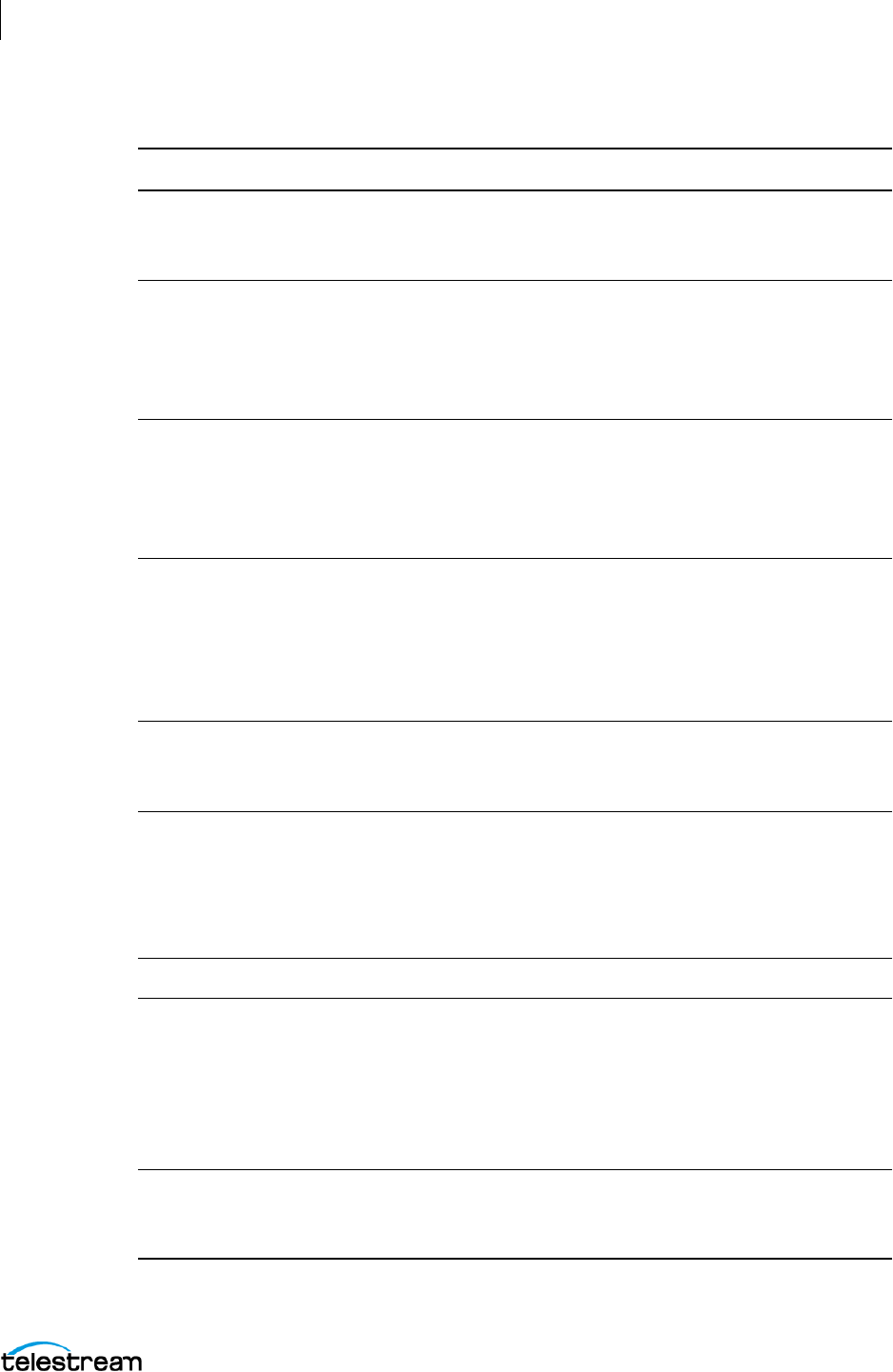
Windows in ScreenFlow
The Properties Window
110
ScreenFlow User Guide
Table 4. Video Properties Tab
Control Description
Scale Use the slider or enter a value (0-400%) to change the scale of
your image. This is useful for highlighting a particular portion
of the screen, or in a video action to create a zoom effect.
Position Enter X and Y coordinates to specify the location (in pixels) of
your video or image on the canvas, based on the center of the
image. You can also reposition the image by dragging the
image on the canvas, or nudging the selected image with the
arrow keys.
X/Y/Z Rotation Use the rotation options to rotate (in degrees: -180 to180) the
image in a virtual, three-dimensional space. X rotates the
image along a horizontal axis. Y rotates the image along a
vertical axis. Z spins the image along a depth axis. Or, use the
thumb wheels to rotate the image in real time.
Opacity Use the slider to set the opacity value or enter it manually (0
to 100%). The greater the value, the more opaque the image.
When set to zero, the image is transparent—invisible. This can
be used with a video action to fade an image in or out, or if
you have a video voice-over, and would like to periodically
display your entire camera recording frame.
Cropping Click the disclosure triangle down to display cropping
options. Set the crop margins (by pixel) for left, right, bottom,
and top.
Reflection Check to implement reflection. Use the slider to set the value
or enter it manually (0 to 100%).
Reflection creates a mirror image of the selected clip below
the clip itself. The greater the value, the more opaque the
reflection. When set to zero, the reflection is invisible.
Corner Round Drag slider to adjust the roundness of the corners.
Drop Shadow Check to create a shadow effect behind a still image. If the
image uses a transparency, the shadow only reflects the non-
transparent part of your image.
Use the thumb wheel (or enter the value manually) to set the
angle of the shadow relative to the image in degrees (-180 to
80 degrees). The default is -45 degrees.
Angle Use the thumb wheel (or enter the value manually) to set the
Angle of the shadow relative to the image in degrees (-180 to
80 degrees).

Windows in ScreenFlow
The Properties Window
111
ScreenFlow User Guide
See Configuring Video Properties.
Audio Properties
Audio effects include EQ, multi-band compression, peak limiting, and delay. You can
apply multiple filters to a single clip. You can apply filters to nested clips. Each filter has
parameters that you can configure for optional features and for fine-tuning the effects
of the filter.
Color Click the color field to select the shadow color from the color
picker. Default: black.
Offset Use the slider to set the value (in pixels) or enter it manually (0
to 150 pixels) to specify the distance between the shadow
and the clip. Default: 40.
Opacity Use the arrows to set the value or enter it manually (0 to
100%). The greater the value, the more opaque the shadow. If
the value is set to zero, the shadow is invisible. Default: 75%.
Blur Size Use the arrows to set the value or enter it manually. Blur is a
gradual loss in opacity as the shadow spreads from the center.
Default: 4. Range: 0 to 100 pixels.
Color Controls Click the disclosure triangle down to display color options.
Saturation Use the slider to set the value or enter it manually (0 to 400%).
Saturation is the intensity of a color relative to its brightness,
represented as a percentage. Default: 100%.
Brightness Use the slider to set the value or enter it manually (0 to 400%).
Brightness is the degree of luminosity present in the image,
represented as a percentage. Default: 100%.
Contrast Use the slider to set the value or enter it manually (0 to 400%).
Contrast is the relative intensity of the black and white values
in an image. A high contrast has a greater intensity of black
and white values. This value is represented as a percentage.
Default: 100%.
Video Filters Click the plus icon to add filters to the selected clip.
Add Video Action Click to add a video action at the moment indicated by the
scrubber in the selected clip. You can also click the +Action
icon at the top of the tab.
Table 4. Video Properties Tab
Control Description
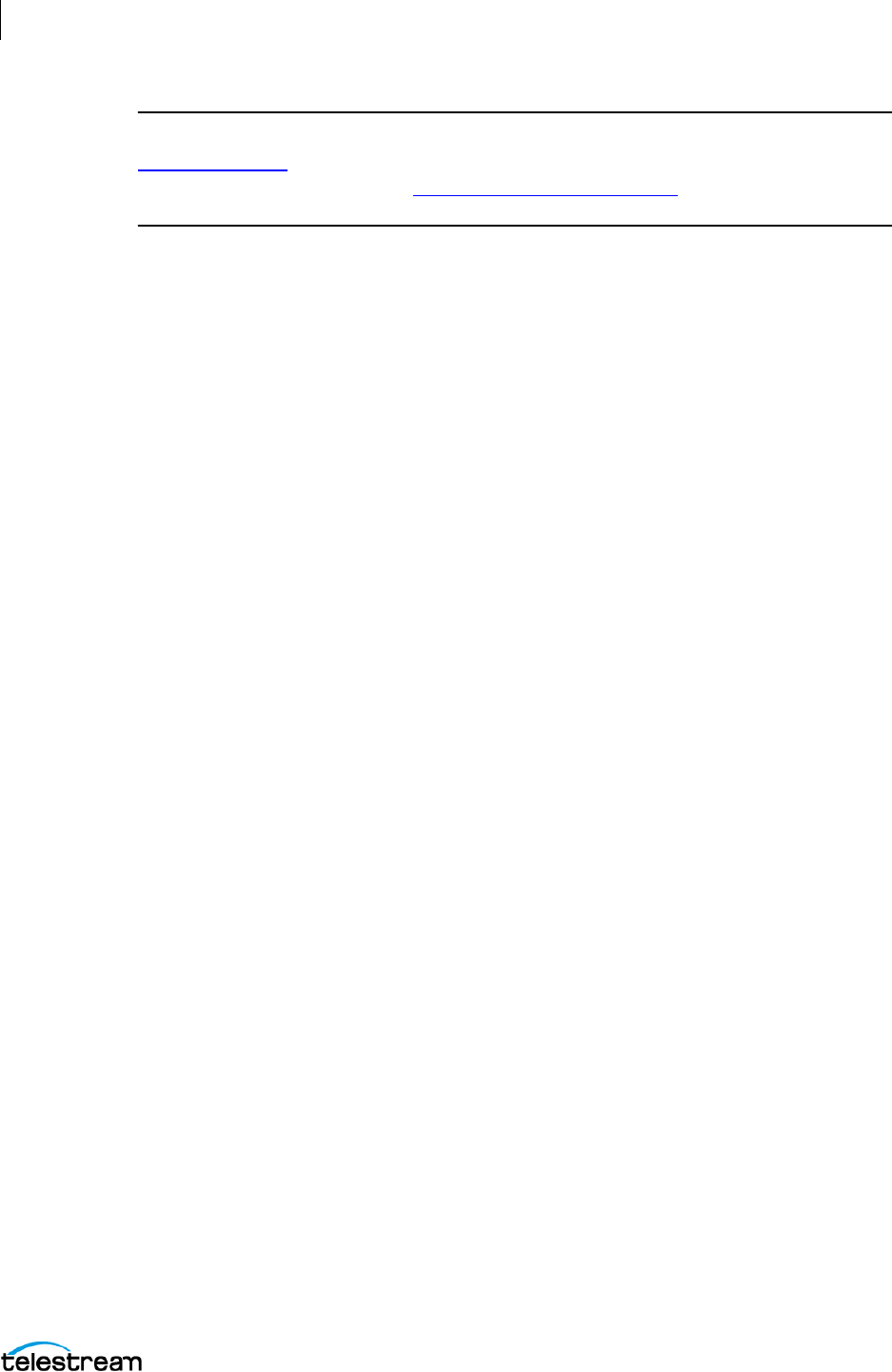
Windows in ScreenFlow
The Properties Window
112
ScreenFlow User Guide
Note: For descriptions of the Vantage video and audio filters, visit
https://cifilter.io/
See also the instructional video https://vimeo.com/560931223
Also, you can purchase third-party Core Audio or video filters for use in ScreenFlow.
In the Properties window, the Audio Properties tab contains the following controls:
Volume
The slider, and accompanying text field, provide the volume adjustment for the Audio
Mixer. The volume is set to 100% by default, but can be reset above or below this value.
Mute Audio
Check to mute all audio output from the mixer.
Ducking
Check to activate ducking. This lowers the audio levels for background audio whenever
there is a voiceover. You can set the percent of ducking by moving the slider or by
entering a value and pressing Enter. ScreenFlow updates the slider accordingly.
Processing
Check Smooth Volume Levels to activate a smoothing process imposed on the audio
output.
Mix Output Pane
Displays the audio output of the mixer using a stereo meter bar.
The Effect Pane
The effect pane contains the following:
Effect
Check to activate effects. Select an effect from the pull-down menu.
Amount
Move the slider to adjust the amount of effect you want in your audio output. You can
also enter a value directly. Press Enter when finished. The slider is updated accordingly.
Filter
Check Remove Background Noise to remove or lower the background noise in your
audio output.
Amount
Move the slider to adjust the amount of background noise to remove. You can also
enter a value directly. Press Enter when finished. The slider is updated accordingly.
See Configuring Audio Properties.
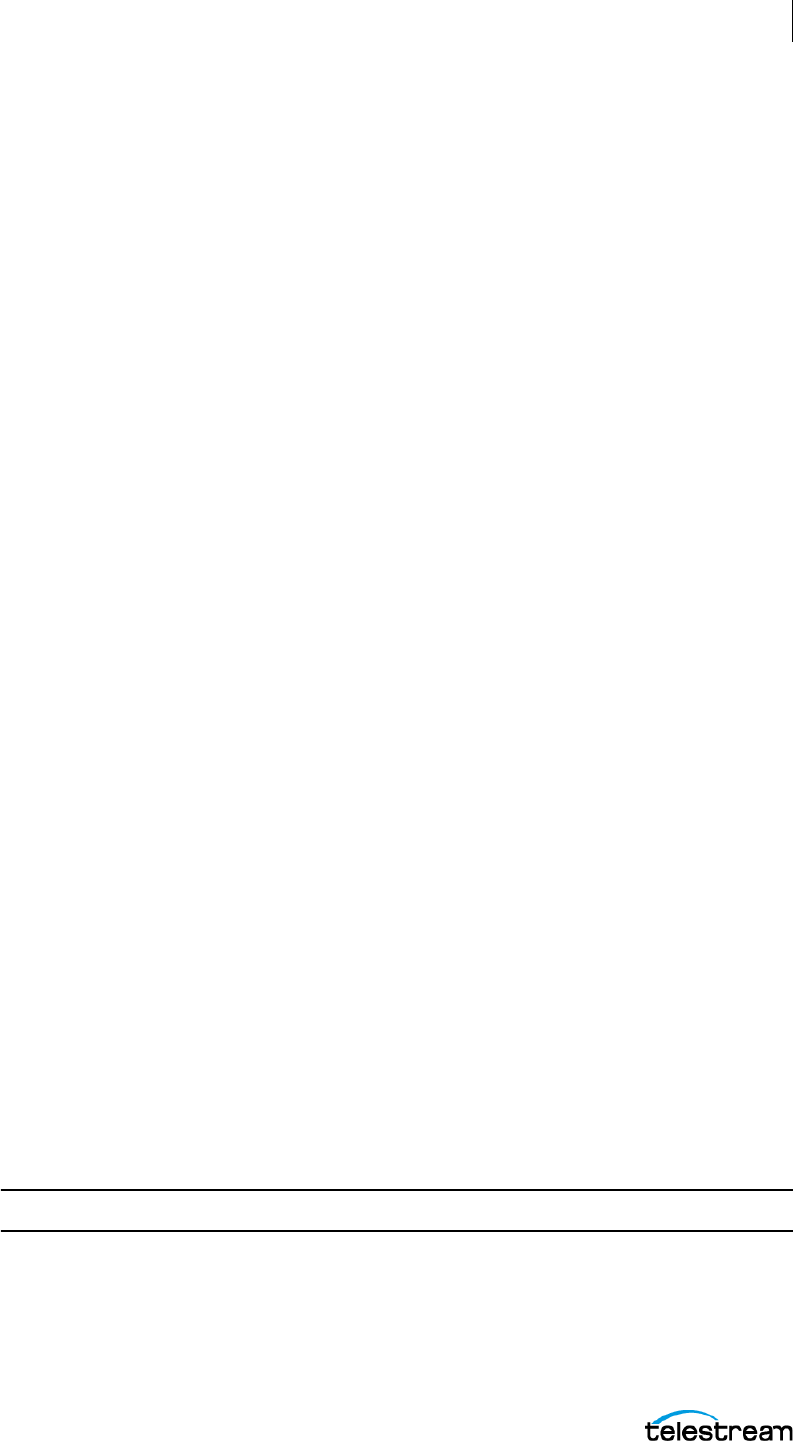
Windows in ScreenFlow
The Properties Window
113
ScreenFlow User Guide
The Audio Filters Pane
Audio Filters triangle
Opens the Audio Filters control window.
Plus (+) icon
Opens the list of filters. You can add multiple filters.
“x” icon (to the right of each filter name)
Removes the audio filter from the audio effects applied.
The Audio Mixer
You can mix, pan, and solo all of your audio channels using the controls in the audio
mixer. The Audio Mix panel is closed by default, but you can open it by clicking on the
triangle next to Audio Mix. ScreenFlow displays each individual input channel. The
Audio Mix dialog contains the following:
Gear icon
Click to open the options menu where you can select Rest to defaults or Set Mix to Mono.
Channel Number
Each individual audio channel has a number of controls. On the far left is the channel
number string; this is simply the index of the channel.
Audio Meter
Next to the number is an audio meter showing the RMS power, peak and peak hold of
audio in that channel. The meter is dB based and has a scale from -72 to +6. If the peak
goes above 0dB, the meter will be tinted red to let the user know clipping is occurring.
Once the peak hold decays below 0dB, the meter resumes its normal look. The lighter
green value is the RMS power, which provides a general indication of the current
loudness of the channel. The darker green color is the current peak dB value and the
white line is the current peak hold value.
Solo Buttons
To the right of the audio meter is the 'S' or Solo button. This mutes all other channels in
the mix during preview. Selecting the solo button for one channel automatically
deselects the solo buttons for all other channels. To monitor more than one channel,
press the command key while clicking solo buttons on desired channels. Clicking an
already-selected Solo button without holding down the command key deactivates solo
track preview. When the Solo button is selected for one channel, the audio meters for
all other channels are disabled, and turn a gray shade.
Note: The Solo button state is not saved to the document.
Pan Controls
The control next to the Solo button is the pan button. The pan function in the audio
mixer determines how much of the channel is mixed to the left & right channels of the
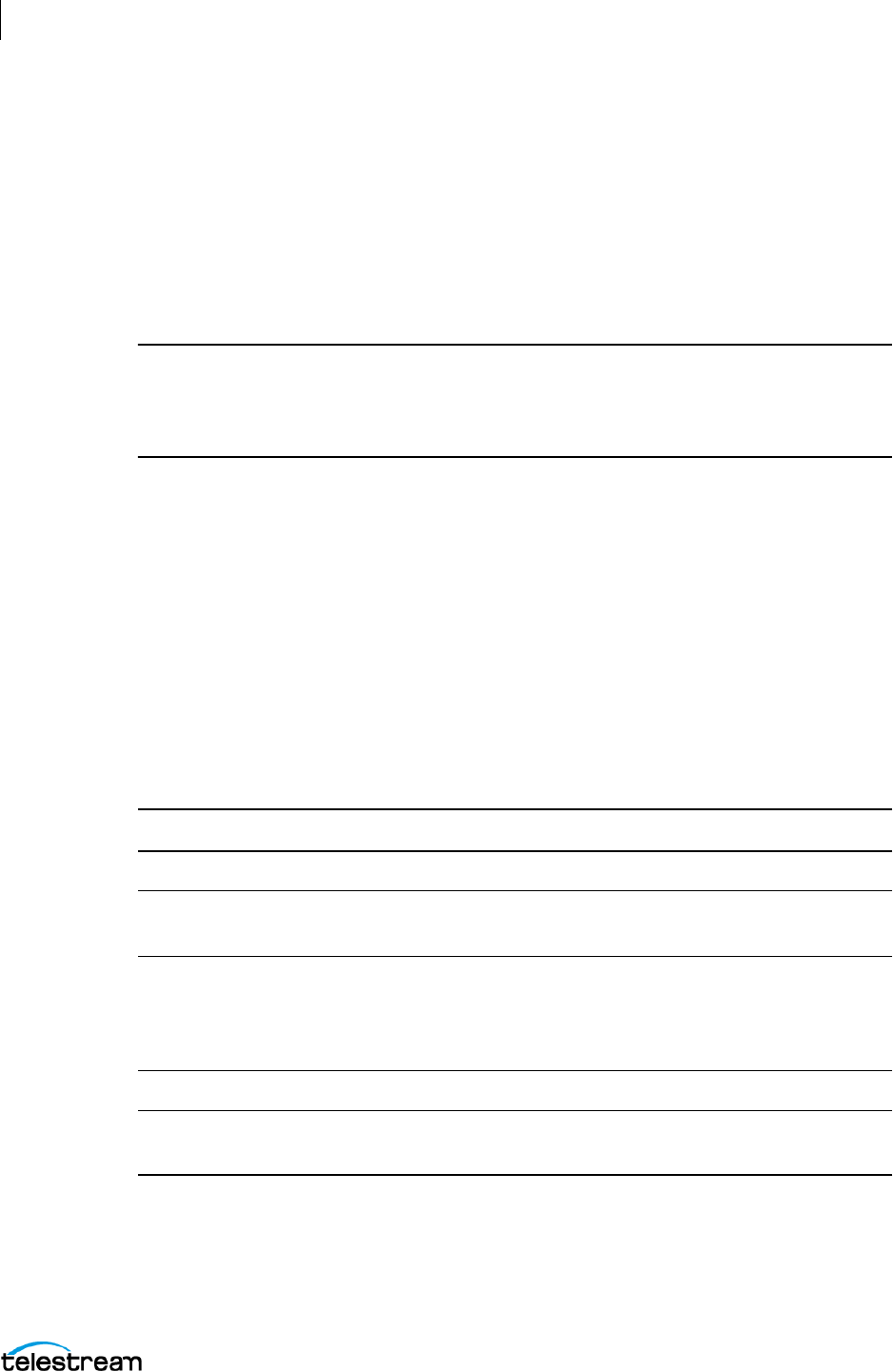
Windows in ScreenFlow
The Properties Window
114
ScreenFlow User Guide
final mix. When the pan control is in the middle (0%), the input channel is mixed equally
to both left & right output channels. When the pan is at -100% (all the way to the left),
the input channel is being mixed only to the left output channel. If it is 100% (all the
way to the right), the input channel is being mixed only to the right output channel. If
the pan is set to -50%, 100% of input channel will be sent to the left channel, which 50%
will be sent to the right. This is particularly useful when the ScreenFlow is using two
microphones: one can slightly favor each channel. When a stereo media is imported
into ScreenFlow, its audio mix will be setup by default to have the left input channel at
-100% pan, and the right input channel at 100% pan.
Note: This setup emulates how earlier versions of ScreenFlow behave: the left input
channel is sent to the left output channel, and the right input channel is sent to the
right output channel. Please be aware that the 'Mix to Mono' feature has been
removed: this functionality can now be achieved with audio mixer's pan feature.
Slider
The slider and accompanying text field provide the volume adjustment for the input
channel. The volume is 100% by default, but can be boosted beyond or below this
value.
See Adjusting Recorded App Audio.
Video Motion Properties
In the Properties window, the Video Motion Properties tab contains the following
controls:
Table 5. Video Motion Properties Controls
Control Description
Duration Enter the duration of the Video Motion.
Effect Check to enable effects, then select the type of effect: Gravity,
Spring, or Pulse.
Lock to Check to lock the Video Motion to the Duration entered in the
Duration field. When you check this box, the Duration field is
disabled, preventing you from making changes until you
unlock it.
Preview Click the triangle to see a preview of your Video Motion.
Apply to Check (individually) to adjust the position, scale, or rotation of
the clip after the action to see the effect.
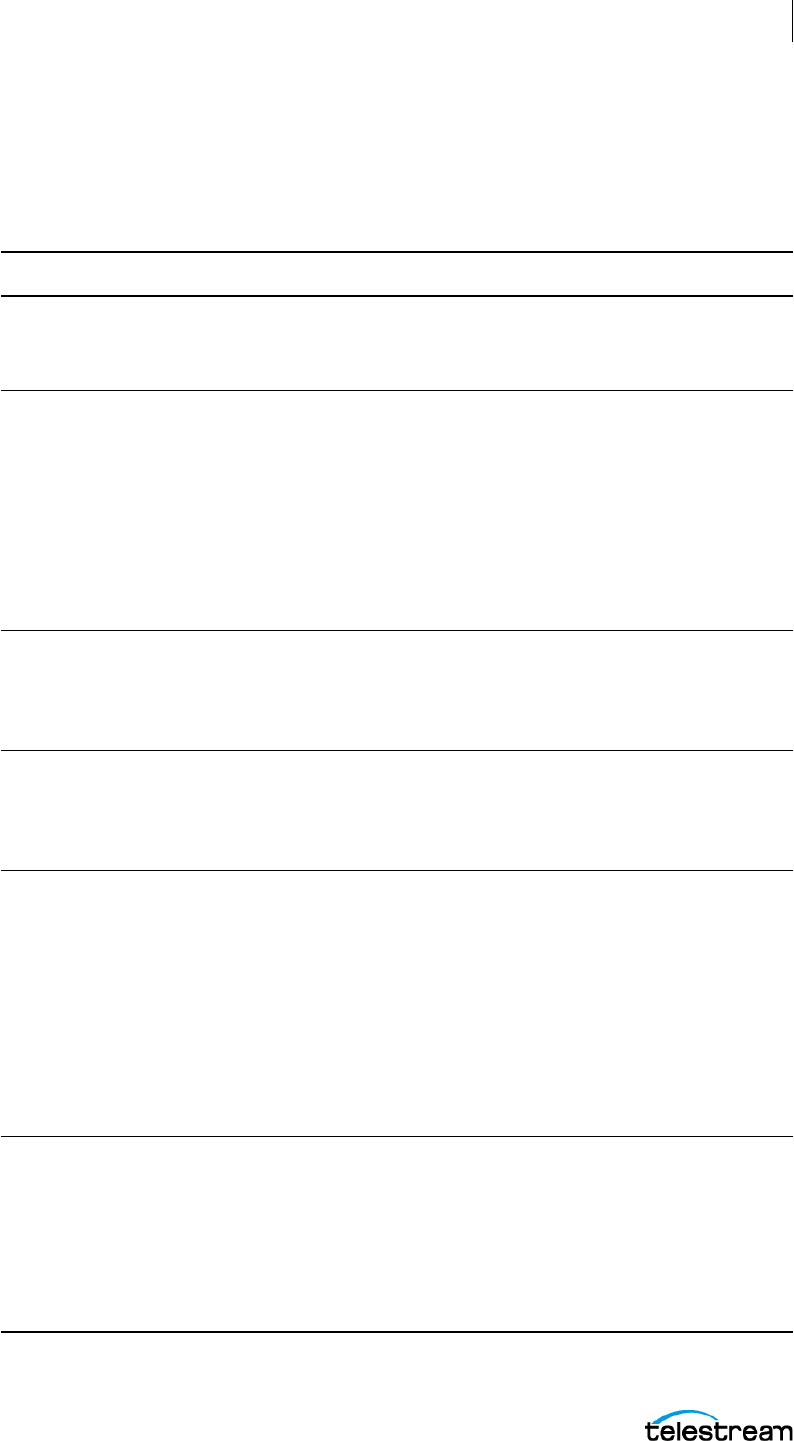
Windows in ScreenFlow
The Properties Window
115
ScreenFlow User Guide
Screen Recording Properties
In the Properties window, the Screen Recording Properties tab contains the following
controls:
Table 6. Screen Recording Properties Controls
Control Description
Show Mouse Pointer When checked, any mouse pointer icon activity in the screen
recording is displayed. When unchecked, the mouse pointer
is hidden.
Pointer Zoom When Show Mouse Pointer is checked, use the slider to specify
the size of the mouse icon in the screen recording.
Use the slider or manually enter the value to specify the
percent of increase to apply.
Often it can be difficult to distinguish or track the mouse in a
screencast, particularly if the video has been significantly
resized. Increasing the pointer zoom value increases the size
of the mouse icon, making it easier to follow.
Click Effect Select None > Radar > Invert from the popup menu to create a
visual effect when you click the mouse. Radar displays an
animated red circle with each click. Invert changes the cursor
from black to white and back with each click.
Attention Effect Select Circle to pick an effect to display over the mouse
pointer during their screen recording. Set the size, fill color,
border width, edge color and edge blur for the effect. The
effect can be turned on & off using a screen recording action.
Pointer Select Default > Circle-Light > Circle-
Dark > Square > Choose Image from the popup menu to
change the pointer image.
The Circle - Dark option is particularly good for iOS
screencasts.
When you select Choose Image, ScreenFlow displays an Open
dialog, so you can navigate and select an image file. When
selecting a custom image, you also specify the cursor hot spot
position.
Opacity Specifies the degree of pointer translucency.
Use the slider to set the value or enter it manually (0 to 100%).
The greater the value, the more opaque the pointer. If the
value is set to zero, the pointer is invisible. Default: 100%.
This can be used in a screen recording action to fade the
pointer in or out.
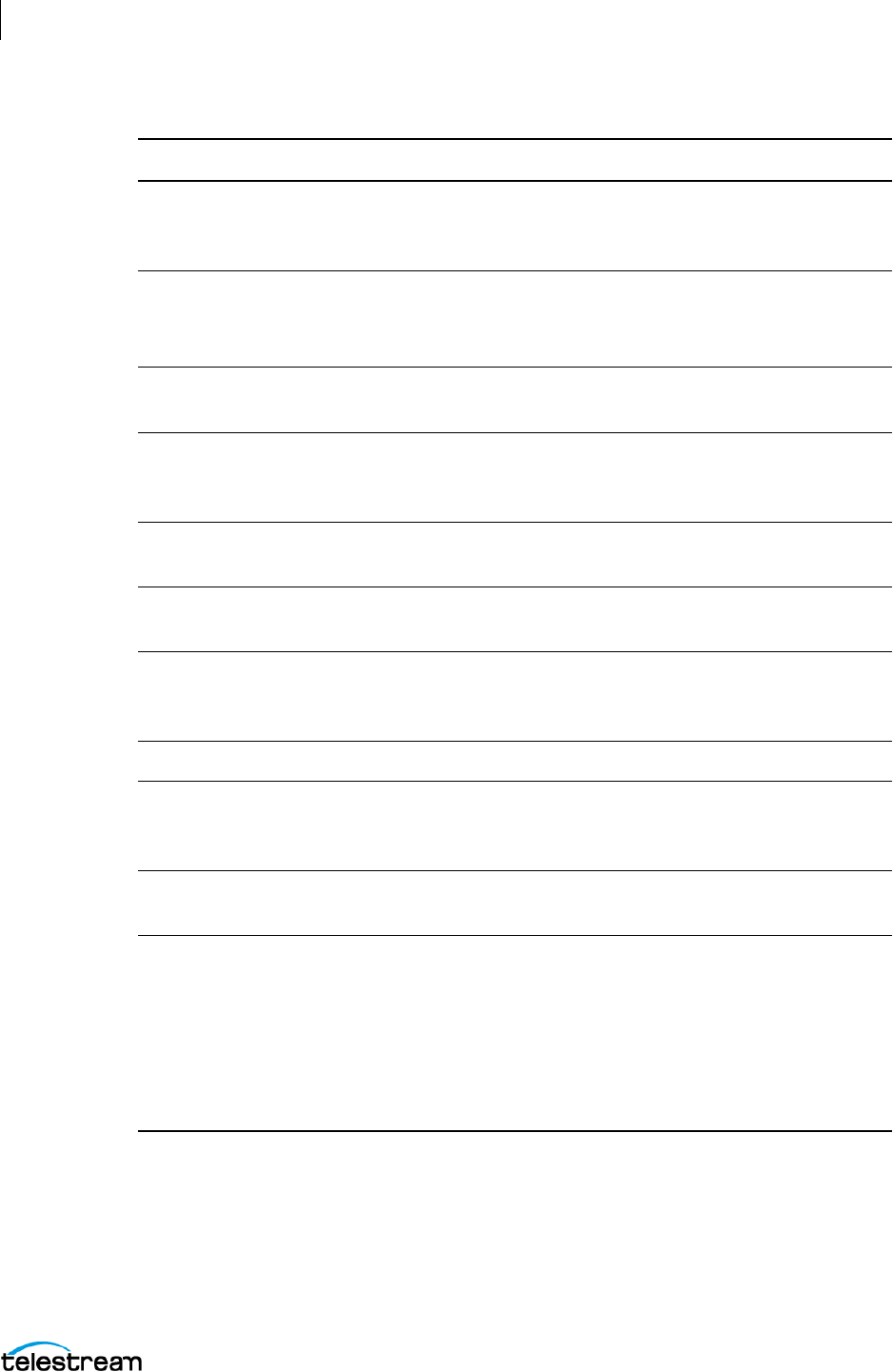
Windows in ScreenFlow
The Properties Window
116
ScreenFlow User Guide
See Configuring Screen Recording Properties.
Callout Properties
In the Properties window, the Callout Properties tab contains the following controls:
Smoothing Increases the smoothness of the motion of the mouse cursor
as you record.
Use the slider to set the value or enter it manually (0 to 100%).
Sound on Click Check to generate a sound when the mouse button is
pressed.
Click the disclosure triangle to display Sound on Click details.
Volume Specify the volume level of the mouse click sound (from 0 to
5,000%). Use the arrows to set the value or enter it manually.
Click Sound Click Choose to display an Open dialog, and navigate to and
select any custom sound file, to play a unique sound file every
time the mouse is clicked.
Show Keystrokes Check to display the characters (one at a time) of keyboard
characters typed during the recording.
Show All Keys Check to display all keystrokes typed during the recording,
including the modifier keys.
Show Only Modifier
Keys
Check to display modifiers used in hotkey commands,
function keys, and the arrow keys that were pressed during
the recording.
Height and Position Specify the height and position of the font.
Font Button Click to display the font settings and specify all font
information for the characters shown in the keyboard
characters display.
Width Slide the slider right or left to adjust the keystroke bar
horizontally. You can also enter a value into the numeric box.
Attached To Clip When checked, the keystroke bar will be attached to the
screen recording clip, and will be affected by any changes
made to the recording. This includes scaling, cropping, and
any changes made to the canvas crop.
When unchecked, the keystroke bar will only be affected by
changes to canvas crop, and will remain centered to the
canvas if any changes are made.
Table 6. Screen Recording Properties Controls
Control Description
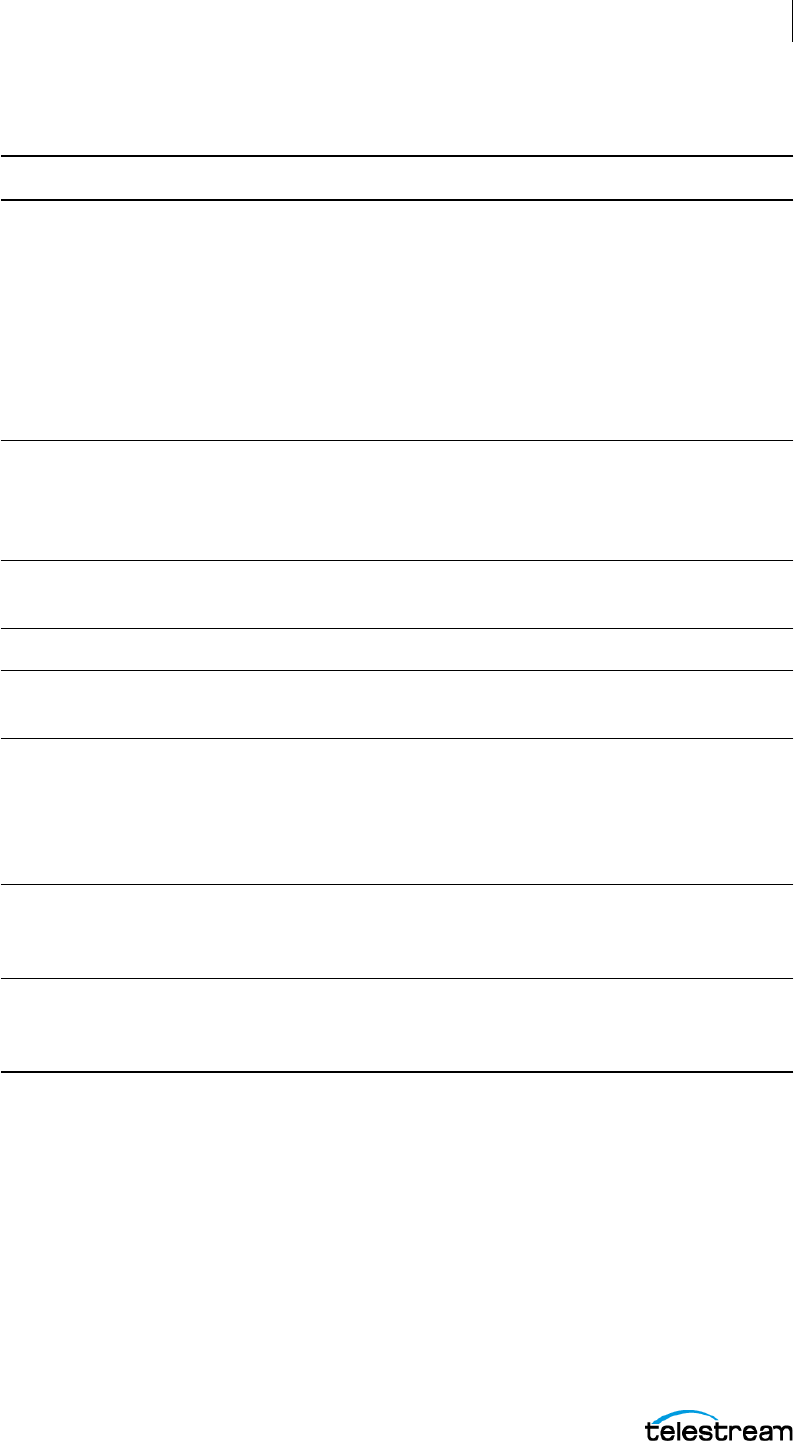
Windows in ScreenFlow
The Properties Window
117
ScreenFlow User Guide
Table 7. Callout Properties
Control Description
Highlight Select how to highlight an area of the recording: mouse
pointer highlights a circular space around the mouse pointer.
Foreground Window highlights the window which is in the
screen recording. Mouse and foreground highlights can only
be added to screen recording clips.
Freehand callouts can be added to video clips, image clips,
and screen recording clips.
See Adding Freehand Callouts to Images.
Opacity Use the slider to control the percent of opacity of the space
outside the callout. A value of 0 makes the surrounding area
entirely visible; a 100% value makes the surrounding area
invisible.
Blur Use the slider or manually enter the pixel value to blur the
callout area (range: 0-16).
Blur Background Check to blur the area outside of the callout.
Zoom Up Use the slider or manually enter the percentage value to
magnify the area inside the callout (range: 0 to 500%).
Border Use the slider or manually enter the value to create a gradual
loss in opacity as the shadow spreads from the center (range:
0-300). This feature does not apply to freehand callouts. This
is not a zoom control, but instead it adds more area to the
callout.
Outline Enter the value (in pixels) to create an outline around the
callout area (range: 0 to 59.) Click the color box to change the
color of the outline.
Shadow Check to add a shadow behind the callout. Use the slider or
manually enter the value to create a gradual change in size as
the shadow spreads from the center (range: 0-80).
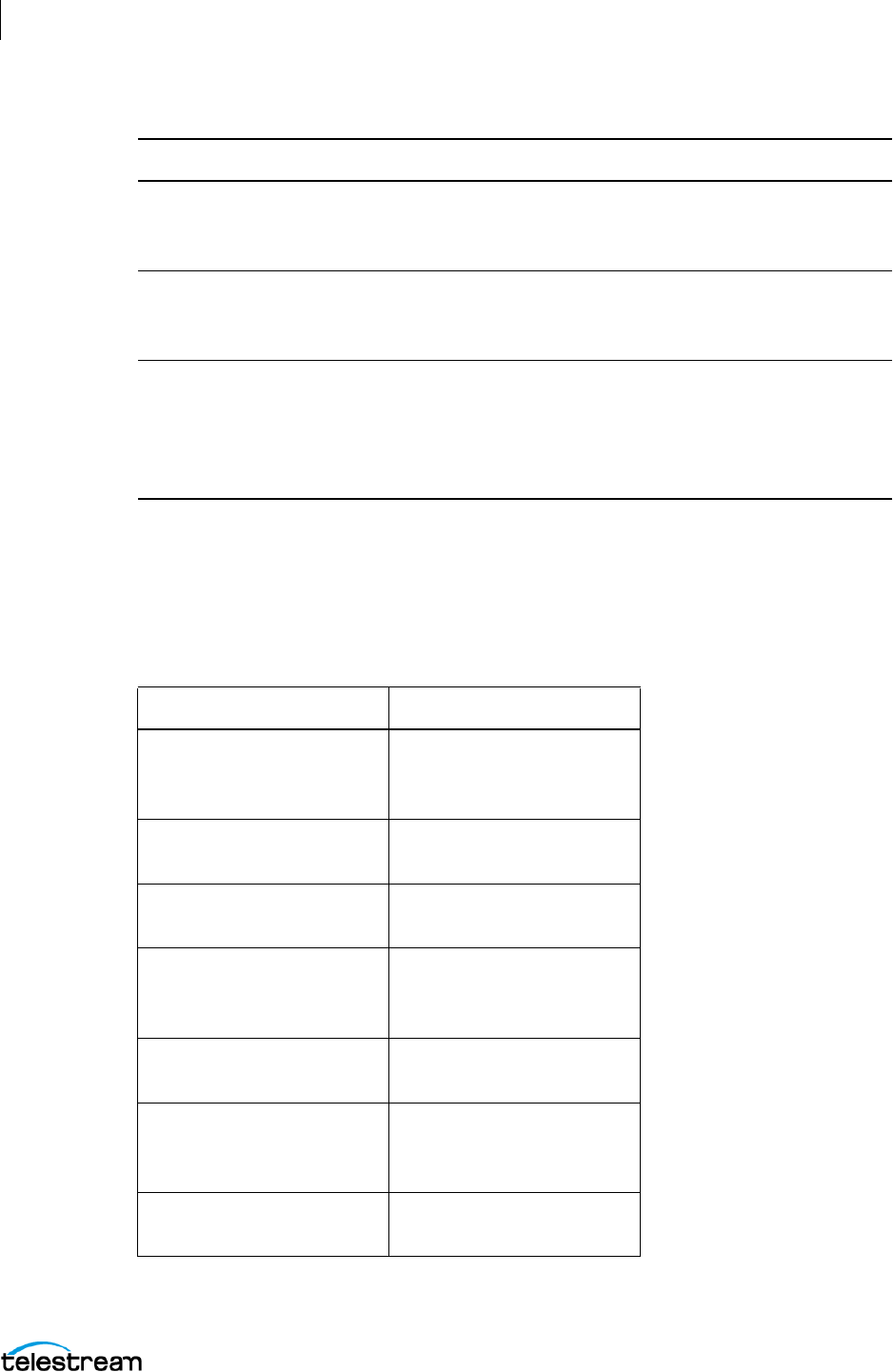
Windows in ScreenFlow
The Properties Window
118
ScreenFlow User Guide
See Configuring Callout Properties.
Touch Callout Properties
In the Properties window, the Touch Callout tab contains the following controls:
Feather Specify the blend value (in pixels) to apply to the callout
border to create a smooth transition between the callout area
and the surrounding space (range: 0-20).
Round Applies to foreground window callouts only. Specify the
round-off value (in pixels) of the callout edge to create a more
gentle appearance (range: 0-59).
Build Specify the transition time of the callout, in seconds, up to 2
decimal places, and from 0 to 4 seconds. Duration In
determines the amount of build-in time to reach the full
effect of the callout. Duration Out determines the amount of
build-out time to return to normal.
Table 7. Callout Properties
Control Description
Table 8. Touch Callout Properties
Control Description
+Action Modifies video or
recording properties over
time.
Count Sets the number of touch
callout areas on-screen.
Fill/Color When Fill is checked, you
can determine the fill color.
Outline/Color When Outline is checked,
you can determine the
outline color.
Size The slider determines the
size of the touch callout.
Spacing The slider determines the
amount of space between
the touch callouts.
Opacity Determines the opacity of
the touch callout.
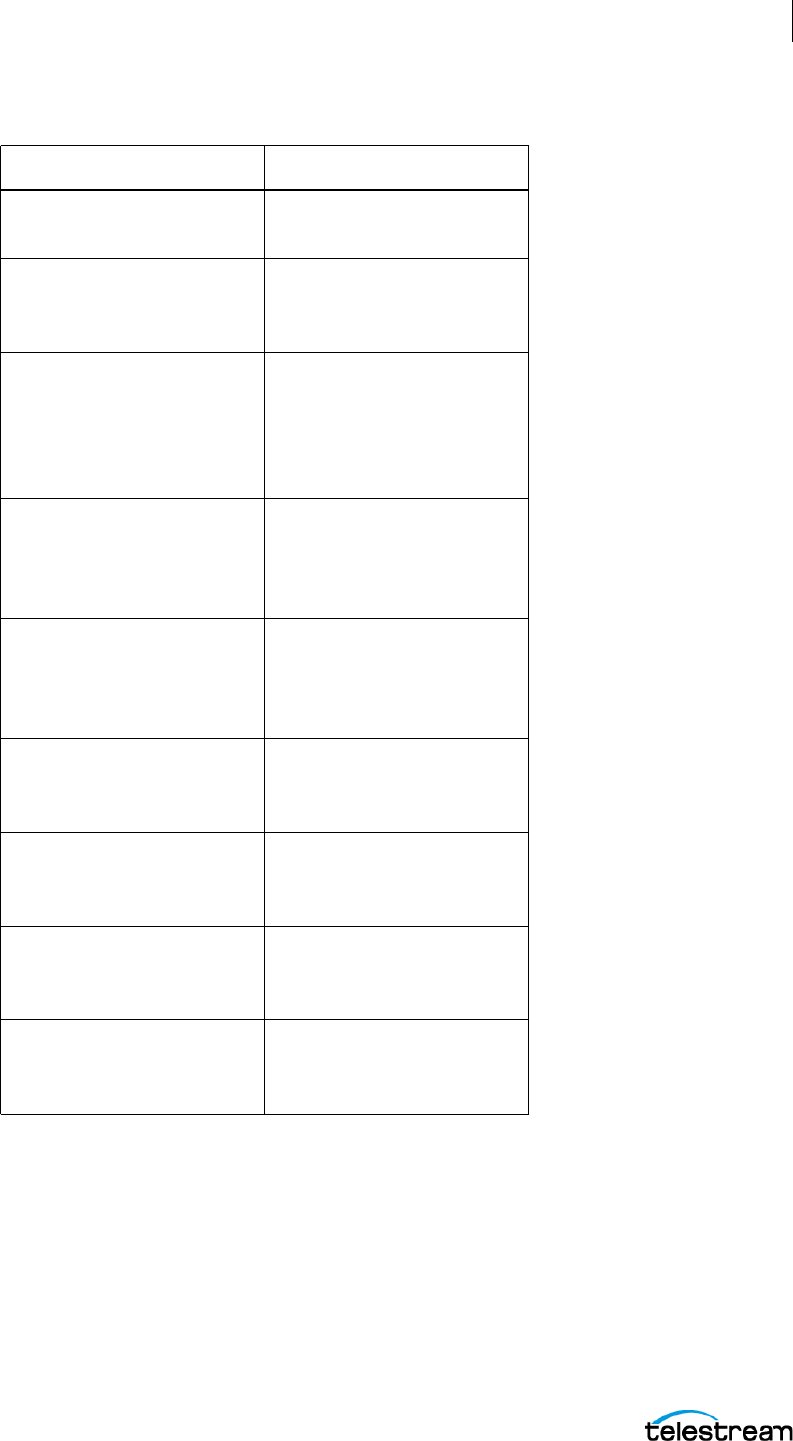
Windows in ScreenFlow
The Properties Window
119
ScreenFlow User Guide
Annotations Properties
Annotations are used for displaying simple shapes in your screencast.
In the Properties window, the Annotations Properties tab contains the following controls:
Rotation Determines the rotation of
the touch callout.
Callout Has End State When checked, you can
determine the end state
for the touch callout.
Wait When checked, you can
determine how long to
wait before ScreenFlow
starts the animation to the
end state.
Curve Determines the type of
animation for displaying
and removing the touch
callout.
Animates Values to End
State
When checked, you can
animate various values of
the touch callout until its
end point.
Size The slider determines the
end-state size of the touch
callout.
Spacing The slider determines the
end-state spacing of the
touch callout.
Opacity The slider determines the
end-state opacity of the
touch callout.
Rotation The slider determines the
end-state rotation of the
touch callout.
Table 8. Touch Callout Properties
Control Description
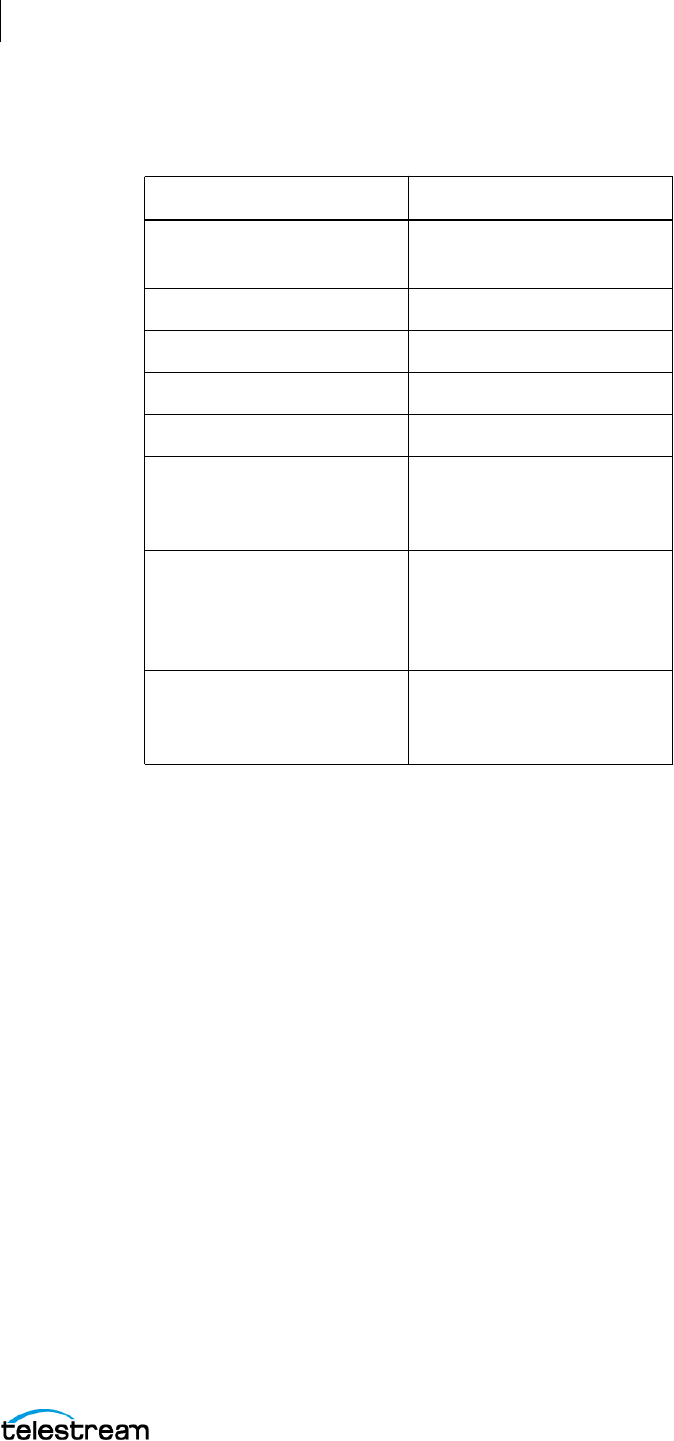
Windows in ScreenFlow
The Properties Window
120
ScreenFlow User Guide
Table 9. Annotations Properties
See Configuring Annotations Properties, and Adding an Annotation Clip.
Text & Titles Properties
Text boxes are clips which display blocks of text in your screencast. Text clips behave
like image clips—they are static images which play for the length of time you specify.
You can also apply video properties and transitions to text clips, along with Text
Animations.
Text clips can have the interesting property of per character animations for building in
and out the clip to the screen. These effects are commonly seen in other popular
applications. Once enabled, a default effect is selected, with a default duration of 0.75
seconds. You can switch between different effects.
In the Properties window, the Text Properties tab contains the following controls:
Control Description
(+) Add annotations clip When clicked, adds an
annotation clip
Tool Palette Contains five drawing tools
Color Annotation color picker
Opacity Slide to change opacity
Thickness Slide to change thickness
Shadow When checked, adds a
drop shadow. Slide to
change shadow thickness.
Outline When checked, adds an
outline. Slide to change
thickness. Color picker for
outline.
Endpoints Drop-down menus for
setting the annotations
clip endpoints
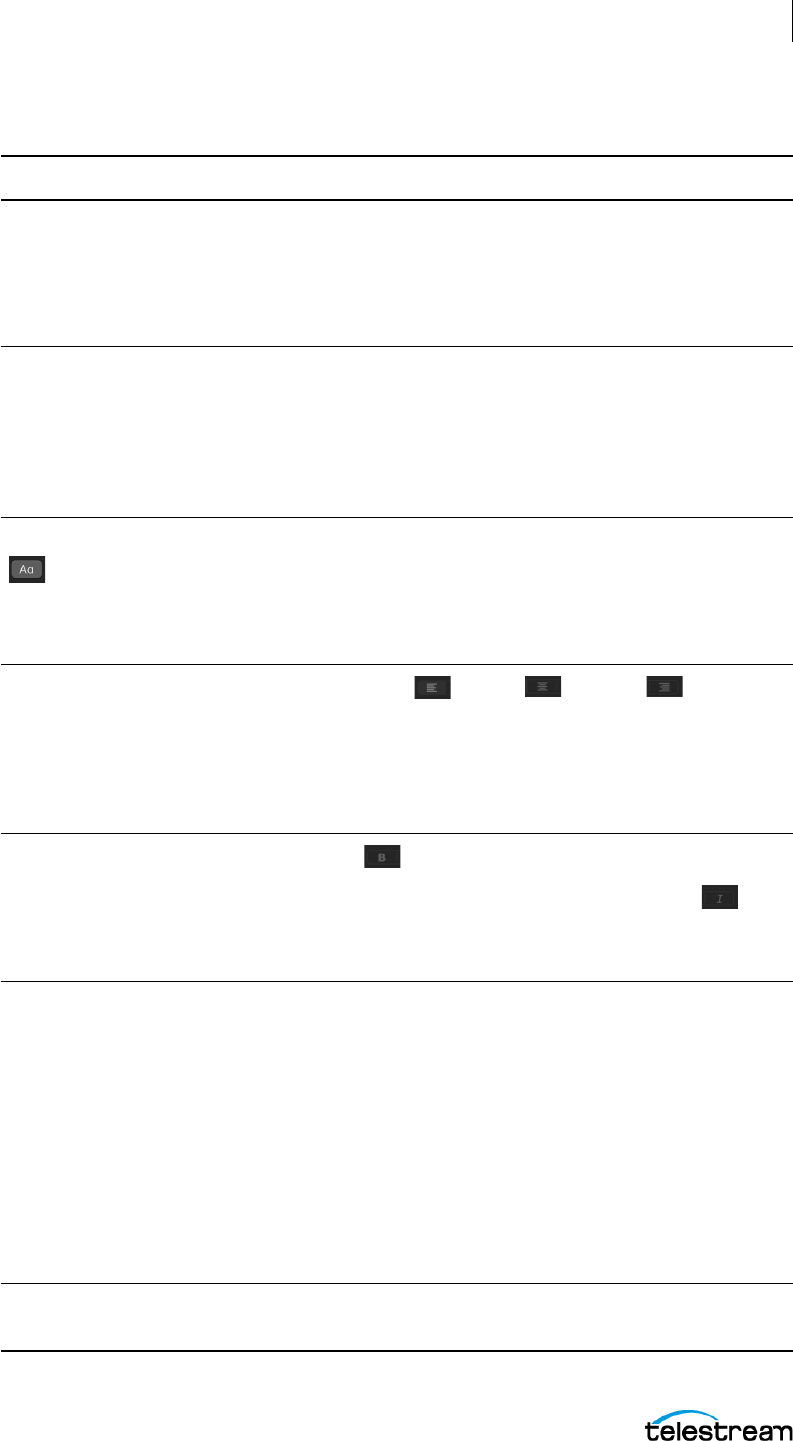
Windows in ScreenFlow
The Properties Window
121
ScreenFlow User Guide
Table 10. Text Properties Controls
Menu Item Description
Font drop-down
menu
When clicked, ScreenFlow displays the list of fonts on your
computer. If you selected the whole text box, ScreenFlow
applies the font selected to the entire text box. If you selected
a range of characters in the text box, ScreenFlow applies the
font only to the characters selected.
Size drop-down
menu
When clicked, ScreenFlow displays available font sizes, in
pixels, ranging from 9 to 288. If you selected the whole text
box, ScreenFlow applies the size selected to the entire text
box. If you selected a range of characters in the text box,
ScreenFlow applies the size only to the characters selected.
Select Font > Show Fonts to enter a custom size.
Font selection button When clicked, ScreenFlow displays the list of fonts on your
computer. If you selected the whole text box, ScreenFlow
applies the font selected to the entire text box. If you selected
a range of characters in the text box, ScreenFlow applies the
font only to the characters selected.
Alignment buttons
When either the Left , Center , or Right alignment
button is clicked, ScreenFlow aligns the text in the text box
accordingly.
This property can affect single or multiple selected
paragraphs.
Font style buttons
When the Bold button is clicked ScreenFlow sets the
selected text or text box in boldface. When the Italic
button is clicked ScreenFlow sets the selected text or text box
in italic.
Fill checkbox Check to choose Solid Color | Image | Gradient from the
popup menu. For solid color, select a color from the color
wheel. The color is applied to the entire text box (if none or all
text is selected) or a range of selected characters. For Image,
ScreenFlow displays an Open dialog, so you can navigate to
and select any custom image file. Deselect the checkbox to
remove the file. This can be used with Outline to create
characters which are transparent. Applying an image uses the
color patterns represented in the image to fill the text. These
properties are applied to the entire text box (if none or all text
is selected) or a range of selected characters.
Fill type drop-down
menu
When clicked, ScreenFlow lists the fill types available. Select
Solid Color, Image, or Gradient.
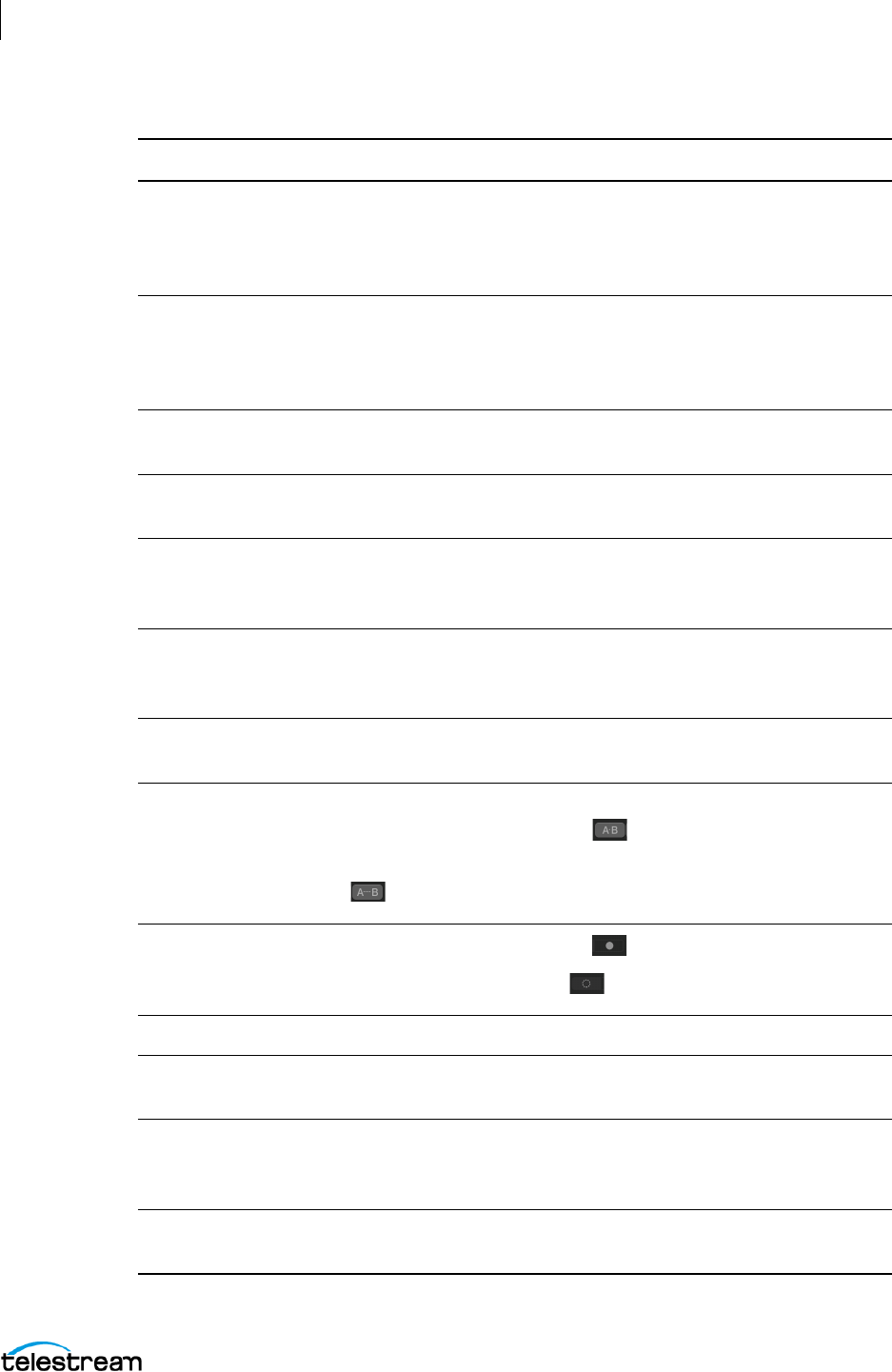
Windows in ScreenFlow
The Properties Window
122
ScreenFlow User Guide
Fill color box When clicked, ScreenFlow opens the color field dialog.
Choose a color for your text. For Gradient, click in the top half
and select a color, then click in the bottom half and select the
second color.
Outline checkbox Check to outline the text. If you selected the whole text box,
ScreenFlow applies the outline to the entire text box. If you
selected a range of characters in the text box, ScreenFlow
applies the outline only to the characters selected.
Outline slider Use the slider to set the width of the outline, in pixels, ranging
from 0 to 15.
Outline size field As an alternative to the Outline slider, enter a number, from 0
to 15, to set the size of the outline in pixels.
Outline color box Click to select the color of the outline. Select the color,
brightness, and opacity. Brightness is only available on the
Color Sliders pane of the Show Colors tool.
Line Spacing drop-
down menu
When clicked, ScreenFlow displays a list of the line spacings
available. Select a line spacing. Selecting Multiple, activates
the At: selection field
At: selection field Click the up or down arrows to set the location of the selected
multiple line spacing.
Kerning buttons To tighten the kerning of the selected text or text box, click
the Tighten Kerning button . To loosen the kerning of the
selected text or text box, click the Loosen Kerning button
.
Bullets buttons
Click the filled circle button to add a bullet to text. Select
the unfilled circle button to remove a bullet.
Backdrop checkbox Check to add a backdrop.
Type drop-down
menu
When clicked, ScreenFlow displays a list of backdrop types.
Select Solid Color or Image Fill.
Color box Click to select the color of the backdrop. Select the color,
brightness, and opacity. Brightness is only available on the
Color Sliders pane of the Show Colors tool.
Round slider Use the slider to specify the value in pixels to smooth the
edge of the text box, ranging 0 to 100. The default is 20.
Table 10. Text Properties Controls
Menu Item Description
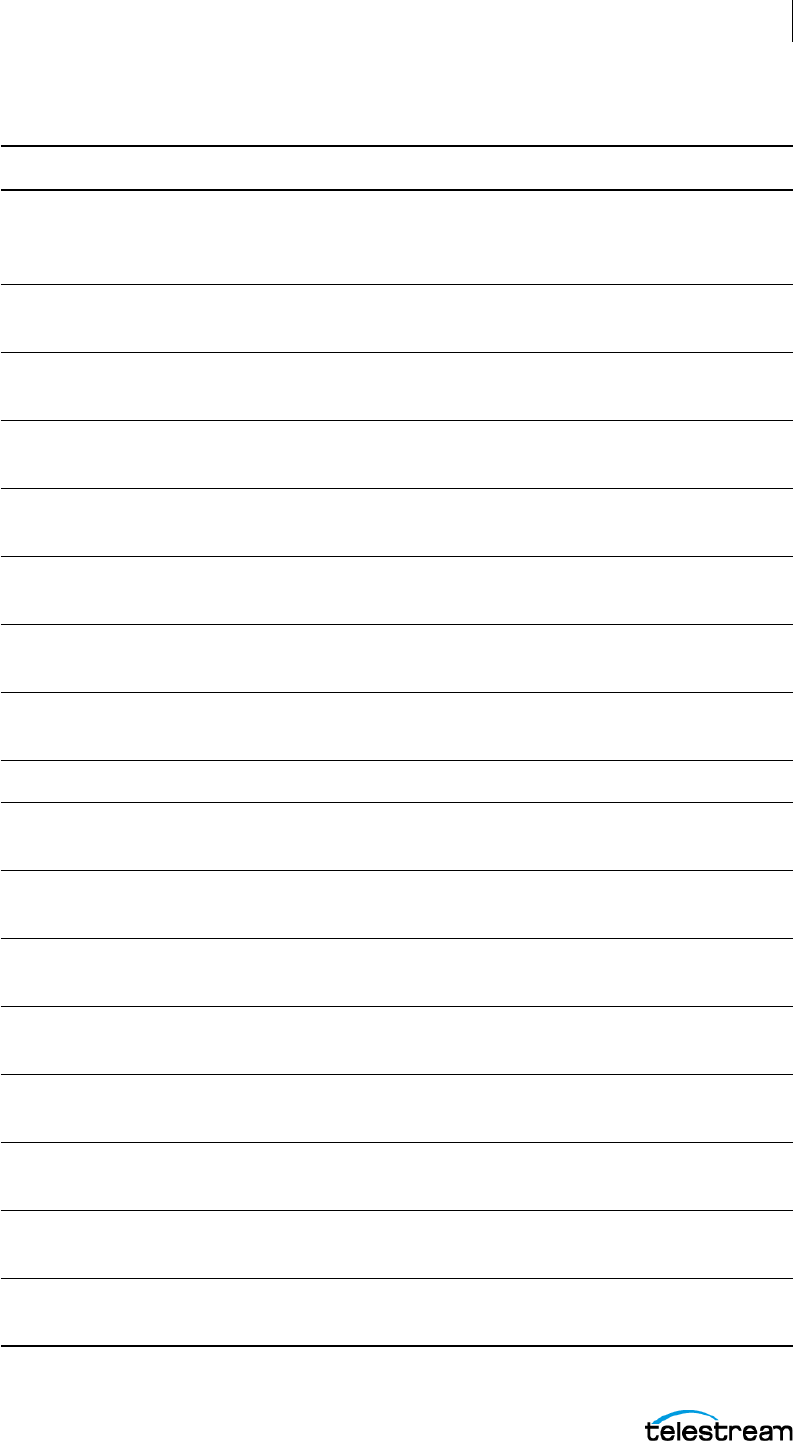
Windows in ScreenFlow
The Properties Window
123
ScreenFlow User Guide
Round size field As an alternative to the Round slider, enter a number to
specify the value in pixels to smooth the edge of the text box,
ranging 0 to 100. The default is 20.
Margin slider Use the slider to enter the size, in pixels, of the backdrop,
ranging 0 to 300. The default is 25.
Margin size field As an alternative to the Margin size field, enter the size, in
pixels, of the margin, ranging 0 to 300. The default is 25.
Build In Animation
checkbox
Check to enable Build In Animation. Click the arrow on the
right to view the action.
Type drop-down
menu
When clicked, ScreenFlow displays a list of Build-In
animations. Select the type desired.
Duration slider Use the Duration slider to set the duration of the Build-In
animation.
Duration field As an alternative to the Duration slider, enter a number to
determine the duration in seconds.
Build drop-down
menu
When clicked, ScreenFlow displays a list of Build-In options.
Select the option desired.
Directionality arrows Click an arrow to determine the direction of text animation.
Distance slider Drag the Distance slider to determine the distance traveled
by the text.
Distance percentage
field
As an alternative to the Distance slider, enter a number to
determine the distance in a percentage,
Overlap slider Drag the Overlap slider to determine the amount of overlap
between text elements.
Overlap percentage
field
As an alternative to the Overlap slider, enter a number to
determine the amount of overlap by percentage.
Easing drop-down
menu
When clicked, ScreenFlow displays a list of available easing
types. Select the type desired.
Fade Characters
checkbox
Check to fade characters on Build In.
Build Out Animation
checkbox
Check to enable Build Out Animation. Click the arrow on the
right to view the action.
Type drop-down
menu
When clicked, ScreenFlow displays a list of available Build-Out
types. Select the type desired.
Table 10. Text Properties Controls
Menu Item Description
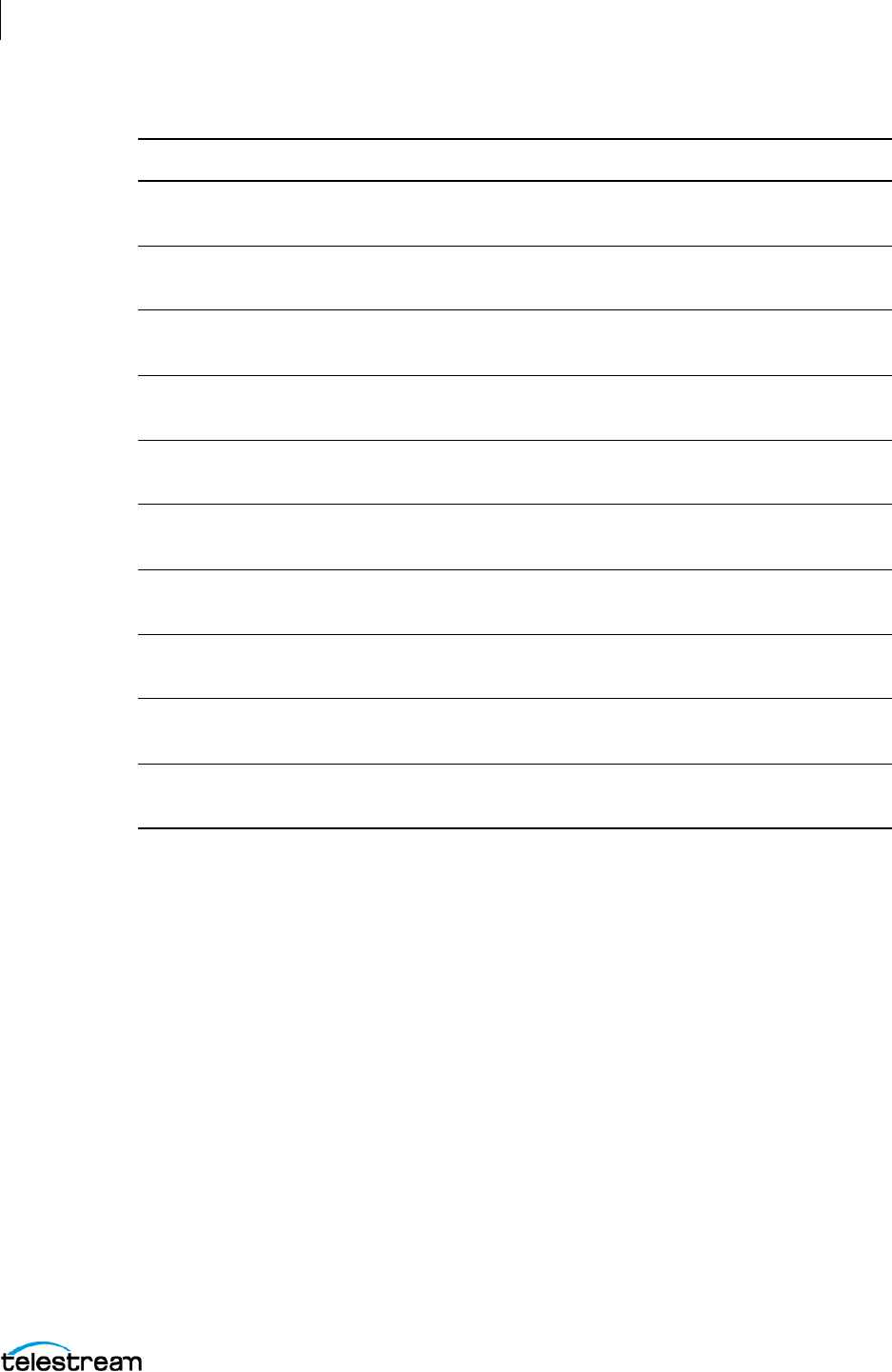
Windows in ScreenFlow
The Properties Window
124
ScreenFlow User Guide
See The Properties Window and Adding and Configuring a Text Clip.
Media Library
The media library contains all the clips for a ScreenFlow document. When you record a
source with ScreenFlow, ScreenFlow records the input to a file in a media folder.
ScreenFlow then creates a clip in the Media Library that points to the file. When you
import a media file located on any drive, ScreenFlow leaves the media file on its drive,
but creates a clip for the media file in the Media Library.
The Stock Media Library is a large collection of stock audio, video, and graphics files you
can use in ScreenFlow documents. The Stock Media Library is integrated into the
ScreenFlow Media Catalog. ScreenFlow stores downloaded Stock Media files here:
~/Movies/ScreenFlow Data.
When you add properties to a clip or change them, ScreenFlow stores these properties
in the clip. ScreenFlow doesn’t alter the associated media file.
Duration slider Drag to set the duration of the Build-Out Animation, in
seconds.
Duration field As an alternative to the Duration slider, enter a number to
determine the Build-Out Duration, in seconds.
Build drop-down
menu
When clicked, ScreenFlow displays a list of available Build-Out
types. Select the type desired.
Directionality arrows Click an arrow to determine the direction of the Build-Out
animation.
Distance slider Drag the Distance slider to determine the distance traveled
by the text.
Distance percentage
field
As an alternative to the Distance slider, enter a number to
determine the distance in a percentage,
Overlap slider Drag the Overlap slider to determine the amount of overlap
between text elements.
Overlap percentage
field
As an alternative to the Overlap slider, enter a number to
determine the amount of overlap by percentage.
Easing drop-down
menu
When clicked, ScreenFlow displays a list of available easing
types. Select the type desired.
Fade Characters
checkbox
Check to fade characters on Build Out.
Table 10. Text Properties Controls
Menu Item Description
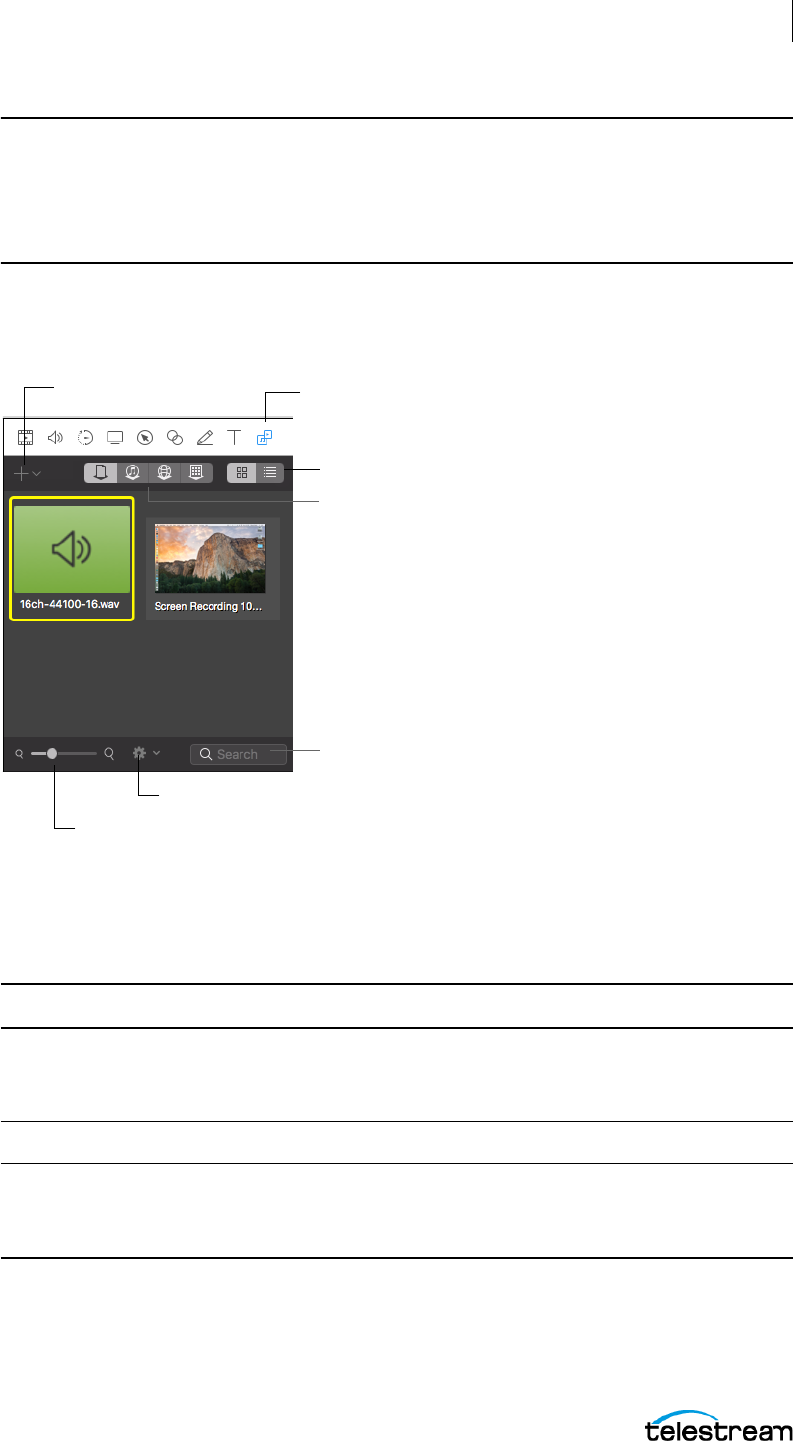
Windows in ScreenFlow
The Properties Window
125
ScreenFlow User Guide
Note: In the version of ScreenFlow sold on the Telestream Web Store, you can edit a
media file outside ScreenFlow that already has a clip associated with it. ScreenFlow
adds a refresh button to the associated clip in the Media Library. When you click the
refresh button, ScreenFlow re-associates the clip with the edited media file.
This feature is not present in the Mac App Store version of ScreenFlow.
In the Properties window, the Media Library tab contains the following controls:
Figure 5. Media Library Tab.
Use the buttons and other controls on the Media Library tab to perform tasks, as
described in Table 11.
Table 11. Media Library Controls
Control Description
Add Media button Click to browse local drives or network servers for media to
import into your document. This may include video files,
audio files, and still images.
Display Type Buttons Click these buttons to select between thumbnail and list view.
Source Buttons Click these buttons to select between Media Files, iTunes, and
Global Library. Media added to the Global Library can be used
by any ScreenFlow document.
Search field
Add media button
Source buttons
Zoom slider
Media Library
Gear button
Display Type buttons

Windows in ScreenFlow
The Properties Window
126
ScreenFlow User Guide
See Navigating the Media Library, Deleting All Unused Media, Viewing Clip Metadata, and
Properties.
Search To search for a file, enter a search text and press the Enter key.
Gear Button Click the Gear button to select either Remove All Unused
Media or Show Duration Overlays. Show Duration Overlays
displays the duration value on the media icon image.
Zoom Slider Use the slider to change the display size of the media
thumbnails.
Table 11. Media Library Controls
Control Description

127
Menus
You can find many of the controls for ScreenFlow in the ScreenFlow menus.
Topics
■ ScreenFlow Helper Menu
■ ScreenFlow Menu
■ File Menu
■ Edit Menu
■ Mark Menu
■ Clip Menu
■ Insert Menu
■ Actions Menu
■ Font Menu
■ Arrange Menu
■ View Menu
■ Window Menu
■ Purchase Menu (Telestream Web Store Only)
■ Help Menu
■ Editor Drop-Down Menu
■ The Media Library Context Menu
ScreenFlow Helper Menu
The ScreenFlow Helper menu is identified by the camera button in the status menu.
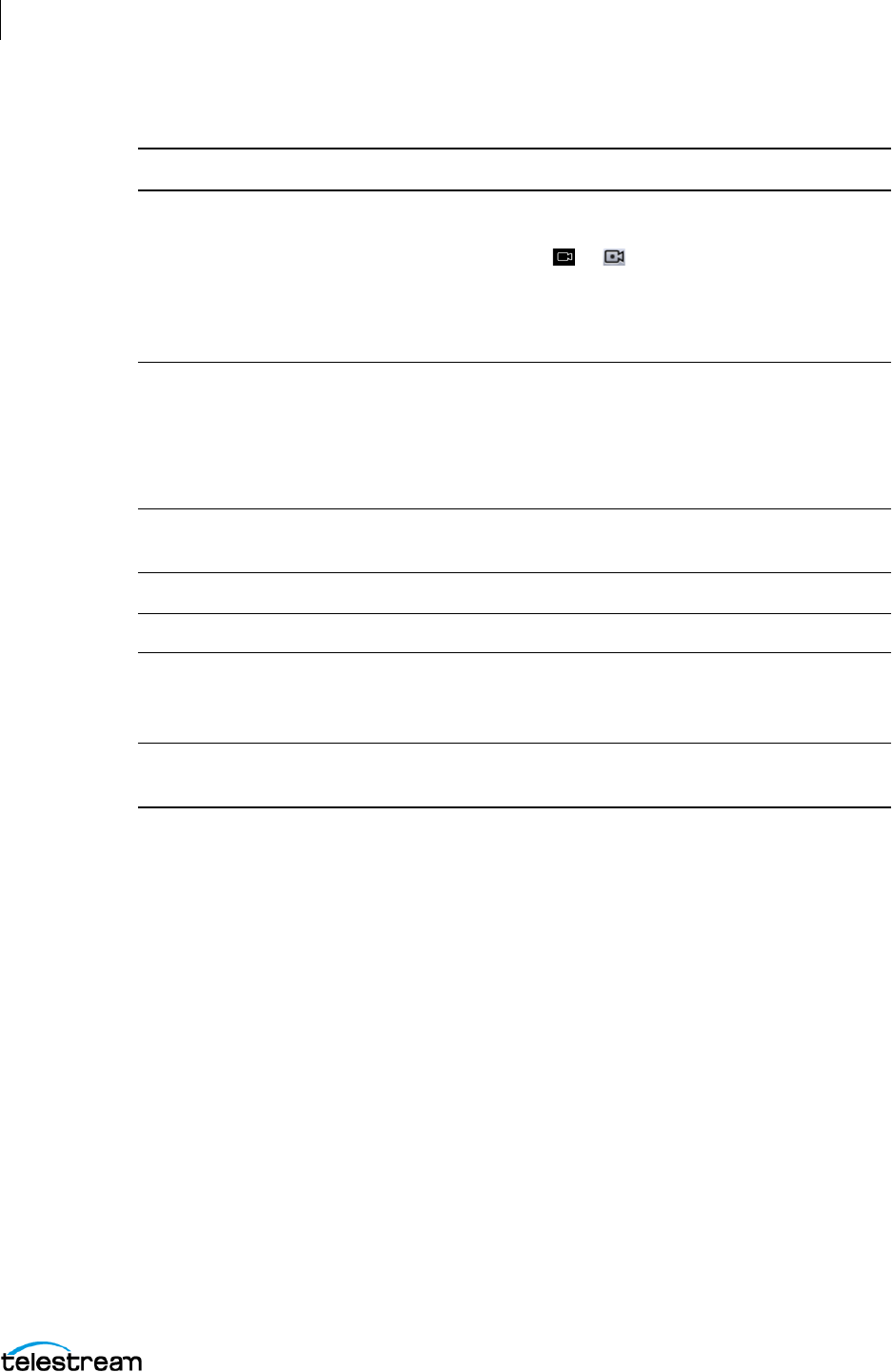
Menus
ScreenFlow Helper Menu
128
ScreenFlow User Guide
Table 1. ScreenFlow Helper Menu Items
Menu Item Description
Record/Stop Record
(Shift-Command-2)
Begins recording using the selected sources (display,
camera, microphone, and/or computer audio). The menu
icon changes from
to , advising you that
ScreenFlow is recording.
Select Stop Record or press Shift-Command-2 to stop
recording.
Pause/Resume Pauses recording. The menu icon changes to a blinking
dot, advising you that ScreenFlow has been paused.
Select Resume to continue recording.
To modify the hotkey for these commands, see General
Settings Tab.
Add Marker Allows you to mark a key moment location while you are
recording.
Configure Recording Displays the dialog for setting recording parameters.
Show Recording Monitor Displays the ScreenFlow recording monitor.
Hide Desktop Icons/Show
Desktop Icons
Hides all icons on your desktop if you prefer a less
cluttered background. Select Show Desktop to show them
again.
Quit ScreenFlow Closes the ScreenFlow and ScreenFlow Helper
applications.
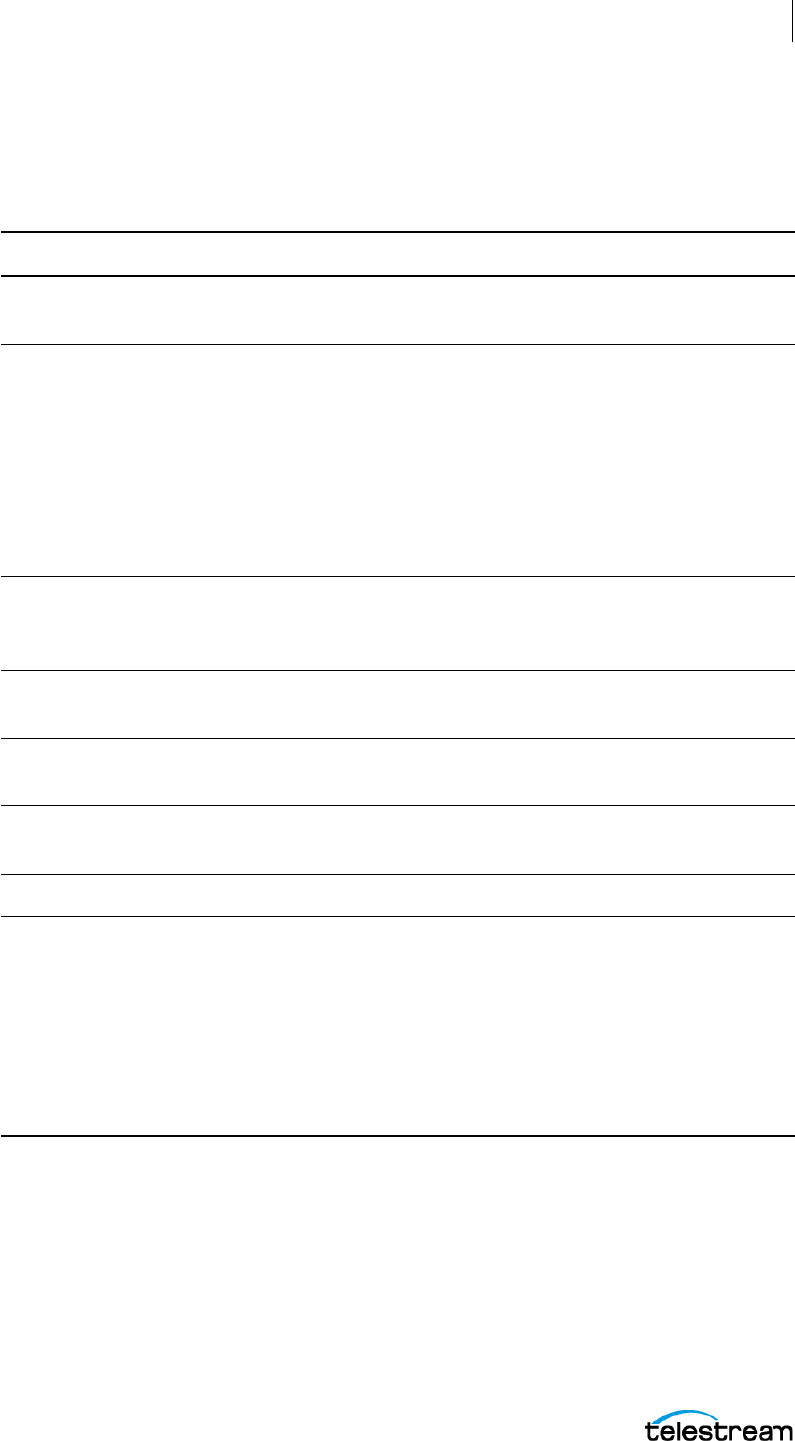
Menus
ScreenFlow Menu
129
ScreenFlow User Guide
ScreenFlow Menu
The ScreenFlow menu contains the following commands:
Table 2. ScreenFlow Menu Items
Menu Item Description
About ScreenFlow Displays a dialog indicating the version of ScreenFlow you are
running.
Check For Updates Note: This option is not available to users who purchased
from the Mac App Store. The App Store has its own update
procedure.
Checks the Telestream Online Store to determine if there is a
more recent version of ScreenFlow available. If so, you can
download it. To check for ScreenFlow updates automatically,
check the Check the Updates option in the General Settings
Tab.
Settings
(Command-,)
Opens the Settings dialog so that you can view and change
ScreenFlow settings. If the Settings dialog already is open,
ScreenFlow brings it to the front.
Services Displays Macintosh Services—none are implemented in
ScreenFlow.
Hide ScreenFlow
(Command-H)
Hides all ScreenFlow windows.
Hide others
(Option-Command-H)
Hides all windows which aren’t ScreenFlow windows.
Show All Shows all previously hidden windows.
Quit ScreenFlow
(Command-Q)
Closes all open documents and then quits.
If a document has not been saved, ScreenFlow displays a Save
dialog, so you can save the document before quitting.
If Launch ScreenFlow Helper at user login is checked in the
Settings General Settings Tab, ScreenFlow Helper keeps
running when you quit ScreenFlow.
See Configuring ScreenFlow Helper.
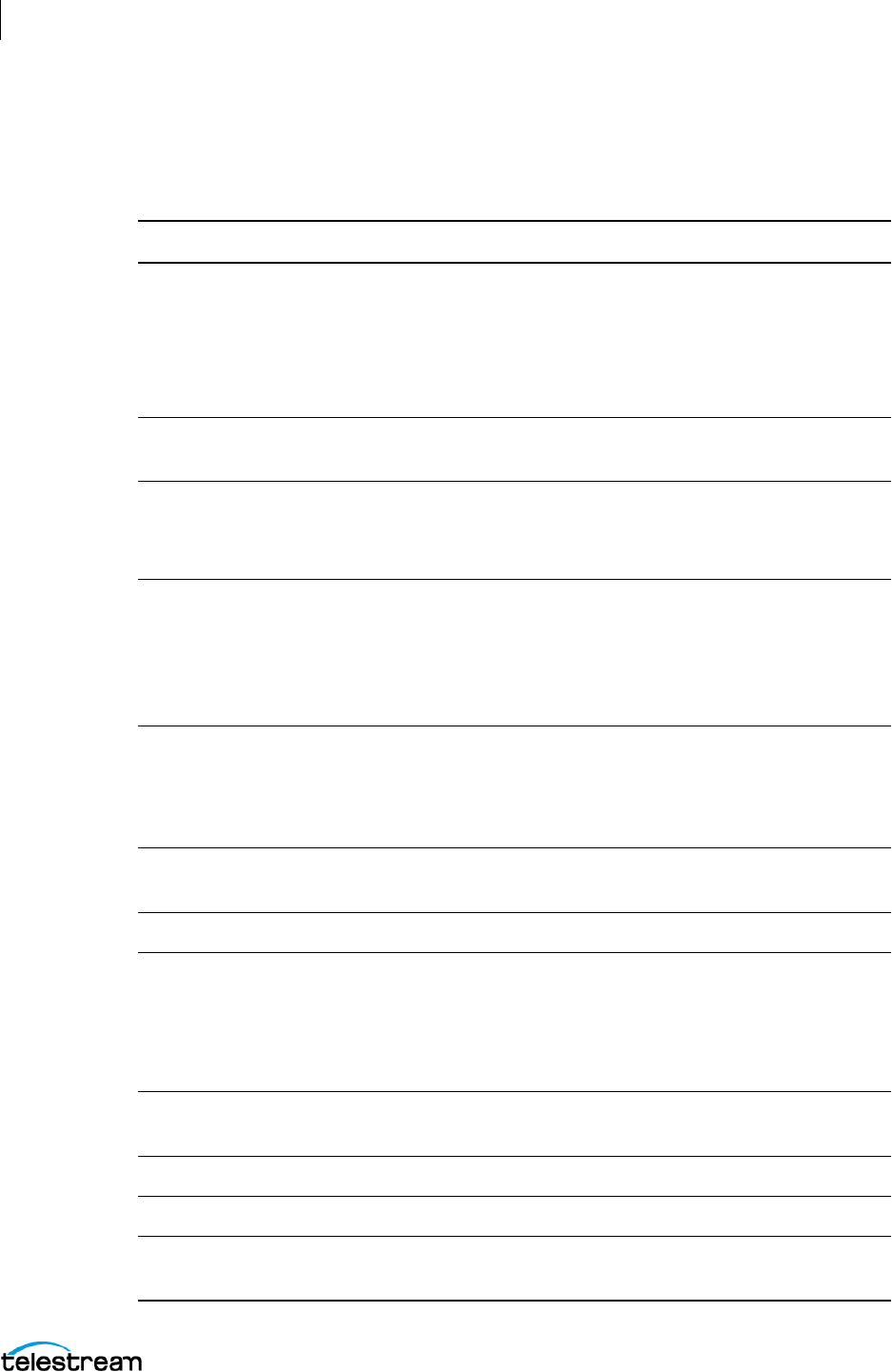
Menus
File Menu
130
ScreenFlow User Guide
File Menu
The File menu contains the following commands:
Table 3. File Menu Items
Menu Item Description
New
(Command-N)
Displays the New dialog for creating new clips or documents.
You can add clips to ScreenFlow documents, or discard the
clips.
See Creating a Document, Creating a Document from a
Template, Recording Clips, and Configuring a Recording.
Open
(Command-O)
Displays the Open dialog, so you can navigate and open a
ScreenFlow document that was saved earlier.
Open Recent Click to select from up to 15 recently accessed documents.
Every time you open or save a document, it is added to the
list. Select Open Recent > Clear Menu to reset the list.
Add Additional
Recording
(Shift-Command-R)
Displays the Add Additional Recording dialog. After recording
is complete, displays the Recording Complete dialog so you
can add the recording to a new document or to a currently-
open document.
See Adding Recordings to a ScreenFlow Document.
Close
(Command-W)
Closes the active ScreenFlow document.
If the document has not been previously saved, ScreenFlow
displays a Save As dialog, so that you can name the document
and save it before closing it.
Close Tab
(Command-W)
Closes the active tab on the timeline.
Save Saves changes to your ScreenFlow document.
Save As Saves your ScreenFlow document with a new name and /or
new location. Optionally, select a File Format from the drop-
down menu. You can set the default file format in the
Advanced tab on the Settings dialog.
See Default File Format.
Save As Template Saves your current document as a template. (See Creating a
Document Template).
Archive When clicked, ScreenFlow opens the Save Document dialog.
Document Settings Opens the screen dimensions setting window.
Save Frame Select to save the video frame of the canvas (as rendered by
the location of the scrubber) as a PNG or JPEG file.
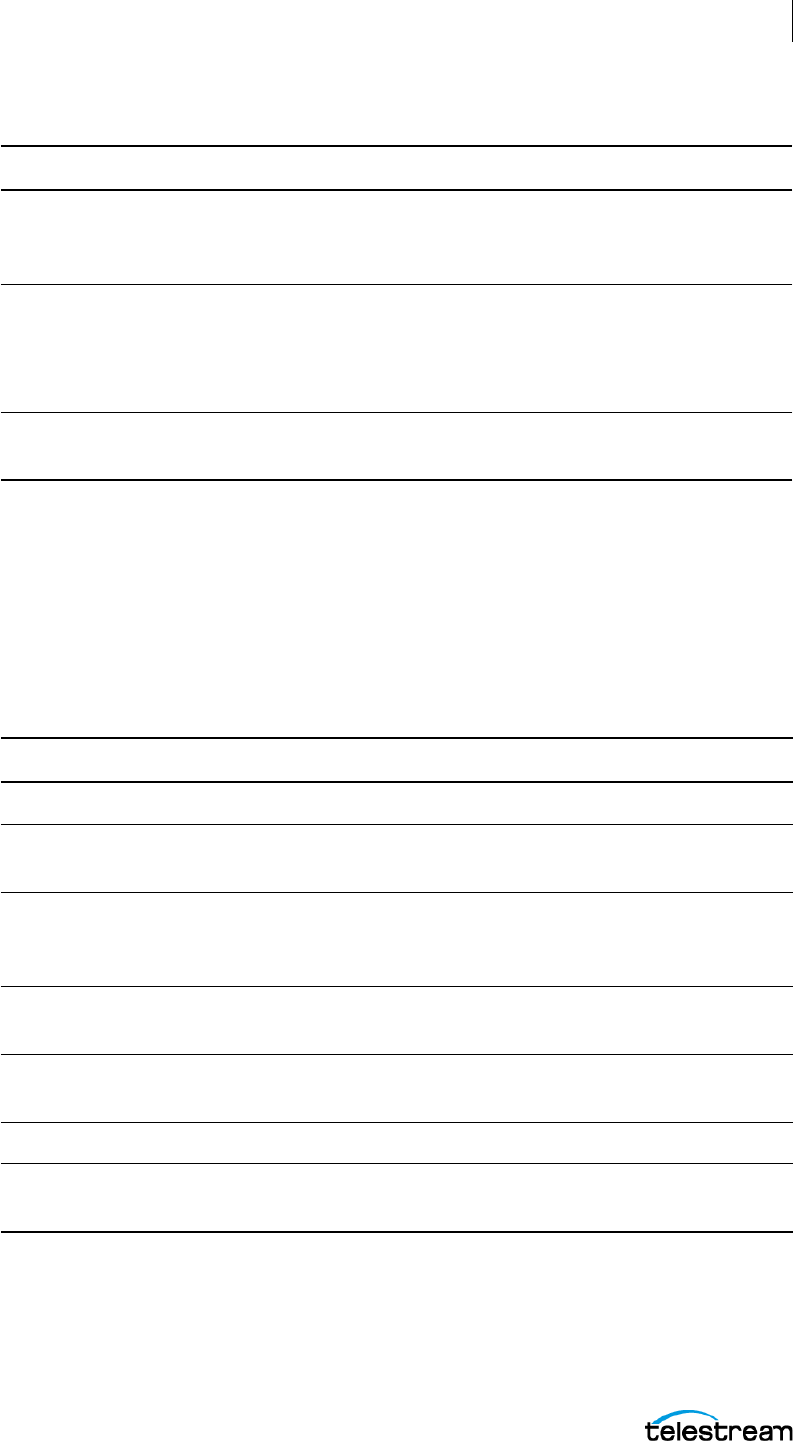
Menus
File Menu
131
ScreenFlow User Guide
See Changing the Canvas Size.
The New Dialog
The New dialog contains the following controls:
Table 4. The New Dialog
Publish to Displays the Publish dialog, enabling you to log in, encode
your project (or the selected range, when in and out points
are present) and publish your video.
Export Displays the Export Settings dialog, so you can select your
encoding options, encode your project (or the selected
range, when in and out points are present) and export the file.
See The New Recording Pane of the New Dialog.
Batch Export Exports a large number of ScreenFlow documents, re-
encoding each document into a different formats as needed.
Table 3. File Menu Items
Menu Item Description
Control Description
Welcome Displays the ScreenFlow Welcome window.
Permissions Displays the Grant ScreenFlow Permissions window for setting
permissions.
New Recording Displays the New Recording window where you can assign
sources for recordings.
See The New Recording Pane of the New Dialog.
New Document Displays the New Document window where you can define
the settings for new documents.
New from Template Displays the list of existing templates, from which you can
create new templates.
Recent Documents Displays a list of recently-opened documents.
Stock Media Library Displays the Stock Media Library window. This lists stock
media if you have purchased the Stock Media Library.
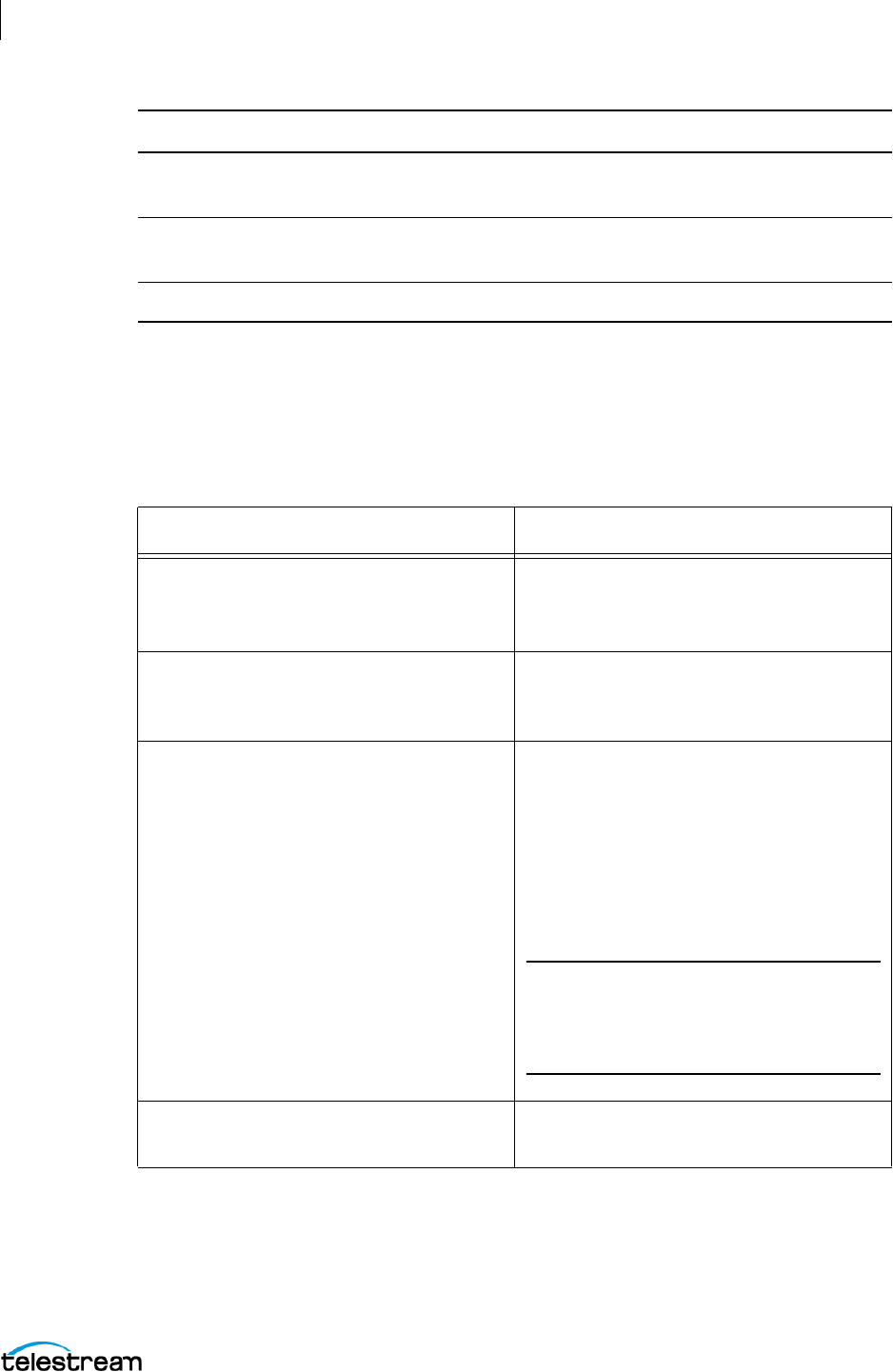
Menus
File Menu
132
ScreenFlow User Guide
The New Recording Pane of the New Dialog
See Configuring Recording Options.
The File menu contains the following controls:
Edit Template (pencil)
button
When clicked, this allows you to edit the selected template.
New Document
(page) button
When clicked, this allows you to create a new document.
Radio button Opens the Other Settings window.
Table 5. The New Recording Pane
Control Description
Show Advanced Options (three-dot)
button at upper-right of the New
Recording Pane
When clicked, ScreenFlow opens the
Advanced Options pane for the new
recording.
Record
When checked, ScreenFlow activates the
drop-down menu for selecting a source
for recording.
Desktops
When selected, ScreenFlow records your
computer display. ScreenFlow records
this source by default. If you have
multiple displays connected, you can
record any or all of them. ScreenFlow
combines desktop video and computer
audio into a single clip, and adds the clip
to your document as an SCC file.
Note: ScreenFlow automatically
updates the list of displays in the
Record menus as you add displays to
the system.
Built-in [type] Display When checked, ScreenFlow records the
display selected.
Control Description
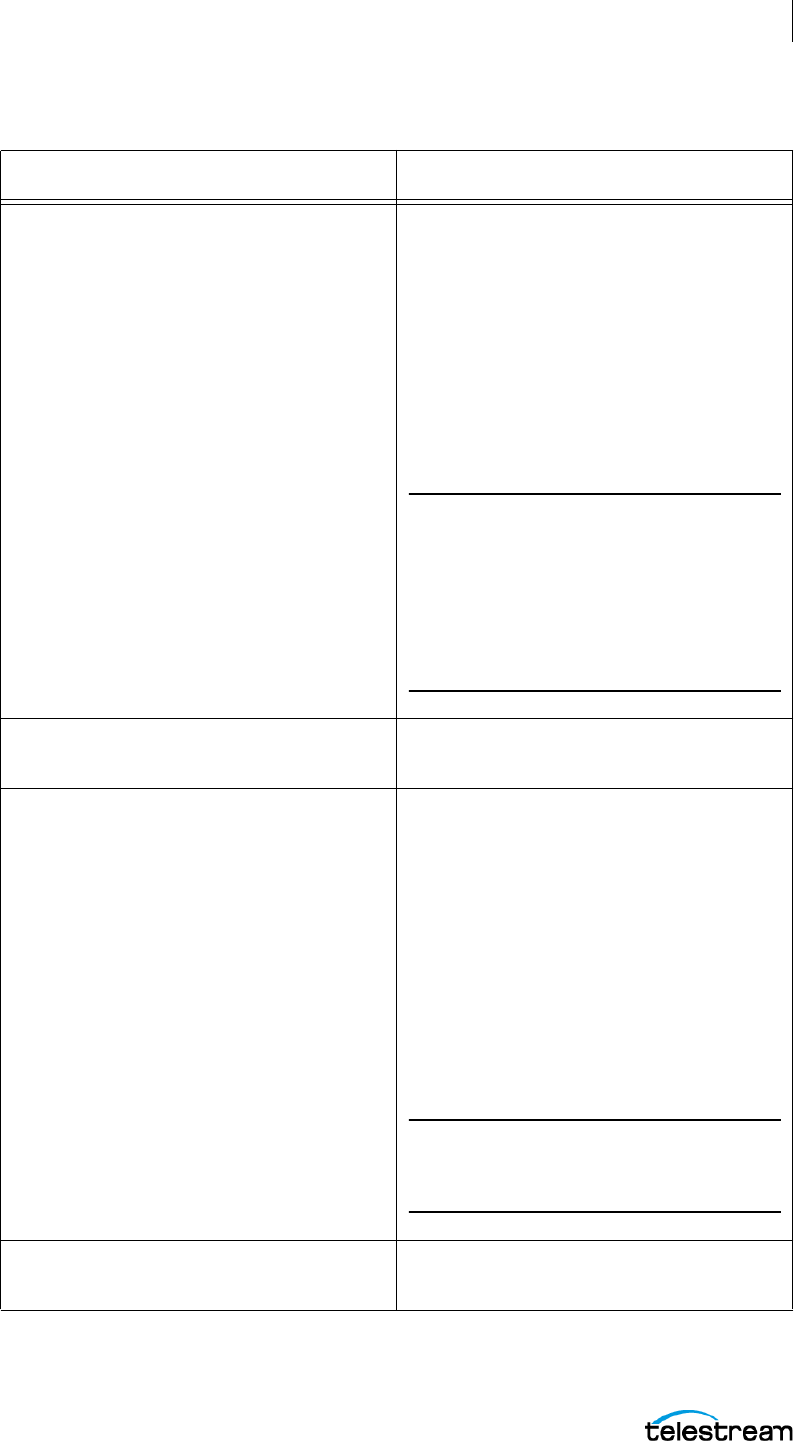
Menus
File Menu
133
ScreenFlow User Guide
Video Cameras
Select this option to record video from
any camera connected to your
computer. Use the drop-down menu to
choose from multiple cameras. When
you select a source, ScreenFlow displays
a preview image below.
ScreenFlow combines camera video and
microphone audio into a single clip, and
adds the clip to your document as an
SCC file.
Note: If a particular virtual camera
does not work in a sandbox
environment, it will not work in the Mac
App Store version of ScreenFlow.
Contact the manufacturer of the virtual
camera for information on virtual-
camera sandbox support.
FaceTime HD Camera (Built-in) When checked, ScreenFlow records the
FaceTime camera selected.
Microphones When selected, ScreenFlow records
audio from a microphone connected
to your computer. Use the drop-
down menu to choose from multiple
microphones. Upon selecting the
source, ScreenFlow displays the vol-
ume level below.
ScreenFlow combines camera video
and microphone audio into a single
clip, and adds the clip to your docu-
ment as an SCC file.
Note: ScreenFlow records microphone
audio at a sample rate of 48KHz with
16-bit sample depth.
Built-in Audio When selected, ScreenFlow records the
built-in audio source selected.
Table 5. (Continued)The New Recording Pane
Control Description
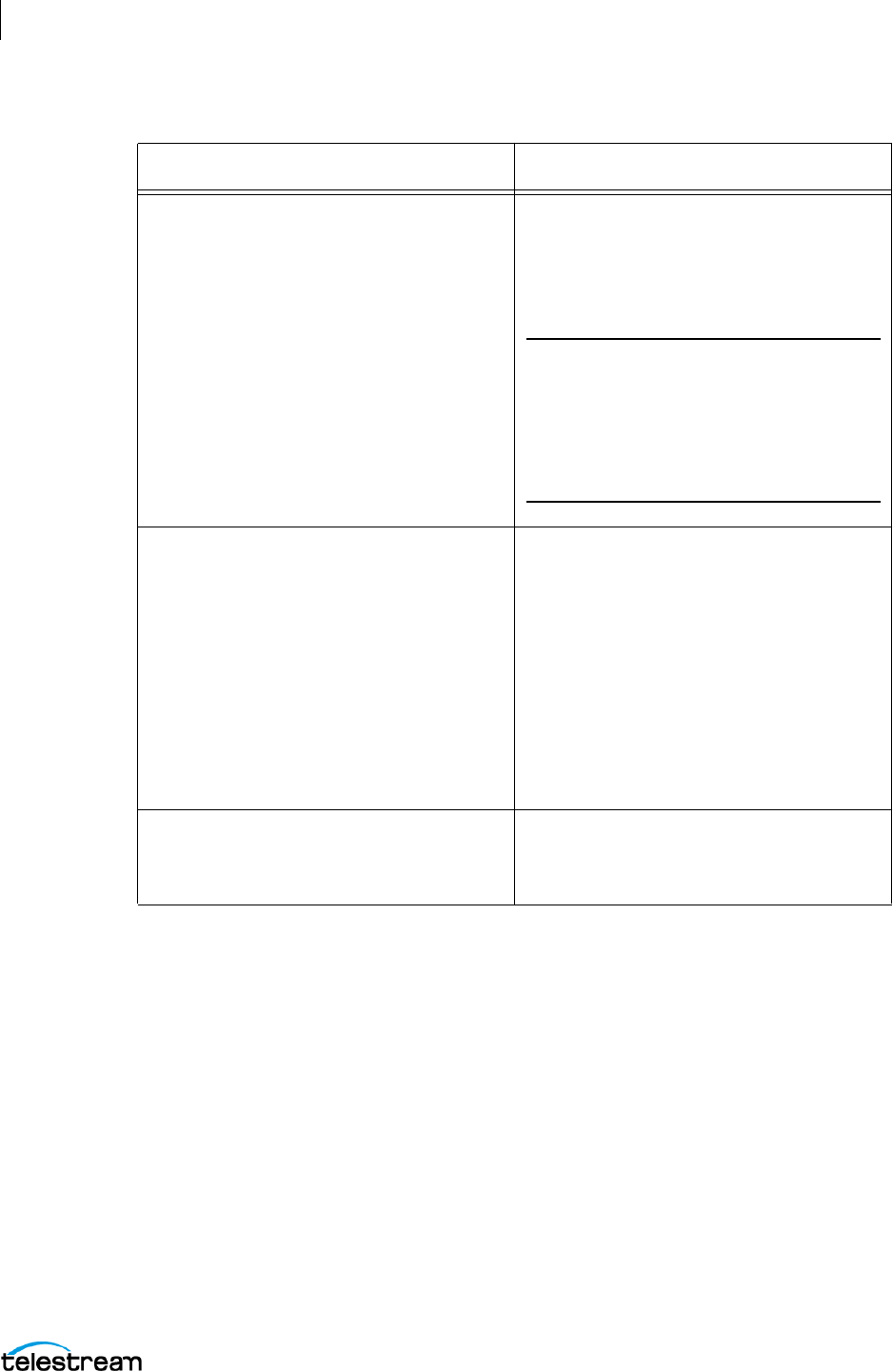
Menus
File Menu
134
ScreenFlow User Guide
The Advanced Options Pane for New Recordings
See Configuring a Recording.
Add (+) button
If you have additional displays to record,
click the Add (+) button. ScreenFlow
adds a new Record Desktop from drop-
down menu-with a Minus (-) button that
lets you remove this menu.
Note: If the number of displays you’re
recording matches the number of
displays connected to the system,
ScreenFlow disables the Add (+) button
on the first row. This informs you that
you can’t record any more displays.
Computer Audio When selected, ScreenFlow records
all sounds played through your com-
puter. To use this feature, you must
install the ScreenFlow audio driver. If
the driver is not installed, ScreenFlow
prompts you to install it.
ScreenFlow combines desktop video
and computer audio into a single
clip, and adds the clip to your docu-
ment as an SCC file.
Record (red) button When clicked, ScreenFlow records
the sources selected in the Record
drop-down menus.
Table 5. (Continued)The New Recording Pane
Control Description
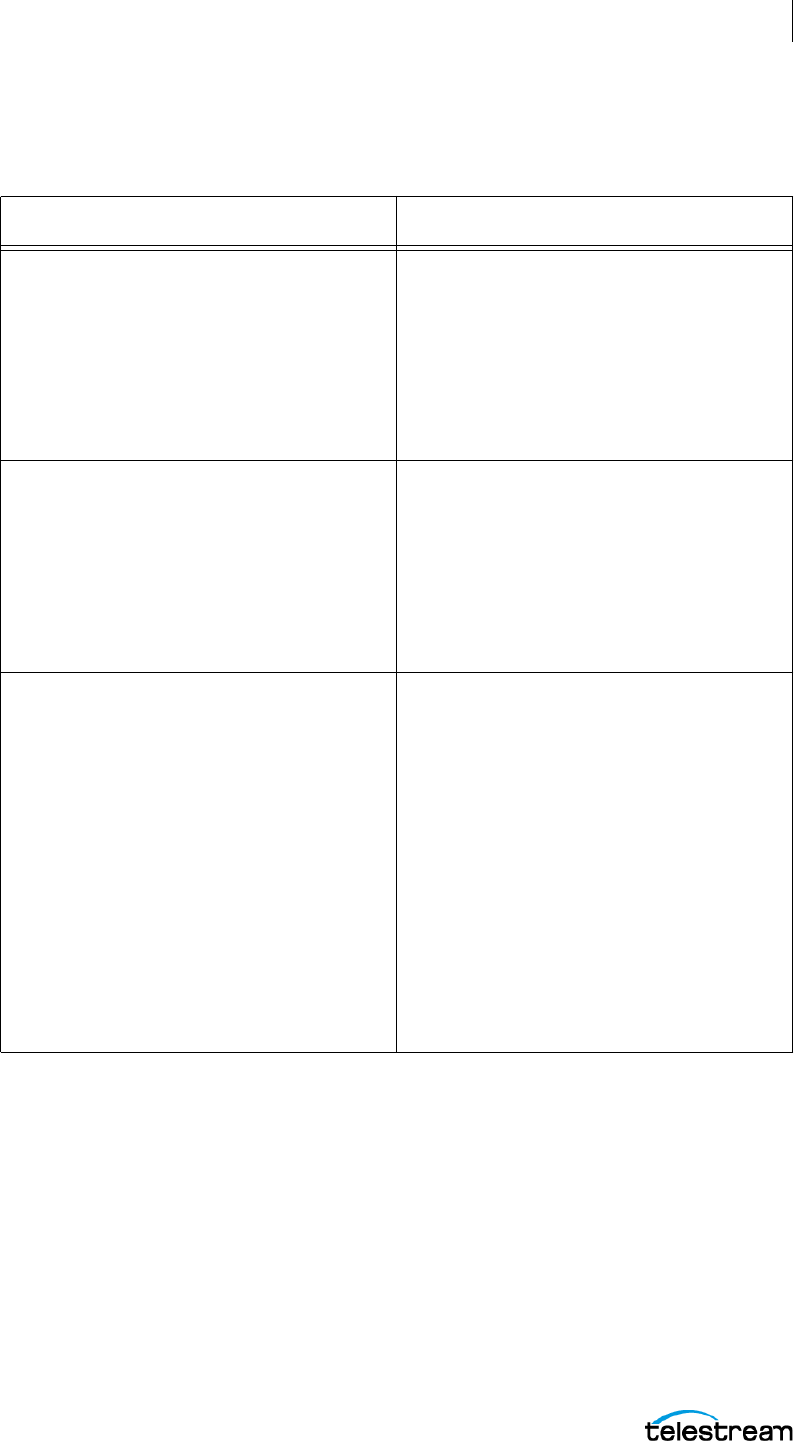
Menus
File Menu
135
ScreenFlow User Guide
The Advanced Options Pane contains the following commands.
Table 6. The Advanced Options Pane
Control Description
Loop Recording Activate loop recording by checking
the Record in a loop box. To set the
recording loop duration, enter hours
and minutes. Click the Record button
to activate. Once the recording starts,
you can see the loop duration in the
status menu of ScreenFlow Helper.
Timed Recording You can also set your timer to stop
the recording after a set number of
minutes and seconds. Click the Set
Timer button to apply this setting.
Once the timer has been set, this but-
ton changes to Reset Timer. Click
again to disable timed recording.
Countdown Window Each time you start recording,
ScreenFlow displays the countdown
panel, providing a delay to allow you
to prepare recording.
To skip the countdown, simply click
on the countdown window.
ScreenFlow begins recording imme-
diately. By default, the countdown is
set to five seconds. To change the
countdown option, go to
ScreenFlow > Settings
> General. You
can set the countdown delay for up
to 20 seconds.
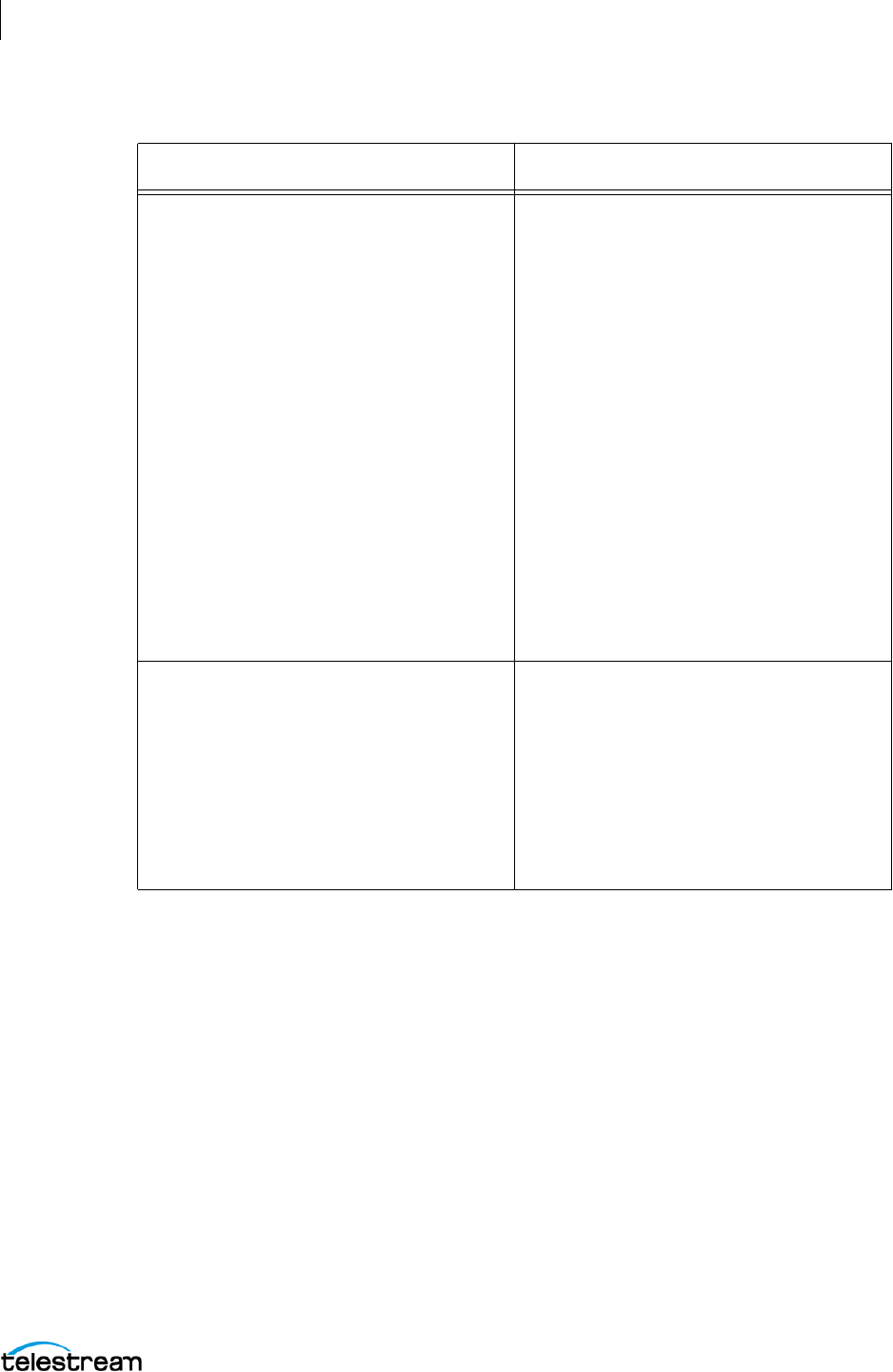
Menus
File Menu
136
ScreenFlow User Guide
The Export Settings Dialog
The Export Settings dialog contains the following commands.
Adding A Recording When you have finished your record-
ing, ScreenFlow automatically opens
the clips that you have recorded in a
new document. If you already have a
document open, ScreenFlow gives
you the option of creating a new doc-
ument or adding your recording to
an existing document.
If you’ve accidentally created a new
document when you intended to add
the recording to an existing docu-
ment, drag, or copy and paste, your
recording into the editor window,
timeline, or media library of the
desired document. This duplicates
the recording in the document folder
of the desired document.
Add Additional Recording To add a recording to your docu-
ment, create a new recording, choose
File
> Add Additional Recording, or
add from the media library.
The Add Additional Recording selec-
tion reopens the New Recording win-
dow so you can add another
recording.
Table 6. (Continued)The Advanced Options Pane
Control Description
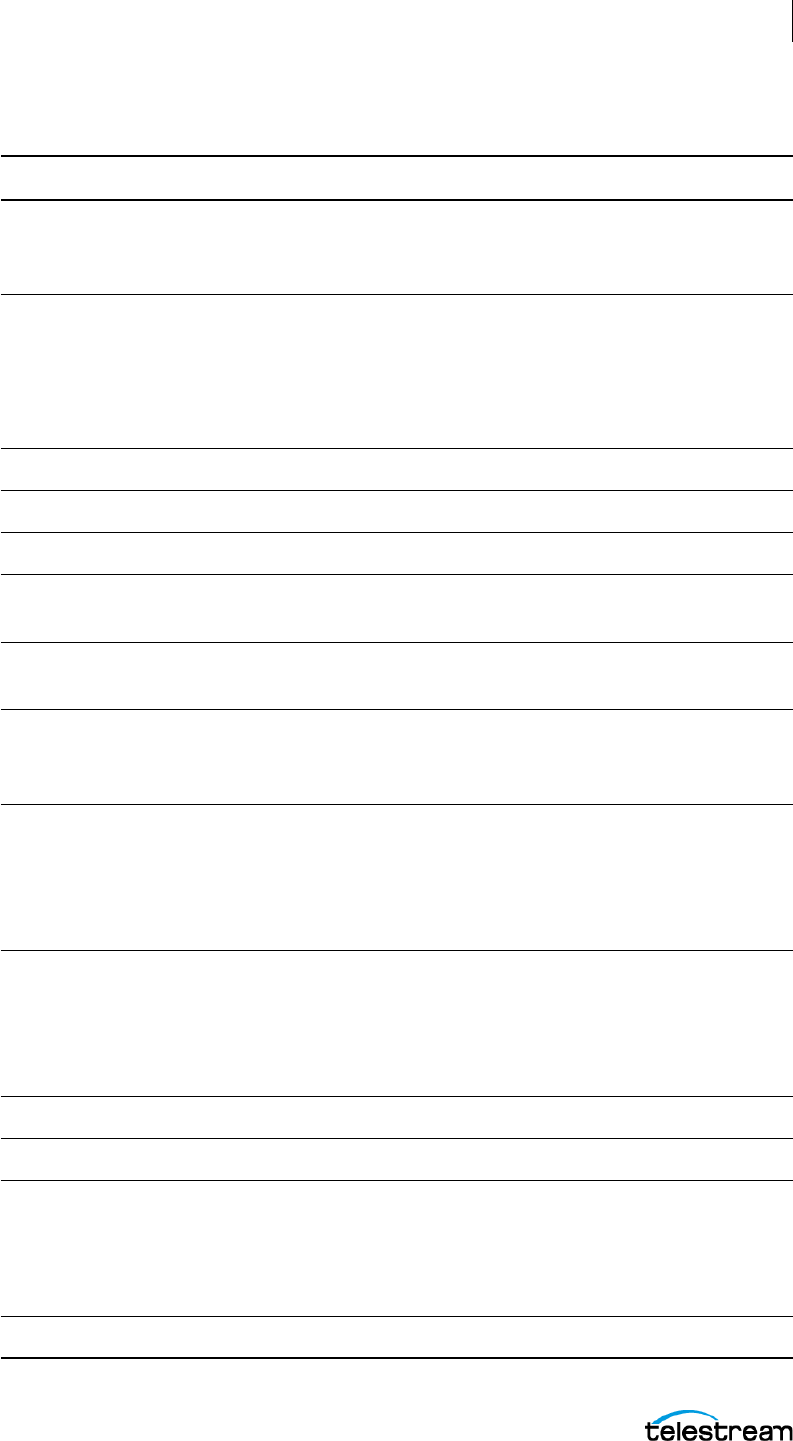
Menus
File Menu
137
ScreenFlow User Guide
Table 7. Export Settings Options
Control Description
Save As Enter the name of your screencast. The default name is the
name of your project file. The file extension is applied
automatically based on your choice of preset.
Where Navigate and select the location of your exported video file.
NOTE: If you purchased ScreenFlow from the Mac App Store,
the Where popup menu does not display. Instead, ScreenFlow
displays the File Save dialog after you click Export, so you can
navigate and select your folder for the exported file.
Type (Automatic)
Type (Manual)
Encoding Quality Select: Fastest, Normal, or Slowest.
Resolution Select a resolution, or select Custom which opens Width and
Height fields to enter custom resolution values.
Letterbox Content Check to display letterbox content (text display of audio
content).
Options Use these controls to specify motion blur, add chapter tracks,
add captions, and burn in captions, depending on your
encoding options.
Use Motion Blur Check to apply a blurring algorithm to blend movement
smoothly into the video. This is useful if you are using video
properties effects to move clips on the canvas. This option
increases encoding time so it should only be used if objects
are not moving smoothly in your exported video.
Add Chapter Track
from Markers*
When encoding with some codecs, check to add chapter
markers to your movie based on the location and names of
the markers in your project. These markers provide quick
navigation and require named markers to be present in the
project.
Add Captions Track Check to include your caption track.
Burn In Captions When checked, imported captions are burned into the clip.
Preset Export presets are designed for both general and specific use,
based on the most common applications.
Select a preset from the popup menu.
See the Export Preset Options table.
Gear icon
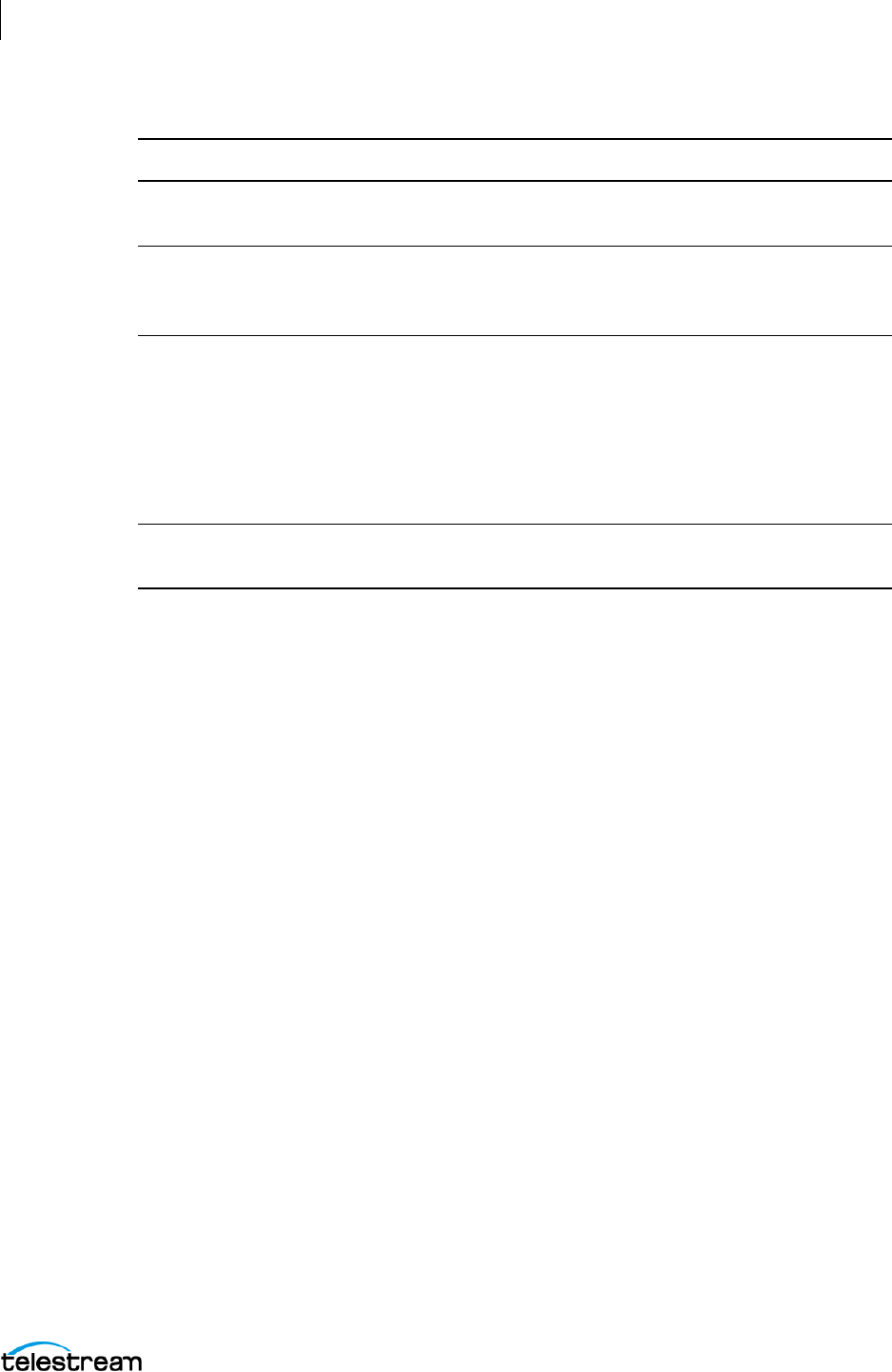
Menus
File Menu
138
ScreenFlow User Guide
Make Current
Settings Default
Select to make the current settings become the “default”
settings that are used when a new document is created.
Reset to Factory
Defaults
Select to return the default settings to the original factory
settings. Any current default settings (set by Make Current
Setting Default above) are cleared.
Customize Click to make changes to your video and audio encoding
settings. Some presets cannot be customized. See
Customization Dialog for H.264/AAC (MPEG-4).
If iOS App Preview is the selected Preset, clicking Customize
lets you set the Framerate and the ProRes profile to 4444,
422LT, or 422 HQ. It also lets you select a Stereo or Mono
channel
Manage Click to modify the preset encoding settings. See The New
Recording Pane of the New Dialog.
Table 7. Export Settings Options
Control Description
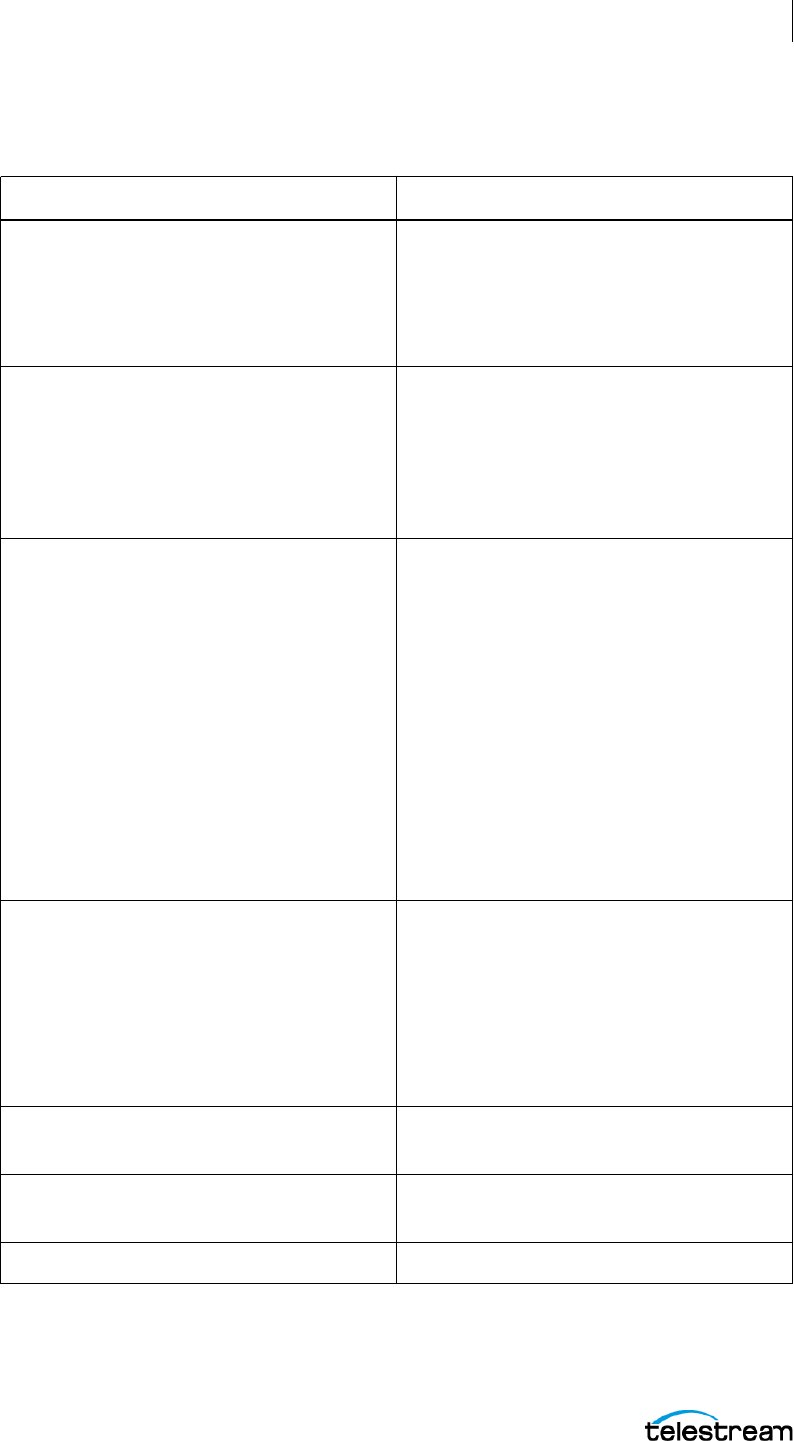
Menus
File Menu
139
ScreenFlow User Guide
Table 8. Export Preset Options
Preset Description
Web-High Default export option, which encodes
video in H.264 format using the x264
codec, with AAC audio, balancing the
demands of image quality and file size,
producing an MP4 file.
Web-Low Encodes video in H.264 using the x264
codec, with AAC audio, for low
bandwidth, producing an MP4 file. It
plays more smoothly on slow Internet
connections but with reduced image
quality when compared to Web-High.
HEVC Encode as video in HEVC / H.265 with 16-
bit 48kHz AAC audio.
NOTE: Before using the HEVC export
option, please be advised that this is not a
widely supported codec. There are still
many programs and services that will not
accept files encoded with the HEVC /
H.265 codec. If you are using this export
option, you may want to check with
whatever service or program you wish to
upload to before doing so, as Telestream
does not govern 3rd party policies and
specifications.
Lossless - ProRes with Alpha Encodes a lossless file in ProRes 4444,
including a clear alpha channel and
stereo audio. Suitable for usage in
applications such as Motion and After
Effects.
To view transparent portions of the
canvas, select View > Show Checkerboard.
ProRes 422 Encodes ProRes 422. Click Customize to
select profile: 4444, 422HQ, 422, or 422LT.
Lossless - Audio Only Encodes an uncompressed audio-only
AIFF format ideal for additional editing.
AAC - Audio Only Audio only
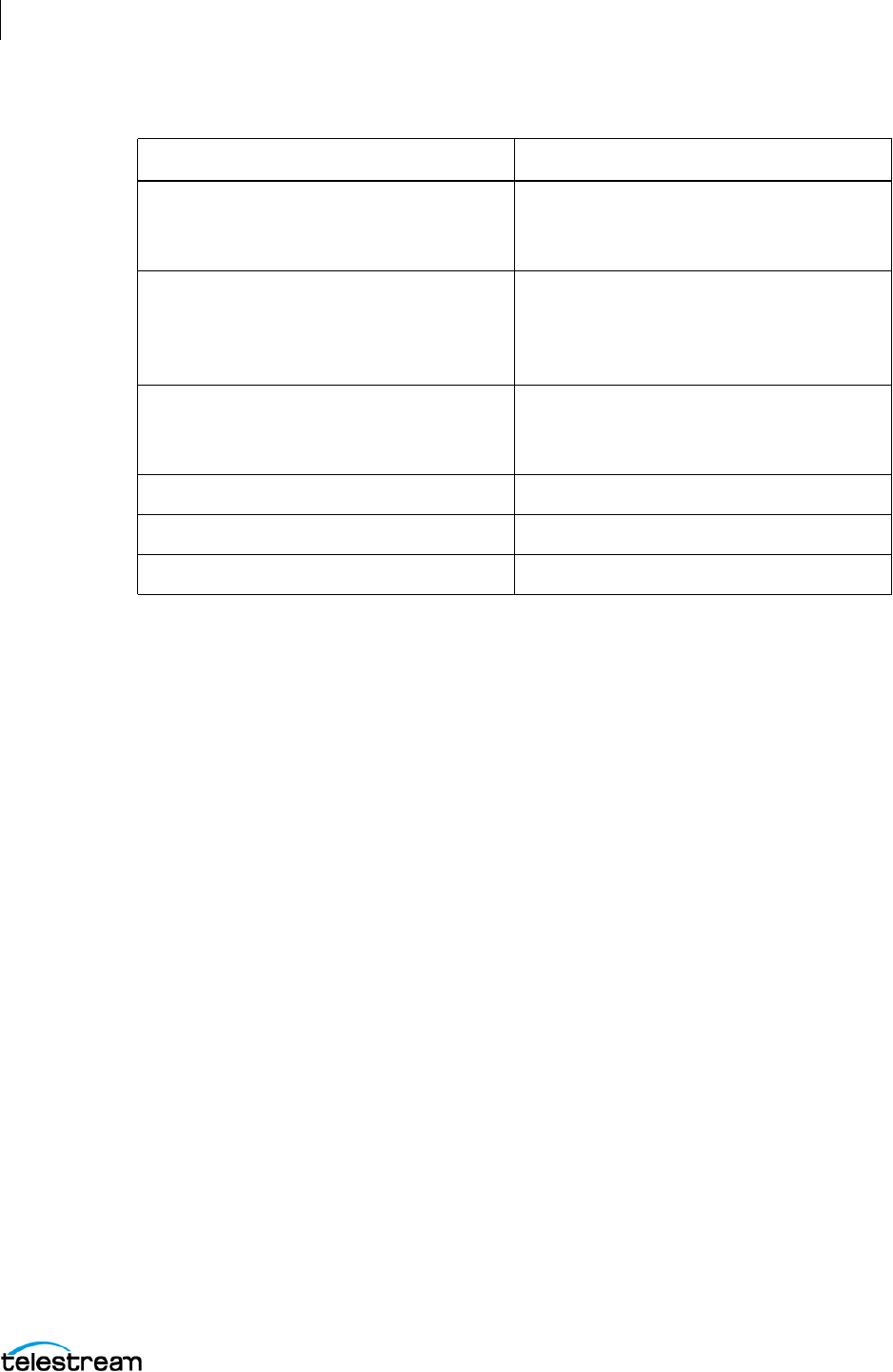
Menus
File Menu
140
ScreenFlow User Guide
Customization Dialog for Animated GIF or Animated PNG
Descriptions of the fields in the customization dialog follow:
Framerate Higher frame rates produce larger files. For most GIF files, 15 fps is standard.
Colors 256 is the optimum setting for GIF files. If your animation contains less than 256
colors, use lower settings.
Loop Check to cause the output file to continuously play in a loop.
Dither Check to turn on dithering in GIF images. This helps reduce banding in
gradients of color, but it also increases the file size. The Error Diffusion setting produces
smaller files while maintaining the quality to the Ordered option.
Strength Select the amount of dithering: Light, Medium, or Heavy.
Customization Dialog for H.264/AAC (MPEG-4)
Descriptions of the fields in the customization dialog follow:
Set these options, as described below in Table 9. When you’re done, click OK.
iOS App Preview Exports according to Apple’s guidelines
for App Store previews (30 fps ProRes 422
with stereo AAC 16-bit 48khz).
iPhone X Optimized/iPhone X Screen Fill/
iPhone/Apple TV
These export options are configured
based on the recommended video
specifications for these devices. They
can’t be altered.
Animated GIF/Animated PNG Exports as an animated GIF or PNG.
(See Customization Dialog for Animated
GIF or Animated PNG)
1080 Vertical Exports in vertical frame of 1080x1920.
1080 Square Exports in square frame of 1080x1080.
720 Square Exports in square frame of 720x720.
Table 8. Export Preset Options (Continued)
Preset Description

Menus
File Menu
141
ScreenFlow User Guide
Table 9. H.264/AAC (MPEG-4) Settings
Option Description
H.264 Video Uncheck when you do not want your exported file to contain
video tracks.
Frame rate Enter the frame rate in frames per second, or select preset
values from the popup menu.
Data rate Enter the data rate in kbits per second.
NOTE: The data rate you enter is a target value. Therefore, the
actual data rate may be higher or lower than entered.
Profile Select the codec profile (which establishes parameter ranges
for a given application) from the popup menu:
Automatic The codec determines which profile to use, based on the size
of the input video.
Main This profile results in longer encoding; it was designed
primarily for SD digital TV broadcasts. It is well-suited for
playback on desktop computers.
Baseline This profile is used for faster, simpler encoding, and improved
data loss robustness, particularly for playback in mobile
applications.
High The High Profile is used as the preferred choice for HD
broadcast and disc storage applications.
Codec Select: Single-pass, Multi-pass, or Hardware Accelerated.
Keyframe Rate Select automatic or fixed keyframe rate
Automatic ScreenFlow selects the optimum rate
Fixed every Manually enter the frame rate
AAC Audio Uncheck when you do not want your exported file to contain
audio tracks.
Sample Rate Select to signify the number of samples taken from the source
per second (in kHz) and added to the audio track being
generated.
Select the sample rate from the popup menu. Web-High and
Web-Low, defaults to CD quality (44.1 kHz).
Data rate Enter the data rate in kbits per second. Web-High defaults to
256kbits/sec. Web-Low, defaults to 96kbits/sec.
Channels Select Mono or Stereo
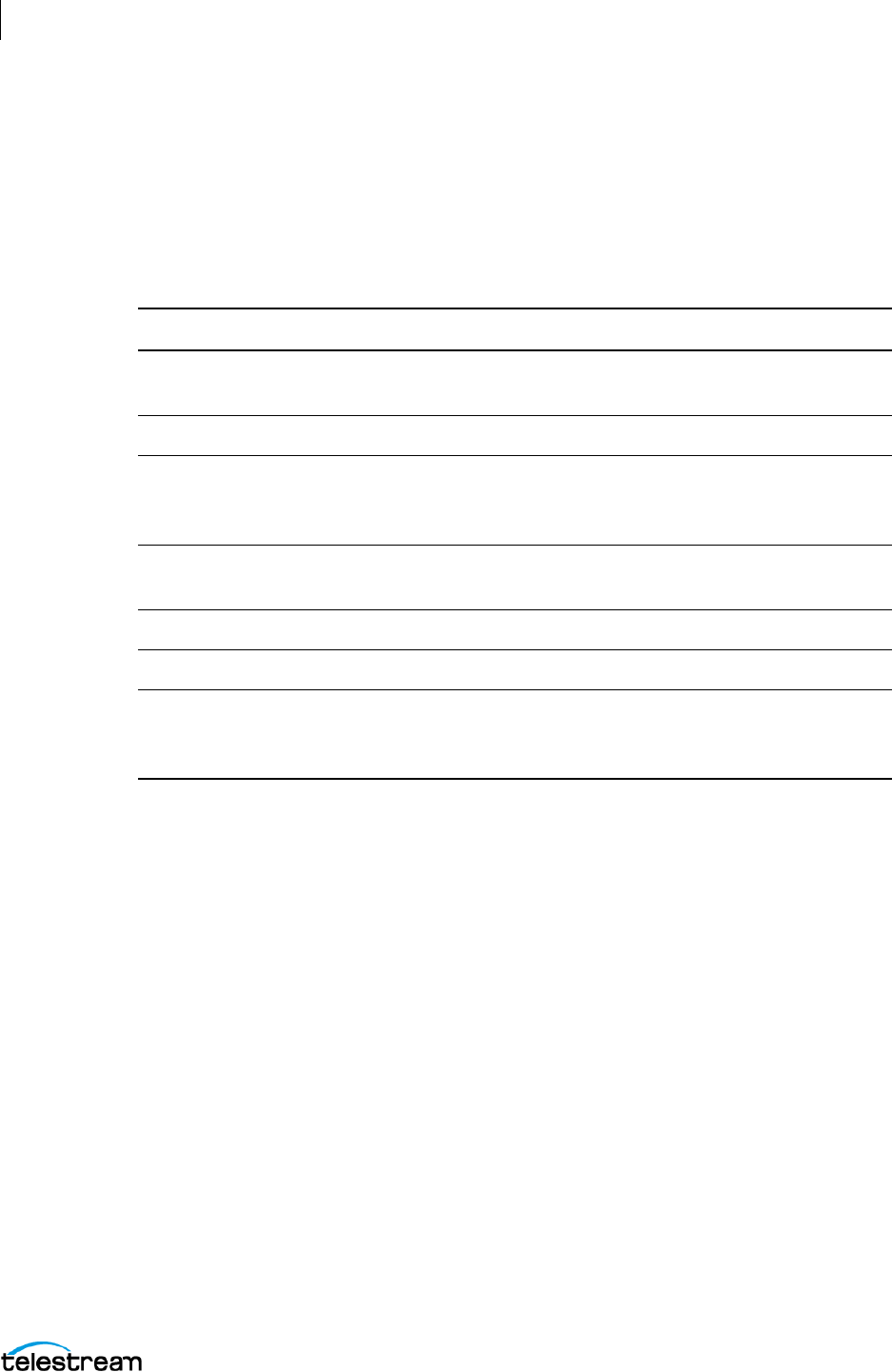
Menus
File Menu
142
ScreenFlow User Guide
The “Publish to” Dialogs
ScreenFlow opens a dialog of settings for each of the supported video-hosting
platforms. Descriptions of the various platform settings follow.
The Publish to Vimeo Settings
Table 10. Publish to Vimeo Settings
Control Description
Title Enter the title for your project. By default, this field uses the
base name of your project file.
Description Enter a description for your project.
Tags Enter keywords to describe your project. When Vimeo users
search for these words, your video is included in the search
results.
Privacy Select the level of privacy required. Account Default uses the
defaults set up through the Vimeo Web interface.
“?” button Click to get publishing help
Sign Out Click Sign Out to sign out of your Vimeo account.
Publish Click Publish to export and upload your project. ScreenFlow
displays a progress bar to indicate encoding progress. Click
Cancel at any time to abort the encode/upload process.
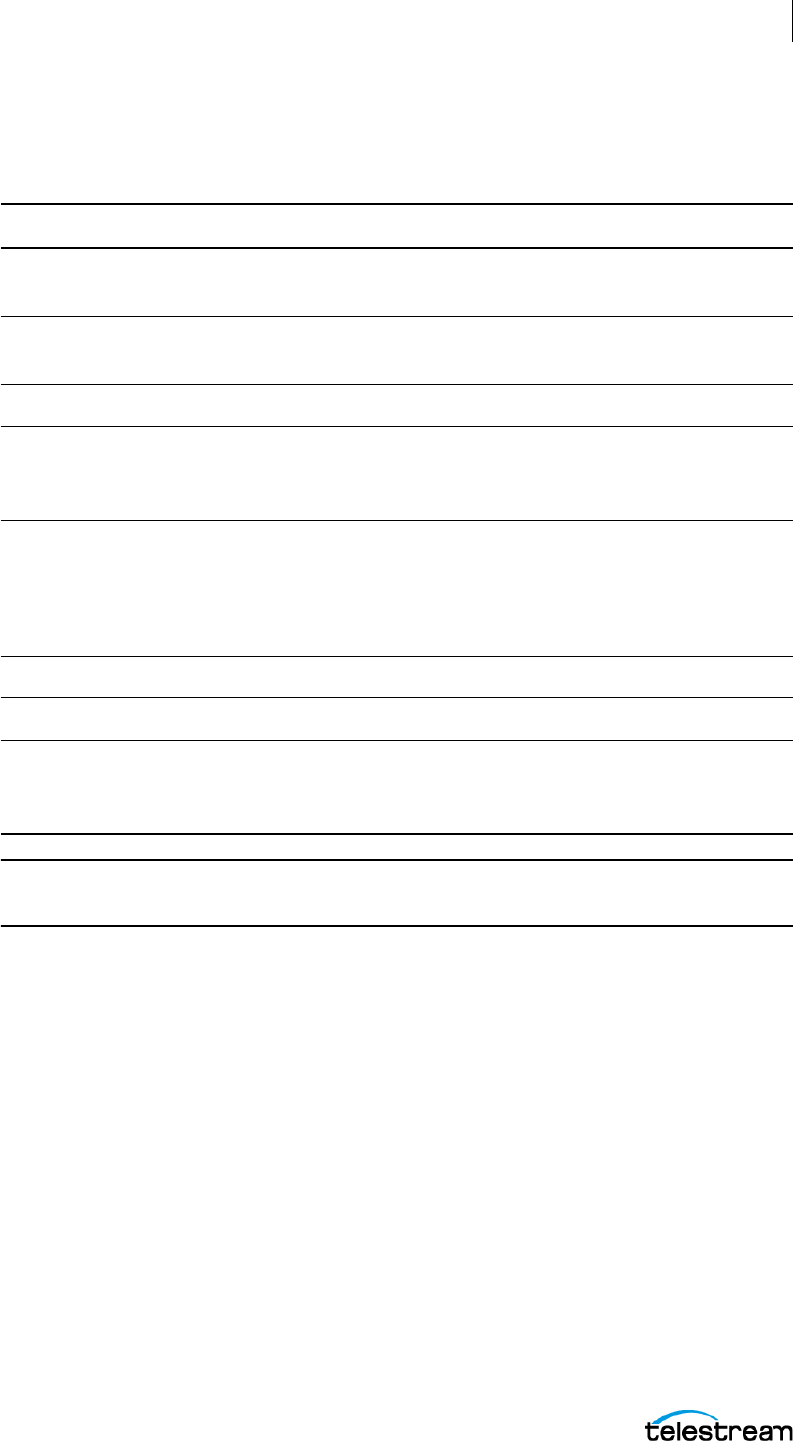
Menus
File Menu
143
ScreenFlow User Guide
The Publish to YouTube Settings
Table 11. Publish to YouTube Settings the
Note: For recommended upload encoding settings on YouTube, see https://
telestream.net/ScreenFlow/youtube-settings.htm
Control Description
Category Select the category of your project from the options in the
popup menu.
Title Enter the title for your project, up to 60 characters. By default,
this field uses the base name of your project file.
Description Enter a description for your project.
Tags Enter keywords to describe your project. When YouTube users
search for these words, your video is included in the search
results.
Privacy Public: Anyone can view this video
Unlisted: Only people with a link can view this video
Private: Only YouTube users that you authorize can view this
video
“?” button Click to get publishing help
Sign Out Click Sign Out to sign out of your YouTube account.
Publish Click Publish to export and upload your project. ScreenFlow
displays a progress bar to indicate encoding progress. Click
Cancel at any time to abort the encode/upload process.
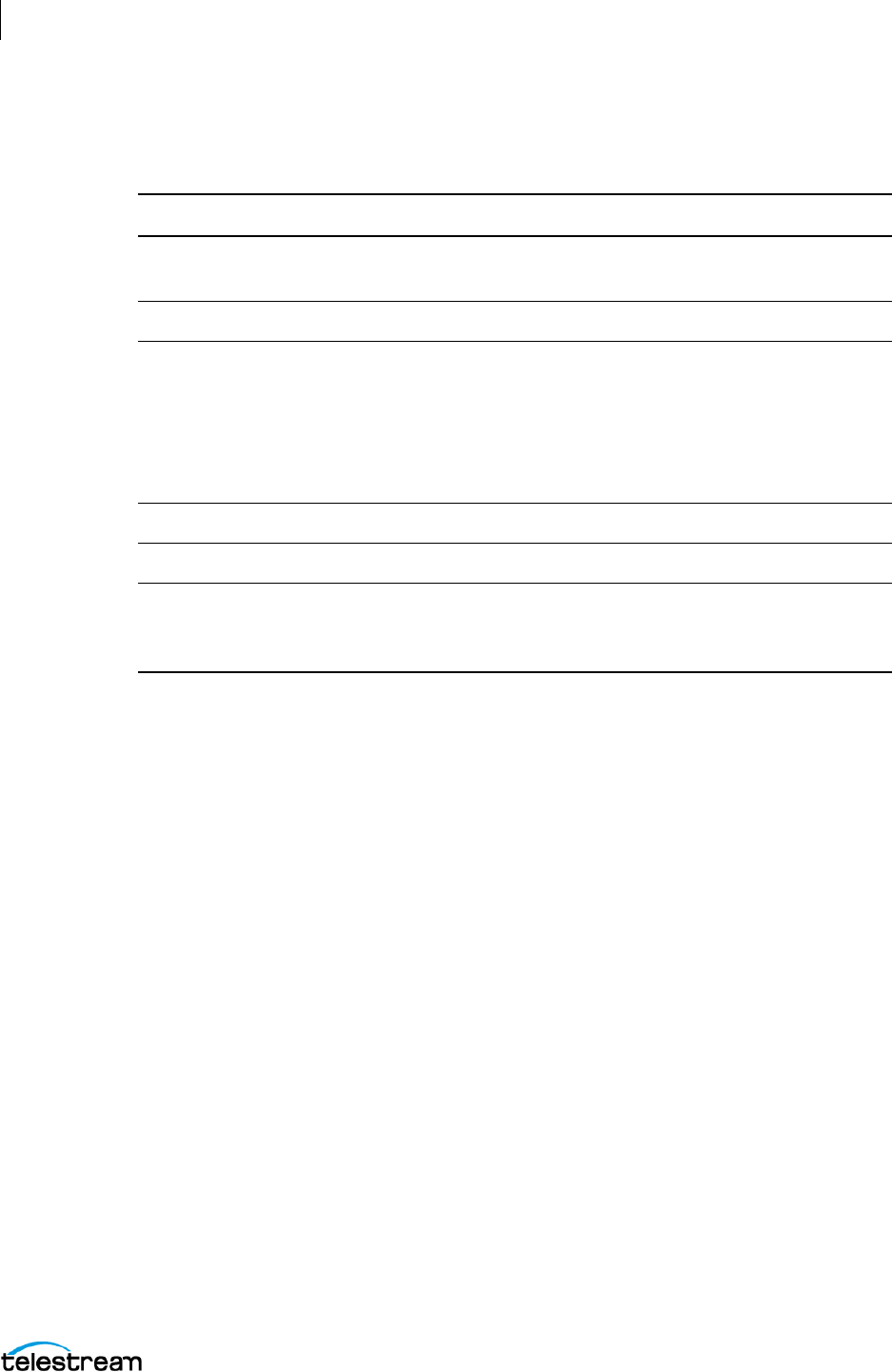
Menus
File Menu
144
ScreenFlow User Guide
Publish to Google Drive Settings
Table 12. Publish to Google Drive Settings
Publish to Dropbox Settings
The Dropbox upload places all the files into a ScreenFlow folder inside the Apps folder
at the root of the user’s Dropbox. This cannot be changed because it is the only way for
third-party applications to upload to Dropbox directly.
Control Description
Title Enter the title for your project. By default, this field uses the
base name of your project file.
Description Enter a description for your project.
Sharing Check Public | Unlisted | Private:
Public: Anyone can view this video
Unlisted: Only people with a link can view this video
Private: Only Google Drive users that you authorize can view
this video
“?” button Click to get publishing help
Sign Out Click Sign Out to sign out of your Google account.
Publish Click Publish to export and upload your project. ScreenFlow
displays a progress bar to indicate encoding progress. Click
Cancel at any time to abort the encode/upload process.
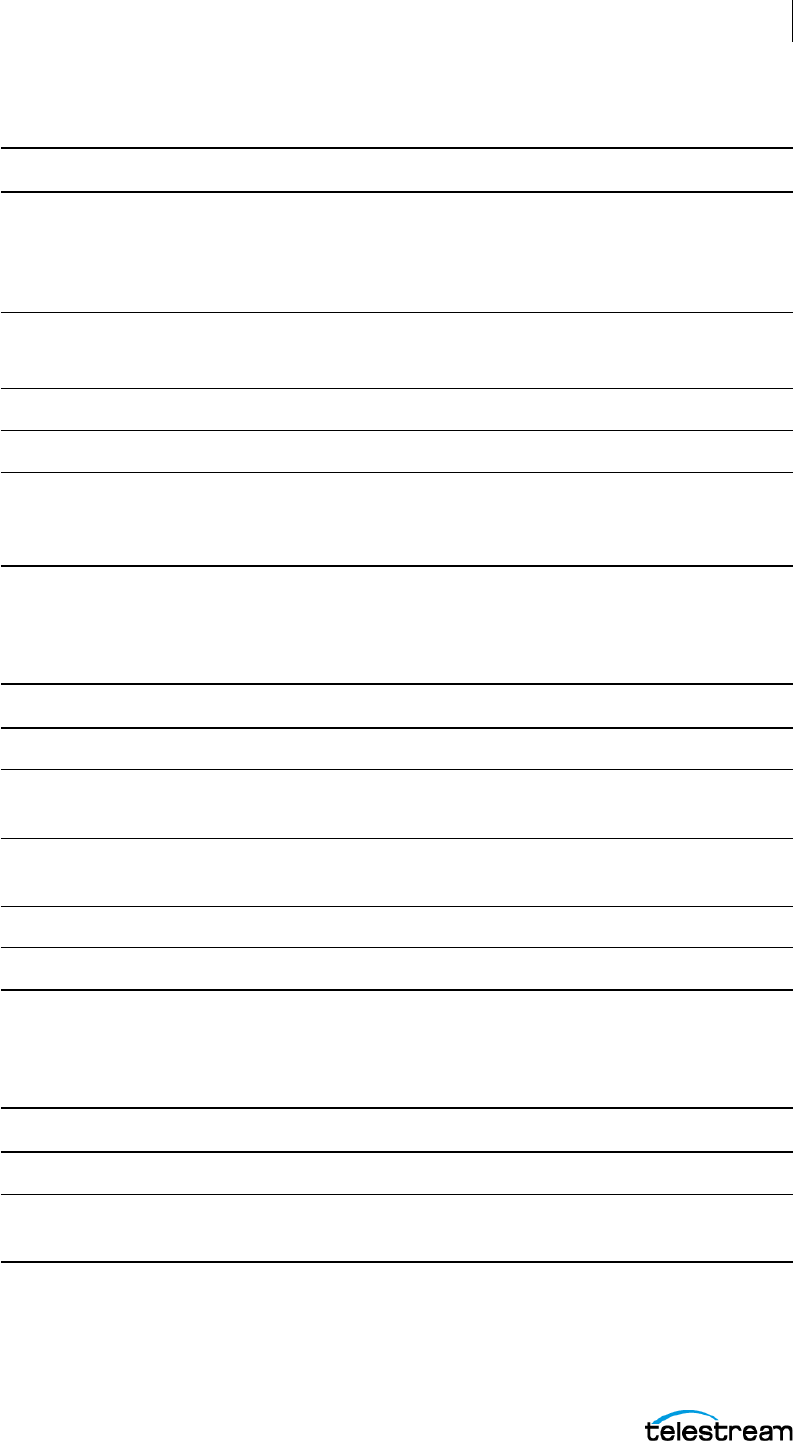
Menus
File Menu
145
ScreenFlow User Guide
Table 13. Publish to Dropbox Settings
Publish to Wistia Settings
Table 14. Publish to Wistia Settings
Publish to Box Settings
Table 15. Publish to Box Settings
Control Description
Filename Enter a filename to use for your publication.
NOTE: The Apps folder at the root of the user’s Dropbox
cannot be changed because it is the only way for third-party
applications to upload to Dropbox directly.
Privacy Public: Anyone can view this video
Private: Only users that you authorize can view this video
“?” button Click to get publishing help
Sign Out Click Sign Out to sign out of your Dropbox account.
Publish Click Publish to export and upload your project. ScreenFlow
displays a progress bar to indicate encoding progress. Click
Cancel at any time to abort the encode/upload process.
Control Description
Video Encoding Select an encoding preset from the drop-down menu.
Frame rate Enter the frame rate in frames per second, or select preset
values from the popup menu.
Options Letterbox Content
Use Motion Blur
Media File Check box to save a copy of the media file locally.
Save copy to disk Click Location to choose the location for the saved media file.
Control Description
Video Encoding Select an encoding preset from the drop-down menu.
Frame rate Enter the frame rate in frames per second, or select preset
values from the popup menu.

Menus
Edit Menu
146
ScreenFlow User Guide
Publish to Imgur Settings
Table 16. Publish to Imgur Settings
Edit Menu
The Edit menu contains the following commands:
Note: Most of these commands are also on the gear menu, directly on the clip.
Options Letterbox Content
Use Motion Blur
Media File Check box to save a copy of the media file locally.
Save copy to disk Click Location to choose the location for the saved media file.
Control Description
Preset Select an encoding preset from the drop-down menu.
Dimensions Enter the desired frame dimensions.
Options Use Motion Blur
Add Chapter Track from Marker
Add Captions Track
Media File Check box to save a copy of the media file locally.
Save copy to disk Click Location to choose the location for the saved media file.
Control Description
Table 17. Edit Menu Items
Menu Item Description
Undo
(Command-Z)
Reverses your last change.
ScreenFlow permits an unlimited number of undo/redo
actions (limited only by memory constraints). However,
undo information is stored on a per-window basis. If you
close a window and then reopen it, its undo list is lost.
Redo
(Shift-Command-Z)
Reverses your last Undo action.
Cut
(Command-X)
Removes the selected object or objects, and place them on
the clipboard.
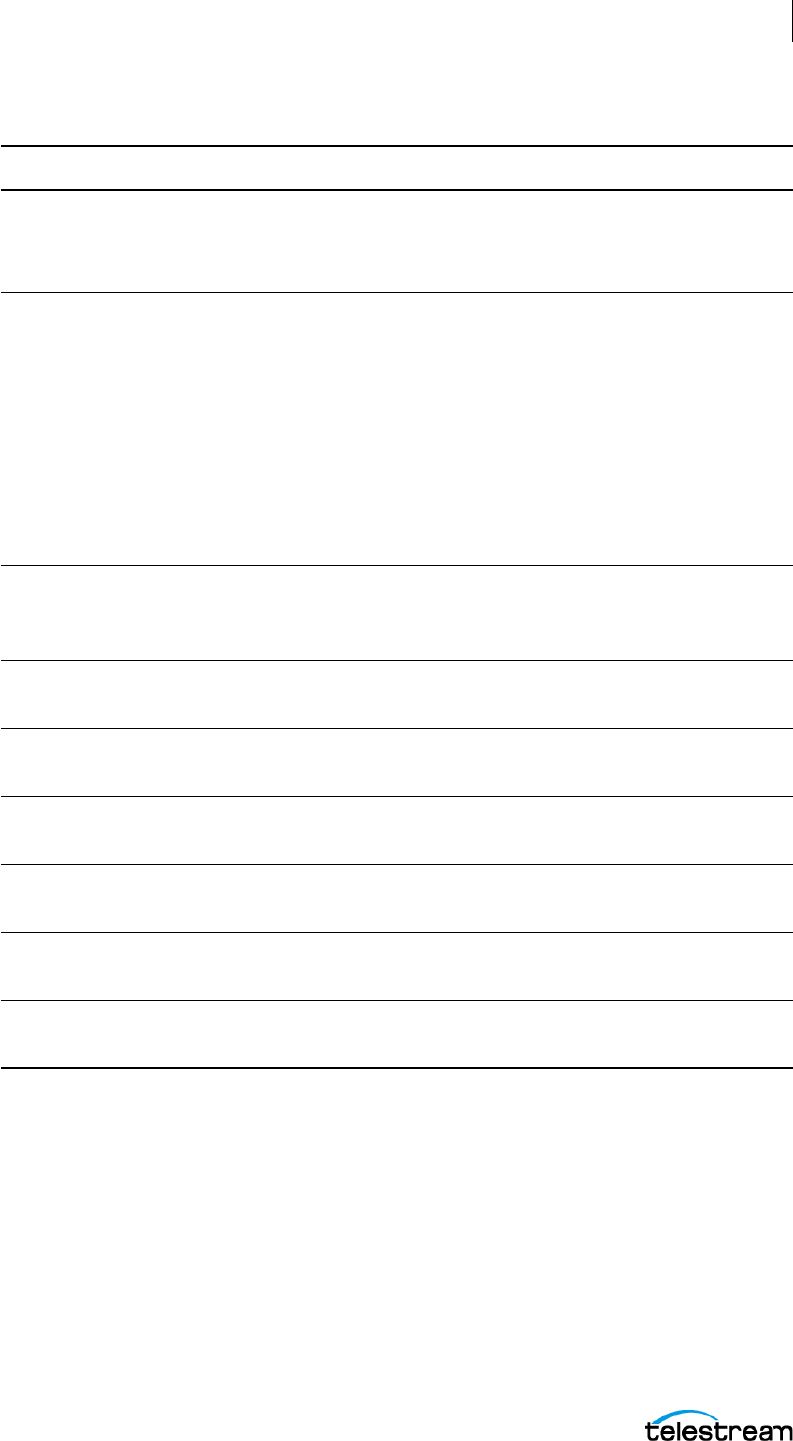
Menus
Edit Menu
147
ScreenFlow User Guide
Copy
(Command-C)
Copies the selected object or objects onto the clipboard.
Note: Clips in the media library cannot be copied, but they
can be added to the timeline multiple times.
Paste
(Command-V)
Adds objects on the clipboard to your document.
Copied text is added to the text box at the cursor position.
Inserted text adopts the text formatting of the character
immediately preceding the insertion point.
If the scrubber is at the start of the timeline or anywhere on
a clip, the clip is added one layer up, at the scrubber
position.
If the scrubber is at the end of a clip, the pasted clip is added
on the same layer.
Paste Properties Updates the properties of the selected clip on the timeline
with the properties of the clip on the clipboard.
Paste Properties has these sub menu items:
Video
(Option-Command-I)
Pastes video properties into a video clip.
Audio
(Option-Command-A)
Pastes audio properties into an audio clip.
Screen Recording
(Option-Command-S)
Pastes the screen recording properties into a clip.
Callout
(Option-Command-C)
Pastes callout properties into a callout action.
Video Filters
(Option-Command-V)
Pastes video filter properties into a clip.
Callout
(Option-Command-U)
Pastes audio filter properties into a clip.
Table 17. Edit Menu Items
Menu Item Description
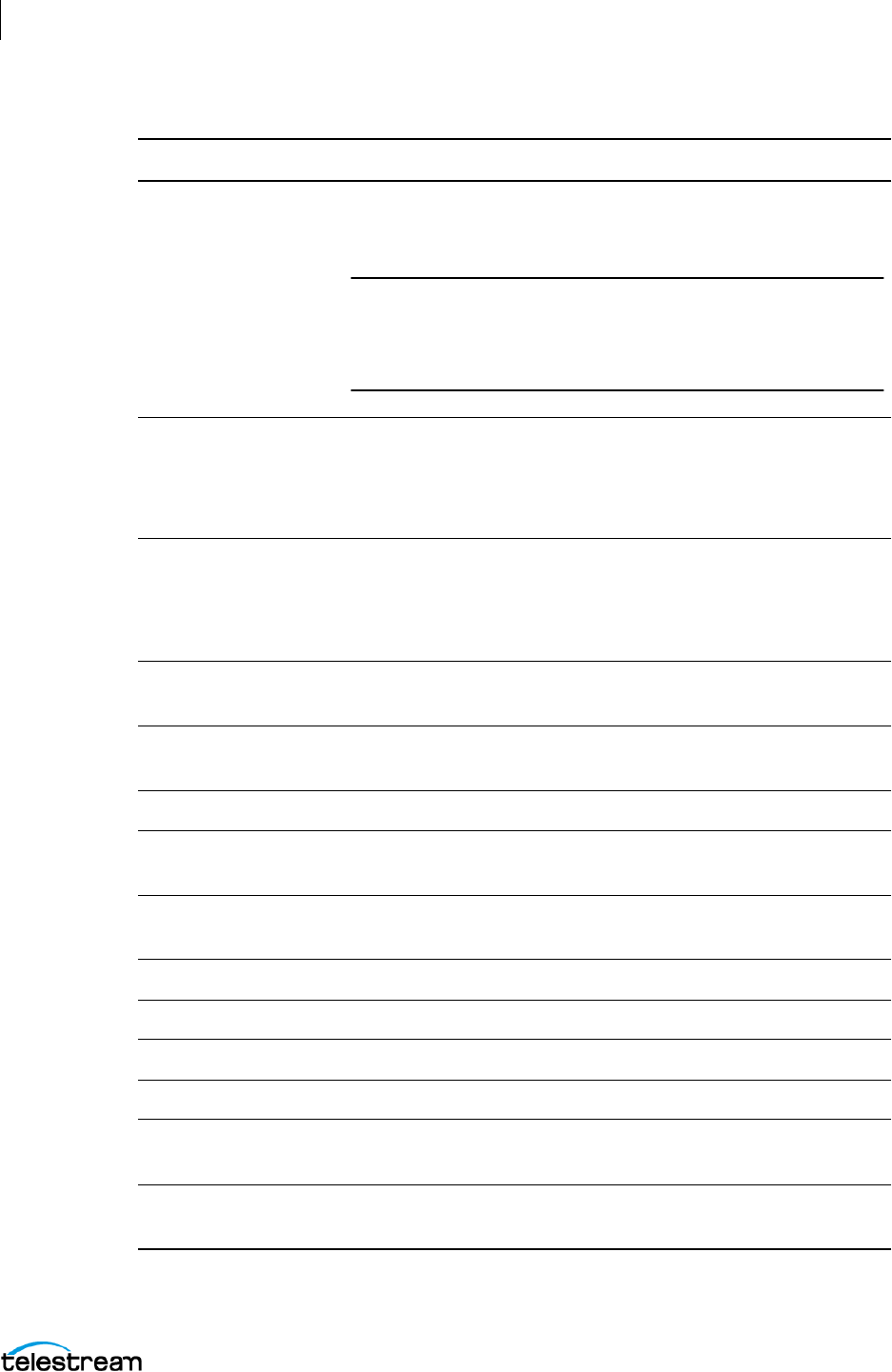
Menus
Edit Menu
148
ScreenFlow User Guide
Table 18. Edit Menu Items (continued)
Menu Item Description
Paste and Match Style
(Option-Shift-
Command-V)
Adds text on the clipboard to your text box. Inserted text
adopts the text formatting of the character immediately
preceding the insertion point.
Note: You can paste properties to multiple clips
simultaneously; however, If you copy multiple clips with
different properties and paste adjustments to another clip,
which properties will be pasted is not predictable.
Delete Permanently removes the selected items. If you have marked
in and out points, the segment between the in and out point
is deleted for all clips.
See Deleting Clips.
Ripple Delete
(Command-
Backspace or Delete)
Delete the elements (or portions of elements) between the in
and out points on all tracks of the timeline and shift all clips
left to close the gap on the timeline.
See Creating Timeline In and Out Points.
Select All
(Command-A)
Highlights all clips on the timeline.
Deselect All
(Shift-Command-A)
Deselects all clips on the timeline. This can also be done by
clicking in an empty area of the canvas or timeline.
Close Gaps Removes all selected gaps between clips in the timeline.
Deselect All Unused
Media
If any media are unused they are deselected. If all media are
used “No Unused Media Found” is displayed.
Captions See Displaying and Previewing Closed Captions and Exporting
Closed Captions as SRT Subtitles.
Set Current Language Specifies the language you want to display captions in.
Import from SRT Imports the closed caption text from a file
Export to SRT Exports the closed caption text in this project to a file.
Clear All Captions Removes caption text from all caption clips in this project.
Start Dictation Displays the macOS dictation system, so that you can add text
to a text box clip using your voice.
Emoji & Symbols Displays the Characters window so that you can enter special
characters in text fields.
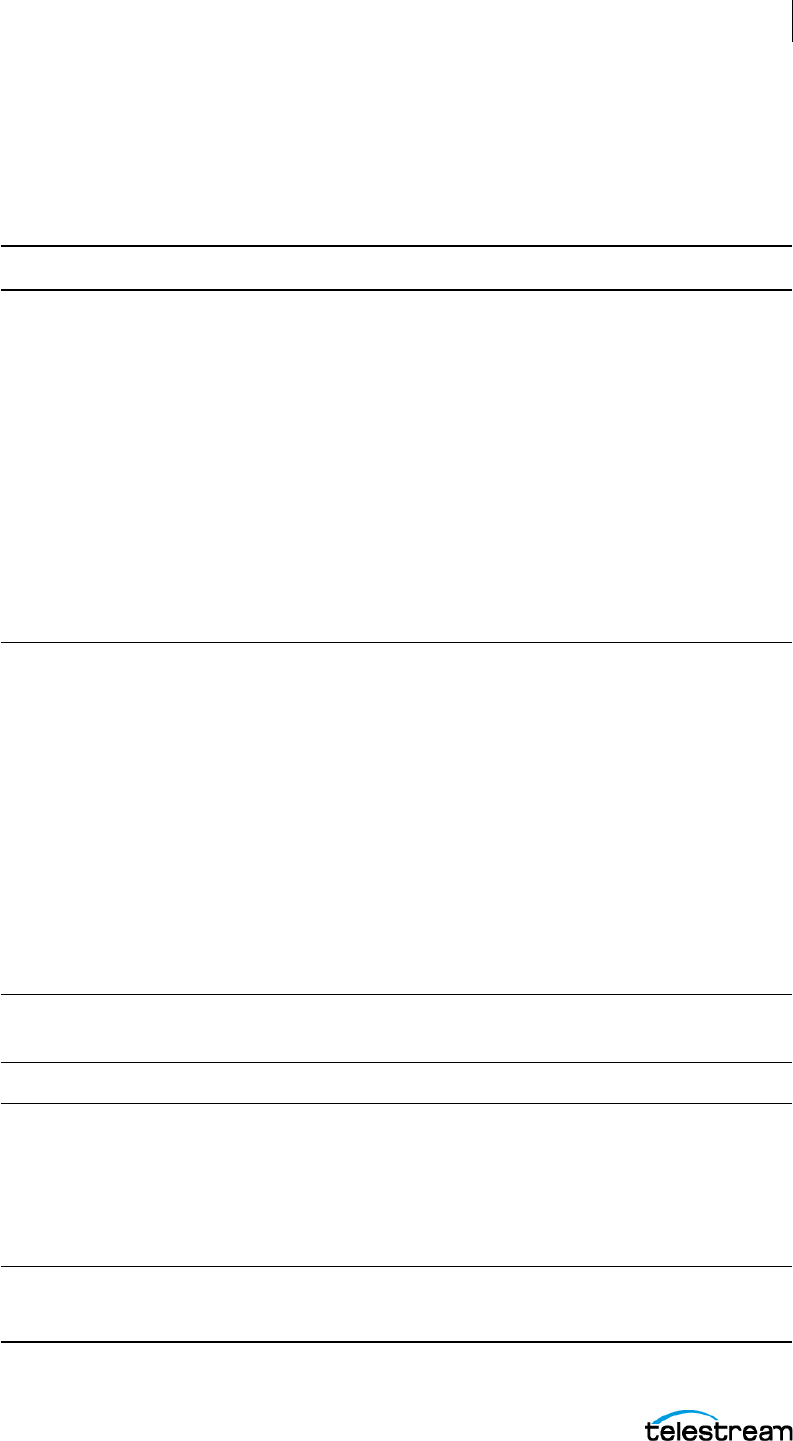
Menus
Mark Menu
149
ScreenFlow User Guide
Mark Menu
The Mark menu contains the following commands:
Table 19. Mark Menu Items
Menu Item Description
Mark In Point
(I)
Sets the in point of a range on the timeline at the current
point of the scrubber.
When you create an in point without an out point,
ScreenFlow automatically sets the out point to the end of the
last clip on the timeline, and highlights the range in blue. In
and out points can be used to delete entire sections of your
timeline using the Ripple Delete command.
Select the in point (click on the line directly over the timeline
scale) and drag it right or left to adjust its point on the
timeline.
Shift-click on the timeline scale to set in and out points
relative to the position of the scrubber.
Mark Out Point
(O)
Sets the out point of a range on the timeline at the current
point of the scrubber.
When you create an out point without an in point,
ScreenFlow automatically sets the in point to the beginning
of the timeline, and highlights the range in blue. In and out
points can be used to delete entire sections of your timeline
using the Ripple Delete command.
Select the out point (click on the line directly over the
timeline scale) and drag it right or left to adjust its point on
the timeline.
Shift-click on the timeline scale to set in and out points
relative to the position of the scrubber.
Clear In & Out Points
(Option-Z)
Removes the in and out points you created previously.
Markers
Add
(back single quote
mark, left of the “1”
key)
Adds a marker to the timeline at the scrubber location.
If you export a ScreenFlow document as a QuickTime movie,
chapter markers are placed at each named marker position in
the movie when Add Chapter Track from Markers is checked.
See Adding a Timeline Marker.
Add To Clip Adds a marker to a clip and prompts you for a name.
See Adding a Clip Marker.
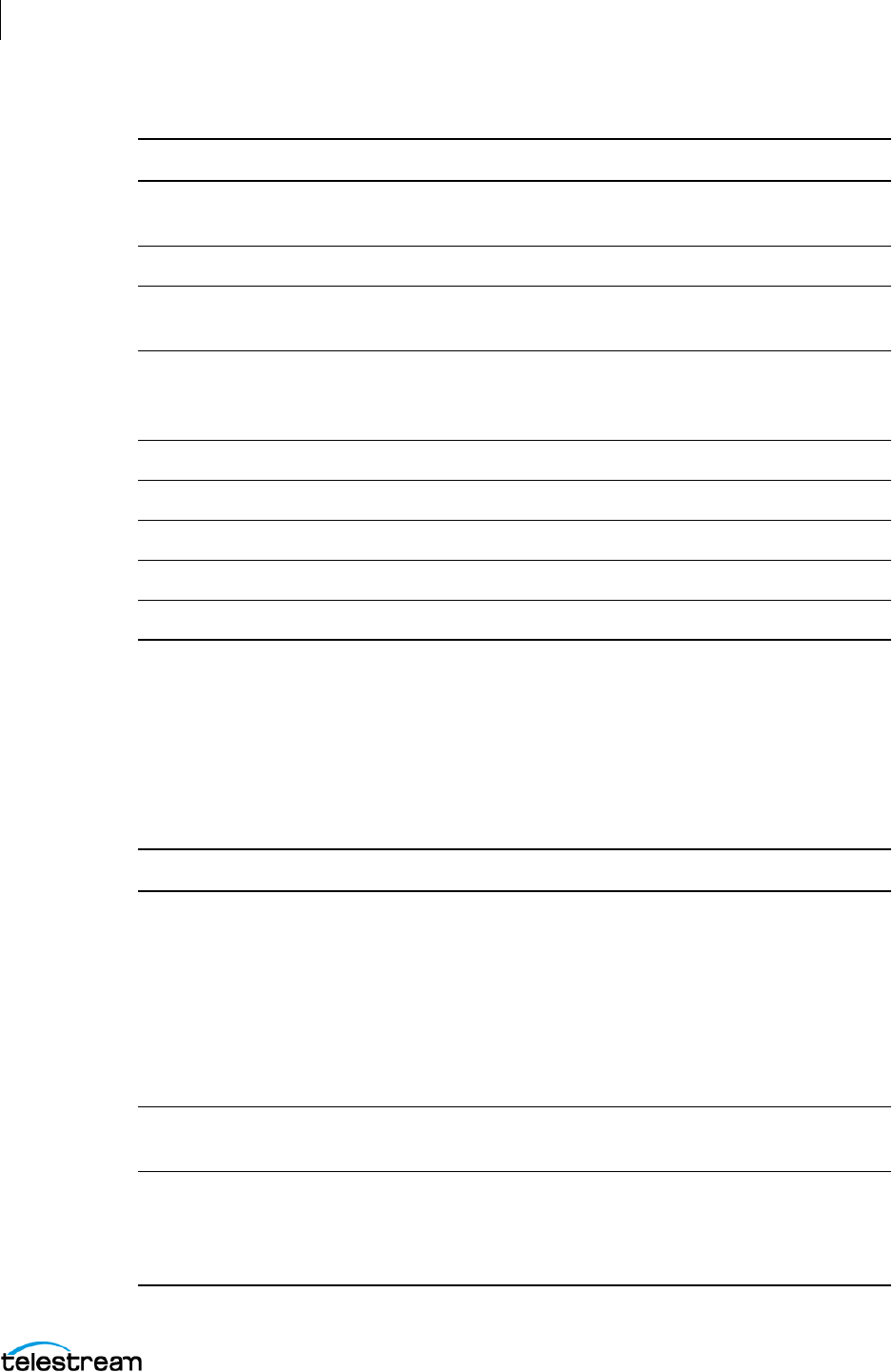
Menus
Clip Menu
150
ScreenFlow User Guide
See Adding a Timeline Marker and Adding a Clip Marker.
Clip Menu
The Clip menu contains the following commands:
Delete
(Shift-~)
Deletes the selected marker.
Delete All Deletes all markers on the timeline.
Go to Next
(Shift-Up Arrow)
Moves the scrubber to the next marker to the right on the
timeline.
Go to Previous
(Shift-Down Arrow)
Moves the scrubber to the previous marker to the left on the
timeline. You can also use the mouse to drag markers and
adjust their position.
Go to See Navigating the Timeline with the Scrubber.
Project Start Moves the scrubber to the start of the project timeline.
Project End Moves the scrubber to the end of the project timeline.
Previous Frame Moves the scrubber to the previous frame on the timeline.
Next Frame Moves the scrubber to the next frame on the timeline.
Table 19. Mark Menu Items
Menu Item Description
Table 20. Clip Menu Items
Menu Item Description
Split Clip
(Command-T |
Command-Shift-T | T)
Converts each selected clip into two separate clips, splitting
them at the current scrubber point, so that you can adjust the
parts of the clip independently.
When splitting a clip, the previous clip name is retained on
both clips. By default, each segment of a clip uses the name of
the original media located in the Media Library.
These segments can be renamed for convenience and clarity.
Replace Media Navigate to and select new media. All settings from old media
are maintained.
Detach Audio Removes the audio stream from the selected clip (visible as a
green waveform through the center of the clip unless
View > Show Audio Waveforms is unchecked), and creates a
new audio clip at the same point on the timeline.
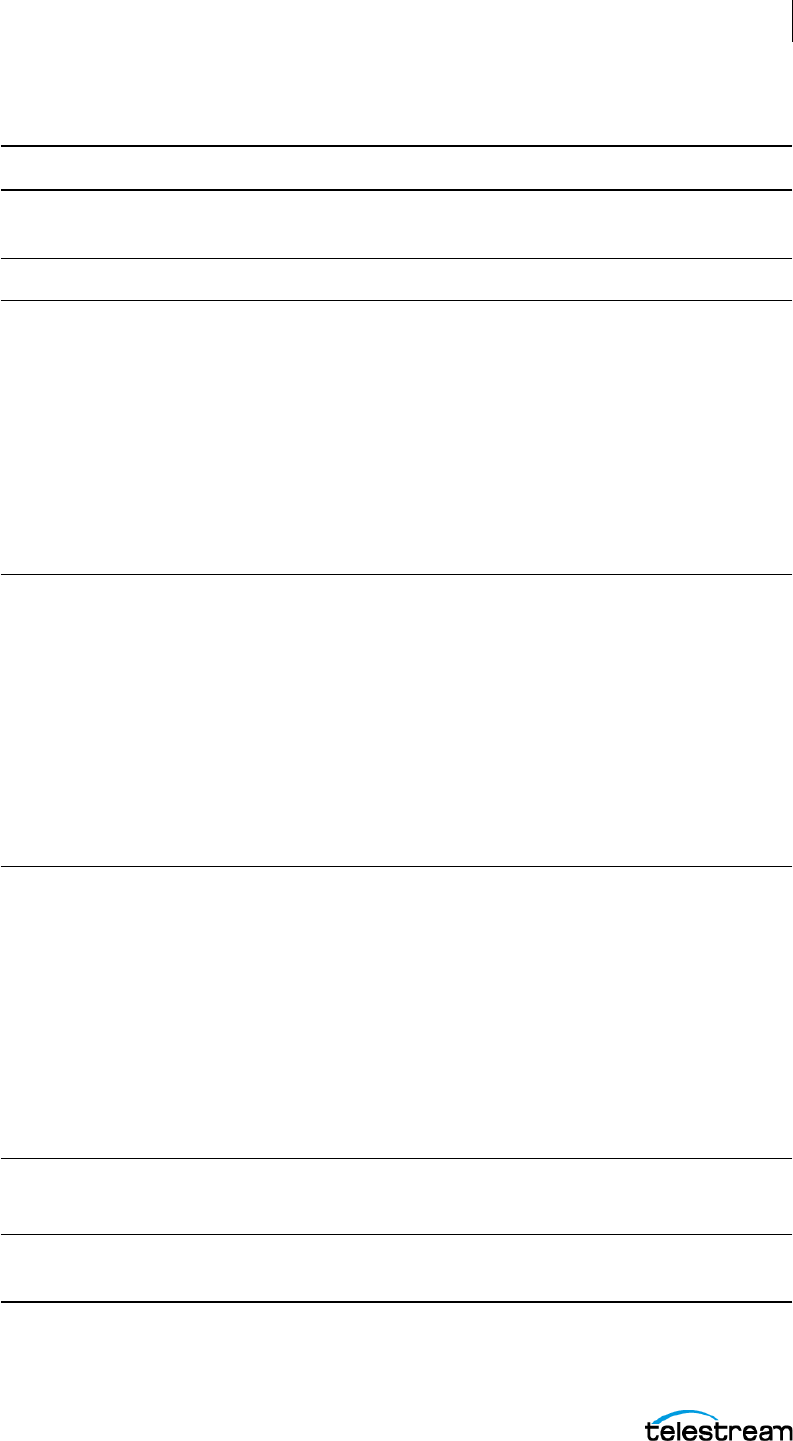
Menus
Clip Menu
151
ScreenFlow User Guide
Extract Audio Select individual audio channel to extract. The extracted
audio channel is placed into a new track.
Extract App Audio
Add Freeze Frame
(Shift-Command-F)
Inserts a freeze frame in the middle of a selected clip.
First, the clip is split at the scrubber, then a two second freeze
frame is inserted between the clips. The duration of the freeze
frame can be set by dragging the edge of the clip, much like
any other still image clip. The second half of the clip is moved
to the right to adjust for the added clip.
See Creating a Freeze Frame.
Note: Go to ScreenFlow > Settings > Timeline to change the
default duration of freeze frames.
Trim Front to
Scrubber
(W)
Trims the front of the selected clips from the start of the clip
up to the scrubber position.
Alternatively, you can adjust the left side of the clip by
clicking the mouse just near the left edge of the clip (the
mouse pointer changes to the drag cursor [left] to indicate
that you can resize the clip). Click and drag the edge of the
clip to the right to trim the amount you want off of the front
of the clip. This method is functionally equivalent to using the
Trim Front to Scrubber command.
See Trimming a Clip in the Timeline.
Trim End to Scrubber
(E)
Trims the back of the selected clips from the end of the clip
up to the scrubber mark.
Alternatively, you can adjust the right side of the clip by
clicking the mouse just near the right edge of the clip (the
mouse pointer changes to the drag cursor [left] to indicate
that you can resize the clip). Click and drag the edge of the
clip to the left to trim the amount you want off of the back of
the clip. This method is functionally equivalent to using the
Trim End to Scrubber command.
See Trimming a Clip in the Timeline.
Edit Speech Clip Displays the Speech Clip window.
See Insert Menu.
Reverse Clip Select to check and uncheck. When checked, media is played
in reverse.
Table 20. Clip Menu Items
Menu Item Description
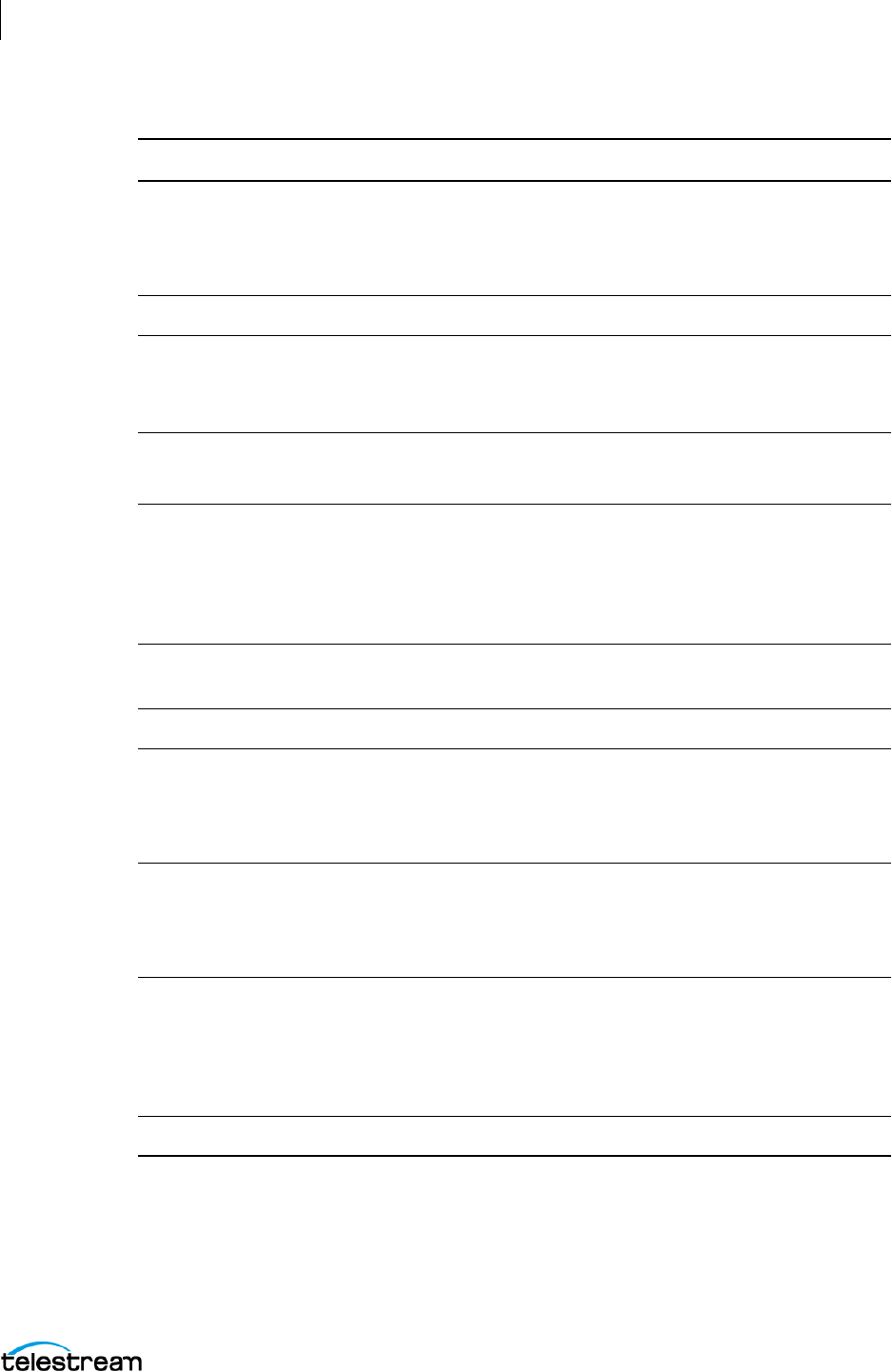
Menus
Insert Menu
152
ScreenFlow User Guide
Insert Menu
The Insert menu contains the following commands:
Lock Clip | Unlock Clip
(Option-Command-L)
Locks selected clips to their positions on the timeline and
cannot be moved. When clips are locked, you cannot move
other clips onto them to make transitions. Select again to
unlock selected clips you have previously locked.
Disable Disables the selected clip.
Nest Clips
(Option-Command-
N)
Nests selected clips into a group for treating the group as a
whole when operating on them.
See Nested Clips for details.
Unnest Clips Unnests a previously nested clip.
See Nested Clips for details.
Group
(Command-G)
Ties selected clips together on the timeline, so that moving
one clip moves all grouped clips. Ideal for synchronizing
voice-overs, music beds, etc., to a camera clip so that their
timing remains synchronized as you move them around in
your project.
Ungroup
(Command-U)
Returns selected clips to be independent of other clips.
Proxy Enables you to create or delete a proxy.
Add Starting
Transition | Remove
Starting Transition
(Option-Command-,)
Adds a transition to the beginning of the selected clip(s).
Apply again to remove the transition.
Add Ending
Transition | Remove
Ending Transition
(Option-Command-.)
Adds a transition to the ending of the selected clip(s). Apply
again to remove the transition.
See Adding Transitions.
Add Starting &
Ending Transitions |
Remove Starting &
Ending Transitions
(Option-Command-.)
Adds transitions to the beginning and ending of the selected
clip(s). Apply again to remove the transitions.
See Adding Transitions.
Label Enables you to add and remove colored labels.
Table 20. Clip Menu Items
Menu Item Description
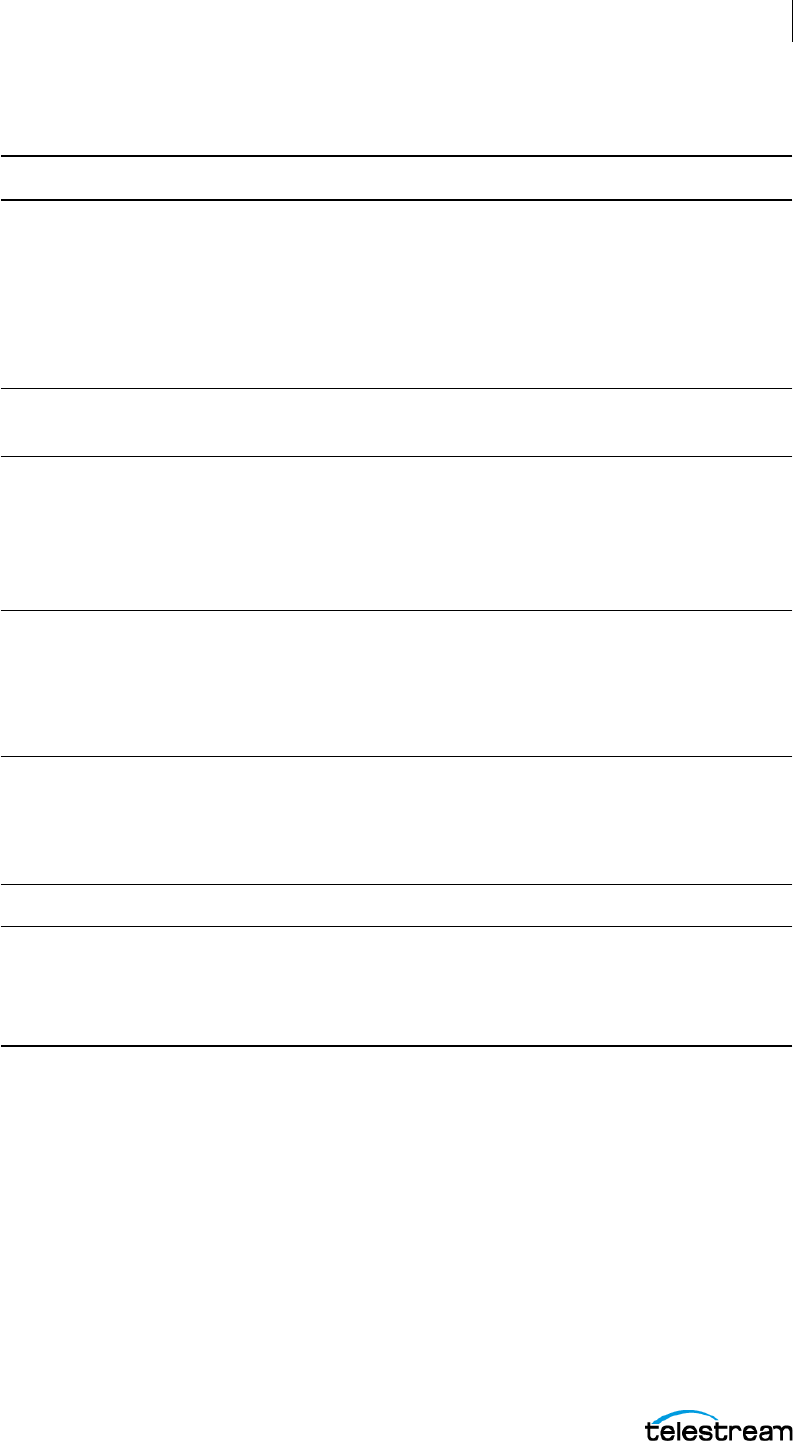
Menus
Actions Menu
153
ScreenFlow User Guide
Actions Menu
Actions are time-based changes to clips used to create gradual temporal or temporary
effects. Actions are applied mid-point, where the change takes place.
The Actions menu contains the following commands:
Table 21. Insert Menu Items
Menu Item Description
Text Box Inserts a text clip into the project at the current scrubber
position. Text box duration is five seconds, but can be
adjusted by dragging the edge of the clip on the timeline.
See Adding and Configuring a Text Clip.
Note: Go to ScreenFlow > Settings > Timeline to change the
default duration of text boxes.
Title Opens a title selection window. Select a title and click on
Select.
Annotations Clip
(Option-Command-T)
Inserts simple graphic effects to visual clips including
recordings, videos, and image files. Annotation shapes
include circle, square, line, and arrow.
Note: Go to ScreenFlow > Settings > Timeline to change the
default duration of annotation clips.
Speech Clip... Displays a sheet where you enter text, select a voice, then
click Insert to create an audio clip in your project by
converting text to speech using one of six automated voice
programs. Text can be typed directly into the field or pasted
from another document.
Template Placeholder
Clip
Inserts a placeholder where a clip from a Screen Recording
and Computer Audio, Camera and Microphone, or IOS device
will be inserted in a new document created using a template.
See Creating a Document Template.
Narration Inserts a narration from an audio device.
Choose...
(Shift-Command-V)
Imports media files into your project at the current playhead
position. ScreenFlow displays the Open dialog, so that you
can browse your file system or network server and select the
media file to add to the project’s media library and timeline.
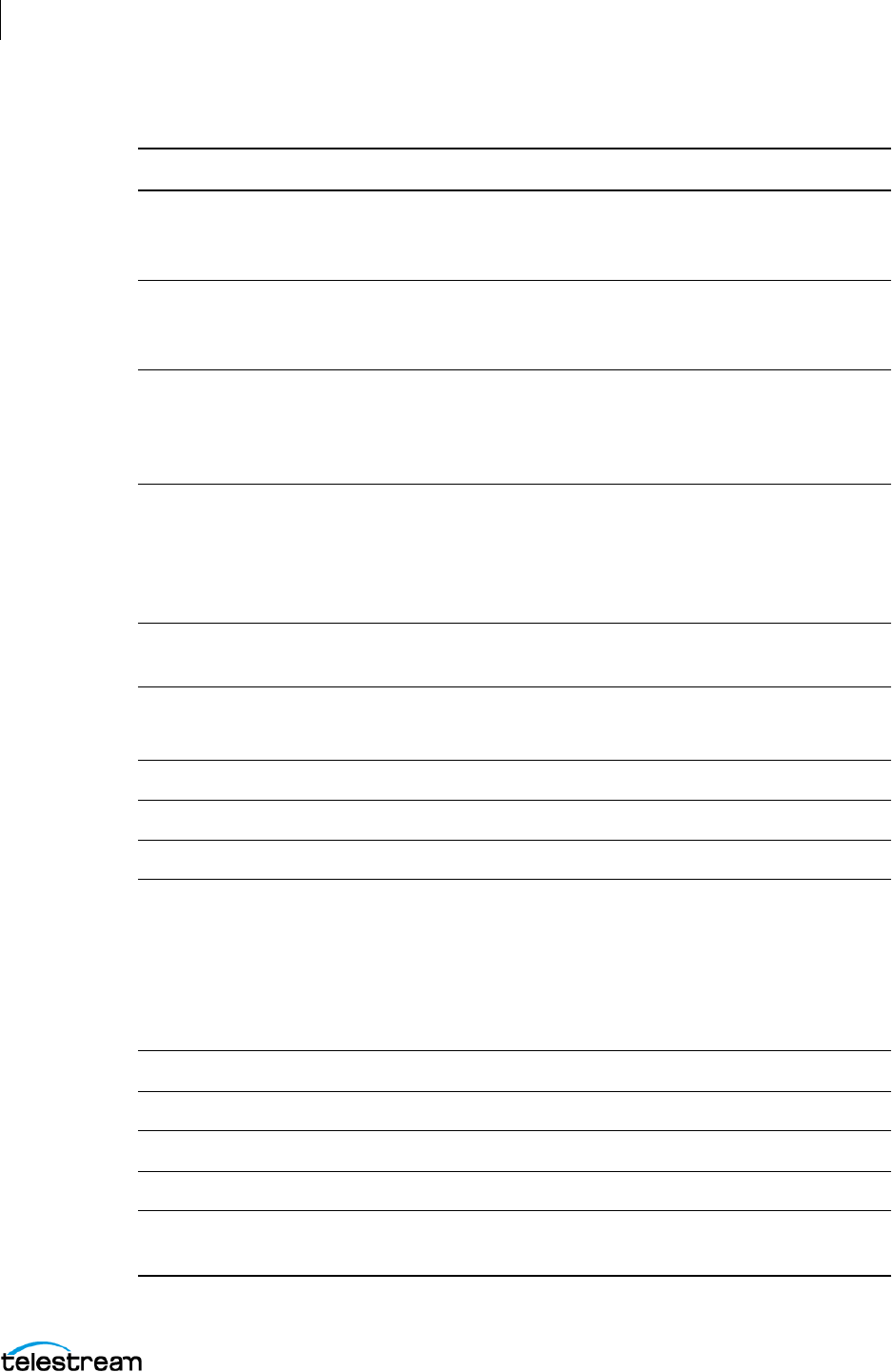
Menus
Actions Menu
154
ScreenFlow User Guide
Table 22. Actions Menu Items
Menu Item Description
Add Video Action
(Command-K)
Adds a Video Action to the selected clip at the location of the
scrubber. A Video Action allows you to apply effects like
Zoom, Pan, and Rotate to your video clip.
Add Audio Action Adds an Audio Action to the selected clip. An Audio Action
allows you to apply various effects on the audio of the
selected clip, such as ducking, or adjusting the volume.
Add Screen
Recording Action
(Command-R)
Adds a Screen Recording Action to the selected screen
recording clip. Screen Recording actions enable you to
modify the size of the Mouse Pointer, add click effects, or
show keys pressed, for example.
Add Callout
(Command-L)
Adds a Callout to the selected screen recording clip. A callout
lets you focus attention on a section of your project. For
example, you can highlight the mouse pointer by dimming
everything but the area just around the mouse pointer or
highlight and magnify the foreground window.
Add Touch Callout Provides a way to automatically receive “touch” events from
the iOS device.
Add Snapback Action Let you add a Video, Audio, or Screen Recording action.
See Modifying Style with Style Presets.
Go to Next Action Within a clip, selects the next action.
Go to Previous Action Within a clip, selects the previous action.
Play Selected Action Plays the currently selected action.
Curve Type By default, actions are applied to the clip in a linear manner.
For example, when applying a scaling action, the image size
changes by equal amounts from start to finish. This may be
perceived as too abrupt, so you can modify the rate with
which an action is applied.
The Curve Type menu item has these submenu items:
Linear Linear transition.
Ease-In Starting slow, speeding up towards the end.
Ease-Out Starting fast, slowing down towards the end.
Ease-In & Out Starting and ending slowly, faster in the middle.
Exponential
Ease-In
Starting slow, speeding up exponentially towards the end.
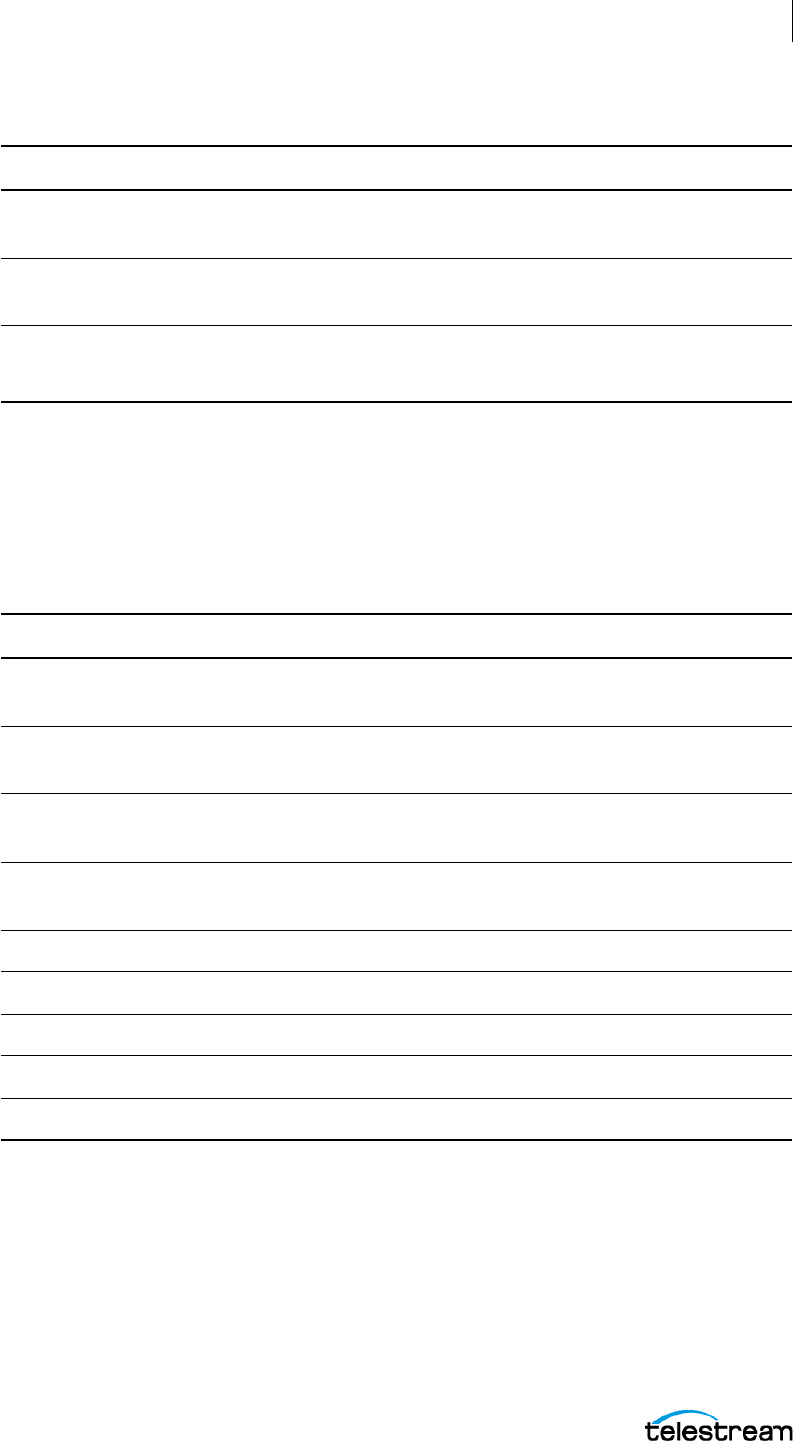
Menus
Font Menu
155
ScreenFlow User Guide
Font Menu
Font options apply only to text in text clips.
The Font menu contains the following commands:
Arrange Menu
Font options apply only to text in text clips.
The Arrange menu contains the following commands:
Exponential
Ease-Out
Starting fast, slowing down exponentially towards the end.
Exponential
Ease-In & Out
Starting and ending slowly, exponentially faster in the
middle.
None Applies action immediately.
The duration of the action is ignored if this option is applied.
Table 22. Actions Menu Items
Menu Item Description
Table 23. Font Menu Items
Menu Item Description
Show Fonts
(Command-T)
Displays the System Font pane. Select a font to apply to
highlighted text, or all text if none is selected.
Bold
(Command-B)
Makes the selected text bold.
Italic
(Command-I)
Makes the selected text italic.
Underline
(Shift-Command-U)
Underlines the selected text.
Bigger Increases the font size by one point.
Smaller Decreases the font size by one point.
Kern Select Text Kerning mode: Default, None, Tighten, Loosen.
Copy Style Copies the style of the selected text, except background.
Paste Style Applies the previously copied text style to the selected text.
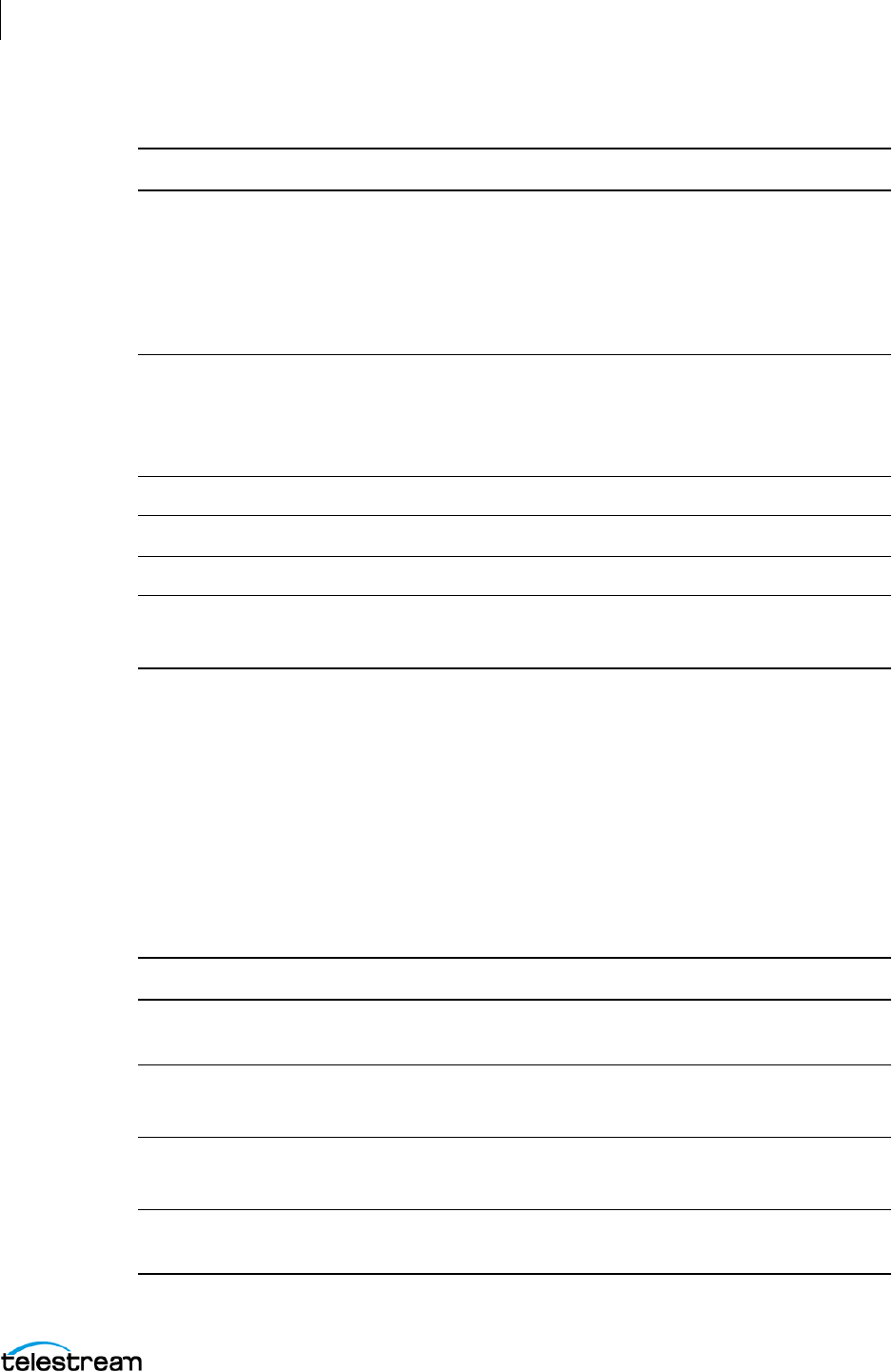
Menus
View Menu
156
ScreenFlow User Guide
View Menu
View options determine how the media is presented both on the canvas and on the
timeline.
These options only change how your project is displayed on the canvas—they do not
alter the media.
The View menu contains the following commands:
Table 24. Arrange Menu Items
Menu Item Description
Align Enables you to align selected clips in six different ways:
Left, Horizontally Center, Vertically Center, Right, Top, Bottom.
NOTE: If you select a single item (not multiple items), alignment
is made along the edge of the canvas. Selecting multiple items
aligns those items to the furthest edge of the grouping, instead
of aligning to the canvas.
Scale Enables you to scale selected clips: Scale to Fit, Stretch, or
Reset. These are the same controls located at the top of the
Video tab of the Inspector window.
See Resizing or Scaling a Clip on the Canvas.
Distribute Evenly distributes display of selected clips.
Group Groups selected items into a single grouped item.
Ungroup Ungroups a selected grouped item into single items.
Lock Clip Locks/unlocks a selected clip so that it can’t be altered.
See Locking Clips.
Table 25. View Menu Items
Menu Item Description
Enter Full Screen
(Command-F)
Displays the editor window in full screen mode to reduce on-
screen clutter.
Zoom In
(Command-=)
Magnifies the display of the canvas.
See Editing on the Canvas.
Zoom Out
(Command--)
Reduces the display of the canvas.
See Editing on the Canvas.
Zoom to 100%
(Option-Command-0)
Displays the canvas area at its direct pixel size.
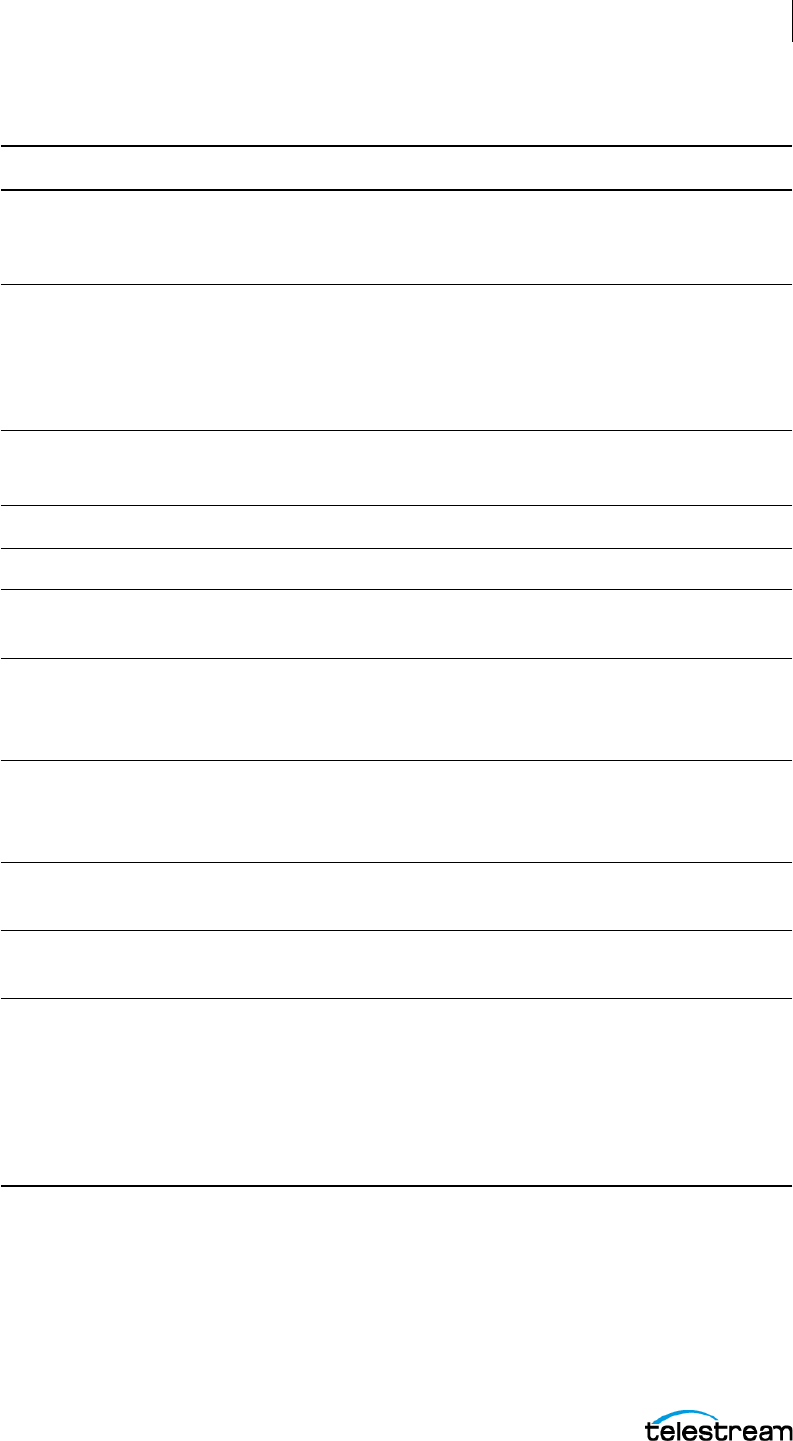
Menus
View Menu
157
ScreenFlow User Guide
Zoom to Fit
(Control-Command-
0)
When the canvas is obscured, adjusts the display size so that
it is completely visible in the window.
Show Checkerboard Displays transparent portions of the background as
checkerboard to distinguish them from opaque portions that
are the same color as the background. To export video with
an alpha channel, use the Lossless - ProRes with Alpha preset
or a custom derivative (see Video Encoding).
Show Captions Displays closed caption text on the canvas.
See Displaying and Previewing Closed Captions.
Hide/Show Inspector Hides or shows the inspector panels.
Hide/Show Timeline Hides or shows the timeline.
Show/Hide Quick
Media Library
Shows or hides the Quick Media Library.
Show Clip Editor Displays the Clip Editor where you can preview media files
and perform quick edits.
See Trimming a Clip in the Timeline.
Zoom Timeline to Fit
(Control-T)
Scales the timeline downward to display it entirely in the
window.
See Zooming In and Out on the Timeline.
Zoom Timeline In
(=)
Expands the timeline.
Zoom Timeline Out
(-)
Contracts the timeline.
Switch to Inspector
(Command 0 - 9)
Displays the selected Properties pane: Video, Audio, Screen
Recording, Callout, Annotations, Text, and Media (library).
Select Focus Timeline to return keyboard events back to the
timeline. For example, when you are editing a text box on the
timeline, you can select Focus Timeline, then use shortcuts.
See The Properties Window and Removing a Filter Background.
Table 25. View Menu Items
Menu Item Description
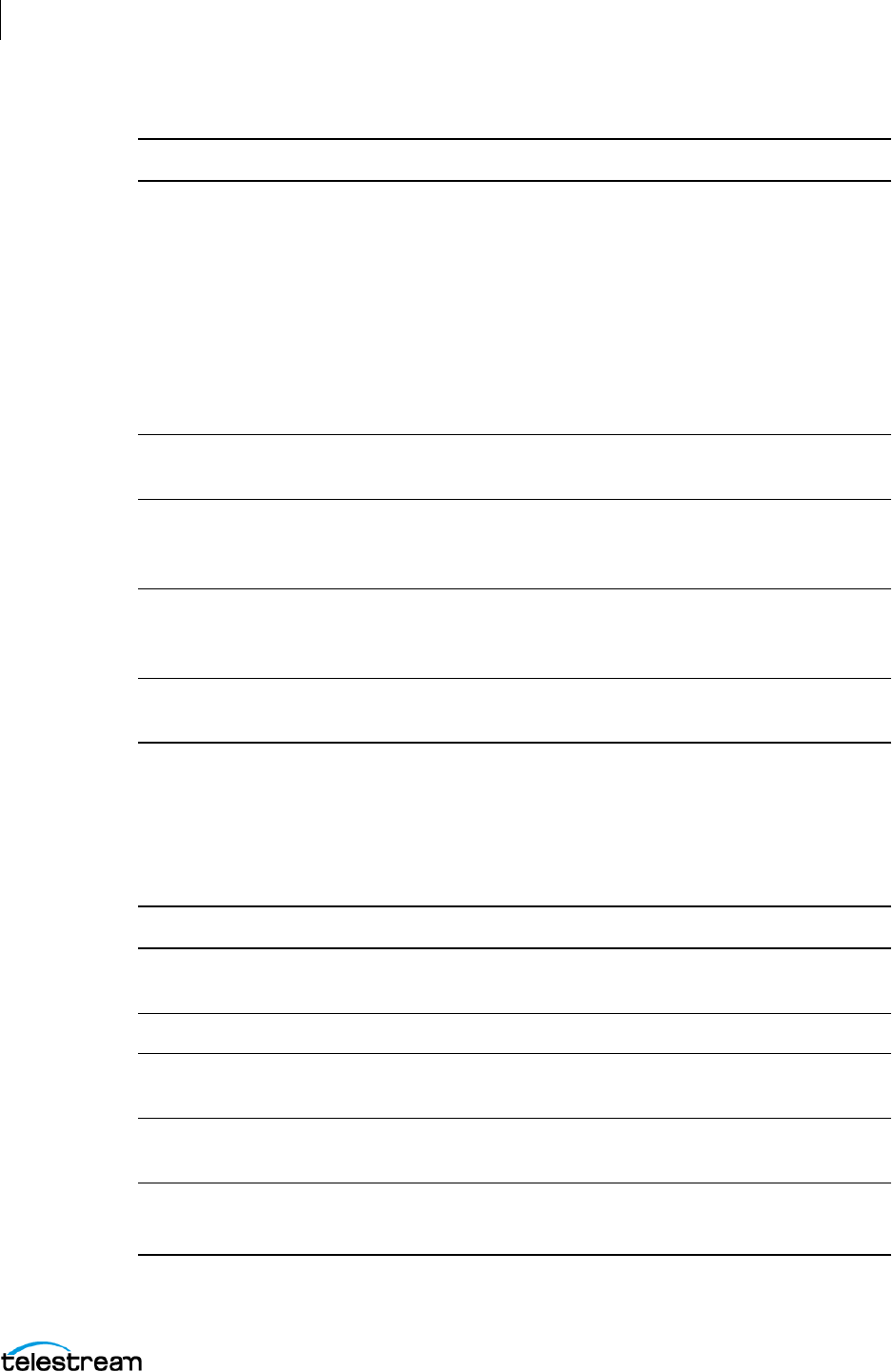
Menus
Window Menu
158
ScreenFlow User Guide
Window Menu
The Window menu contains the following commands:
Snapping
(Control-N)
Toggles snapping for both the canvas and timeline.
When snapping is on, the mouse snaps to various guide-lines.
For example, on the canvas, the mouse snaps your objects to
the center and edges of your canvas. It also snaps to other
objects, if you have any. On the timeline, the mouse snaps to
the beginnings and endings of actions and clips. Checked/On
by default.
You can temporarily toggle snapping by holding down the
Command key.
Scrub Live Audio
(Shift-S)
When activated, you can hear the audio track while dragging
the scrubber. Checked/On by default.
Show Audio
Waveforms
When activated, clips that contain audio have the audio
waveform shown along the center of the clip. Checked/On by
default.
Show Tab Bar Displays the tab bar on the timeline, pushing the timeline and
all tracks down in the window, to accommodate it. When you
create nested clips, each clip nest is identified by a tab.
Show Caption Track Displays the caption track on the timeline—the caption track
is the highest track on the timeline.
Table 25. View Menu Items
Menu Item Description
Table 26. Window Menu Items
Menu Item Description
Minimize
(Command-M)
Minimizes the foreground window.
Zoom Scales the foreground window to the full size of the screen.
Tile window to left of
screen
Locates tie window on left side of the screen.
Tile window to right
of screen
Locates tie window on right side of the screen.
Detached timeline Places selected timeline into a detached window.
See Detaching Timelines.
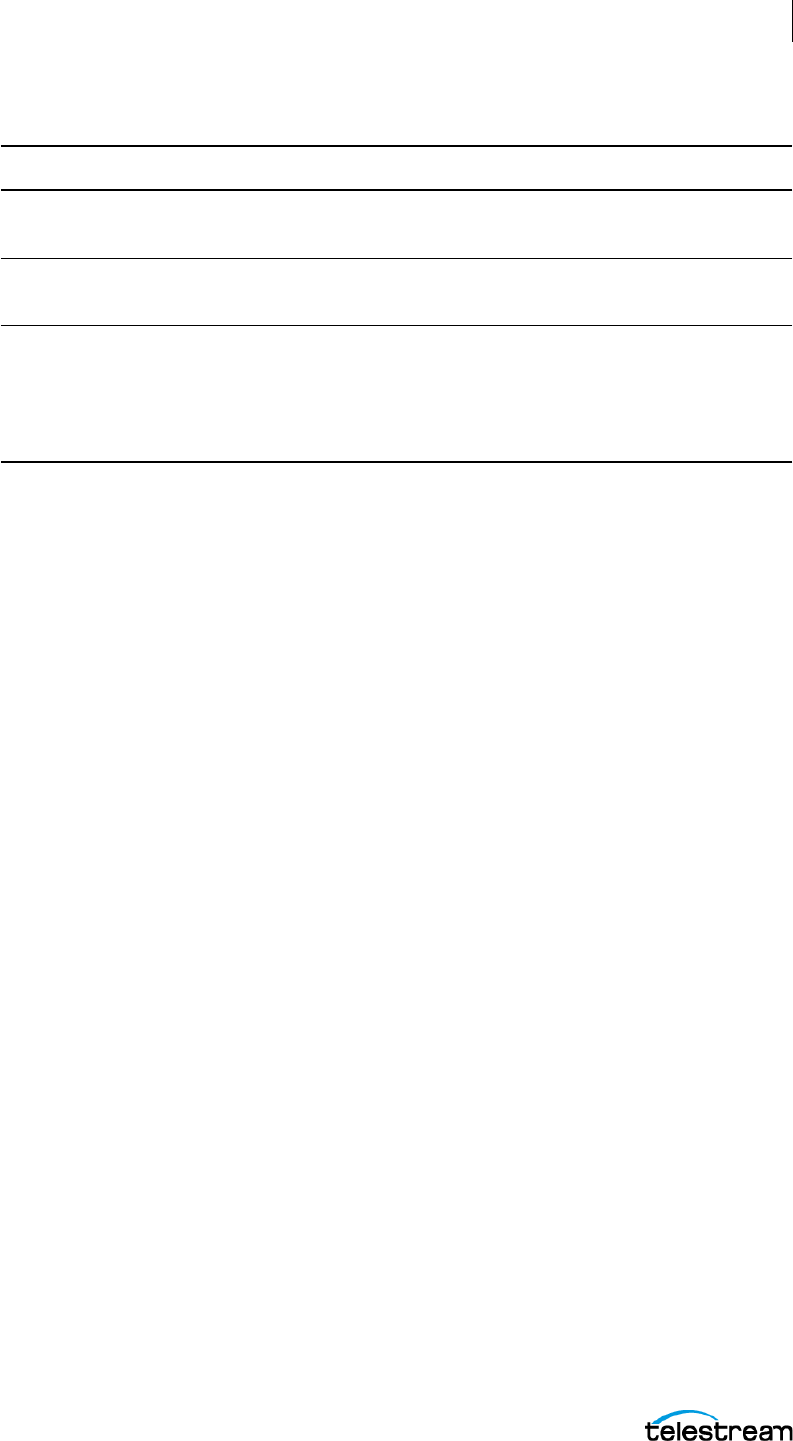
Menus
Window Menu
159
ScreenFlow User Guide
Select Previous Tab
(Shift-Command-[)
When the tab bar is visible in the timeline (as when editing
nested clips), this navigates to the previous timeline tab.
Select Next Tab
(Shift-Command-])
Navigates to the next timeline tab.
Markers Opens a window listing the markers in the current document.
You can add, delete, and rename markers, and jump to
markers in this window.
See Jumping to a Marker.
Table 26. Window Menu Items
Menu Item Description

Menus
Purchase Menu (Telestream Web Store Only)
160
ScreenFlow User Guide
Table 27. Window Menu Items (continued)
Purchase Menu (Telestream Web Store Only)
Note: This topic does not apply if you purchased ScreenFlow from the Mac App Store.
The App Store has its own installation and licensing procedure.
Use these Purchase menu commands for purchasing from the Telestream Web Store
and activating your ScreenFlow license, as described in table Table 28.
Note: If your ScreenFlow license is already activated, this menu does not display.
The Purchase menu contains the following commands:
Menu Item Description
Minimize
(Command-M)
Minimizes the foreground window.
Zoom Scales the foreground window to the full size of the screen.
Tile window to left of
screen
Locates tie window on left side of the screen.
Tile window to right
of screen
Locates tie window on right side of the screen.
Detach timeline Places selected timeline into a detached window
Select Previous Tab
(Shift-Command-[)
When the tab bar is visible in the timeline (as when editing
nested clips), this navigates to the previous timeline tab.
Select Next Tab
(Shift-Command-])
Navigates to the next timeline tab.
Markers Opens a window listing the markers in the current document.
You can add, delete, and rename markers, and jump to
markers in this window.
Bring All to Front Puts all ScreenFlow windows in front of any other
application's windows on the desktop.
<documents> List of all open document windows, listed sequentially in the
order they were opened.
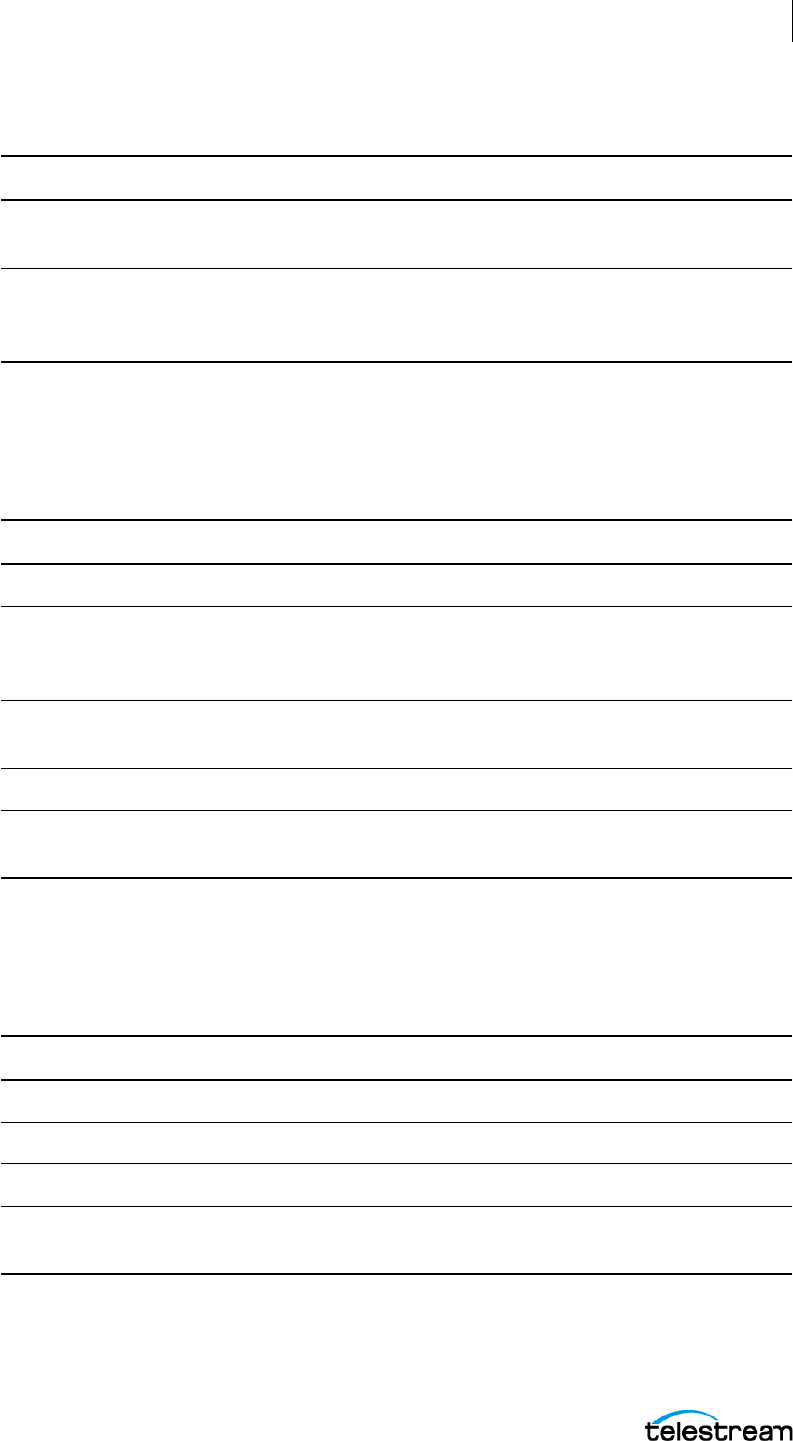
Menus
Help Menu
161
ScreenFlow User Guide
Help Menu
The Help menu contains the following commands:
Editor Drop-Down Menu
The Editor menu contains the following commands:
Table 28. Purchase Menu Items
Menu Item Description
Purchase ScreenFlow
Online
Displays the Telestream online Web store.
Unlock ScreenFlow Displays the Licenses tab of ScreenFlow Settings to enter a
license. Requires admin authentication first. See Unlocking
ScreenFlow via Telestream Web Store.
Table 29. Help Menu Items
Menu Item Description
Search Searches the User Guide (this document).
ScreenFlow Help Displays the ScreenFlow Help Landing Page, where you can
access the ScreenFlow User Guide, watch tutorials of
ScreenFlow topics, and access other helpful resources.
Visit ScreenFlow Web
site
Displays the Web page for general ScreenFlow information.
Visit Support Page Displays the Web page for ScreenFlow support information.
Provide ScreenFlow
Feedback
Goes to the ScreenFlow support Web page.
Table 30. Help Menu Items
Menu Item Description
Text Box When clicked, ScreenFlow creates a text box on the Canvas.
Title When clicked, ScreenFlow opens the Media Library.
Annotations Clip When clicked, ScreenFlow opens the Annotations tab.
Speech Clip... When clicked, ScreenFlow opens a dialog where you can
enter text that ScreenFlow converts into speech.
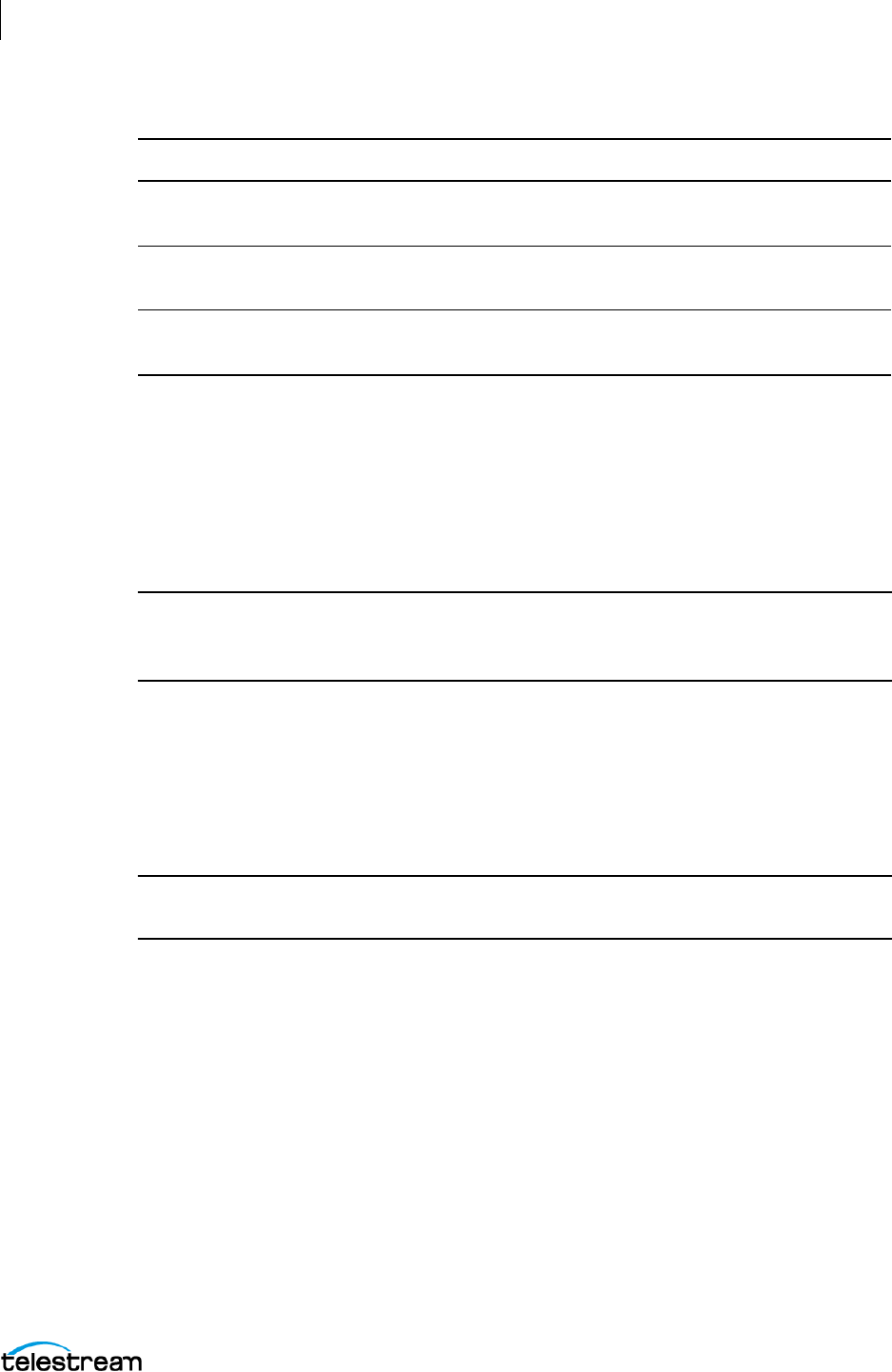
Menus
The Media Library Context Menu
162
ScreenFlow User Guide
See The Editor Window.
The Recording Monitor
The Recording Monitor provides a preview of your microphone and camera during a
recording. With the Recording Monitor, you can check audio levels, keep the camera
shot correct, and set the duration of the recording.
Note: When the Recording Monitor is visible, ScreenFlow includes the Recording
Monitor in the screen recording. To prevent this, move the Recording Monitor window
to an area of the screen that will be cropped out, or move it to another monitor.
The Recording Monitor tracks the selected inputs in the ScreenFlow recording
configuration. If you have disabled both the camera and microphone, the Recording
Monitor shrinks to a timer. During recording, the green striped header at the top of the
recording monitor changes to red. When recording, ScreenFlow displays the timer text
in white. When not recording ScreenFlow grays out both the timer and the Add Marker
buttons.
Note: Only the microphone audio is monitored, not the entire audio of your
recording.
The Media Library Context Menu
Control-click (right-click) on a clip in the media library to display the context menu.
See The Editor Window.
You can perform the tasks described in Table 31.
Template Placeholder
Clip...
When clicked, ScreenFlow opens a dialog you can use to
create a placeholder clip.
Narration... When clicked, ScreenFlow adds an audio recording button to
the Editor controls, and opens a recording dialog.
Choose File... When clicked, ScreenFlow opens a file browse you can use to
select a file for the Canvas.
Table 30. Help Menu Items
Menu Item Description
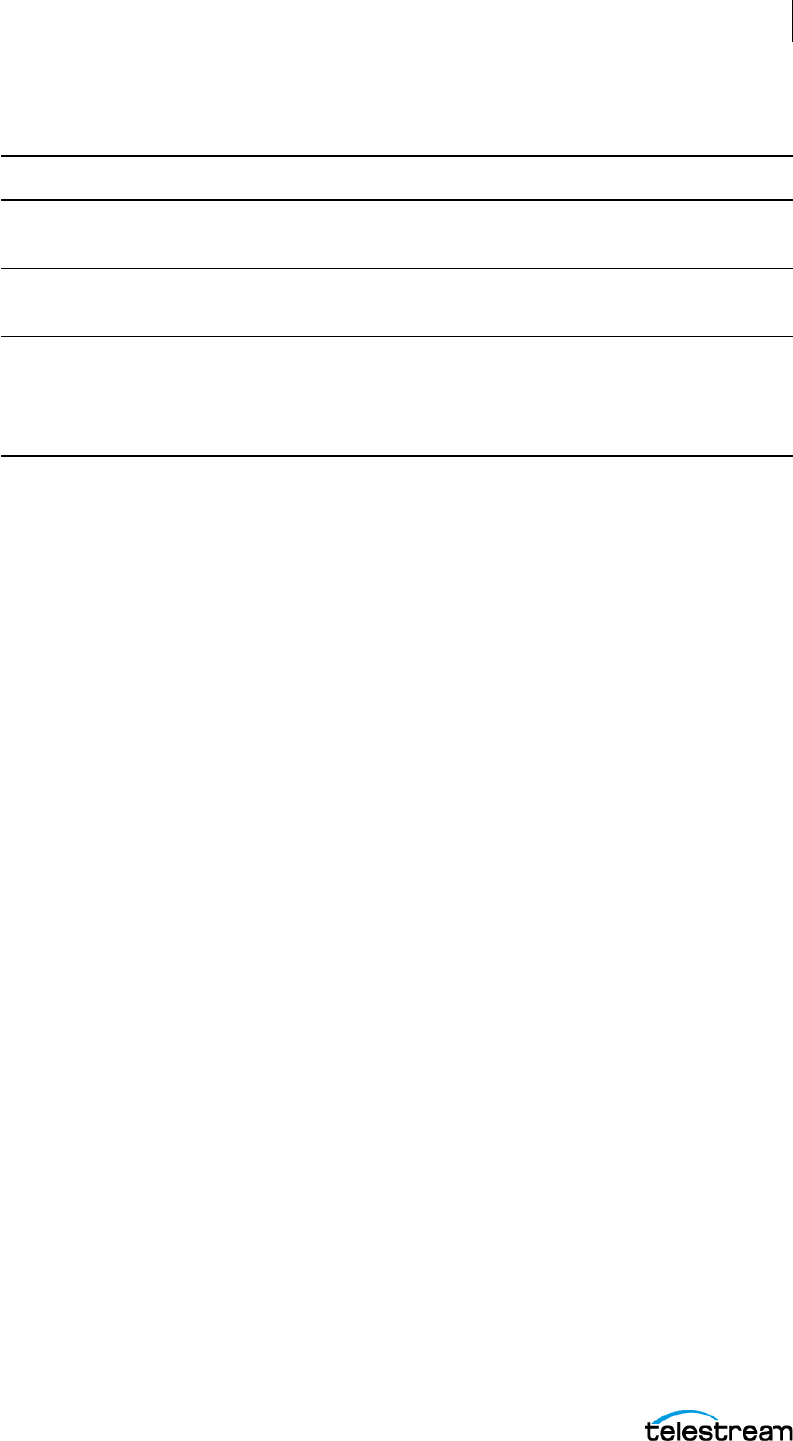
Menus
The Media Library Context Menu
163
ScreenFlow User Guide
Table 31. Media Library’s Media Menu
Menu Item Description
Add to Timeline at
Scrubber
Select to add your media to the timeline at the current
scrubber position.
Select Clips in
Timeline
Select to select the clip or clips to show where this clip is
being used on the timeline.
Delete Media Select to remove the SCC media files from your document. If a
media file is on the timeline, ScreenFlow removes it, following
a confirmation prompt. ScreenFlow does not delete media
files not in SCC format.

Menus
The Media Library Context Menu
164
ScreenFlow User Guide
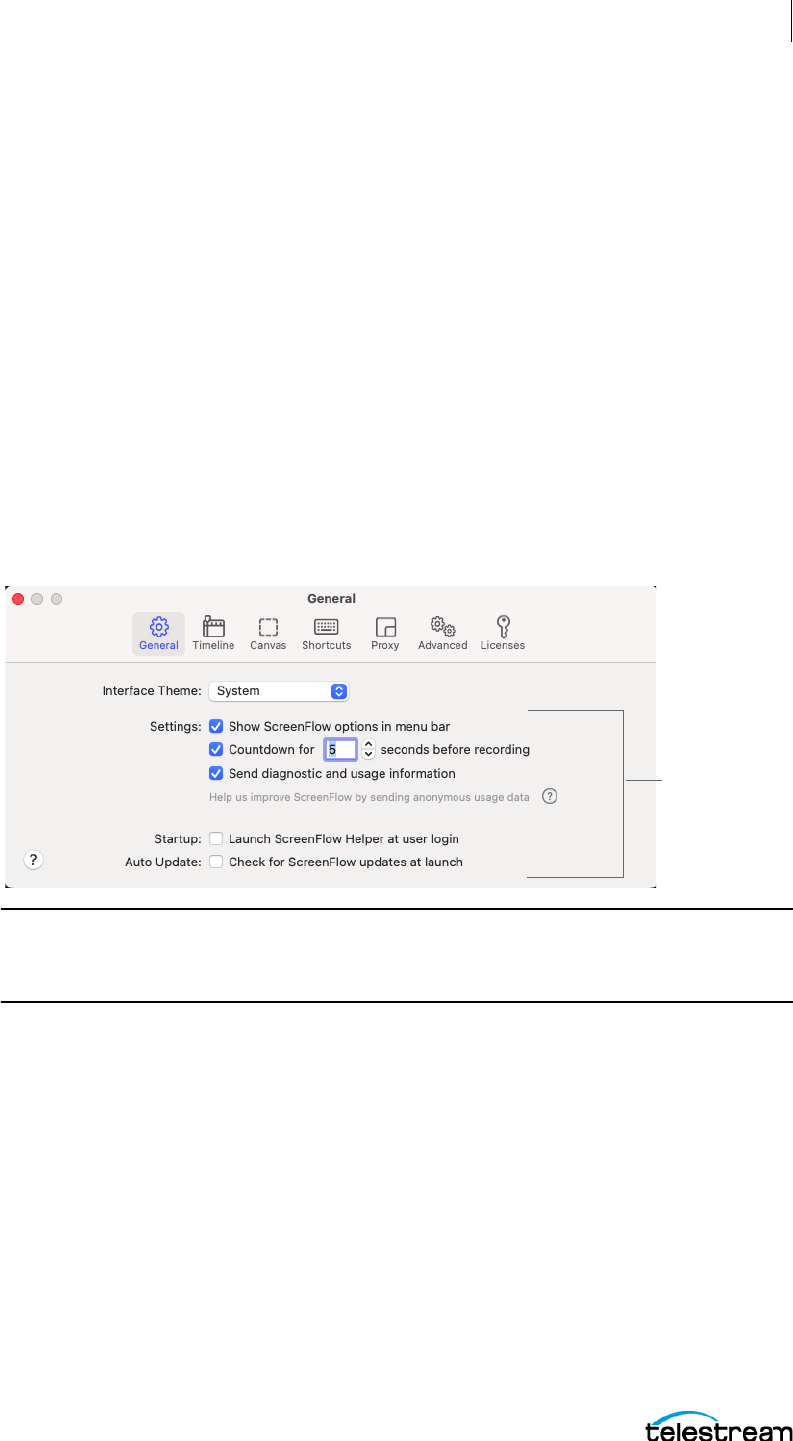
165
ScreenFlow Settings
You can set your options and customize ScreenFlow to suit your specific needs via
ScreenFlow Settings.
Figure 1. Settings Dialog
Note: If you purchased ScreenFlow through the Mac App Store, ScreenFlow doesn’t
display the Licenses tab. The Mac App Store has its own licensing and updating
processes.
Topics
■ General Settings Tab
■ Timeline Settings Tab
■ Canvas Settings Tab
■ Shortcuts Settings Tab
■ Proxy Settings Tab
■ Advanced Settings Tab
■ Licenses Settings Tab
ScreenFlow
doesn’t display
these features if
ScreenFlow
was purchased
from the Mac
App Store
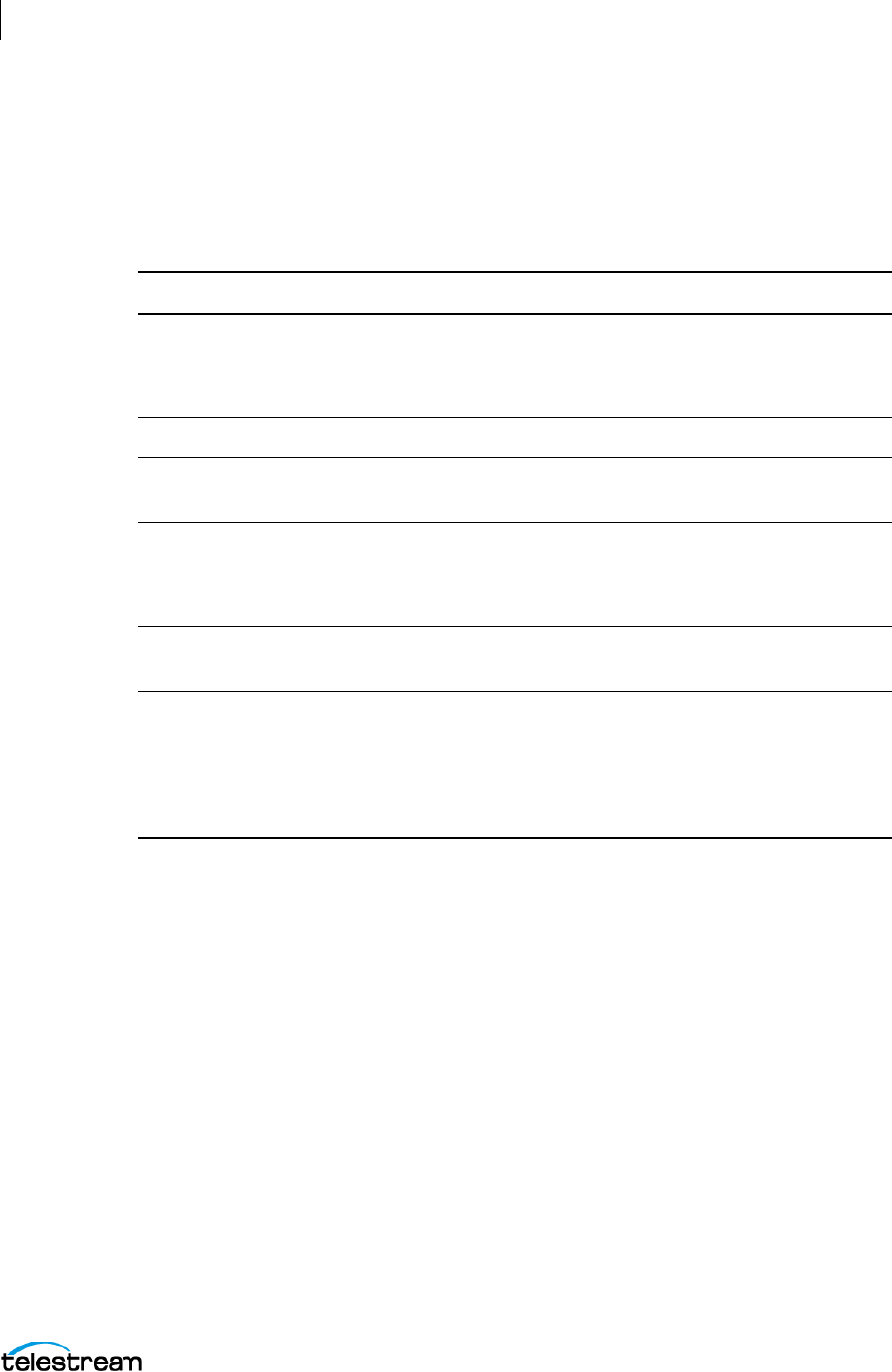
ScreenFlow Settings
General Settings Tab
166
ScreenFlow User Guide
General Settings Tab
The General Settings tab provides startup, display, recording, and auto-update options.
The General Settings controls are described in Table 1.
Timeline Settings Tab
Use the Timeline Settings tab to set timeline options.
The Timeline Settings controls are described in Table 2.
Table 1. General Settings Options
Control Description
Interface Theme Select Light or Dark. This affects how menus are displayed.
ScreenFlow uses the macOS settings for Light and Dark mode
by default.
Settings Check the features to be enabled when using ScreenFlow:
Show ScreenFlow Check to toggle the ScreenFlow Helper menu on and off in
the status menu.
Countdown Check to use the Countdown window, and set the countdown
time (in seconds). Range: 0 - 10. Default: 5.
Send Diagnostic Sends anonymous usage data to Telestream.
Startup Check to launch ScreenFlow Helper when you log in so that
you can record without first launching ScreenFlow.
Auto Update Check to automatically check for updates each time you start
ScreenFlow, so you can update ScreenFlow immediately.
Note: This option is not available if you purchased
ScreenFlow from the Mac App Store. The App Store has its
own update procedure.
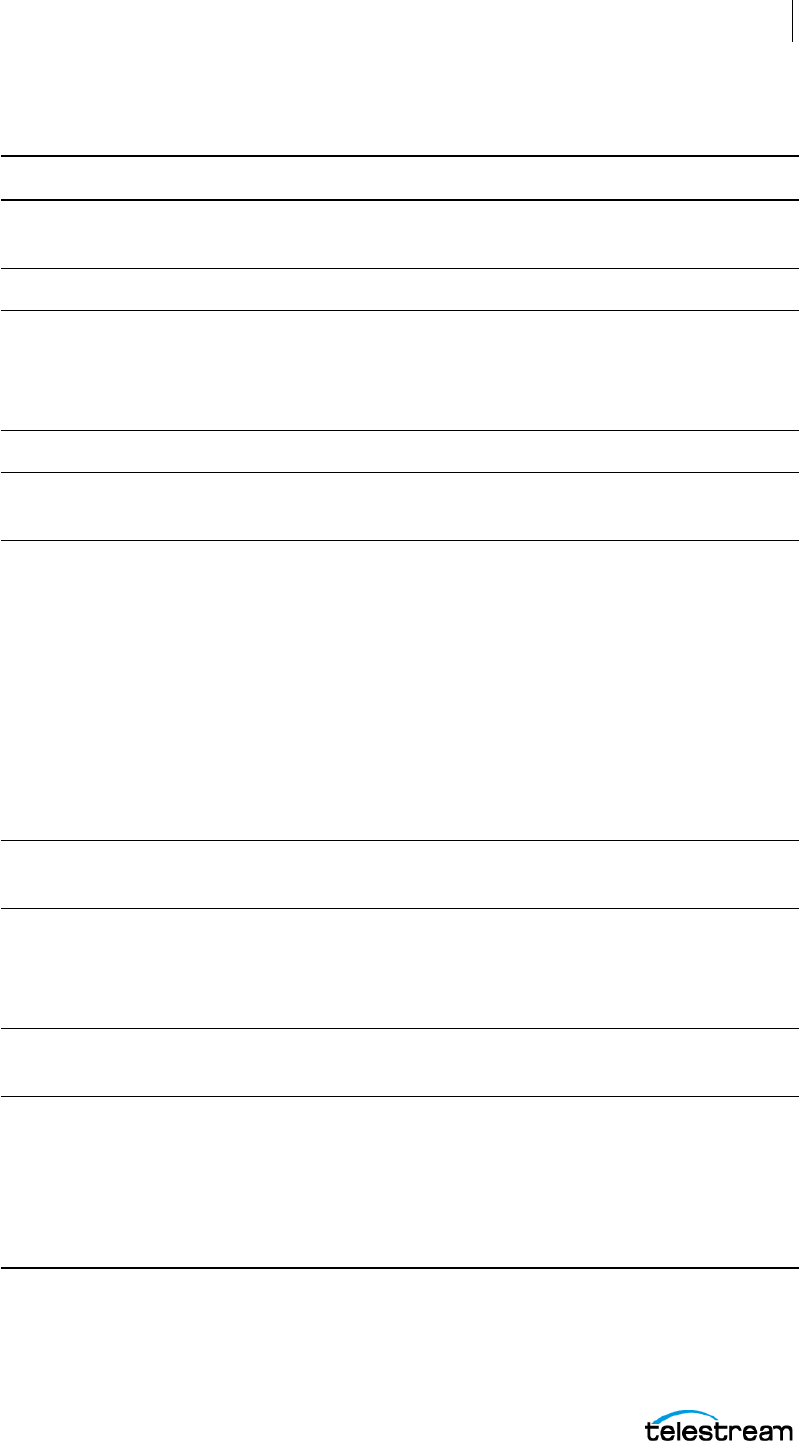
ScreenFlow Settings
Timeline Settings Tab
167
ScreenFlow User Guide
Table 2. Timeline Settings Options
Control Description
Editing When checked, the scrubber will be repositioned after a paste
action.
Display
Use SMPTE timecode Check to display the scale as SMPTE timecode
(HH:MM:SS:FF—Hours:Minutes:Seconds:Frames).
If unchecked, the scale displays the scale informally. For
example: 1h2m30s.
Hide Action Menu Check to hide the action gear menu in clips.
Double-click in Media
Catalog
Choose between sending a clip to the clip editor (when
double clicking), or sending it directly to the timeline.
Thumbnail Cache Enter size of the thumbnail cache (in megabytes). A value of
zero means unlimited cache sizing. Once you have updated
the maximum cache size, the cache is checked for cleanup.
While thumbnails are being generated, the cache is
automatically cleaned up every three minutes, to ensure it
does not run out of control. When thumbnail icons are
removed due to the size of the cache, the oldest are deleted
first.
The thumbnails are stored at:
~/Library/Caches/net.telestream.ScreenFlow9/Thumbnails
Default Transition Select the default effect to use when generating a transition.
Default: Bars Swipe.
Default Track Height Select the default track height of timeline tracks: Small,
Regular, or Large. If your project has many tracks, you can set
this to Small to view more tracks in your window without
scrolling. Default: Regular.
Default Action Curve Select the default Action Curve: Linear, Ease In or Out,
Exponential Ease In or Out, or None.
Default Durations Select the duration field of the item you want to change.
These are default time values for actions, transitions, still
images, callouts, and annotations. Enter the value (in
seconds) of the default length of the item when added to the
timeline. Range: one-tenth of a second (typically 3 frames) up
to (but not including) 30 seconds.
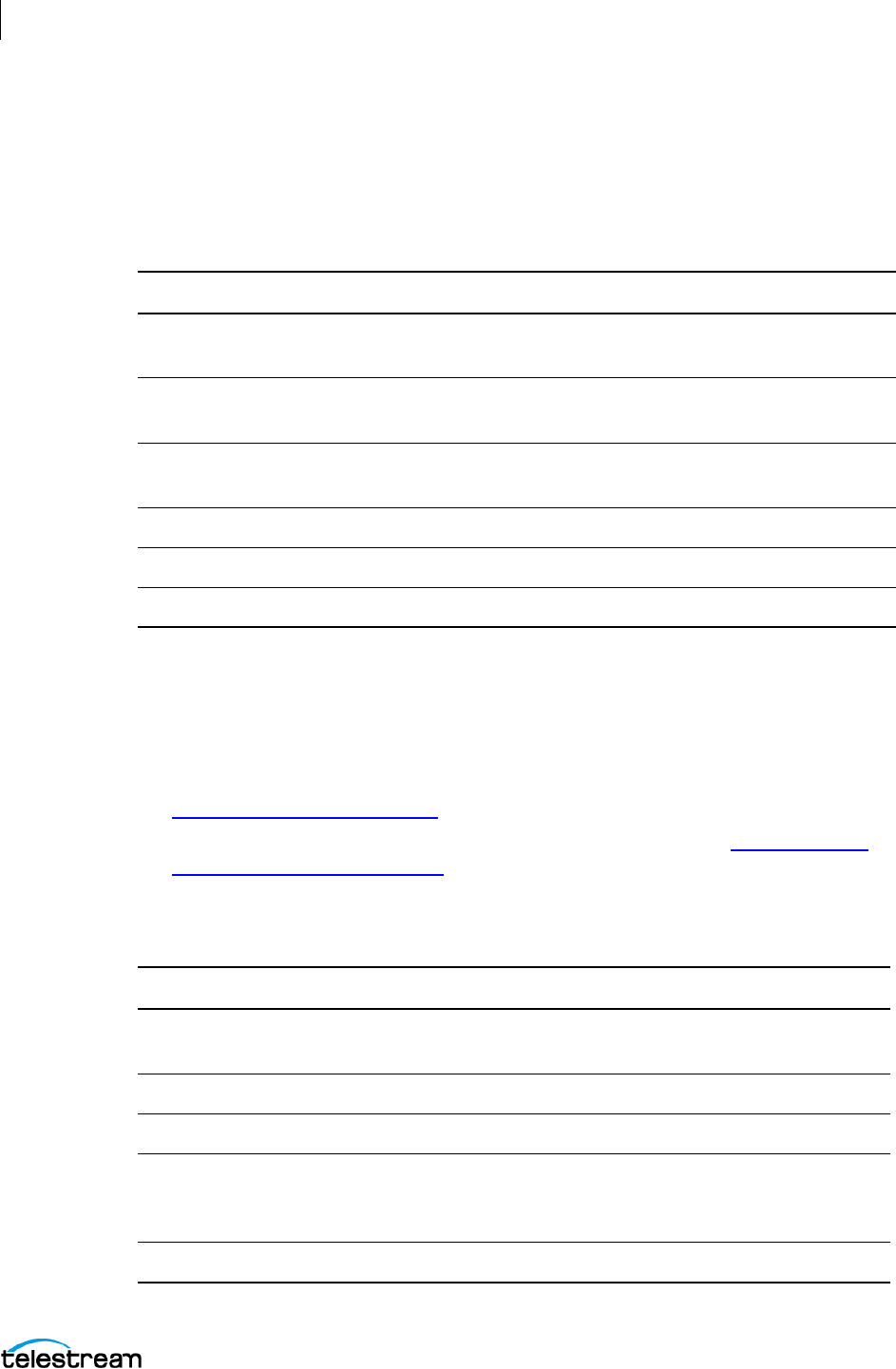
ScreenFlow Settings
Canvas Settings Tab
168
ScreenFlow User Guide
Canvas Settings Tab
Use the Canvas Settings tab to set canvas options.
The Canvas Settings controls are described in Table 3.
Shortcuts Settings Tab
To speed up your workflow, you can start many ScreenFlow features with keyboard
shortcut commands. Use the Shortcuts tab to create custom keyboard shortcuts.
For a complete list of ScreenFlow keyboard shortcuts that you can customize, see
ScreenFlow keyboard shortcuts
.
Also see Finding Keyboard Shortcuts, Changing Shortcut Keys, and Keyboard Short-
cuts and Hotkey Customizations.
The Shortcuts Settings controls are described in Table 4.
Table 3. Canvas Settings Options
Control Description
Lock Aspect Ratio Check to cause aspect ratio to be maintained when scaling
using the mouse.
Show Z Rotation
Controls
Check to display Z rotation controls.
Default Background
Color
Click on the color square to open the default background
color pallet.
Snap to other clips Check to cause new clips to snap to other clips.
Snap to edges Check to cause new clips to snap to edges.
Snap Line Color Click on the color square to open the snap line color pallet.
Table 4. Shortcuts Settings Options
Control Description
Keyboard Shortcut
Set
Select Configure, Import, or Export. Configure opens a
configuration window.
Default Select this option to activate the default keyboard shortcuts.
<Custom Shortcut> Select from a list of user created custom shortcuts.
Configure Select to open the configuration window. Click the plus icon
(+) to add a new custom shortcut set. Click the minus icon (-)
to delete any selected set.
Import Select to import a saved (exported) shortcut set.
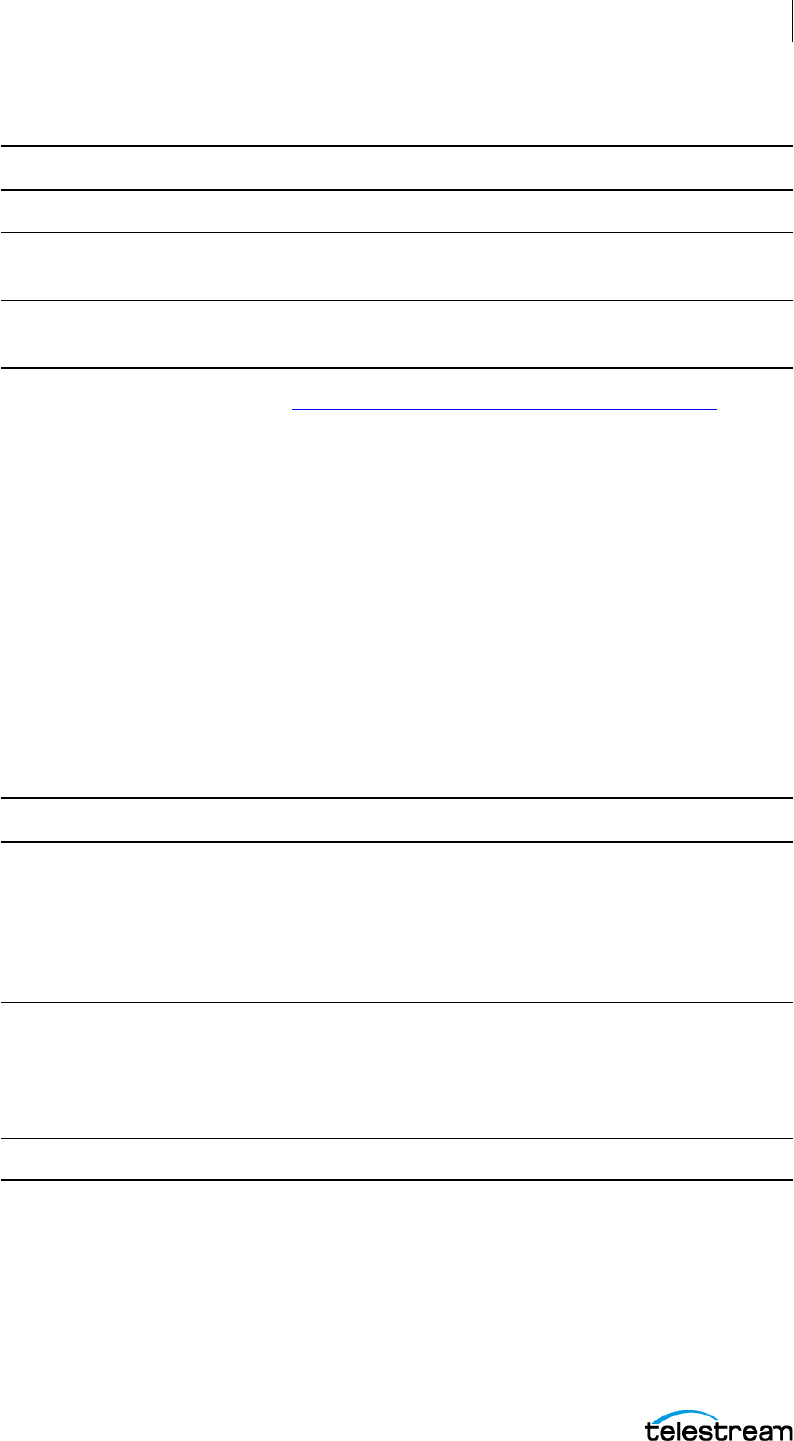
ScreenFlow Settings
Proxy Settings Tab
169
ScreenFlow User Guide
See Changing Shortcut Keys and Keyboard Shortcuts and Hotkey Customizations.
Proxy Settings Tab
The Proxy tab provides ScreenFlow settings for proxy media. Proxies are lower quality
media files that take the place of the originals during editing. When the final export is
done, ScreenFlow renders from the original files (not from the proxy files) for the best
quality output.
ScreenFlow indicates the progress of proxy creation with a pink progress bar on the
Timeline and on the Timecode user interface. When the proxy file is created,
ScreenFlow displays a solid pink circle.
The Proxy Settings options are described in Table 5.
Advanced Settings Tab
The Advanced Settings tab provides ScreenFlow settings for video magnification,
compression, and managing your audio driver and scratch disk. The Advanced Settings
options are described below.
Export Select to export (save) a shortcut set.
Show Select All or Customized. All displays all shortcuts sets,
whereas Customized display only the set created by the user.
Search Enter a word to use for searching in the list of shortcuts. The
list is reduced, as matches are found, while your type.
Table 4. Shortcuts Settings Options
Control Description
Table 5. Proxy Settings Options
Preference Description
Proxy Creation Mode In Automatic mode, ScreenFlow will decide if the imported
content would benefit from having a proxy created.
In Always mode, when a media file that can have a proxy
made is added to the Media Library or the Timeline, the proxy
creation progress starts.
Options Check Limit size of proxy cache to, then enter the size in GBs.
Check Automatically delete proxy files after, then enter the
number of days.
Check Create proxies at half original resolution (Optionally).
Proxy Cache Location Click Change to select a proxy cache location.
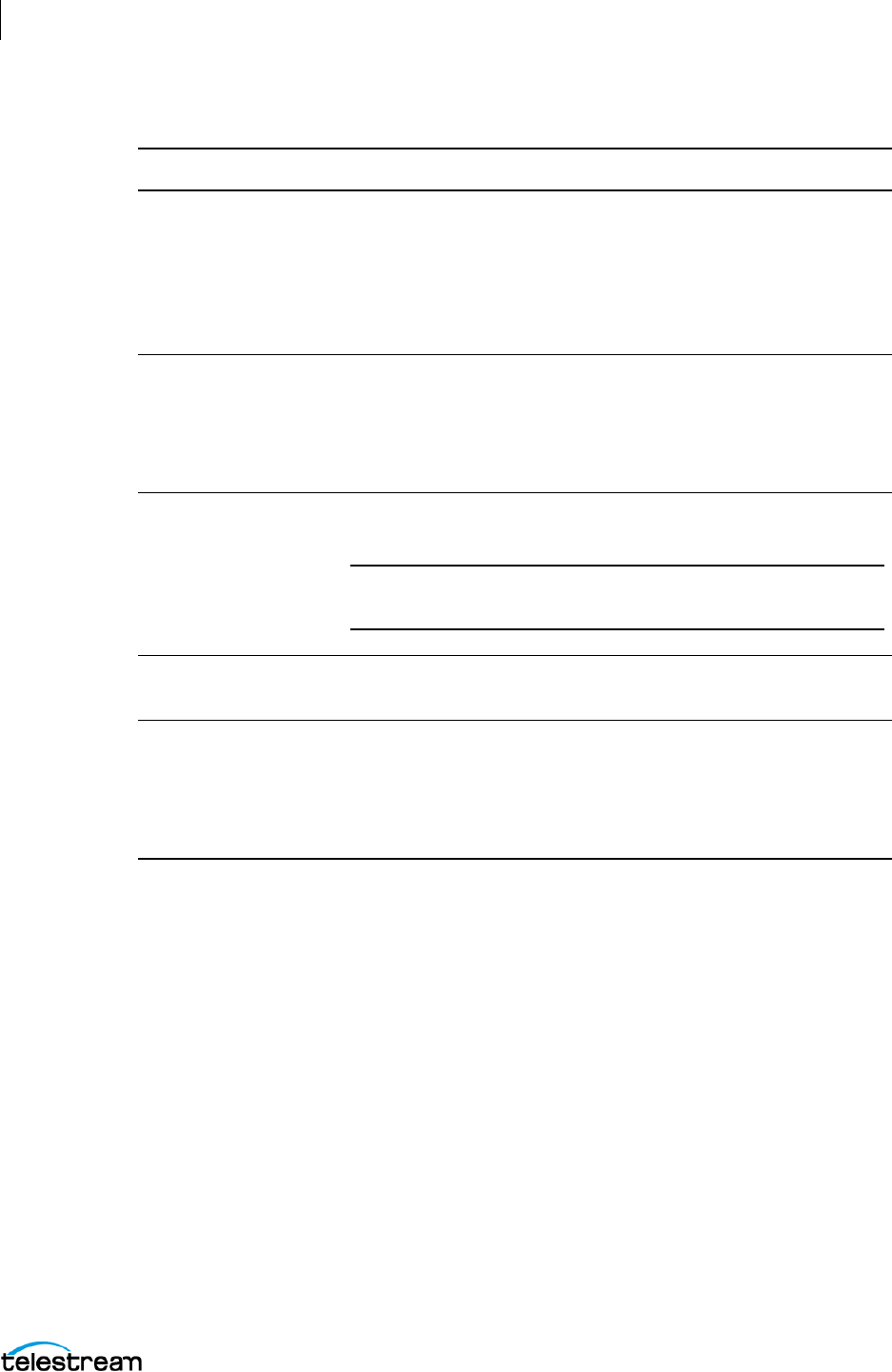
ScreenFlow Settings
Advanced Settings Tab
170
ScreenFlow User Guide
Table 6. Advanced Settings Options
Preference Description
Video Magnification Select Smooth or Sharp to set the compression algorithm for
magnification. Smooth blurs color values and creates
smoother edges. Sharp does not blur color values, but can
result in jagged, pixelated edges. Default: Smooth.
This setting controls both how ScreenFlow displays inputs in
the Preview window, and how ScreenFlow generates outputs.
Screen Recording
Compression
Select Adaptive | Lossless to specify the method of
compression used. Adaptive is compressed, which minimizes
file size, but the loss in video quality is not noticeable to most
users. Lossless is uncompressed which captures all pixels,
thereby resulting in a larger file size. Default: Adaptive.
Computer Audio Click to install or uninstall the ScreenFlow audio driver, which
is required for recording computer audio.
Note: If you purchased ScreenFlow through the App Store,
the computer audio driver is installed automatically.
DAW Support Check Allow device to be Sound Output, or Disable Sound
Output Monitoring, as desired.
Allow device to be
sound output
Checking this option makes the Telestream Audio Capture
device always available for output and configuration. This
allows you to design an audio workflow while not actively
recording. The Telestream Audio Capture device is normally
hidden from the user to simplify the common usage patterns.
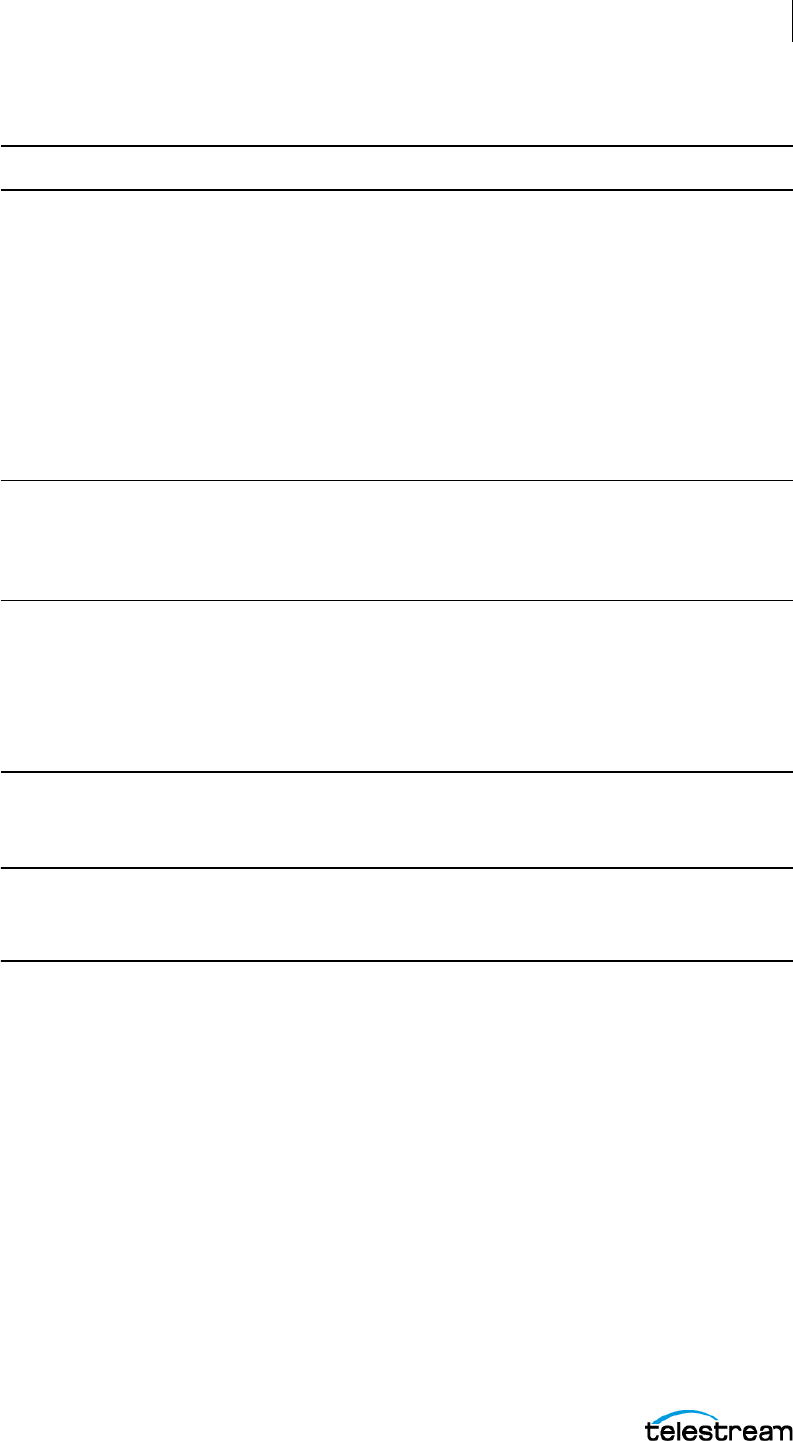
ScreenFlow Settings
Licenses Settings Tab
171
ScreenFlow User Guide
Licenses Settings Tab
Note: If you purchased ScreenFlow through the Mac App Store, ScreenFlow doesn’t
display the Licenses tab. The Mac App Store has its own licensing and updating
processes.
The Licenses Settings options are described below.
Disable sound output
monitoring
Checking this option turns off the sound output monitoring
capabilities of ScreenFlow. This results in the following:
• When recording begins, ScreenFlow routes all output auto-
matically to the Telestream Audio Capture device.
• ScreenFlow records all audio routed to the Telestream Audio
Capture device, but does not play the audio through the
speakers. To monitor output, configure your audio work-
flow.
• ScreenFlow records only mixed output. The ScreenFlow per-
application recording option is not available.
Default File Format Select the file format in which you want to save your
ScreenFlow documents by default. ScreenFlow displays this
default format in the File Format menu in the Save As dialog
box. (See The ScreenFlow Document Formats and Save As.)
Capture Scratch Disk Click Change to specify a directory where ScreenFlow can
temporarily save media as it is being recorded. By default, this
is set to a private system location: ~/Movies/ScreenFlow Data.
Specifying a custom scratch disk allows you to locate your
recording in the event that it was interrupted before
completion.
Table 6. Advanced Settings Options
Preference Description
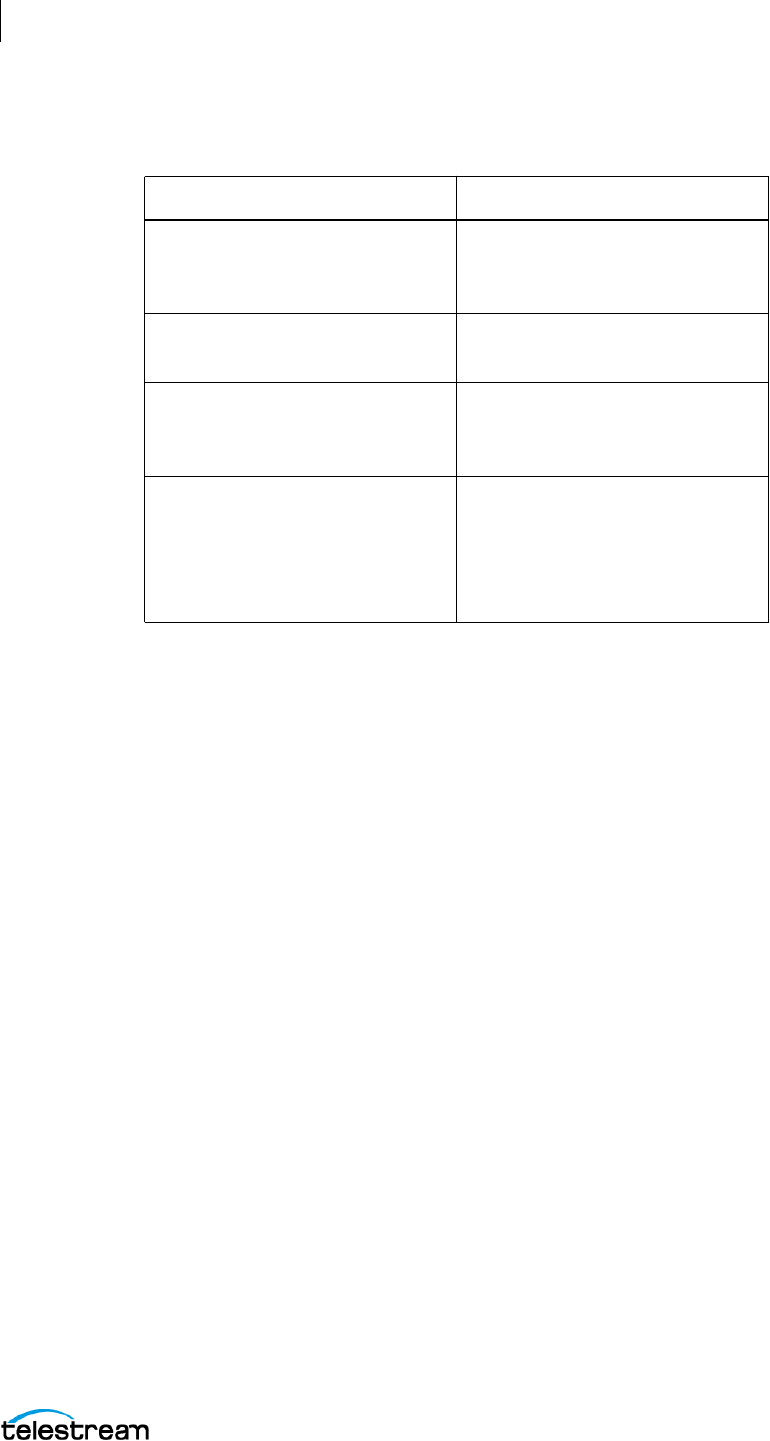
ScreenFlow Settings
Licenses Settings Tab
172
ScreenFlow User Guide
Table 7. Licenses Settings Tab
Preference Description
Serial Number Editable field where you enter
the serial number for your
license.
Stock Media Library ScreenFlow displays the path to
your stock media library.
Purchase When clicked, the Purchase
button sends your purchase
order to Telestream.
Activate When clicked after a serial
number has been entered into
the Serial Number field,
Telestream activates your
ScreenFlow license.
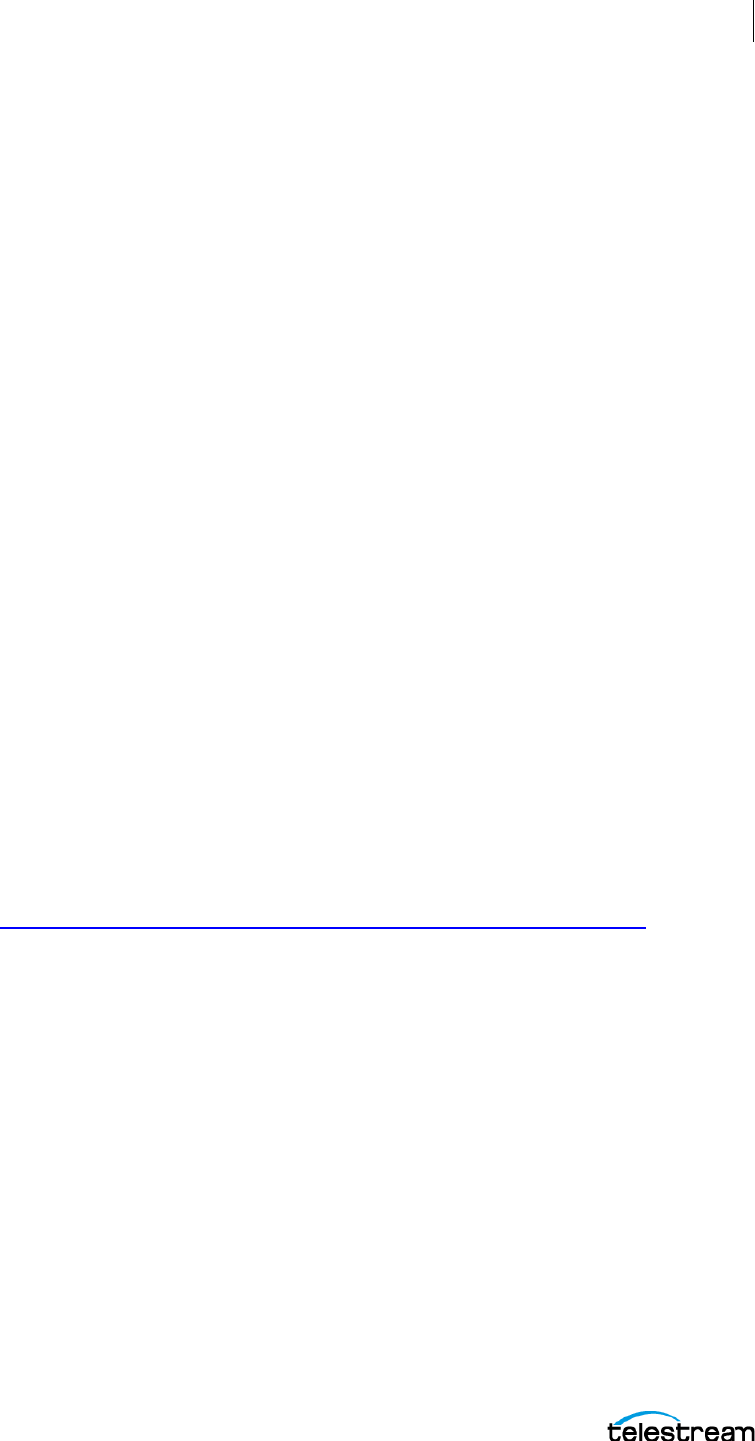
173
Troubleshooting
You can troubleshoot common ScreenFlow issues. If your issue is not listed, or if the
recommended procedure doesn’t work, please contact technical support.
How do I provide Customer Service with diagnostic information about an issue?
1. Press Shift and click the Help menu.
2. Select Gather Support Diagnostics > Gather.
3. ScreenFlow collects debugging logs, crash reports, a system profile, names of open
documents, and a snapshot of the current state of ScreenFlow.
ScreenFlow generates an archive of these files.
4. Save the archive to your desktop, and send it to Telestream Customer Service when
requested.
How do I provide Mac App Store with diagnostic information about an issue?
Mac App Store users can gather support diagnostics for the Mac App Store with a
software tool provided by Telestream.
See ScreenFlow: Gather Support Diagnostics / Reset ScreenFlow Preferences
.
My exported video looks fuzzy or blurry. What can I do to make it look better?
Compression of video on output can reduce sharpness. Here are a few things you can
do to retain as much sharpness as possible:
• On the Advanced tab of the Settings dialog, check the Sharp box for the Video Mag-
nification setting.
See Advanced Settings Tab.
• Export using the Lossless - Apple ProRes with Alpha uncompressed video format. If
you don’t reduce the resolution, the output resolution matches the resolution of
the input video, but results in a large output-file size. Generate uncompressed
video if it requires additional editing before publishing.
• Before recording, reduce your Mac display resolution through the Mac System Pref-
erences for Displays. A lower display resolution requires less compression. Make
your display resolution the same as, but not lower than, the desired output resolu-

Troubleshooting
174
ScreenFlow User Guide
tion. If you set the display to a smaller resolution than the output resolution, the
image loses clarity.
• If you don’t want to reduce your display resolution or export to a large, uncom-
pressed format, select Video Properties > Scale or Callout Action > Zoom. Scale and
zoom functions allow you to increase the visibility of a specific portion of the
recording. This helps maintain clarity in a heavily compressed video.
• Sharp, clear text is hard to produce in digital video. Thin lines can look blurry or jag-
ged. If you have small text in your screencast, consider applying the Scale feature or
increasing the text size.
How do you designate a display recording area?
ScreenFlow can capture the entire display, or a specific recording area. You can make
use of any display area during editing in post-production.
When using a program which designates a recording space, you may unexpectedly
move outside of this space due to a menu option or pop-up. If your recording space is
preset, there is no way to recover this lost information. With ScreenFlow, however, you
can move outside your area of focus when necessary.
Does ScreenFlow work with Parallels or VMware?
Since ScreenFlow captures everything on your display, both Parallels and VMware are
supported (including Computer Audio output). However, ScreenFlow can’t use the
Callout features, as these are dependent on information provided by macOS.
Telestream has tested ScreenFlow with Parallels in all modes (Coherence, Window, and
Full Screen) without issue. In fact, when using Parallels/VMware, some users have
reported that ScreenFlow produces smoother, higher-quality output while using fewer
CPU resources than native Windows screen-capture programs.
What kind of graphics card should I use?
ScreenFlow uses video RAM (or VRAM) during the recording process, so it is important
to have a graphics card with at least 64 MB of VRAM, but we recommend 128 MB. The
amount of VRAM necessary to record smooth video depends on your display resolution
and whether or not other applications are simultaneously using VRAM. If you have
insufficient VRAM, the recording will drop frames. As a result, video skips during
playback.
Does ScreenFlow support closed captioning?
ScreenFlow does support closed captioning. For details, see Displaying and Previewing
Closed Captions.
How do I use ScreenFlow to record my iPhone/iPad?
ScreenFlow can capture directly from the screen of an iOS device over a USB
connection. For details, see Touch Callout Properties.

Troubleshooting
175
ScreenFlow User Guide
My USB microphone and iSight camera are out of sync. What should I do?
There can be a latency problem between the computer USB input and the iSight
camera. If audio and video are out of sync, try using an analog mic instead of a digital
one. Plug the analog mic into the analog audio jack on the computer.
I can’t find my media files. Where is the media library?
Once the first media file has been recorded or the first file has been imported into
ScreenFlow, each document in ScreenFlow has a media library. To open the media
library, see Viewing the Media Library.

Troubleshooting
176
ScreenFlow User Guide

